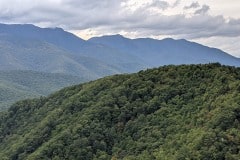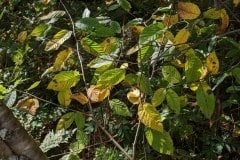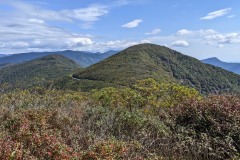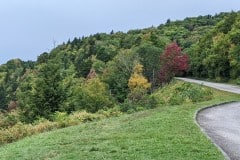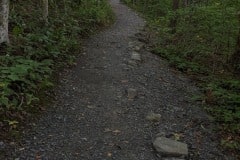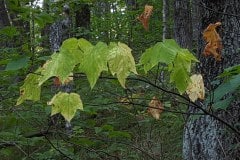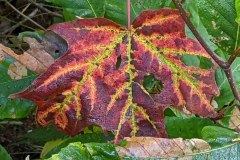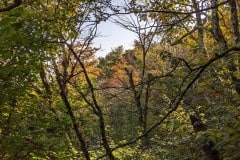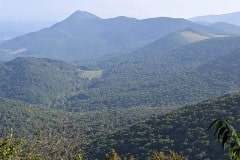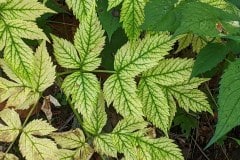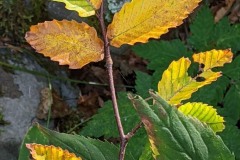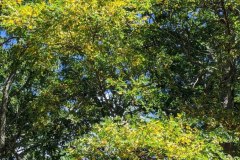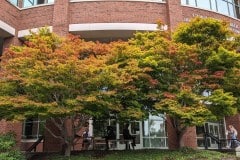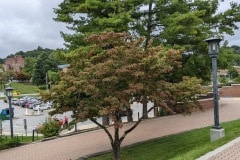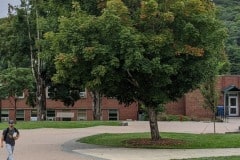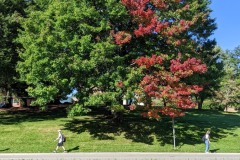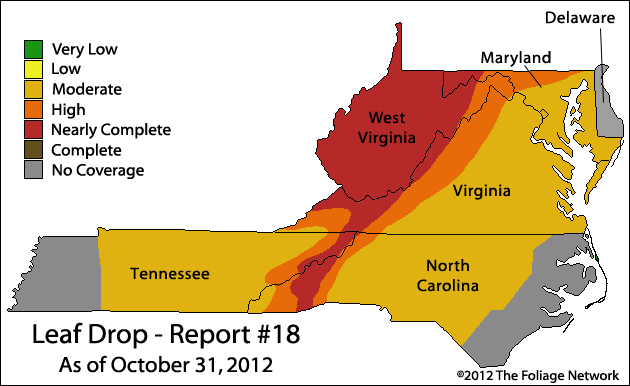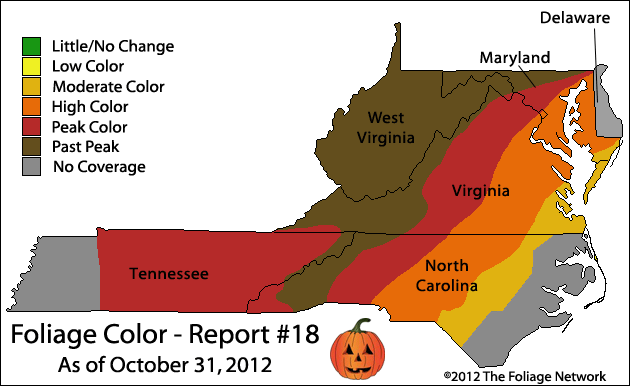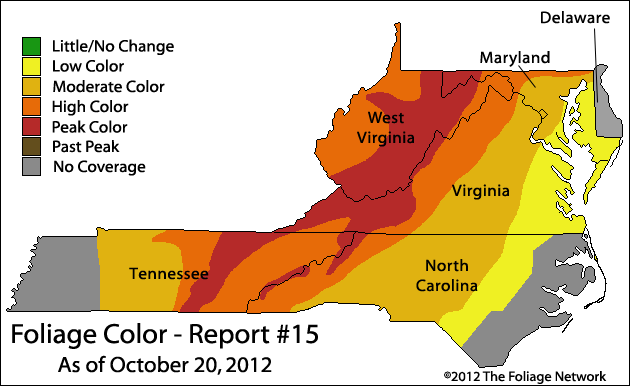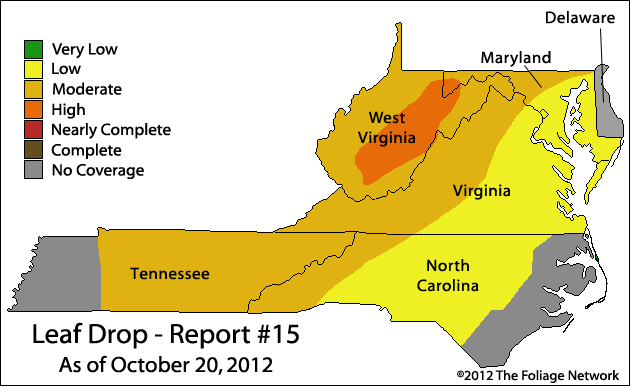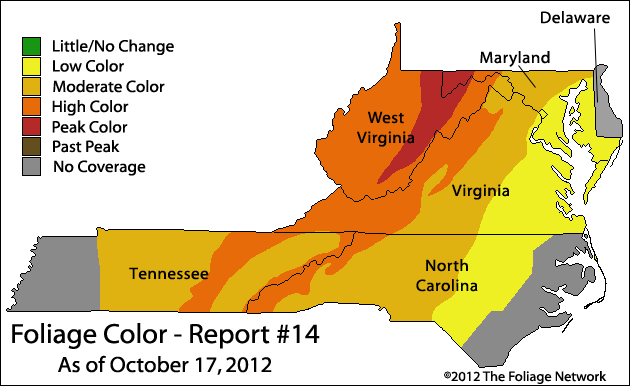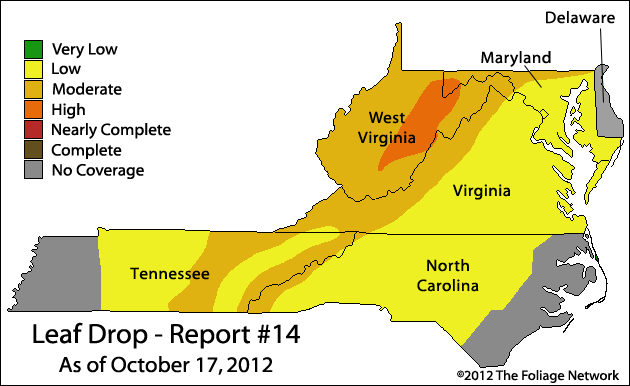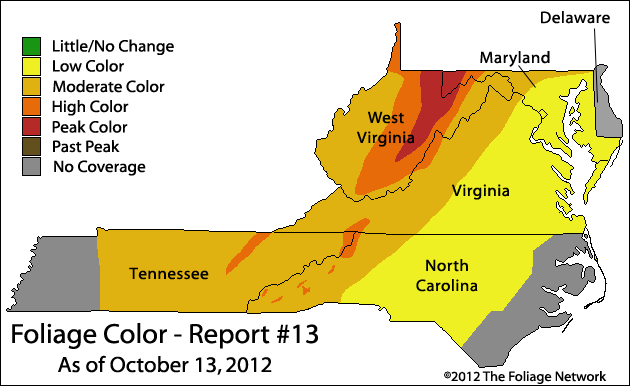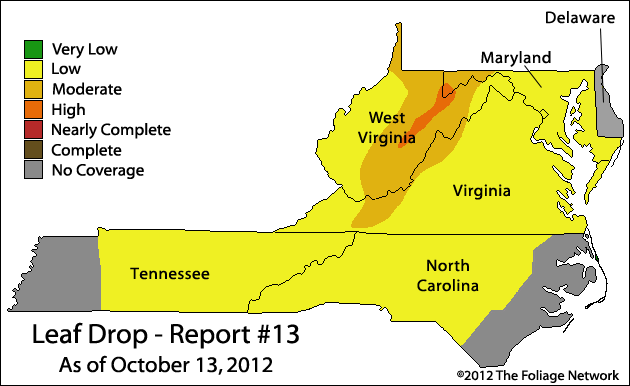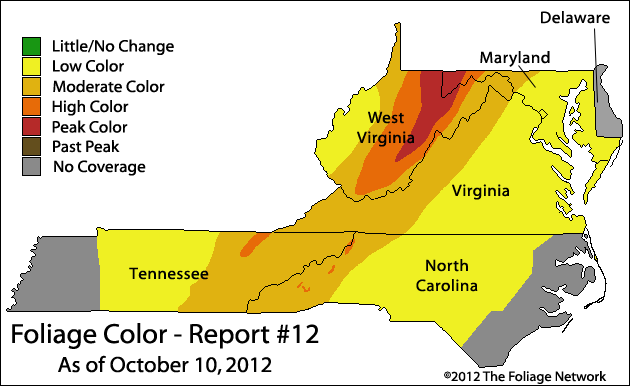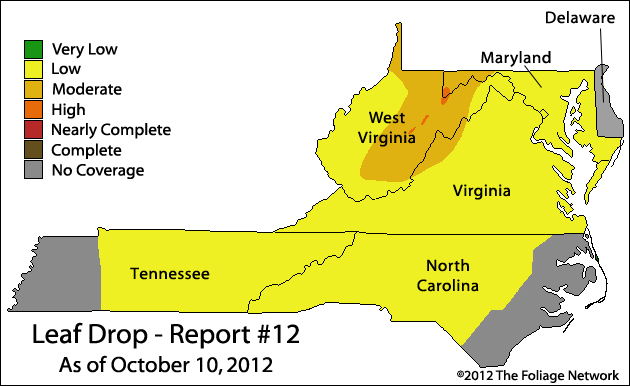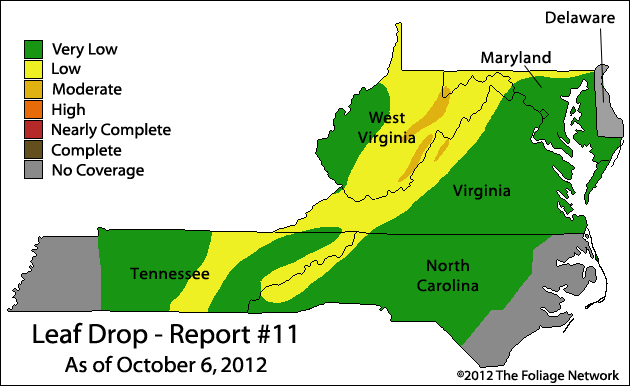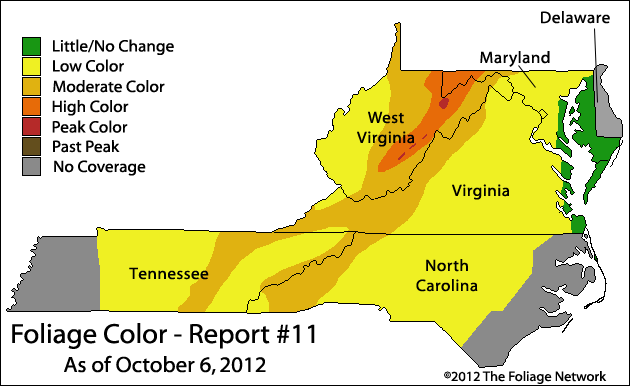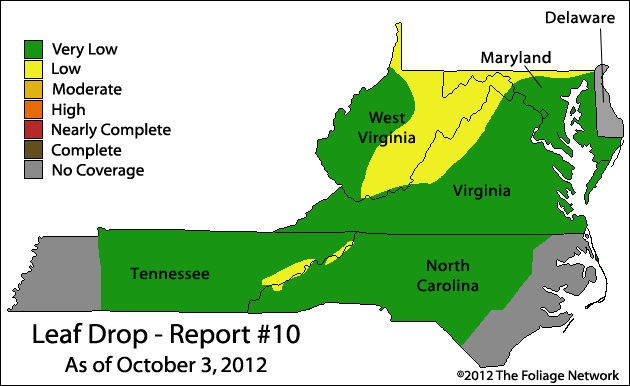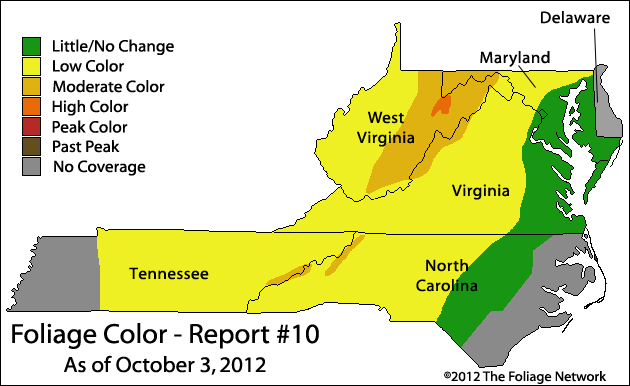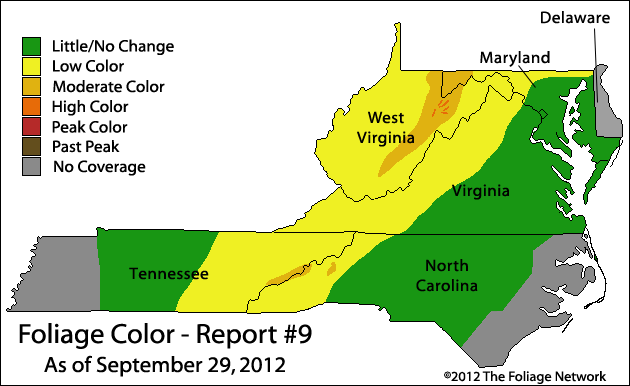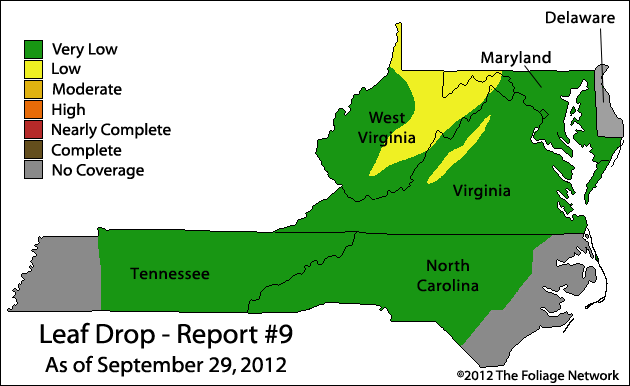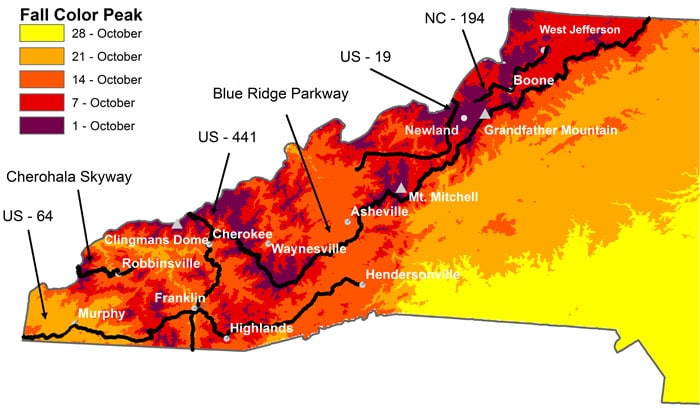Fall Color Report Archives
FOR CURRENT FALL COLOR CONDITIONS PLEASE VISIT – FALL COLOR REPORT
2023 Updates
Grandfather Mountain Daily Fall Color Report | Oct. 31, 2023:
Happy Halloween! Today marks the end of our daily reports. Locals and visitors alike enjoyed an extended fall color season this year, with great autumn hues throughout the month of October in the N.C. High Country. Forecasts show an abrupt drop in temperature today into tomorrow.
This photo was taken from Chestoa View Overlook, located at Milepost 320.8 along the Blue Ridge Parkway.
Photo by Skip Sickler | Grandfather Mountain Stewardship Foundation
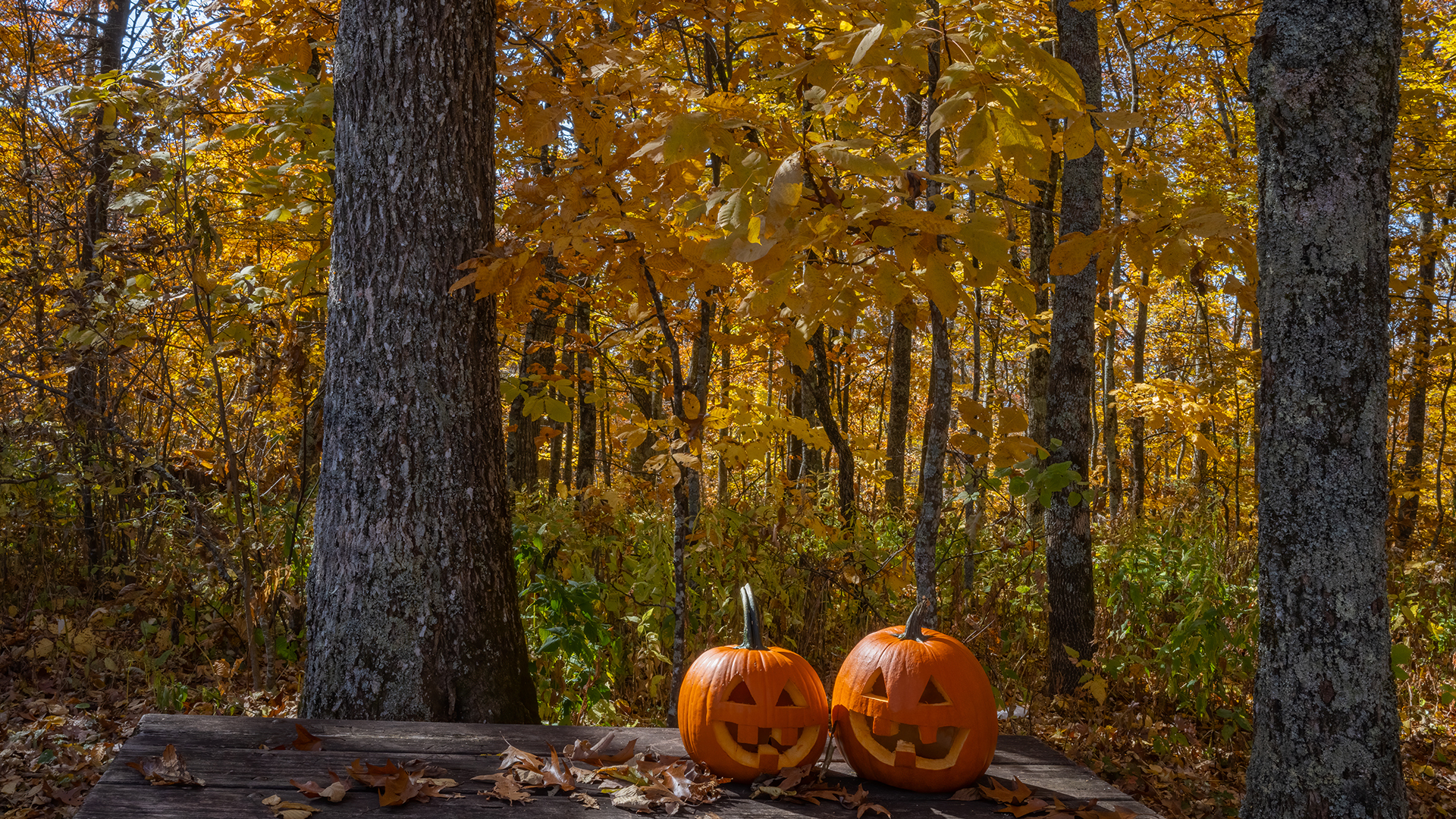
Grandfather Mountain Daily Fall Color Report | Oct. 30, 2023:
Though some nice pockets of fall color remain, Grandfather Mountain is now past peak as we near the end of October. The Mile High Swinging Bridge area and higher overlooks remain prime viewing locations for color descending to the Piedmont.
Today’s photo of the mountain’s lofty peaks was taken from U.S. 221, just south of MacRae Meadows.
Photo by Skip Sickler | Grandfather Mountain Stewardship Foundation
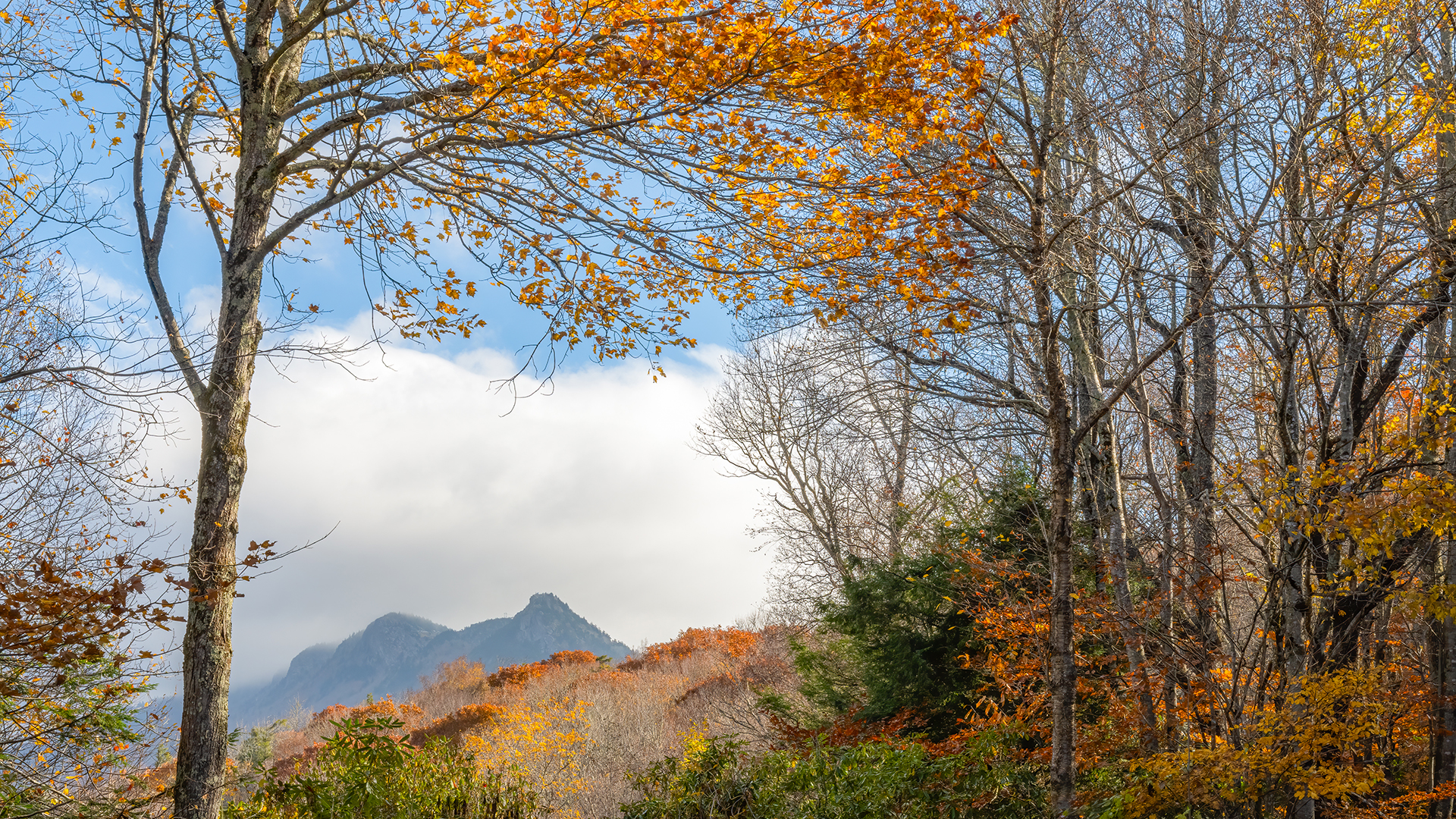
Grandfather Mountain Daily Fall Color Report | Oct. 29, 2023:
This sunset shot in Valle Crucis shows a late autumn view of golden and crimson hues. The drive along N.C. 194 between Banner Elk and Valle Crucis is always a noteworthy route for fall color viewing.
Photo by Skip Sickler | Grandfather Mountain Stewardship Foundation
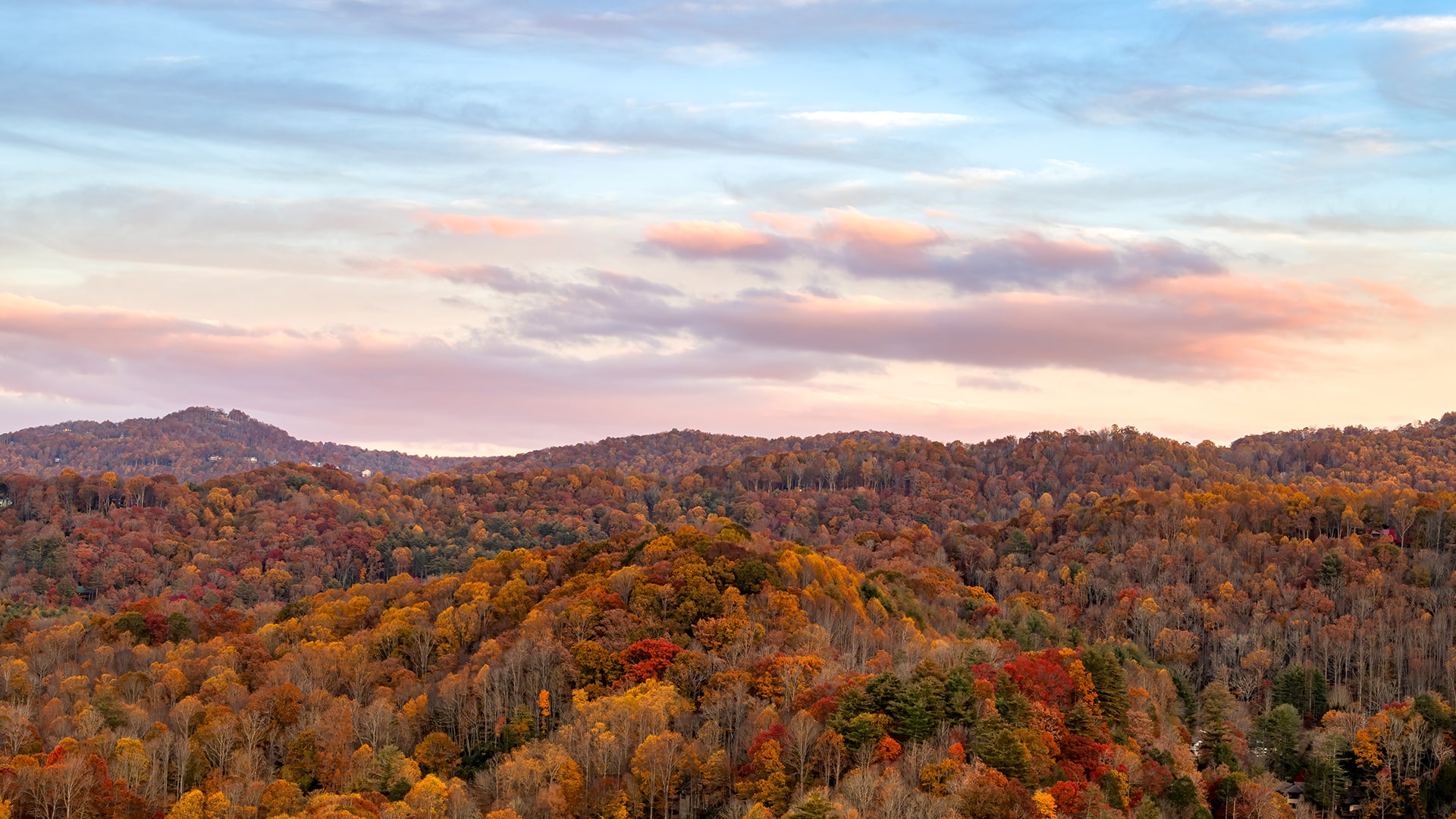
Grandfather Mountain Daily Fall Color Report | Oct. 28, 2023:
Fall colors continue to put on a show in the N.C. High Country, as shown in this photo taken near the Linville Falls Visitor Center. Sunshine and warmer temperatures make this weekend perfect for an autumn stroll or hike. This bridge leads to a network of trails that show spectacular views of Linville Falls.
The best autumn hues can be seen between 2,500 and 4,000 feet in elevation. The Blue Ridge Parkway between Linville and Little Switzerland would also be nice right now for leaf-peeping adventures.
Photo by Leslie Restivo | Grandfather Mountain Stewardship Foundation
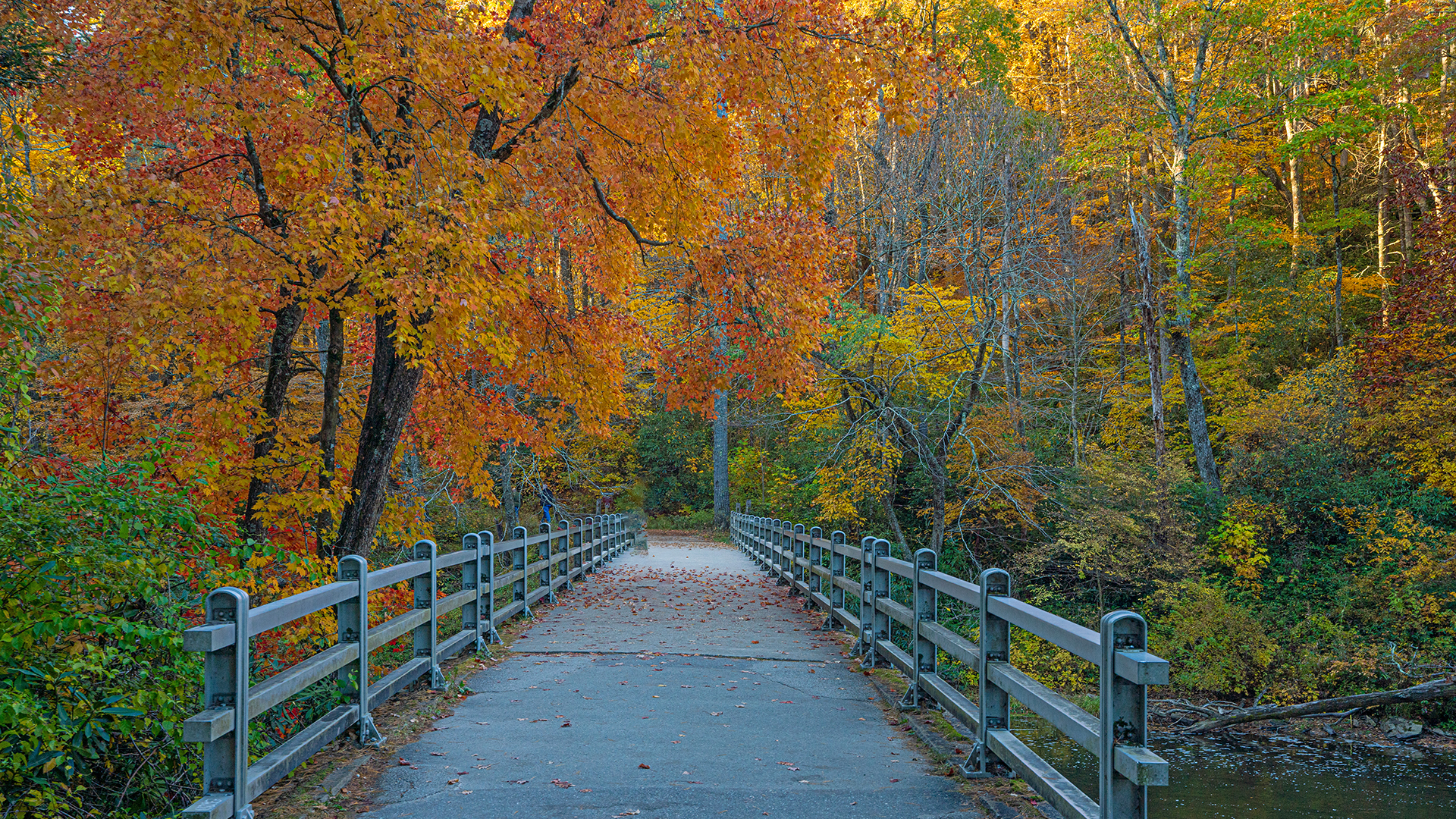
Grandfather Mountain Daily Fall Color Report | Oct. 27, 2023:
Autumn lights up the landscape in this image taken near Grandfather Mountain’s park road, just above MacRae Meadows. There have been some spectacular yellow hues to be seen this week. The 2-mile drive on U.S. 221 between Linville and Grandfather Mountain’s entrance gate has been ablaze with color, especially in the light of early evening.
Grandfather Mountain still has vibrant foliage in the lower half of the park, from the entrance up to the area around the Wilson Center and Mildred the Bear Environmental Habitats. The top half of the park serves as the perfect vantage point to see fall color as it descends into lower elevations.
Photo by Skip Sickler | Grandfather Mountain Stewardship Foundation
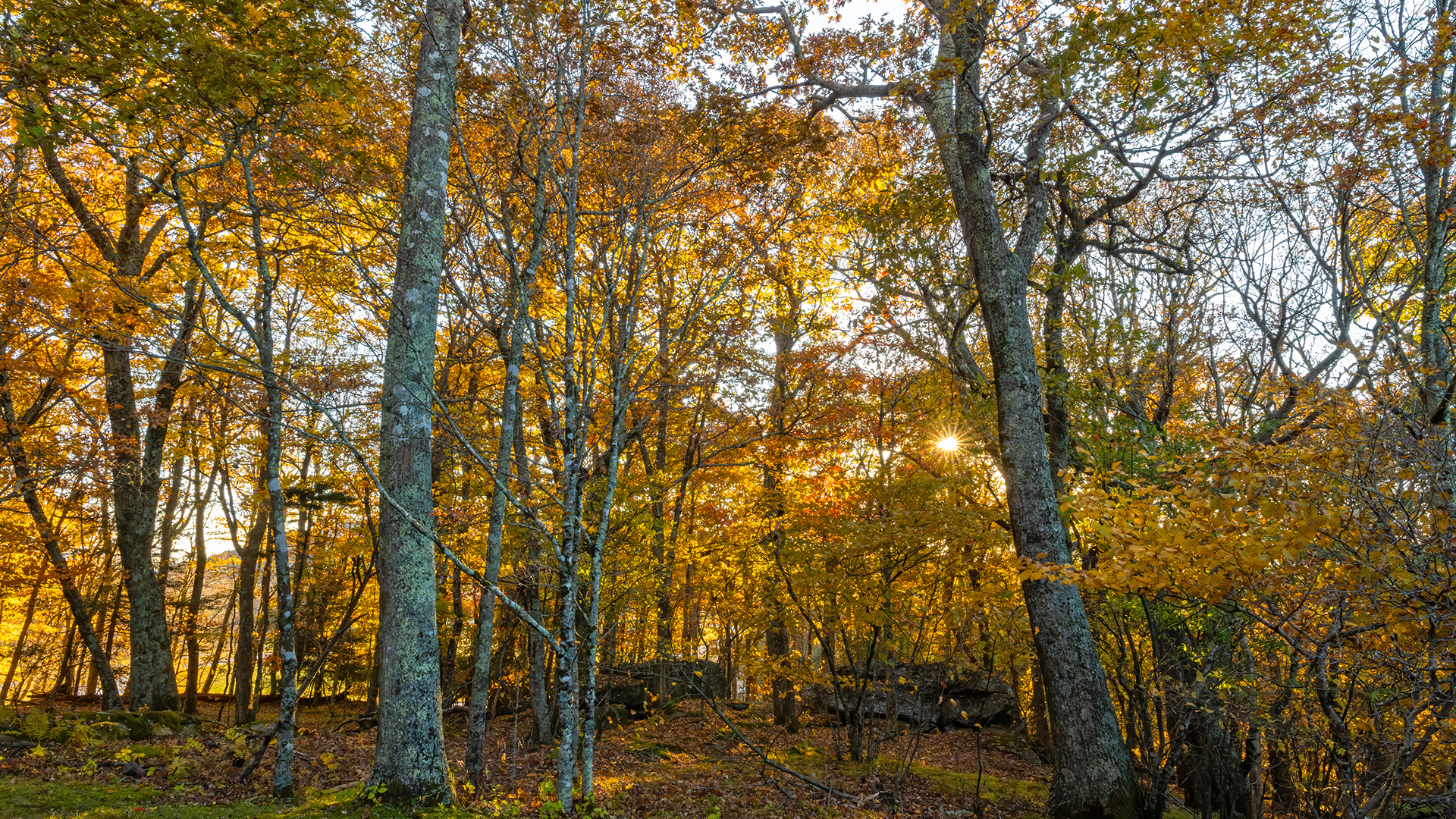
Grandfather Mountain Daily Fall Color Report | Oct. 26, 2023:
Golden hues of sunrise brighten fall foliage in the Linville Gorge, as seen in this image taken from The Chimneys near Table Rock. Currently, the best fall color can be seen between 3,000 and 4,000 feet in elevation.
Nice weather should continue into the weekend in the N.C. High Country and make for ideal leaf-looking conditions.
Photo by Leslie Restivo | Grandfather Mountain Stewardship Foundation
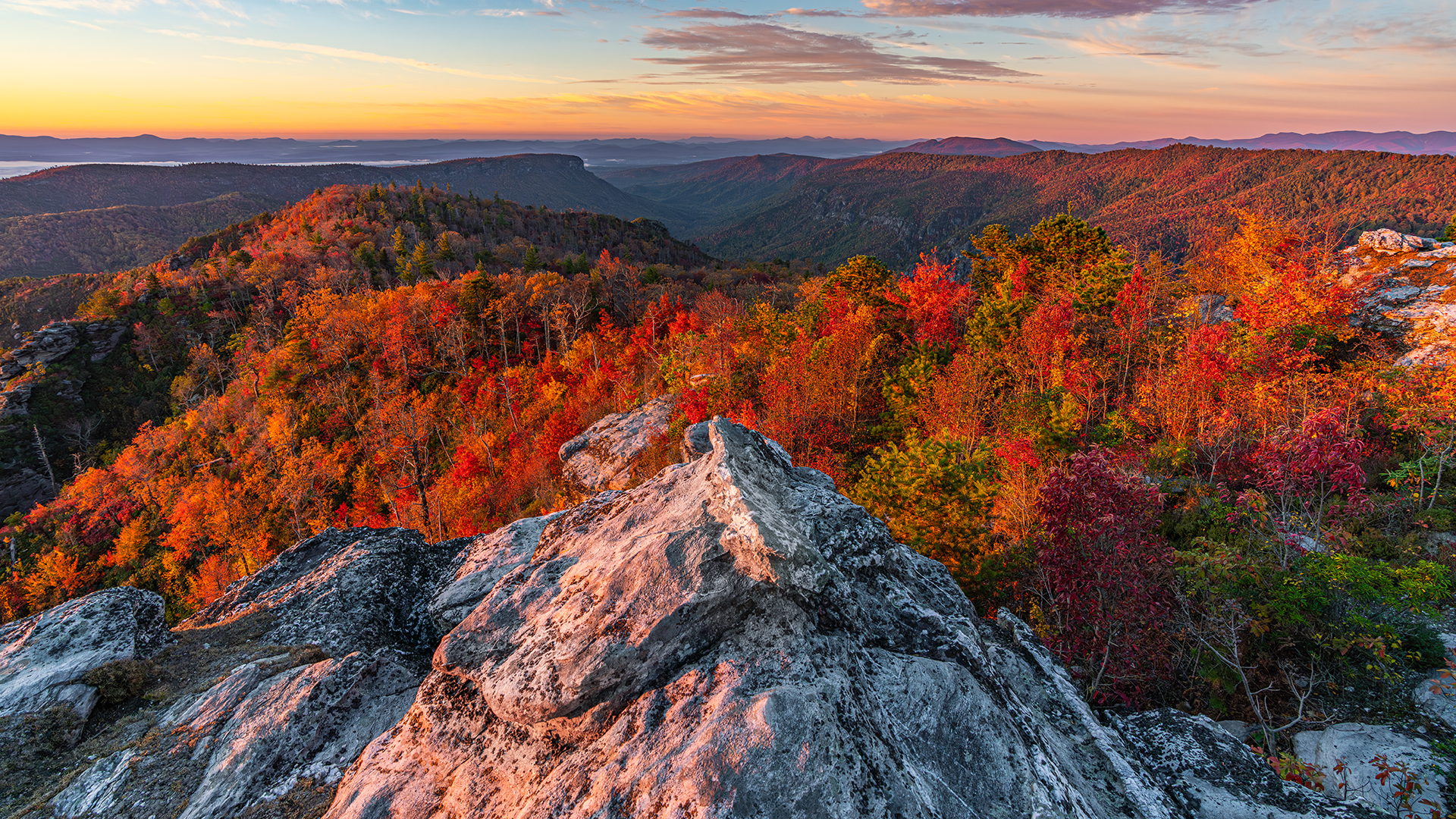
Grandfather Mountain Daily Fall Color Report | Oct. 25, 2023:
Fall color and sunlight illuminate this iconic bridge along the Blue Ridge Parkway in this photo taken near the Linville Falls Picnic Area, at Milepost 316.5. The great weather this week provides ideal conditions for a scenic autumn drive.
Heading south along the Blue Ridge Parkway from the Grandfather Mountain area still provides a nice look at fall foliage. Routes into the High Country from lower elevations, such as U.S. 321 between Lenoir and Blowing Rock, N.C. 181 between Morganton and Pineola and U.S. 221 between Marion and Linville, are also currently offering picturesque views.
Photo by Skip Sickler | Grandfather Mountain Stewardship Foundation
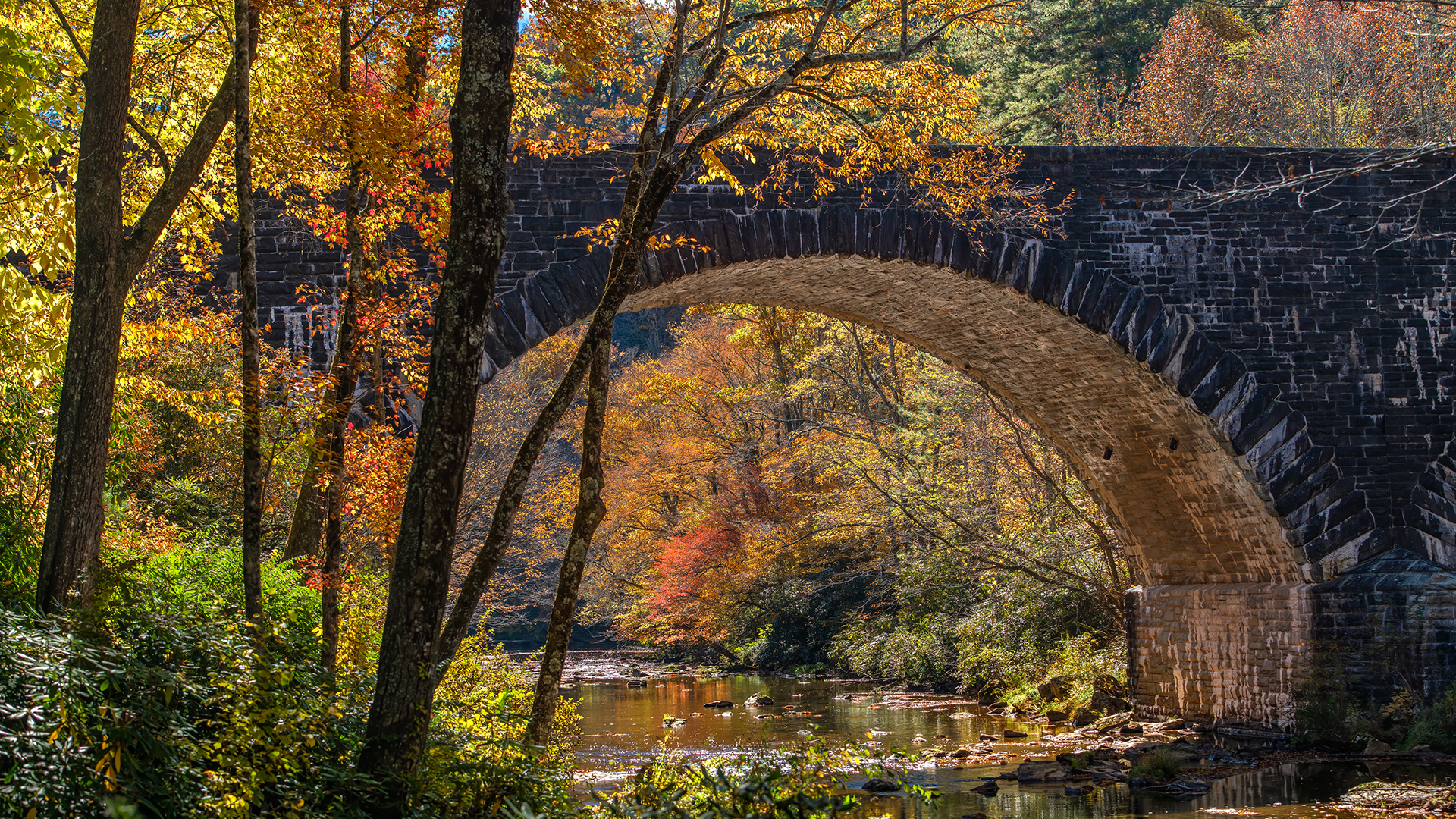
Grandfather Mountain Daily Fall Color Report | Oct. 24, 2023:
As we move into late October, Grandfather continues to be a great color destination. The lower half of the mountain currently has bright autumn hues on display, as seen in this photo taken from the Woods Walk.
This 0.4-mile exploration trail loops through a northern hardwood forest and is perfect for a leisurely woodland stroll, with benches and picnic tables available for those looking for a restful time surrounded by fall leaves.
Photo by Leslie Restivo | Grandfather Mountain Stewardship Foundation
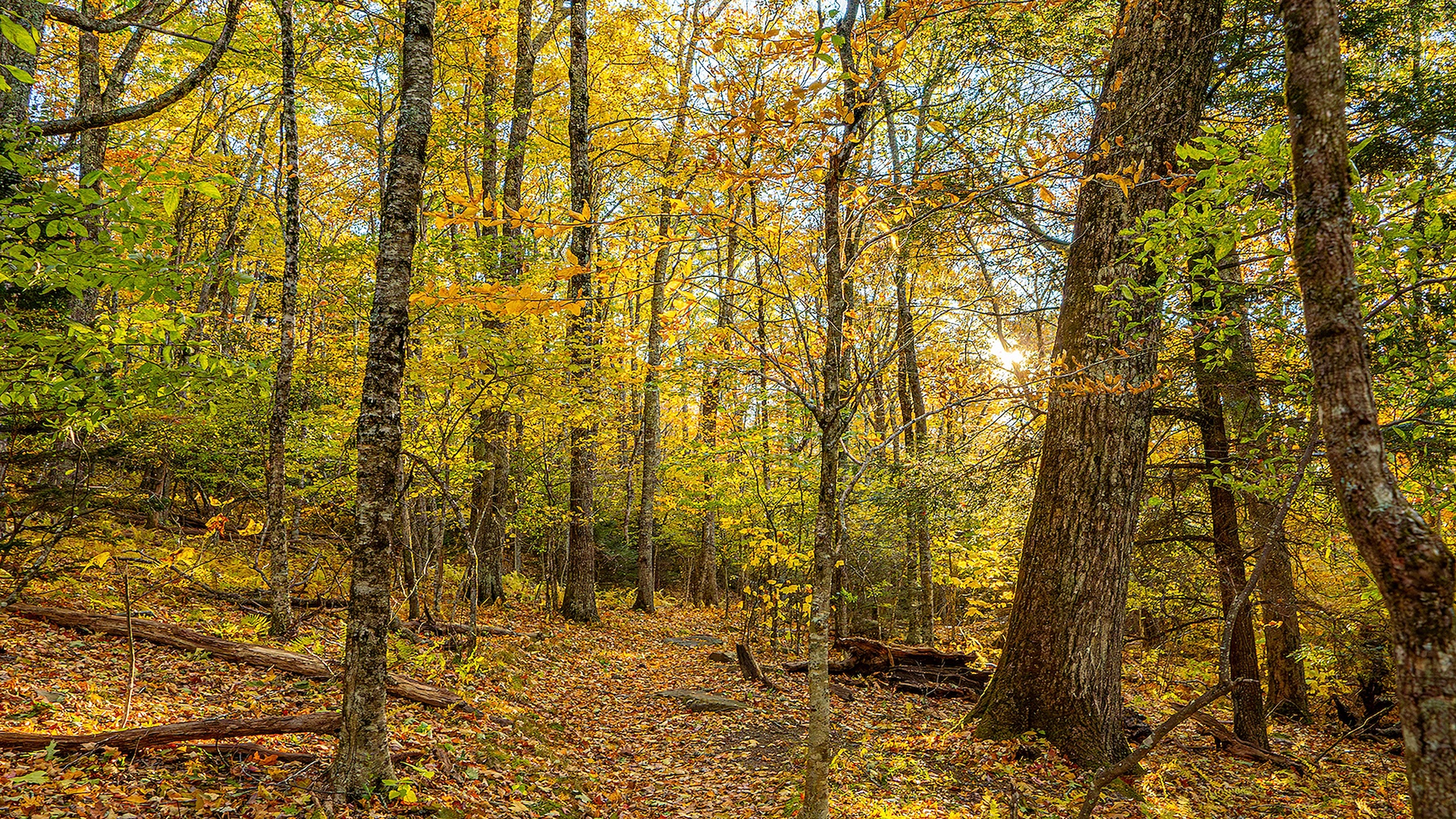
Grandfather Mountain Daily Fall Color Report | Oct. 23, 2023:
Colorful maple leaves frame this image of the Linville River near the Linville Falls Visitor Center. Currently, the best fall color can be seen below 4,500 feet in elevation.
This week’s forecast calls for warmer temperatures, sunshine and pleasant conditions for leaf-looking expeditions.
Photo by Skip Sickler | Grandfather Mountain Stewardship Foundation
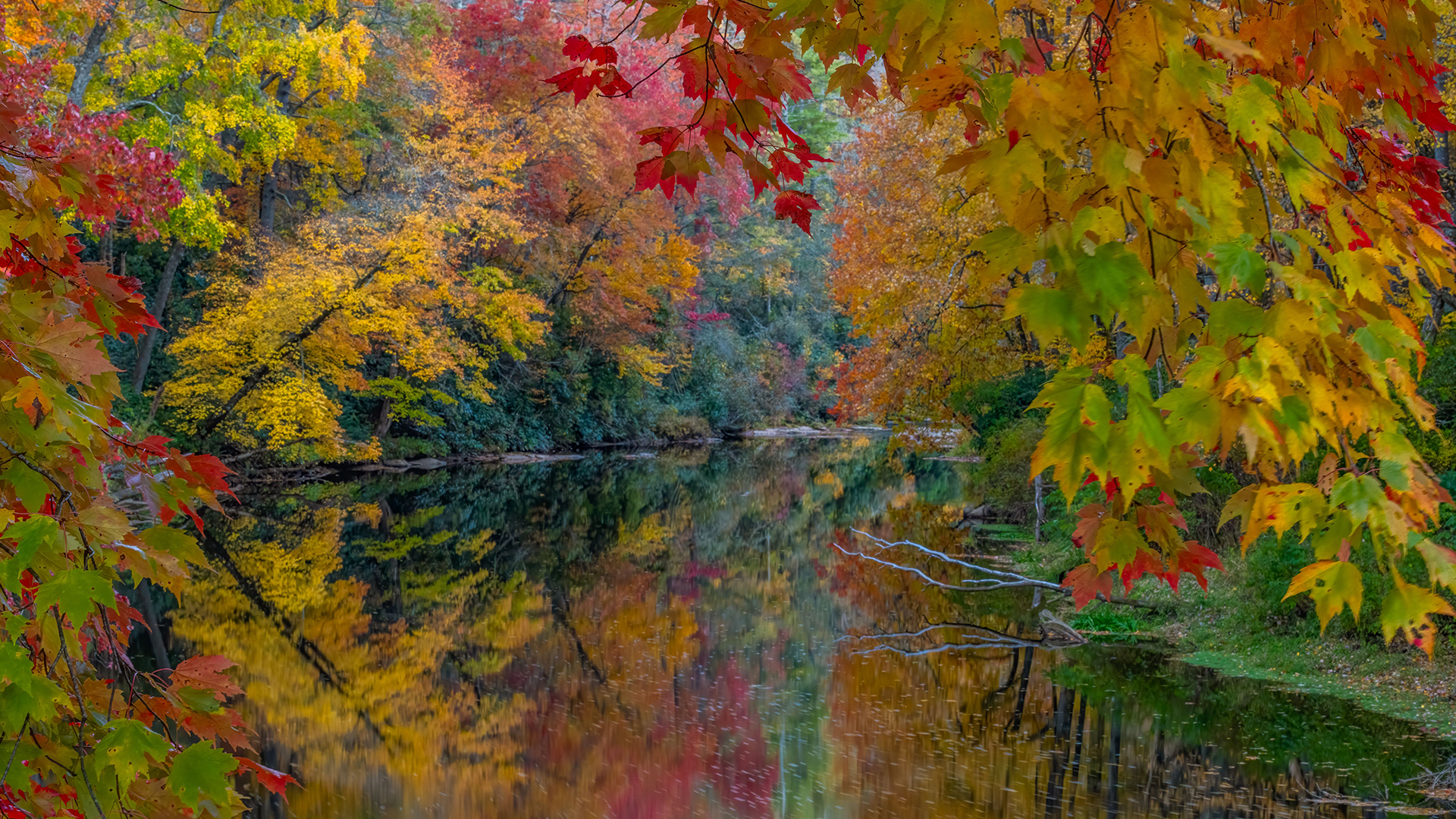
Fall Color Report for the Week of October 22, 2023
Yesterday, Saturday, October 21, started off windy and blustery, with low-lying clouds obscuring the high peaks. But by 11 am, the skies had cleared to become a cloudless deep blue that highlighted the fall leaf colors nicely. But unfortunately, my fall leaf color companion, Dr. Eduardo de Campos, and I headed out early to beat the anticipated crowds, so that when we summitted Elk Knob State Park, we were enveloped in swirling clouds and we did not get the long range views that we had hoped for. Had we gone 1-hour later, we would have been rewarded with views that possibly could have gone as far as 50-60 miles. But, c’est la vie!
But there is a north-facing overlook halfway up the 2-mile trail, and that was below the cloud base, so we did get to see some colors on the landscape. I have to say that I was surprised that they were not yet at peak here, and there were still large areas with green trees. Usually, this view has great color, but it seems 7-10 days behind last year. If you go up later this week or next weekend, the colors should be better from this viewpoint.
The trail up to the top is an easy hike, takes less than 1-hr, and if not cloudy offers great views. You can see as far as Whitetop Mt, Virginia’s second highest peak to the north and down to Mt. Mitchell if looking south, as well as Grandfather Mt, to name but a few of the many peaks visible from the top.
Photos of our Elk Knob hike appended to this posting.
Leaves were past peak from the 1-mile point upward, which are the high elevation trees. Strong winds that previous night and that day took down a lot of maple leaves, leaving a lot of bare branches. There is a nearly monotypic stand of beech at the lower portion of the trail and they were at peak yellow color, with some entering their final leaf color phase, which is a nice bronzish brown color. The hobblebushes were past their peak, so their colors were blasé unfortunately, but when they are on peak, they have an unusual sporadic purpling on their large ovate green leaves which is quite unusual and beautiful. They are clustered in large numbers right around the 1-mile overlook on both sides of the trail.
Although frowned upon, we took the service road down from the top to the place where it first crosses the hiking trail. We did so to find other plants that we may have missed on the regular trail. I don’t recommend doing this, as it is quite steep and rocky and you can easily slip and fall. But we did see some nice views which I have posted. I expect I’ll get a letter of reprimand from the Park for doing this….but hopefully not! It was done for a good cause.
As we left the park around 10 am, it was beginning to get quite crowded and so we decided, given the early hour, to continue our leaf looking by taking a road less traveled, to quote Robert Frost, which in this case was Rich Mt Road, accessible from the Meat Camp road you take from Rt. 194 to get to Elk Knob State Park. Rich Mt. road heads west up to high elevations and after several miles ends up on US 421 at the NC/TN border, west of Boone. It offers spectacular views and we saw great fall leaf colors, and almost no one else was on the road – it was like having the entire mountain to ourselves.
There are homes and estates on this mountain (Sunalei Preserve for example) some of which are restricted communities, but it is worth the drive if you want to head somewhere differen. The road is unpaved for most of its length until you get a few miles from the end, but it’s well maintained and any car can traverse it.
After that ride it was near lunch time so we decided to head back to Boone and get a quick lunch at Taqueria El Paso, which offers excellent Tex/Mex style food. I had torta carnitas (see photo of my huge sandwich, which ended up being two meals it was so large). Highly recommended. It is next to the Ingles Shopping Center on Rt. 105 in Boone.
Then, against all good judgement, we headed to the Blue Ridge Parkway (BRP) knowing that at midday it would be quite crowded with leaf peepers. And indeed, it was – with traffic from US 321 south on the BRP running slowly as people were stopping at the Cone Manor, Julian Price Park, and Price Lake. Once past Price Lake traffic eased up until we approached the Rough Ridge Trail area, which may be the most popular hike on the BRP and always has lots of cars parked on both sides of the BRP.
Anticipating that, we pulled off before getting to the Rough Ridge portion of the BRP into the Boone Fork Parking Area (mile 299.9) and decided to hike up to the Flat Rock view. Neither Eduardo or I had ever been on this trail, and we had no idea how long it was or even where it would take us. We asked several people coming down what there was to see and how long it would take to get to the Flat Rock viewpoint and we received answers that varied in both time and length. But we decided to head up the Scout Trail to see if we could get to the viewpoint. Once you do this, or, if you go the other way on the Nuwati Trail (the hike makes a loop) you enter the east side of Grandfather Mt. State Park. The trails say Permit Required, but that means for camping, not hiking, as we later discovered. It’s about 1.5 miles to the first view, but, not knowing this when we were out on the trail, with the time approaching 4 pm, and the sun rapidly setting, we sadly decided to turn back (a wise decision given how fast the sun was going down). Turns out we were probably within a quarter of a mile of the view! Again, c’est la vie!
Nonetheless, it was a very pleasant hike, mostly uphill, somewhat rocky, moderatly difficult, through very beautiful forest, laden with Fraser magnolias, maples, oaks, and witch hazels. At the upper reaches, you enter spruce forest, and the complexion of the forest changes as a result. I do recommend this hike, but it is strenuous and on the upper reaches of the Nuwati, you’ll have to climb rope ladders on boulders. Pets are not recommended as a result. If you go all the way, you can get to Calloway Peak, one of the highest peaks in the region, but you’re looking at an all-day hike.
After making it back to our car, Eduardo and I headed south toward the Linn Cove Viaduct. We wanted to see how the leaves were after the high winds of the day. You could tell that these winds were blowing lots of leaves off the trees simply by looking down on the forest floor, which during our hikes at Elk Knob and Nuwati, were covered with maple and magnolia and witch hazel leaves. Looking up we saw lots of bare branches. The consequences were obvious as we headed down the Parkway – the fall foliage display was past peak at higher elevations, while it was still excellent at the level of the Parkway, although it was not as vibrant as it was just a few days earlier on Wednesday. If I had to pick “the” day colors peaked at mid-elevations on the BRP, I’d say it was on Wednesday, October 18th.
Winds at peak leaf display can shorten the display period, since the leaves are not held onto the trees as tightly as when they are green and are easily removed. We saw the result of that on Saturday. Winds are still blowing this Sunday morning, so I expect more will have come down overnight. But color was appearing downslope toward the foothills, and I have seen good color in Lenoir and Lincolnton, which are much lower in elevation, so the peak is moving off slope now. This week will still have good color and I encourage you to come up – the weather is supposed to be sunny with comfortable temperatures all the way into next weekend. If colors aren’t peak along the Parkway, they will be showing up at lower elevations which you can view from the overlooks.
This coming weekend I will probably head to Stone Mt. State Park. I usually go there in early November, but I have to be out of town the second week of November, and in Charlotte prior to that, so this will be my only time to visit this park. Stone Mt. State Park has large rock outcrops at elevations of 1500-1800’ and great color when at peak. It’s an easy to moderate hike to the outcrops from the main parking lot, and there is a wonderful waterfall you can visit on the way up. If you have the legs, you can walk down to the bottom of the falls too on wooden steps and boardwalk, which I recommend. When you are on the outcrops and look up, you will be looking at the BRP. That section is closed for construction or otherwise you could get to the park from there. For now, the easiest way to get to this park is off of US 421 in Wilkesboro (use Google maps, as it’s not intuitive how to get there on all those country roads).
I’ve grouped the photos from yesterday’s adventures into four folders and added comments to them to explain what to see if you decide to go to these places. Have a great week!
Grandfather Mountain Daily Fall Color Report | Oct. 22, 2023:
The past week has been spectacular, with more to come as fall colors continue to make their way down to lower elevations. The area around the Linn Cove Viaduct has been especially vibrant this season, attracting thousands of visitors looking to see this engineering marvel surrounded by a kaleidoscope of color.
Photo by Skip Sickler | Grandfather Mountain Stewardship Foundation
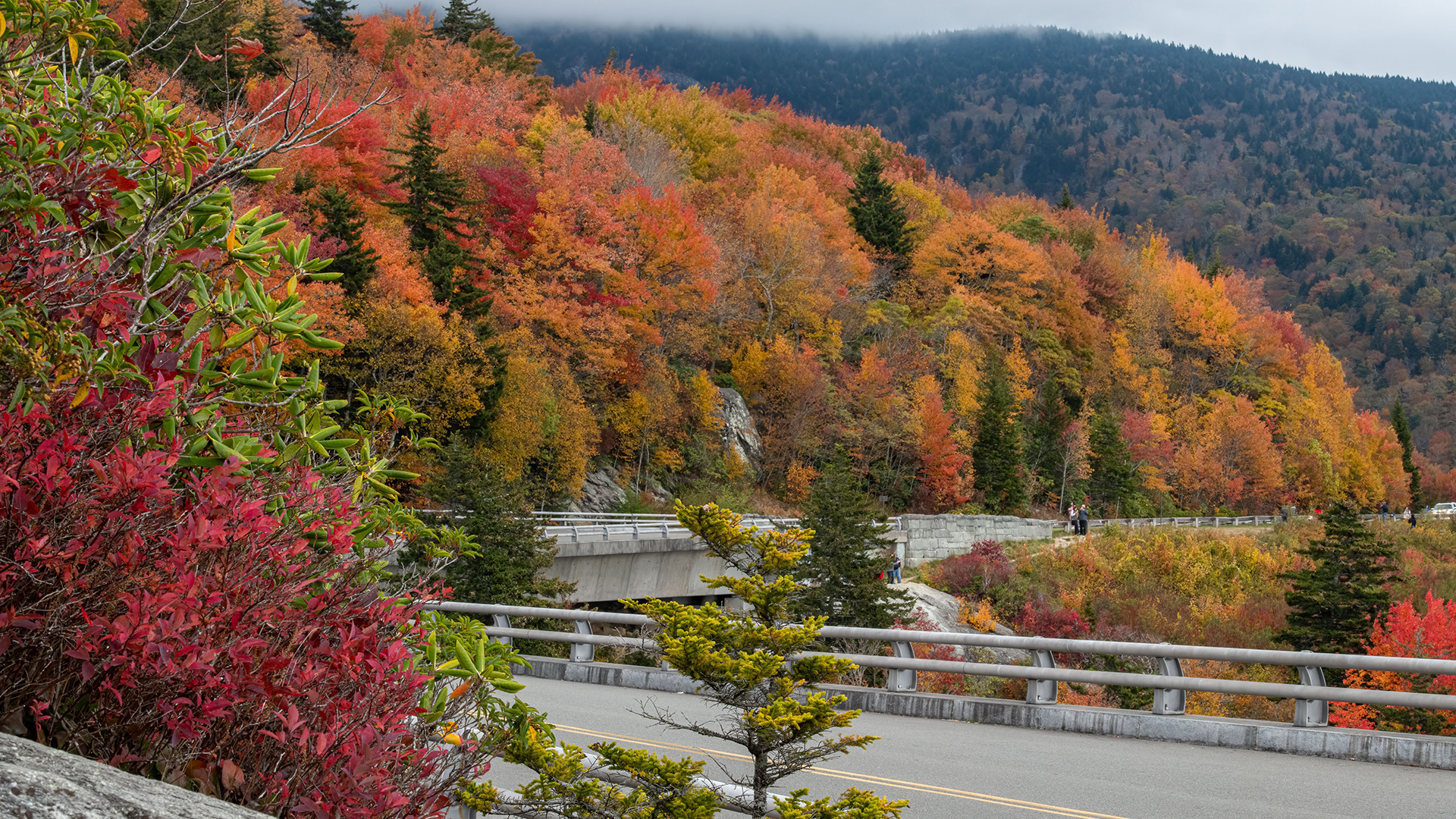
Grandfather Mountain Daily Fall Color Report | Oct. 21, 2023:
Grandfather Mountain’s many hiking opportunities provide a uniquely immersive fall color experience. This image from the Black Rock Trail shows golden autumn hues strikingly contrasted against the green rhododendron leaves below.
2023 was named the “Year of the Trail” in North Carolina, and today, Oct. 21, is designated as the inaugural Great Trails State Day. Grandfather Mountain offers access to over a dozen miles of walking and hiking trails.
Photo by Leslie Restivo | Grandfather Mountain Stewardship Foundation
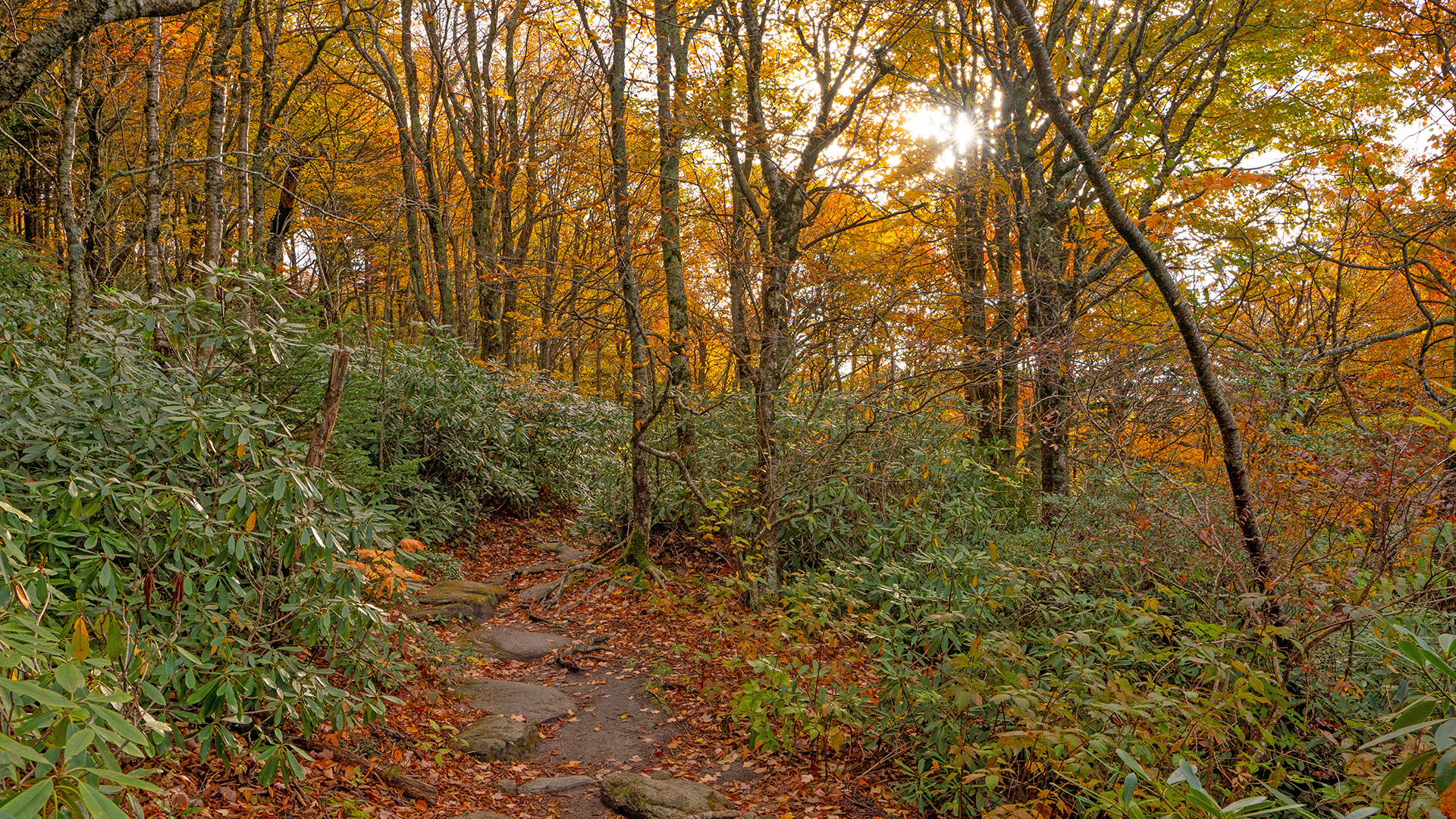
Grandfather Mountain Daily Fall Color Report | Oct. 20, 2023:
Fall color beautifully fills this shot of the Historic Mill Pond in Banner Elk, showcasing a serene autumn setting. While today’s (Friday’s) forecast calls for occasional rain, the skies should clear for most of the weekend. The area’s foliage is exceptionally vibrant right now for those planning their leaf-looking trips.
In addition to the Woolly Worm Festival in Banner Elk on Saturday and Sunday, the Valle Country Fair is taking place Saturday in Valle Crucis. There is no shortage of fall fun to be had in the N.C. High Country this weekend!
Photo by Skip Sickler | Grandfather Mountain Stewardship Foundation
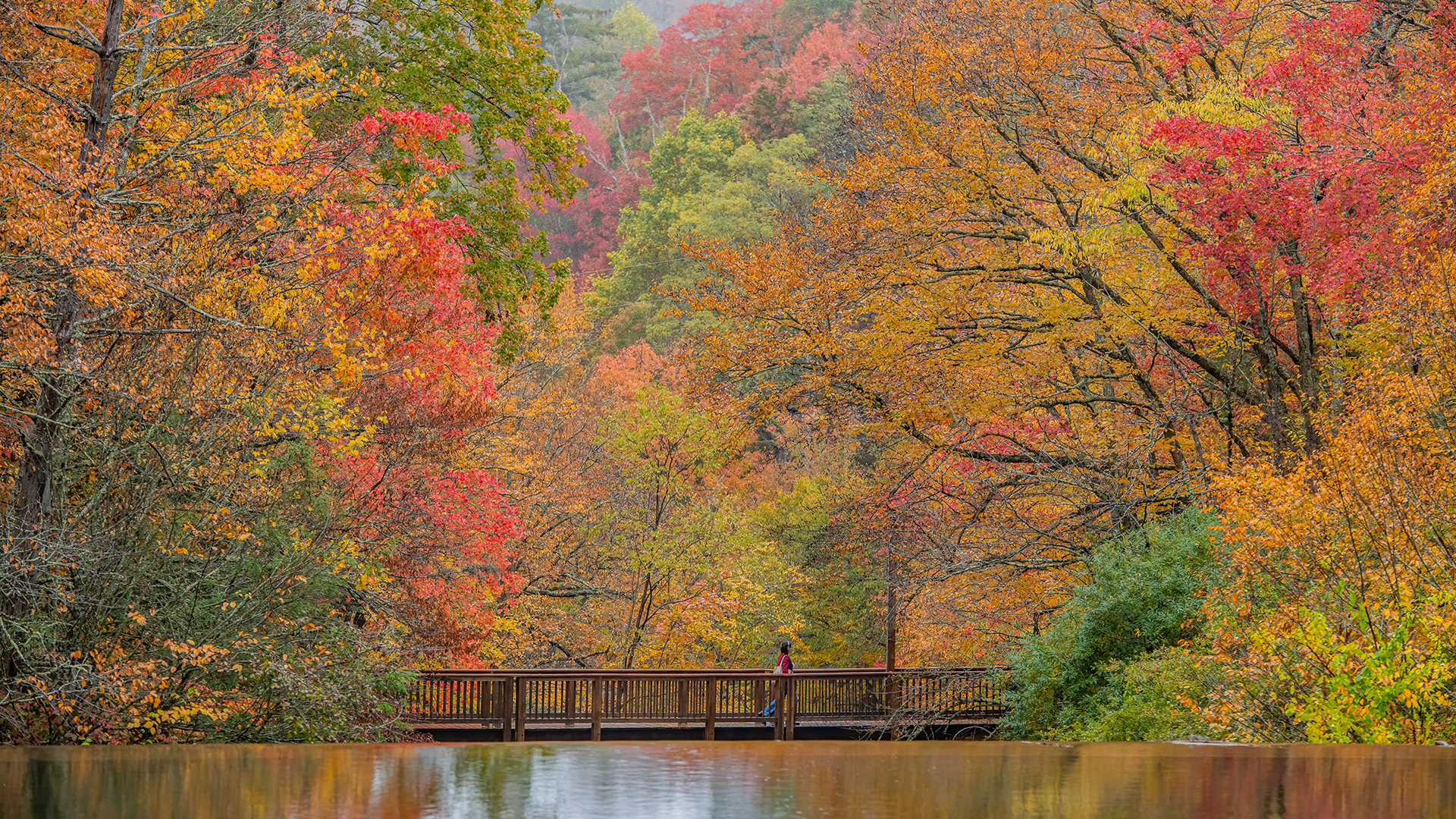
Grandfather Mountain Daily Fall Color Report | Oct. 19, 2023:
The Historic Cheese House in Banner Elk plays off the surrounding autumnal tones. The structure, built in 1917 and originally home to an award-winning cheddar cheese operation, is now owned by Lees-McRae College.
The 46th-annual Woolly Worm Festival takes place in Banner Elk on Saturday and Sunday. This event, paired with the spectacle of fall color, should make for an exciting and busy weekend in the N.C. High Country.
Photo by Skip Sickler | Grandfather Mountain Stewardship Foundation
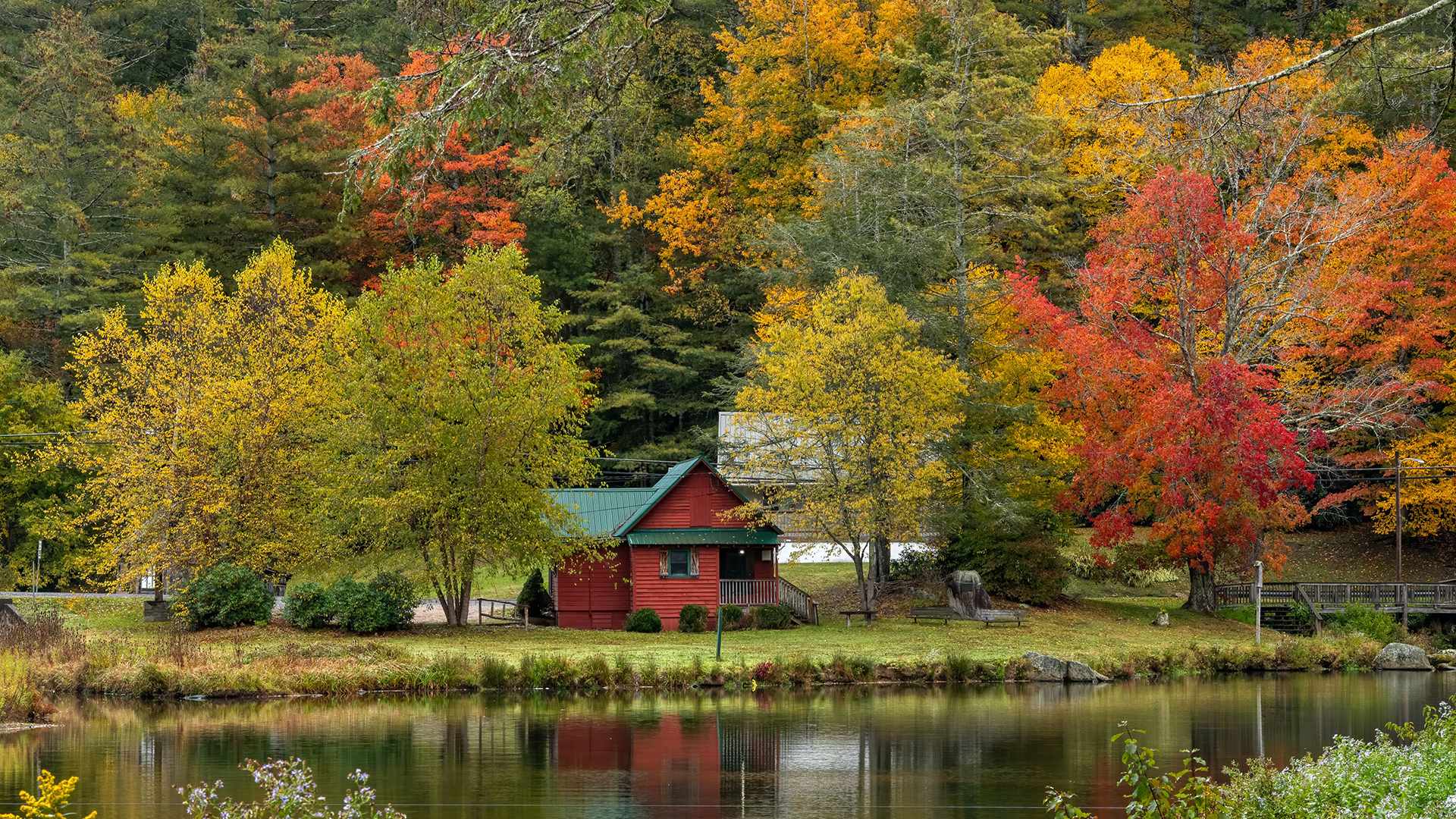
Grandfather Mountain Daily Fall Color Report | Oct. 18, 2023:
Fall foliage on the mountain remains exceptionally colorful as the surrounding vistas get increasingly vibrant. Colors are currently the best above 3,500 feet.
The Mildred the Bear Environmental Habitats provide another perspective of autumn hues, as seen in this image from an overlook at the bear habitats. The color show can also be enjoyed from the cougar and elk viewing areas.
Photo by Leslie Restivo | Grandfather Mountain Stewardship Foundation
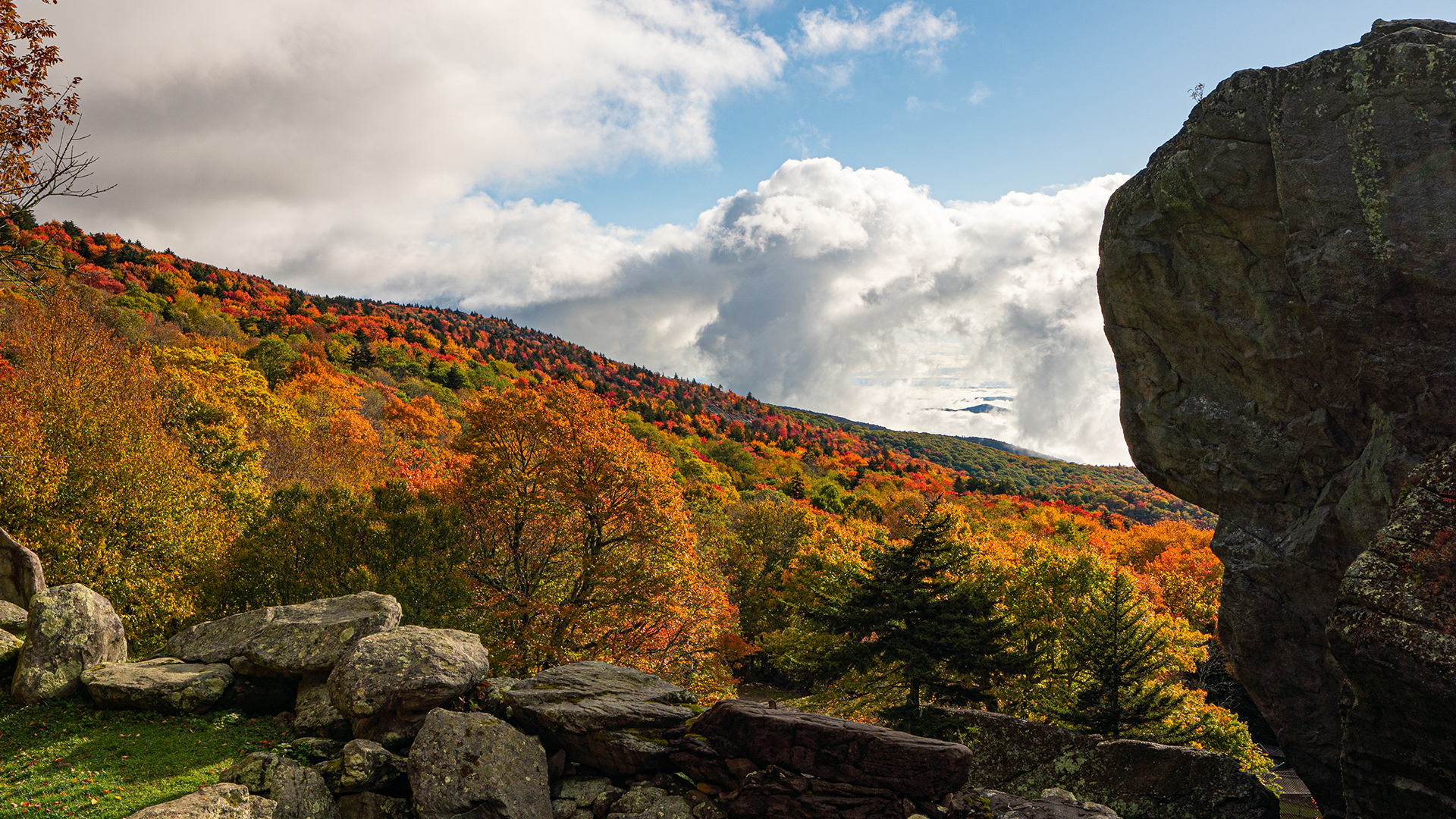
Grandfather Mountain Daily Fall Color Report | Oct. 17, 2023:
This stretch of the Blue Ridge Parkway around Grandfather Mountain is really showing off a vibrant blend of fall colors this week. The scene displayed in this photo is a long-distance view of the very popular Rough Ridge, which can be accessed from a trail at Milepost 302.8.
Though clouds linger today, overcast skies can make fall colors pop against the landscape. Sunshine is forecasted to return on Wednesday and Thursday.
Photo by Skip Sickler | Grandfather Mountain Stewardship Foundation
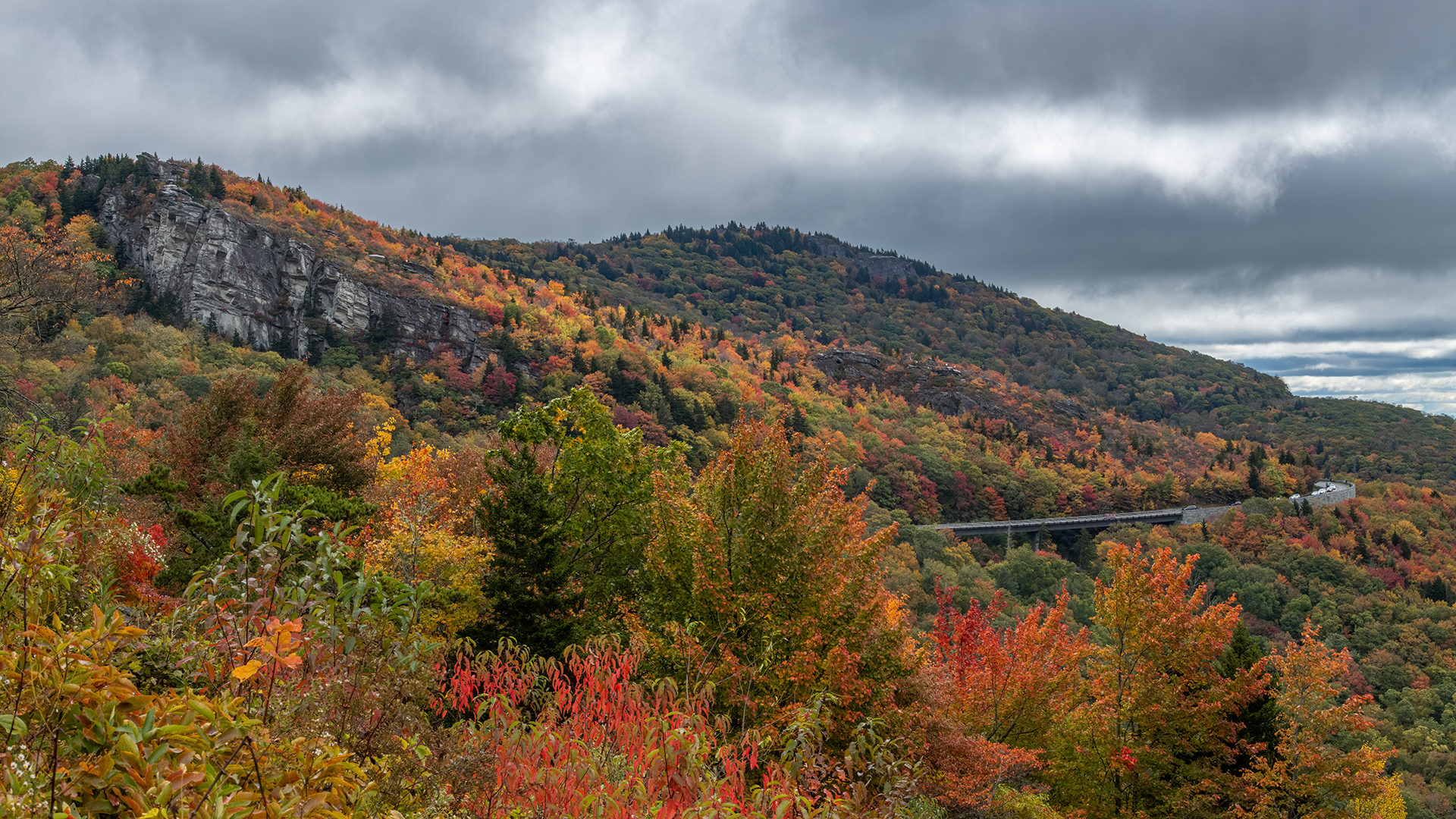
Grandfather Mountain Daily Fall Color Report | Oct. 16, 2023:
Color has really ramped up across the area in the last few days, as seen in this iconic view of the Linn Cove Viaduct from U.S. 221. The surrounding towns of Linville, Blowing Rock, Banner Elk, Beech Mountain and Boone are all great locations to see widespread and vibrant color.
This photo was taken on Sunday. Today is a chilly day in the N.C. High Country, with light snow, rime ice and wind chills in the teens at the highest elevations of Grandfather Mountain.
Photo by Skip Sickler | Grandfather Mountain Stewardship Foundation
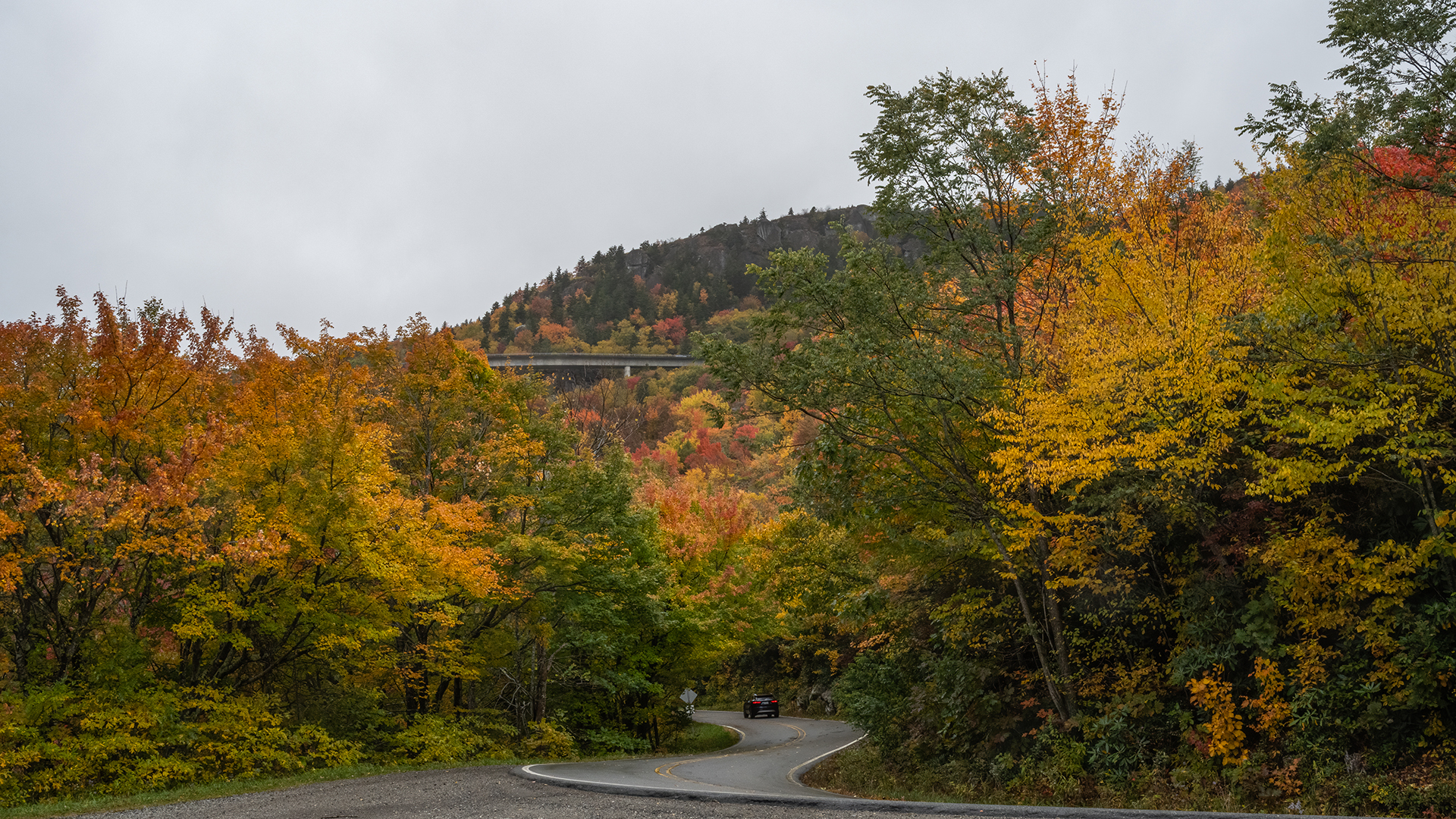
Fall Color Report for the Week of October 14, 2023
Today started off in mist and drizzle, although it was relatively warm. We almost canceled our trip because of the dreary conditions, but seeing light off to the northeast where we were headed spurred us on and that turned out to be the right decision, as the day consistently got better weather wise and by the afternoon we had partly cloudy skies with occasional bright sun.
Today’s fall foliage reporters became a trio that included myself, of course, plus my wife Claudia, and my companion for the last two weeks, Eduardo de Campos. Having the three of us tromp through the forests looking at fall colors and taking photos was a most pleasant way to spend an autumn Saturday!
We headed out US 421 east from Boone to Deep Gap so we could get on the Blue Ridge Parkway (BRP), intending to go to Jeffress Park and Cascades Falls, but the BRP is closed in that section due to road construction, so we weren’t able to reach the park. Instead, we headed up US 221 to West Jefferson and then to the top of Jefferson State Natural Area, which is just a 1-mile drive from the highway. There are several overlooks along the way up and you could, if you wanted, hike up to the top, but we chose to drive all the way up to the picnic area at the summit.
Attached to this posting are pictures from Jefferson State Natural Area, near West Jefferson, NC. In the next post will be photos from Doughton Park.
Once there, you can take an easy 1-mile loop trail to Luther Rock (halfway out) where you’ll have great views to the northeast and southeast. Mt. Jefferson is nearly 5,000’ high at the top, so it is definitely cooler up there and the colors are more vivid at that high elevation right now. This place is definitely going to peak over the next week or so, and it’s currently colorful enough now to plan a trip there.
Jefferson State Natural Area has trees one routinely associates with the mid-Atlantic states like MD or PA, and include black, red, and white oaks (Quercus velutina, Q. rubra, and Q. alba), American chestnut (Castanea dentata), lots of red, sugar, and striped maples (Acer rubrum, A. saccharum, and A. pensylvanicum), plus beech (Fagus grandifolia) and cucumber and Fraser magnolias (Magnolia acuminate and M. fraseri). This is because of the high elevation of this mountain, and probably also the type of soil too. A few ash (Fraxinus sp.) are scattered here and there, along with the vine Dutchman’s Pipe (Aristolochia macrophylla). Right now, the maples are the most colorful up there, while the American chestnuts are morphing past peak, but still with plenty of yellow and brown leaves. Cucumber magnolia and beech are mostly still green, as many of the oaks, but they will color up over the next two weeks.
When you get to Luther Rock, you have great views off to the NE and SE. Then, you can take a loop trail which runs just below the crestline back to your car. This is a very easy hike and there are also plenty of picnic tables to have a nice outing there. Colors were much more advanced than I expected, so the coming week and next should be great for foliage color here.
After our hike, we decided to get some lunch in West Jefferson. We selected “The Tavern” restaurant, based on a recommendation from a friend, and were surprised to learn that today was its last day in business. New owners are taking over and renaming it the Red Dog, and it will become a bar and grill, as we understand. Nonetheless, we all had a great meal there, after which we headed toward Doughton Park in Allegheny County, north of Ashe County.
Because the BRP is undergoing considerable road construction, long stretches of it are closed to traffic. We headed out of town on Rts 18/88 South for about 20 miles or so, through very pretty countryside, before getting on the BRP about 7 miles south of Doughton Park. In this area, the only section open goes from where the BRP intersects Rt. 18, north to the Brinegar Cabin, where it closes again. If you are coming up from eastern NC on US 421, get off the highway in Wilkesboro and take Rt. 18 N. About 30 -45 minutes later or so, you’ll reach the BRP and can head north toward Doughton Park.
Doughton Park is several thousand acres in size and has plenty of trails and overlooks. We stopped at the Bluff Mt. trailhead and hiked up to the overlook, which took us about 20 minutes of easy hiking. The elevational increase is about 400’ and in the steep parts near the top the NPS has installed wooden stairs. Once at the top you have excellent views to the southeast and southwest.
There is also a dense stand of witch hazel (Hamamelis virginiana) adjacent to the rock outcrop (to the north). This shrub has leaves that turn a dull yellow with brown streaks, and it flowers in October, which is quite unusual. A cold-tolerant moth may pollinate the shrub, but so might flies and bees. The question of who pollinates this late flowering shrub is still ripe for study (https://grownativemass.org/…/The-Pollination-Puzzle-of…). See also this article (https://bygl.osu.edu/node/1751).
When we finished our viewing, we headed over to the Wildcat Overlook, about a mile from the Bluff Overlook (you could walk from one location to the other, but we chose to go in our car). The Wildcat Overlook offers one of the most spectacular views of anywhere on the BRP. If you look down the nearly 1000’ drop off, you can see a wood cabin in the valley below (see photo I took of it, using 30X mag on my Pixel 7 phone!). This is the Caudill Cabin. For years, I thought it was the Brinegar Cabin, but was corrected by the person in the store at the visitor’s center, which is located right on the BRP. The Brinegar Cabin is 2.5 miles past the visitor’s center going north, and is as far as you can go before the road closes again due to construction.
The Brinegar’s lived in a two-room cabin in the area about 100 years ago. Their descendants, and those of the Caudill’s, often get together on the BRP for reunions, according to the park personnel we spoke with today. Given the isolation of both cabins: e.g., 5.5 miles on a dirt road to any sort of human influence for the Caudill cabin, and perhaps a similar trek for the Brinegars to wherever they needed to go. You can drive right to the Brinegar’s cabin. If you want to visit the Caudill cabin, be prepared for a 5.5 mile hike to the cabin, and then 5.5 miles back (11 miles roundtrip!).
As it was now getting late, we headed back to West Jefferson, but instead of taking US 221 to US 421 back to Boone, we got off US 221 just south of West Jefferson onto Rt. 194 and headed from Ashe into Watauga County. This road, a scenic drive, goes through some very rural countryside with great views of fall foliage (which is looking very good right now and will be even better later this week into next weekend). I highly recommend this road as you can see some nice fall colors as you drive back to Boone.
Next week we are planning a trip to the summit of Elk Knob State Park just north of Boone. There is an easy 2 mile hike up with views in all directions at the top, which is over 5,000’ in elevation. The forests to the north of the Park always have great fall color, even in bad years, so we are hoping for colorful views next weekend.
Colors should develop rapidly this week, as temperatures are going to drop 20-30 degrees by Monday (there is even a prediction of snow flurries on Monday). It’s quite windy outside my home as I type this in the early evening, and I’m hoping it doesn’t take down too many leaves. Those that are still green will be fine, but for leaves on trees that have colored up this week, it could blow them off. Since we still have a lot of green trees, I think we’ll have great color into this week and next.
Here’s hoping you have a good rest of the weekend!
Grandfather Mountain Daily Fall Color Report | Oct. 15, 2023:
The drive along the Blue Ridge Parkway between Linville and Blowing Rock remains one of the best routes to see autumnal tones. This view offers the additional treat of fall color reflecting off of Price Lake. Grandfather Mountain is also mirrored in the water, as seen in this photo taken last week.
The colder temperatures expected for the next few days should continue fall’s widespread reach over the region. This week should be an especially nice time to go on fall adventures in the N.C. High Country.
Photo by Leslie Restivo | Grandfather Mountain Stewardship Foundation
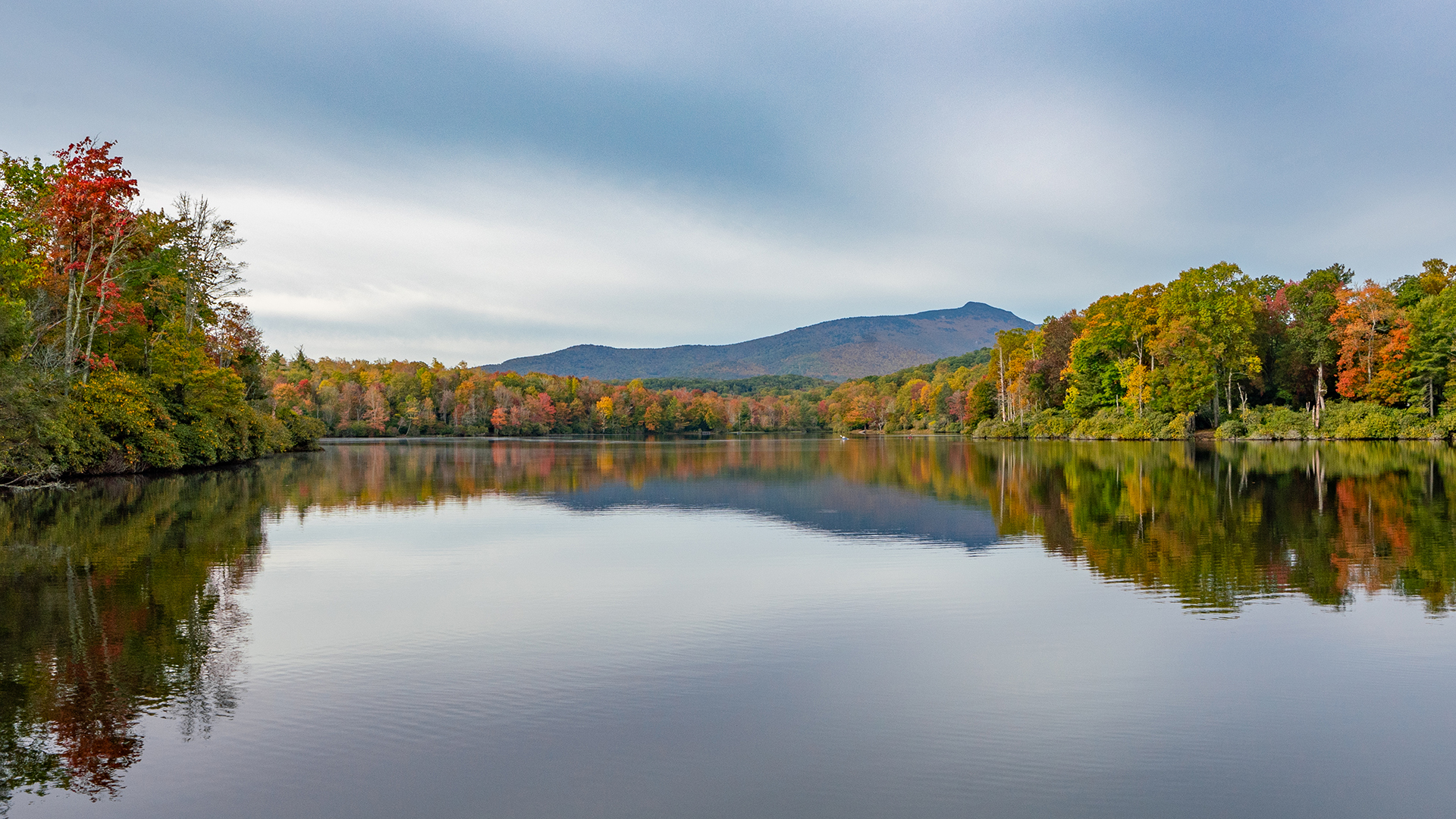
Grandfather Mountain Daily Fall Color Report | Oct. 14, 2023:
Color is widespread on the mountain, including in nearby MacRae Meadows, as seen in this photo taken earlier this week. Grandfather beautifully blends a landscape of rock faces and granite cliffs, the dark-green hue of evergreens and a kaleidoscope of fall colors.
Although light showers are forecasted for this (Saturday) morning, the day overall should still be great for fall color viewing.
Photo by Skip Sickler | Grandfather Mountain Stewardship Foundation
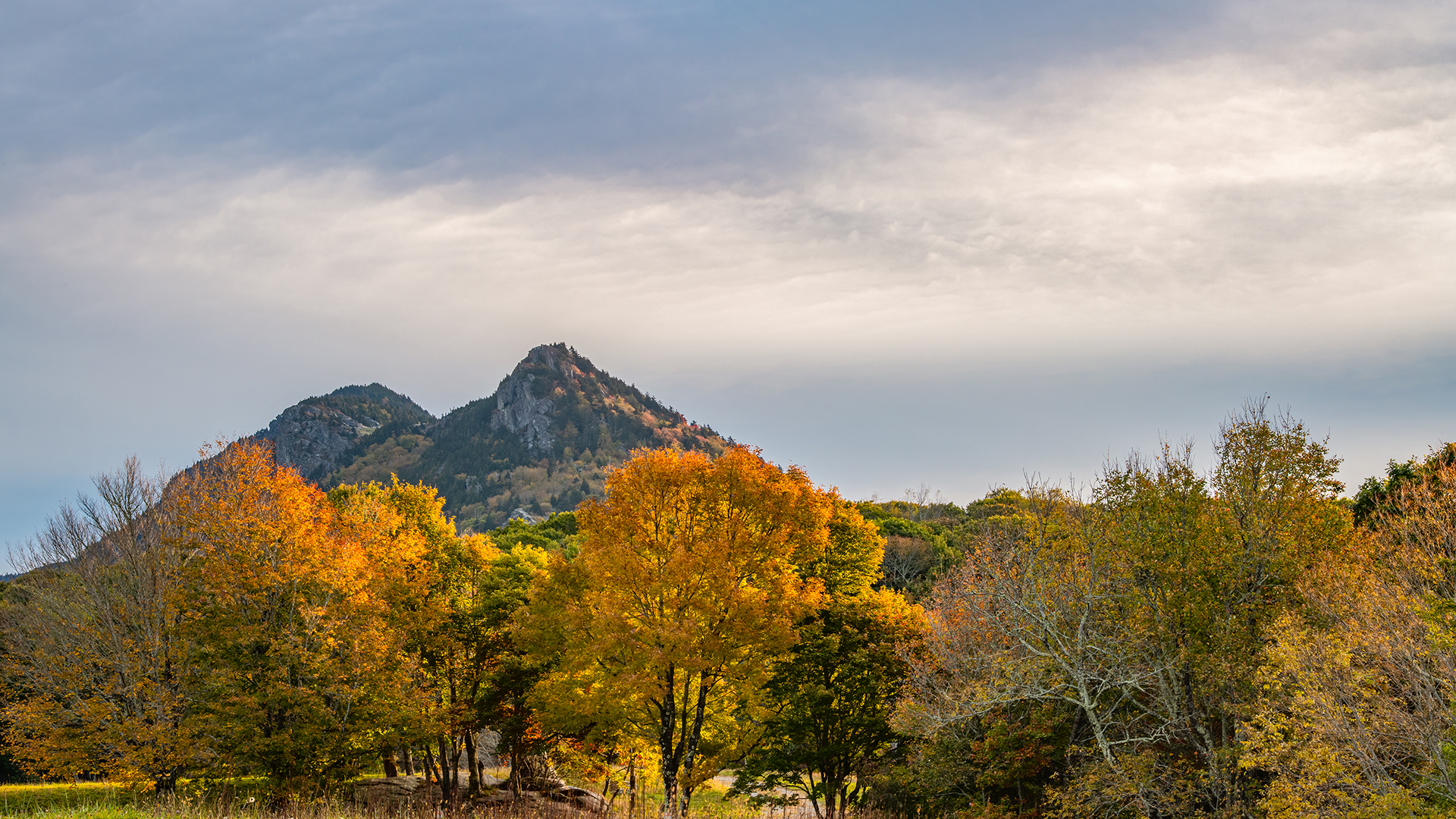
Grandfather Mountain Daily Fall Color Report | Oct. 13, 2023:
Cliffside Picnic Area and Overlook provides this unique vantage point looking up at Linville Peak, with fall foliage and the rich red hue of mountain ash berries brightening up the shot. This spot is just one of a dozen picnic areas in the park. These sites are located in some of the mountain’s most picturesque settings and offer an array of scenic views.
Today (Friday) would be a perfect day for an autumn picnic, with nice weather expected and the fall color progressing nicely.
Photo by Leslie Restivo | Grandfather Mountain Stewardship Foundation
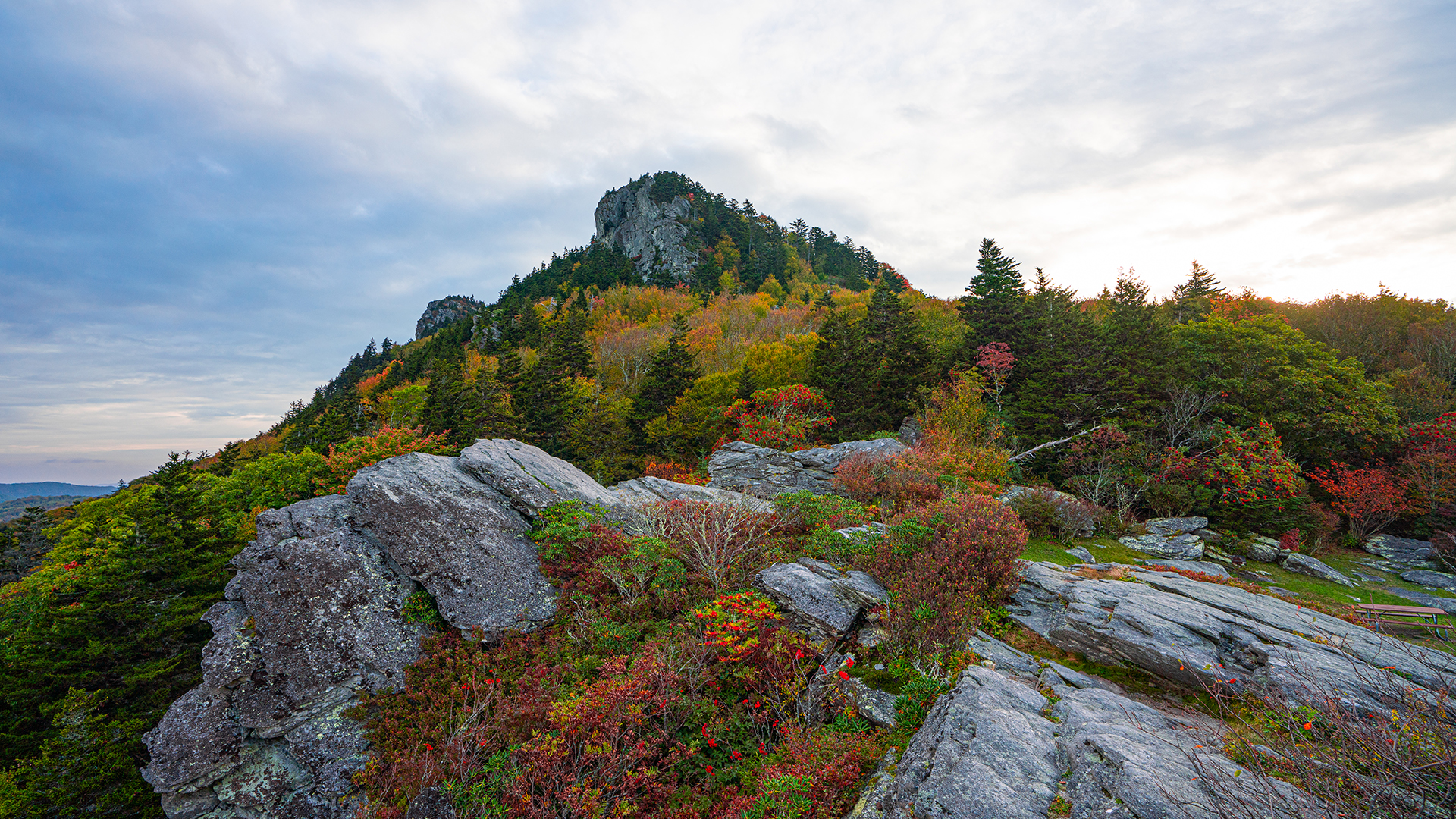
Grandfather Mountain Daily Fall Color Report | Oct. 12, 2023:
This long-distance shot of Grandfather Mountain’s Mile High Swinging Bridge (and Top Shop building, on the right) was taken from the Blue Ridge Parkway, near Green Mountain Overlook, at Milepost 300.6. The red, yellow and orange hues set against an evergreen backdrop are becoming more and more vibrant.
The weather conditions for Friday should be pleasant for leaf-peeping adventures in the area, with scattered light rainfall forecasted for over the weekend.
Photo by Leslie Restivo | Grandfather Mountain Stewardship Foundation
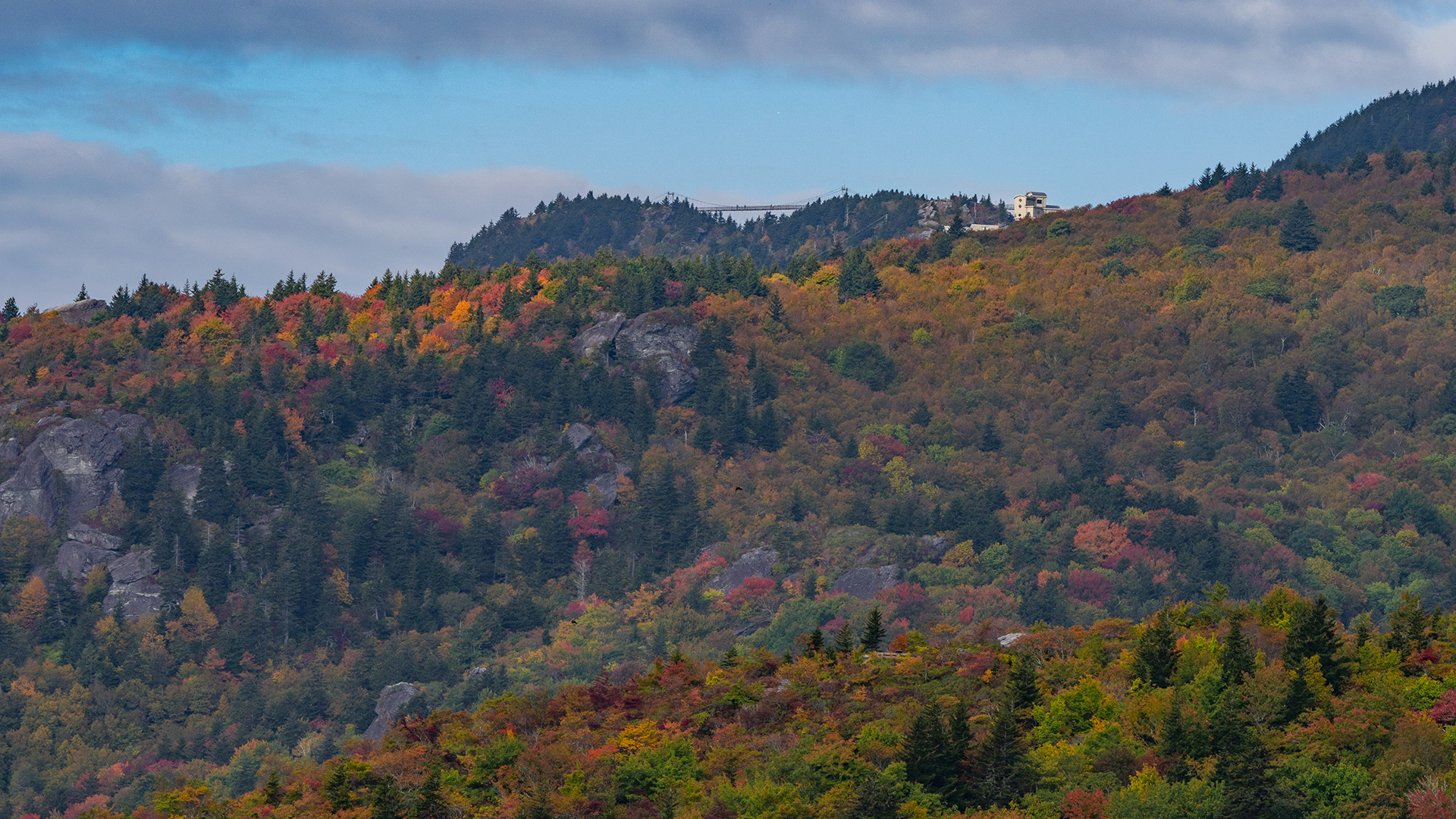
Grandfather Mountain Daily Fall Color Report | Oct. 11, 2023:
Though the mountain and surrounding areas have not yet reached their peak, more autumn hues are covering the landscape each day. Linville Peak’s lofty vantage point makes it one of the best places in the N.C. High Country to enjoy a fall view. Throughout the season, this location, on the far end of the Mile High Swinging Bridge, remains an ideal spot to take in the color progression as it makes its way down to lower elevations.
Photo by Leslie Restivo | Grandfather Mountain Stewardship Foundation
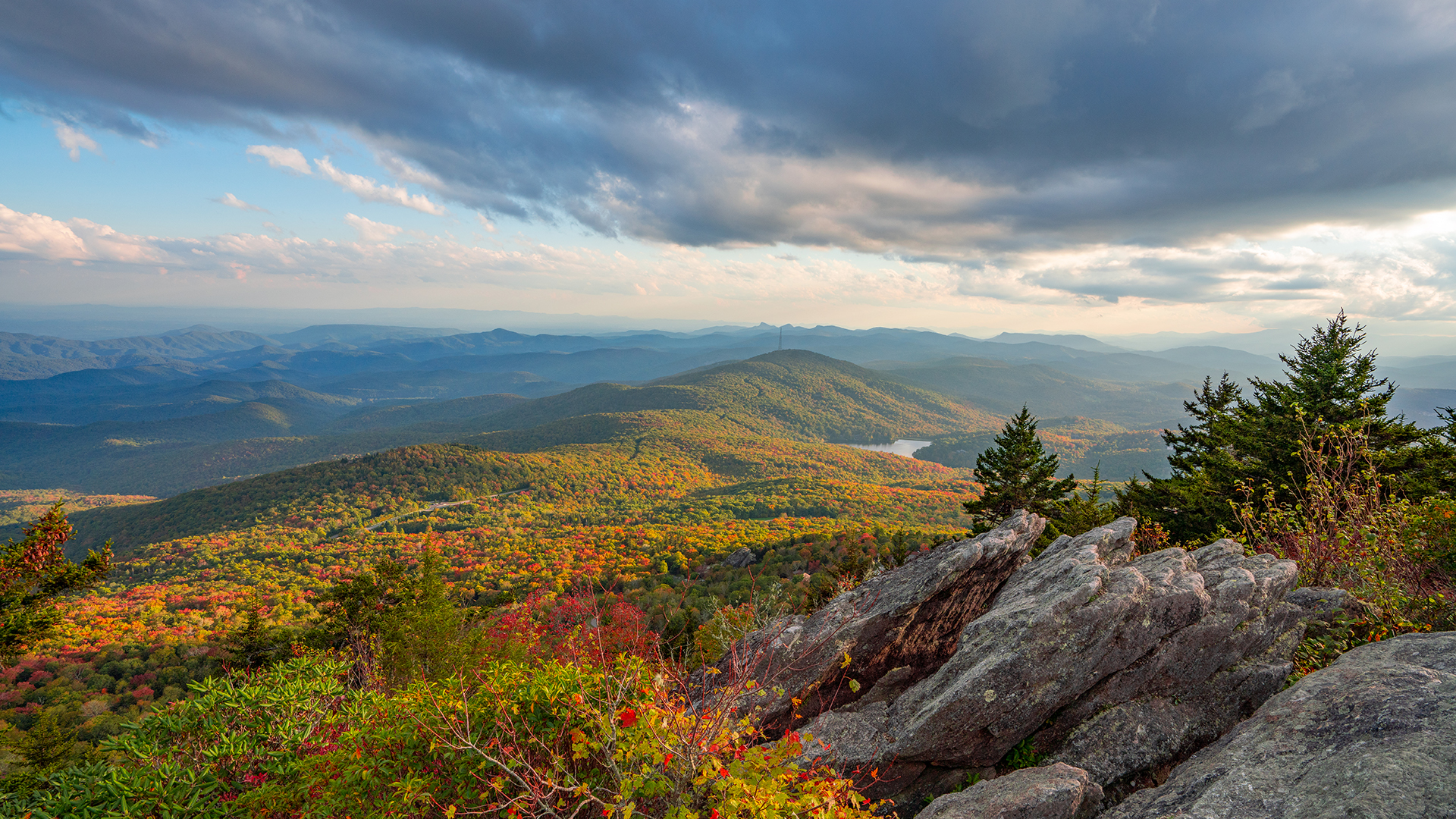
Grandfather Mountain Daily Fall Color Report | Oct. 10, 2023:
Bright hues of witch hazel highlight this iconic view of Forrest Gump Curve on the drive up to the top of Grandfather Mountain. Witch hazel is among the many seasonal plant species that also brighten up the fall color landscape. Likewise, unique and colorful in this area of the park right now are the red berries of mountain ash and the yellow flowers of goldenrod.
This vantage point can be found at Cliffside Overlook.
Photo by Leslie Restivo | Grandfather Mountain Stewardship Foundation
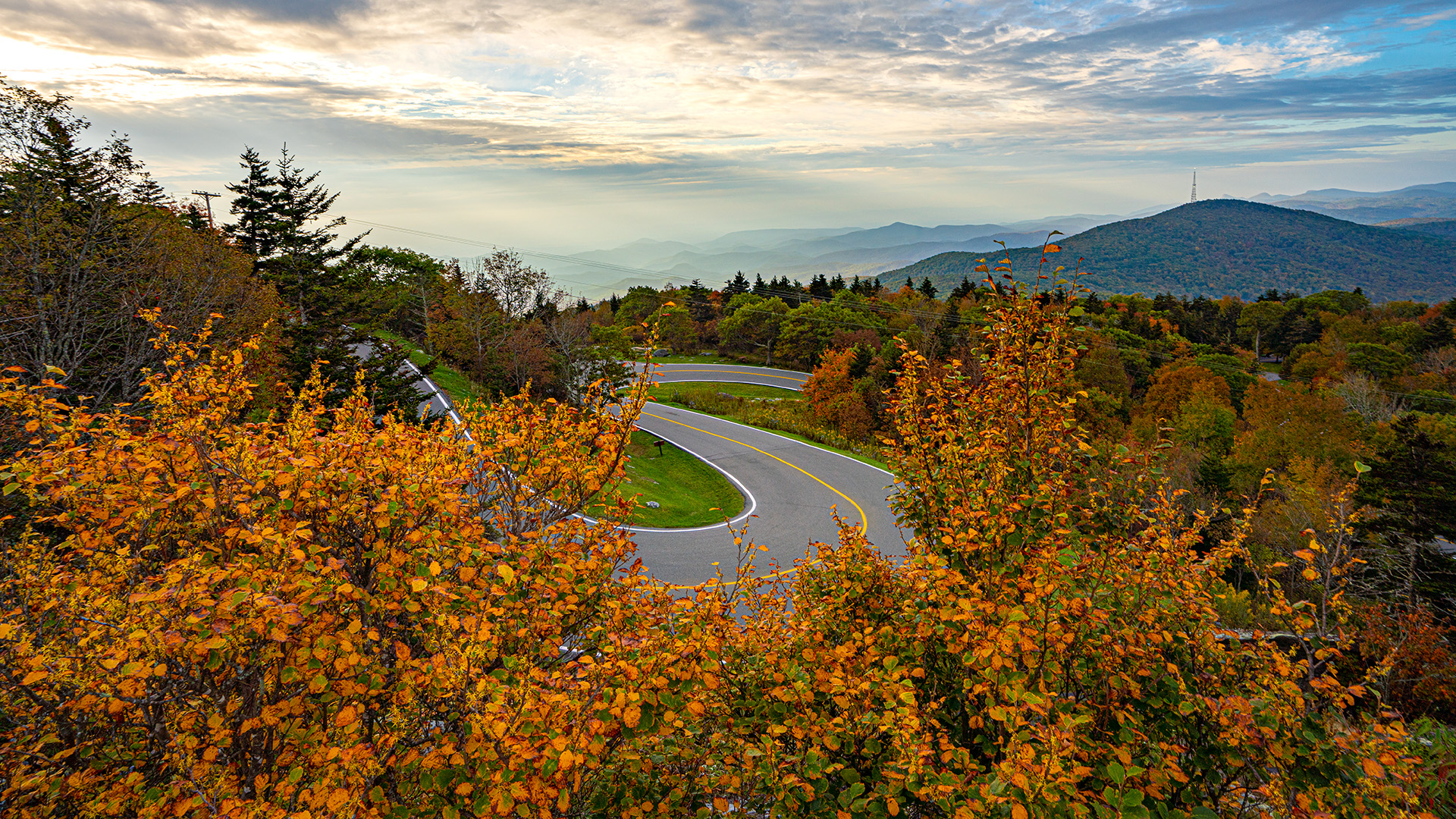
Grandfather Mountain Daily Fall Color Report | Oct. 9, 2023:
The park road at Grandfather Mountain provides a nice snapshot of the current landscape. While some vibrant trees and pockets of color dot the hillsides, there is still much to come. Overall in the region, a lot of green remains.
This view from the switchbacks near the top of the mountain shows the entrance of the Bridge Trail across from the Black Rock parking lot.
Photo by Skip Sickler | Grandfather Mountain Stewardship Foundation
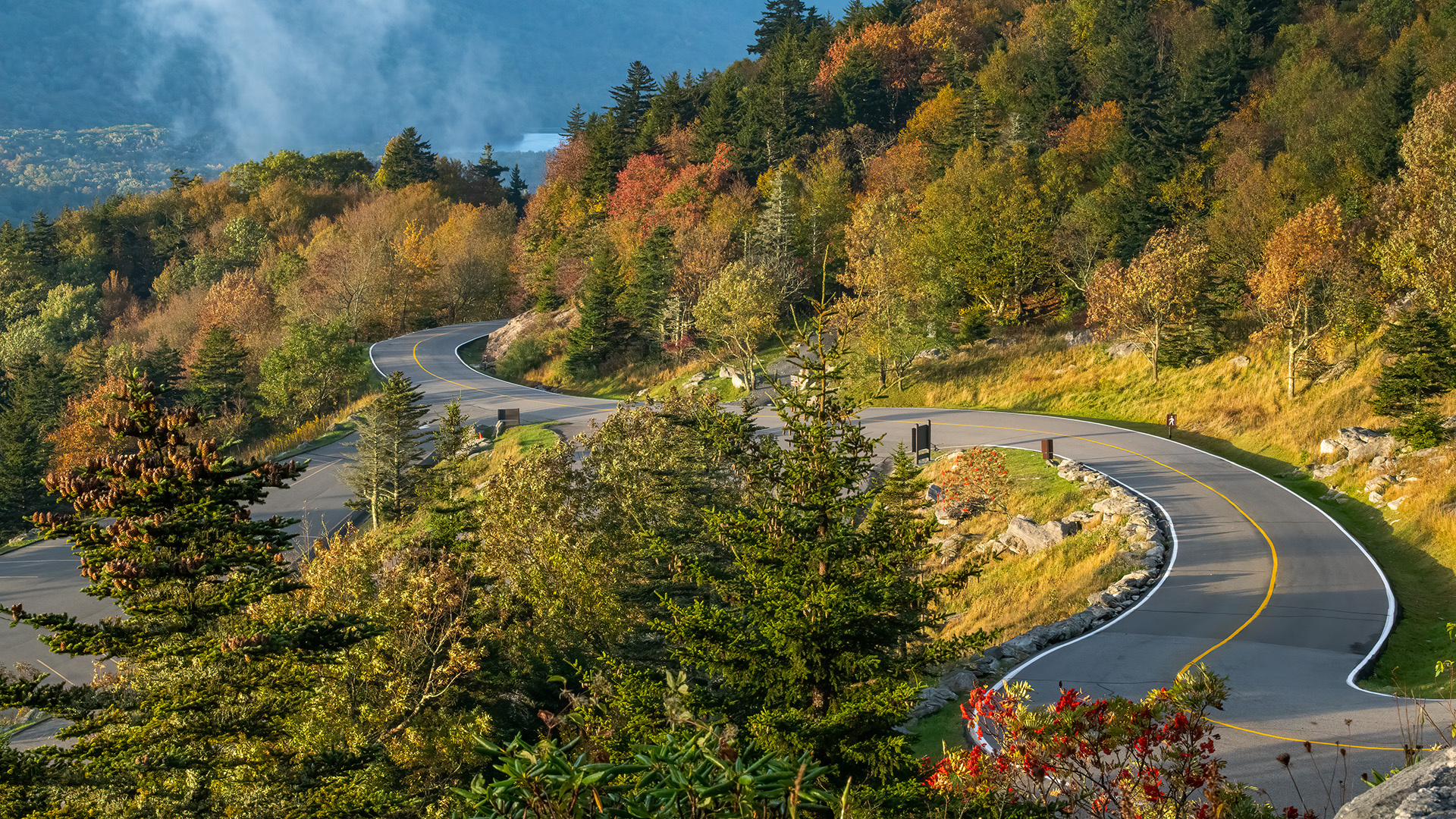
Fall Color Report for the Week of October 8, 2023
I posted about my trip on Friday with WXII-TV meteorologist James Scott yesterday, along with photos of my hikes on the Rough Ridge Trail and the one that goes to the Linn Cove Viaduct alongside the Blue Ridge Parkway (BRP). Today, I provide some more photos of my trip with my colleague Dr. Eduardo de Campos, who was making his first visits to all these locations. Eduardo comes to us from Brazil and is a 2nd year professor of chemistry at Appstate.
In this posting I provide pictures from our trips to Wisemans View in the Linville Gorge Wilderness Area and Linville Falls (photos in a separate posting from this one) and in this posting our trips to Beacon Heights and Grandfather Mt. We had a superb day on Saturday, with abundant sunshine, cool, comfortable hiking temperatures, and a stiff but bracing wind up at the Mile-High Swinging Bridge (it actually is 5,280’ above sea level)!
The maples and black gums are providing the majority of the red colors now, along with some sourwoods, dogwoods, and various shrubs such as Vaccinium and Gaylussacia (blueberry and huckleberry, respectively). Tulip poplars (Liriodendron tulipifera) and Fraser magnolias (Magnolia fraseri) are turning rapidly now to yellow; tulip poplar leaves can become bright yellow, then they turn black and fall off, while the large Fraser magnolias start off a dull yellow before morphing over to a nice chocolate brown color. Birches are also coloring up as are American chestnuts (both turn yellow).
A cold front moved in late Saturday and temperatures today (Sunday) never got higher than 48F, which is great for stimulating color development on the trees. We’ve needed a good drop in temperatures to get colors going, since last week had above normal temperatures. The 10-day forecast says that the Boone area won’t get out of the 50s until Wednesday, then stay in the 60s, before rising to 71F late in the week, after which temperatures are supposed to drop again. These are near perfect conditions for good color development. There could be some rain late Saturday or Sunday, but lots of sunshine the rest of the week. This bodes well for good fall foliage color! My only worry is if there are strong winds, as they could knock off leaves if they are highly colored, because such leaves are not held onto the tree as tightly as those that are still green.
Based on these weather predictions, I am suggesting that color will develop rapidly this week on into the following weekend, and continue into the following week. Thus, our peak for the 3,000-4,500’ elevational range will most likely occur between Oct 13-20, which would put us on-time this year. Whether it will be as vibrant as last year, which was probably the best in the last 15 years, is anyone’s guess. We know more about timing than vibrancy.
So, where to go this coming week? The BRP from Blowing Rock to Chestoa Overlook (4 miles south of the US 221 intersection) is a good drive with great views. This includes a variety of hiking trails of varying difficulty and of course, GF Mt (reservations required!). The section from Graveyards, below Asheville, all the way to the Smokies would be good too, and there are campsites, waterfalls, hiking and plenty of overlooks along this stretch, which ends in Cherokee, NC in Great Smoky Mountains National Park (GRSM). It may be slightly ahead of peak color at the lower elevations in GRSM, but higher up should have color. Be aware that this most visited park, with some 14 million visitors per year, can get extremely crowded, especially on weekends, so plan accordingly.
Doughton Park and Jeffress Park (which has Cascades Falls) in the northern section of the BRP (north of US 421) are also good for hiking and views, but you have to check ahead of time for road closures on the BRP in that section. This website (https://www.nps.gov/…/blue-ridge-parkway-begins-major…) shows a map of the road closures in North Carolina from the VA line down to the Linn Cove Visitor Center. The three major road closures are all north of US 421 and you’ll have to take detours to visit places in this part of the BRP.
Finally, Elk Knob State Park (just north of Boone) and Jefferson State Natural Area (adjacent to West Jefferson) are two places worth checking out this coming week. Colors should be approaching peak at Elk Knob and nearly so at Jefferson Natural Area. It’s an easy two-mile hike to the top of Elk Knob, with views in all directions, while you can drive to the top of the Jefferson State Area, and then take a short hike along the ridge to some great views at the end, and then loop back to your car. Enjoy!
Grandfather Mountain Daily Fall Color Report | Oct. 8, 2023:
Very nice pockets of color are developing around the Linn Cove Viaduct, the iconic bridge that winds around Grandfather Mountain. Today’s forecast looks favorable for a scenic autumn drive along this stretch of the Blue Ridge Parkway between Grandfather and Blowing Rock.
Fall foliage in the region is at its best above 4,500 feet in elevation, though this weekend’s colder temperatures could spur the color development on.
Photo by Skip Sickler | Grandfather Mountain Stewardship Foundation
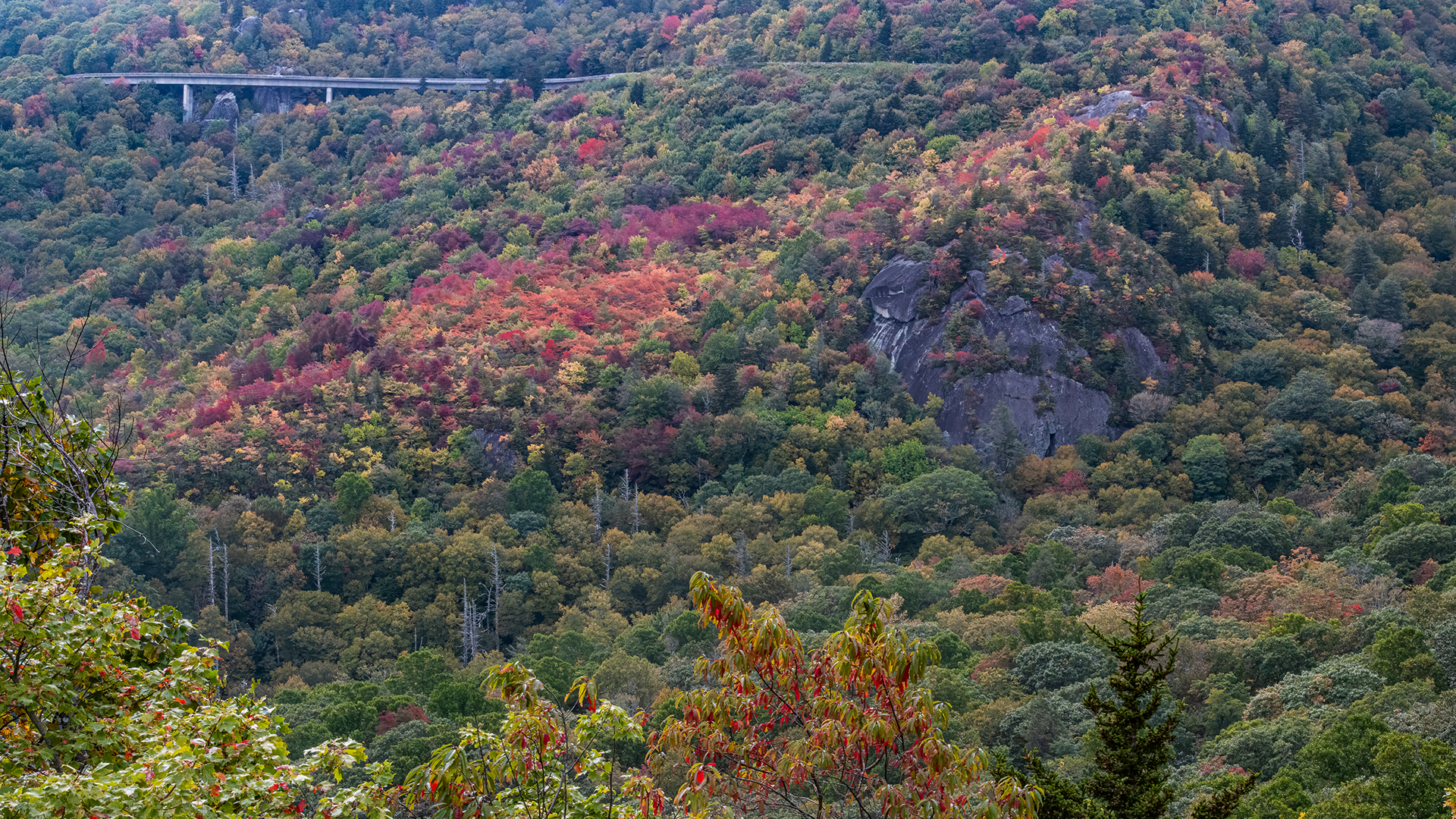
Fall Color Report for Oct 6-2023
Yesterday (Friday) I went out with James Scott from WCCB-TV in Charlotte to talk about fall leaf colors. The link to the report is included here.
https://www.wccbcharlotte.com/…/forecasting-foliage…/
We went to the Rough Ridge Trail just north of the Linn Cove Viaduct, one of the most popular trails on the Blue Ridge Parkway (BRP). As expected, for a Friday as we near peak color, it was crowded. Nonetheless we took off and did the interview on the boardwalk that is about 1/3 of the way up.
The day was partly cloudy, but began to clear just after we finished the interview. Leaf colors are developing nicely in this area, and some patches of forest were at peak color. I don’t know why these patches of forest are way ahead of the majority of the forest, but perhaps the soils differ in those patches, or maybe the species of tree. No matter what the cause, it happens every year. I need to hike down into the patches to get an up close look at what’s going on in them!
As you might notice from the attached photos, color saturation is quite high on a cloudy day, and photos of leaf color come out exceptionally good on such days. The main trees that are turning now are sassafras (Sassafras albidum) which can be all colors from yellow to orange to red; black gum (Nyssa sylvatica), which turns a deep red color; Quaking aspen, I think (Populus tremuloides) which turns a bright yellow, sometimes tinged with red; Mt. Ash (Sorbus americana) with bright red berries and yellow/orange leaves; red maple (Acer rubrum) with brilliant red leaves; Fraser magnolias (Magnolia fraseri) yellow then brown. There are many more species, too numerous to name, although if they are in the photos, I’ll provide their names there.
Forests are coloring up nicely now and you will be rewarded with nice views over the next two weeks. A cold front moved in today, dropping the temperatures some, but not as much as I would like, though it should be enough to prod the trees on. I think color will continue to improve to next weekend and will peak the week after that (Oct 13-20) in the 3-4,500’ elevational range.
After the interview with WCCB, I hiked up to the top of Rough Ridge, then headed south on the Parkway and hiked alongside the road to the viaduct, since that short walk has such great views.
In my next posting, I’ll fill you in on my visit today (Saturday, Oct 7) to several locations, including Wiseman’s View in the Linville Gorge Wilderness Area, Linville Falls, Beacon Heights, and Grandfather Mt.
Grandfather Mountain Daily Fall Color Report | Oct. 7, 2023:
One of the best places in the park for spotting fall foliage right now is from the area in front of the Wilson Center for Nature Discovery. This view looking up toward Linville Peak showcases a variety of seasonal colors contrasted with evergreen trees.
If visiting this weekend, guests can expect to see the most color at the Wilson Center and above. Views also remain nice from the Mile High Swinging Bridge and other high vantage points on the mountain. The weekend will be a chilly one at Grandfather, so pack your jacket!
Photo by Skip Sickler | Grandfather Mountain Stewardship Foundation
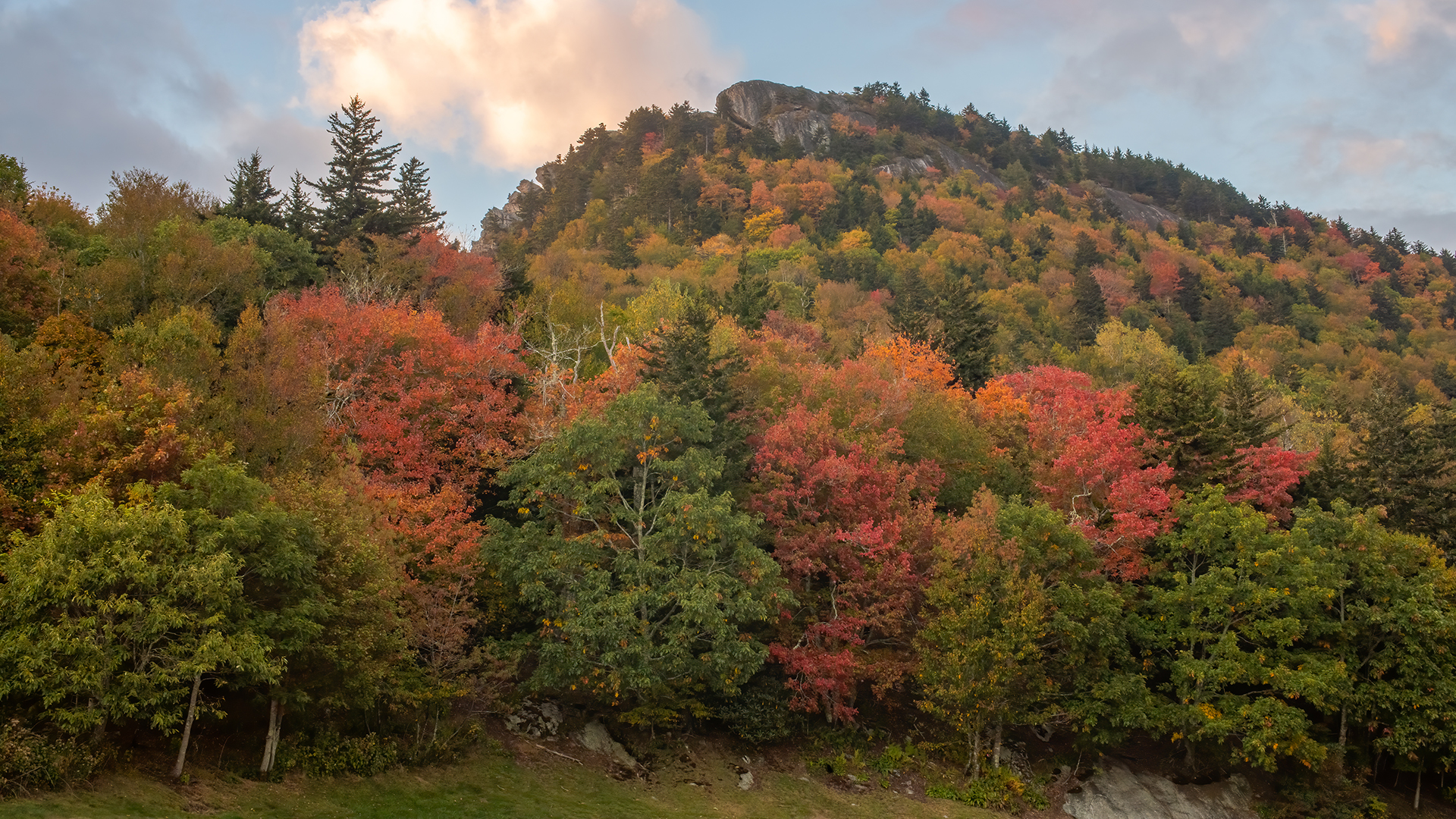
Grandfather Mountain Daily Fall Color Report | Oct. 6, 2023:
Fall vibrancy continues to ramp up in the High Country, as seen in this image looking toward neighboring Grandmother Mountain from the end of the Black Rock Trail.
This coming weekend calls for sunshine and optimal conditions to view autumn hues at the highest elevations of Grandfather and nearby on the Blue Ridge Parkway.
With colder temperatures expected, we recommend bringing extra layers on your leaf-looking expeditions.
Photo by Leslie Restivo | Grandfather Mountain Stewardship Foundation
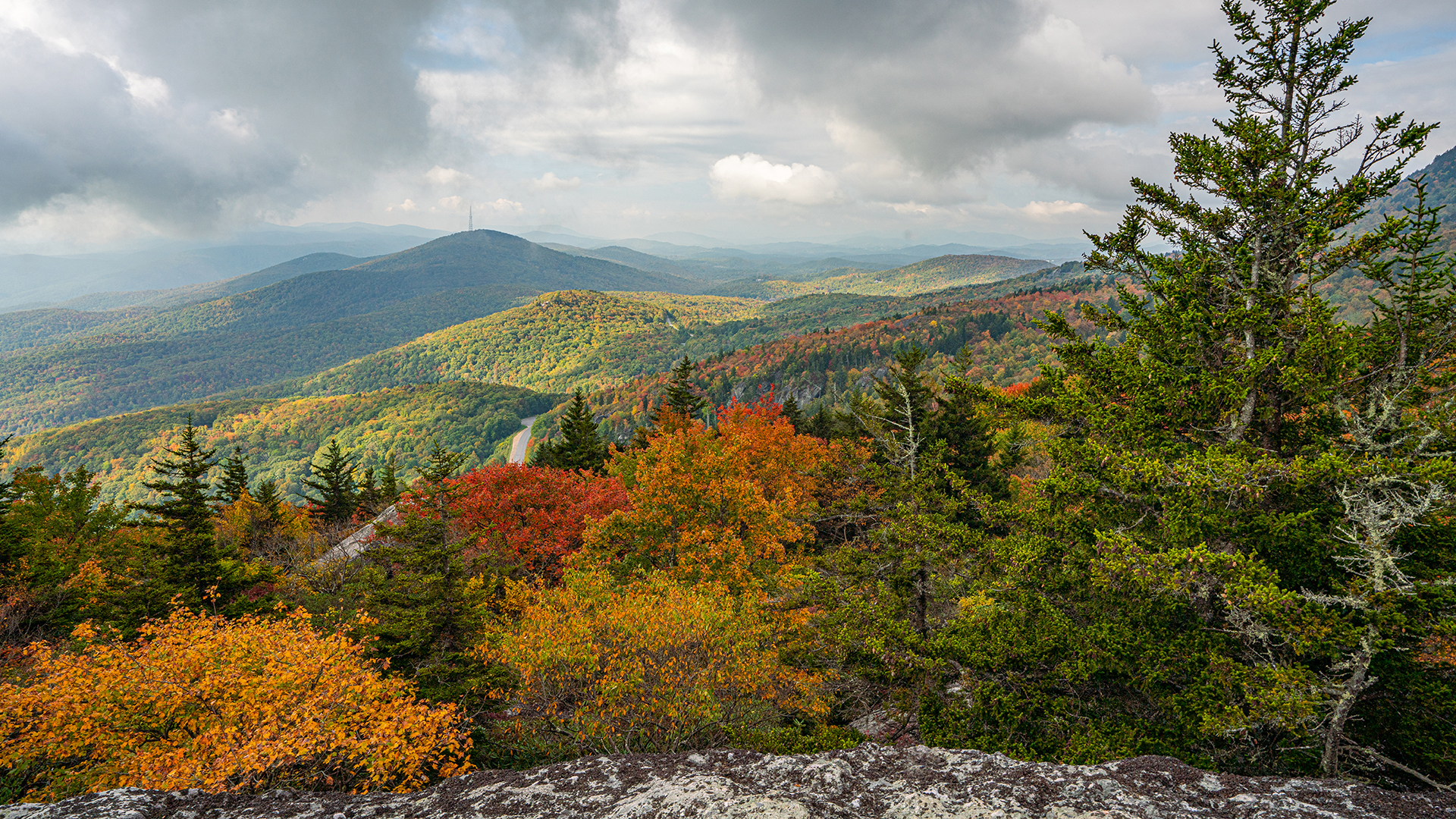
Grandfather Mountain Daily Fall Color Report | Oct. 5, 2023:
Fall color is filling the landscape of Grandfather’s upper reaches, as seen in this image looking up at Linville and Morton Peaks.
While there is still a lot of green on the mountain, the transition to autumn hues is progressing from one day to the next. Colder temperatures are expected to move in this weekend and may cause the process to quicken.
Photo by Skip Sickler | Grandfather Mountain Stewardship Foundation
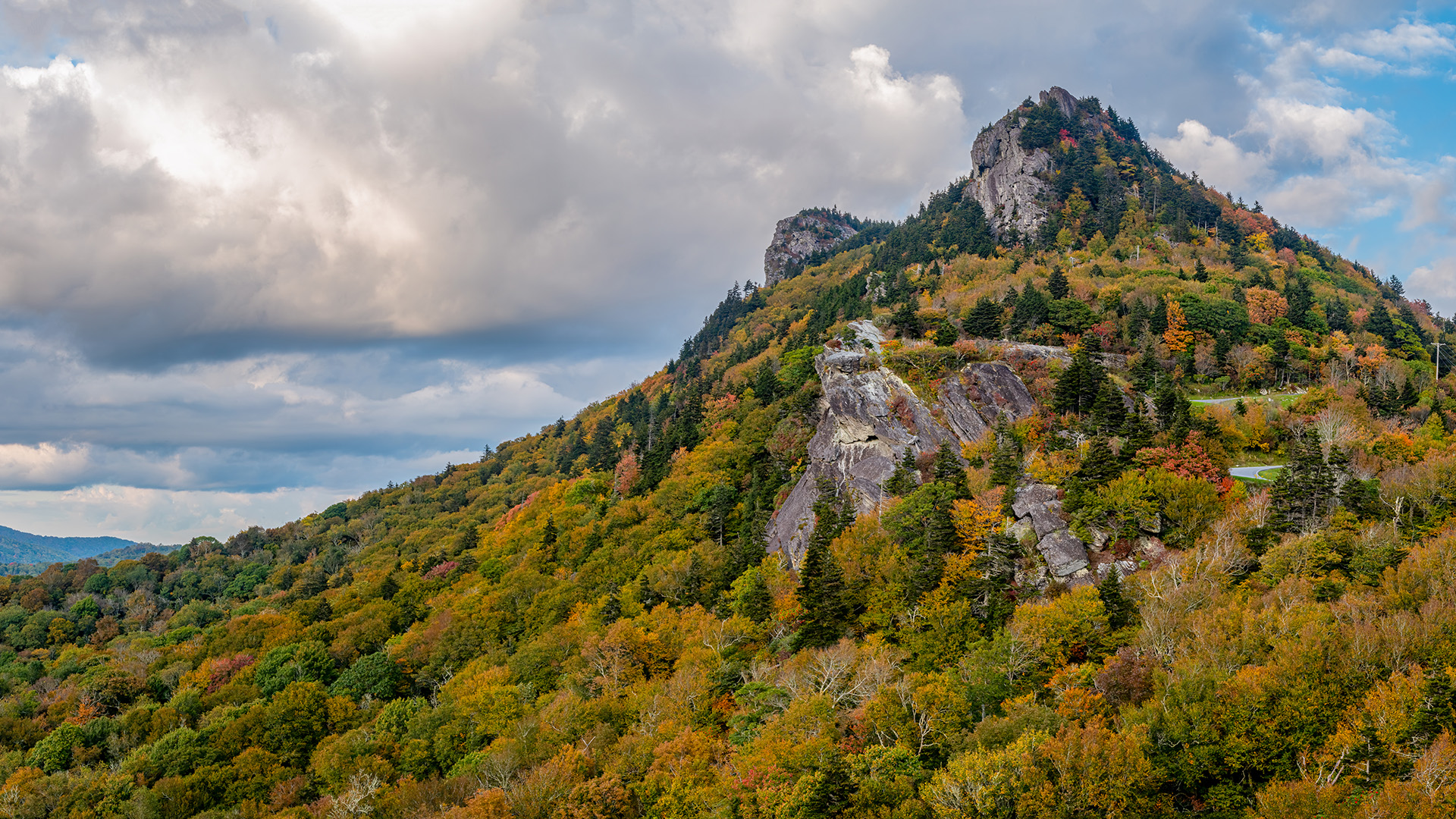
Grandfather Mountain Daily Fall Color Report | Oct. 4, 2023:
This sunrise photo was taken from the Mile High Swinging Bridge, which provides the perfect vantage point for viewing the autumn hues.
Pictured is a spot (in the middle of this photo) that turns early every year and exhibits particularly vibrant fall color. This area, between Grandfather Mountain and the Blue Ridge Parkway, usually changes first because it is a heath bald and the associated shrubs transition before the trees that surround it, making it pop amid the landscape.
Photo by Leslie Restivo | Grandfather Mountain Stewardship Foundation
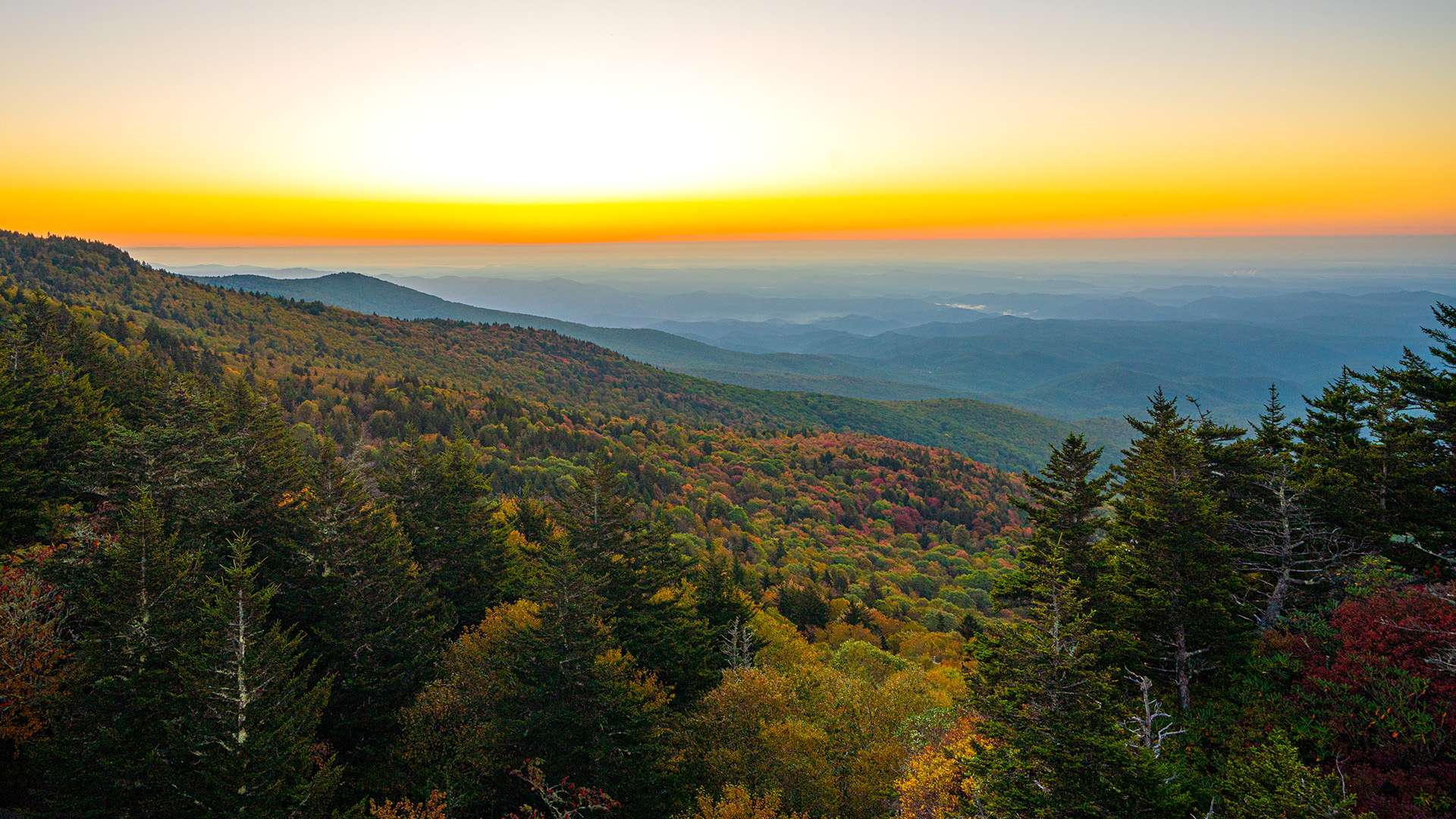
Grandfather Mountain Daily Fall Color Report | Oct. 3, 2023:
Fall color continues to emerge at the highest elevations of Grandfather Mountain. This photo was taken from the end of the Black Rock Trail looking toward the Wilson Center for Nature Discovery.
The park’s daily Fall Color Ramble, happening this week, begins at various locations around the Wilson Center. Focusing on the science behind fall color, these guided walks start at 1 p.m. and are included with admission.
Photo by Leslie Restivo | Grandfather Mountain Stewardship Foundation
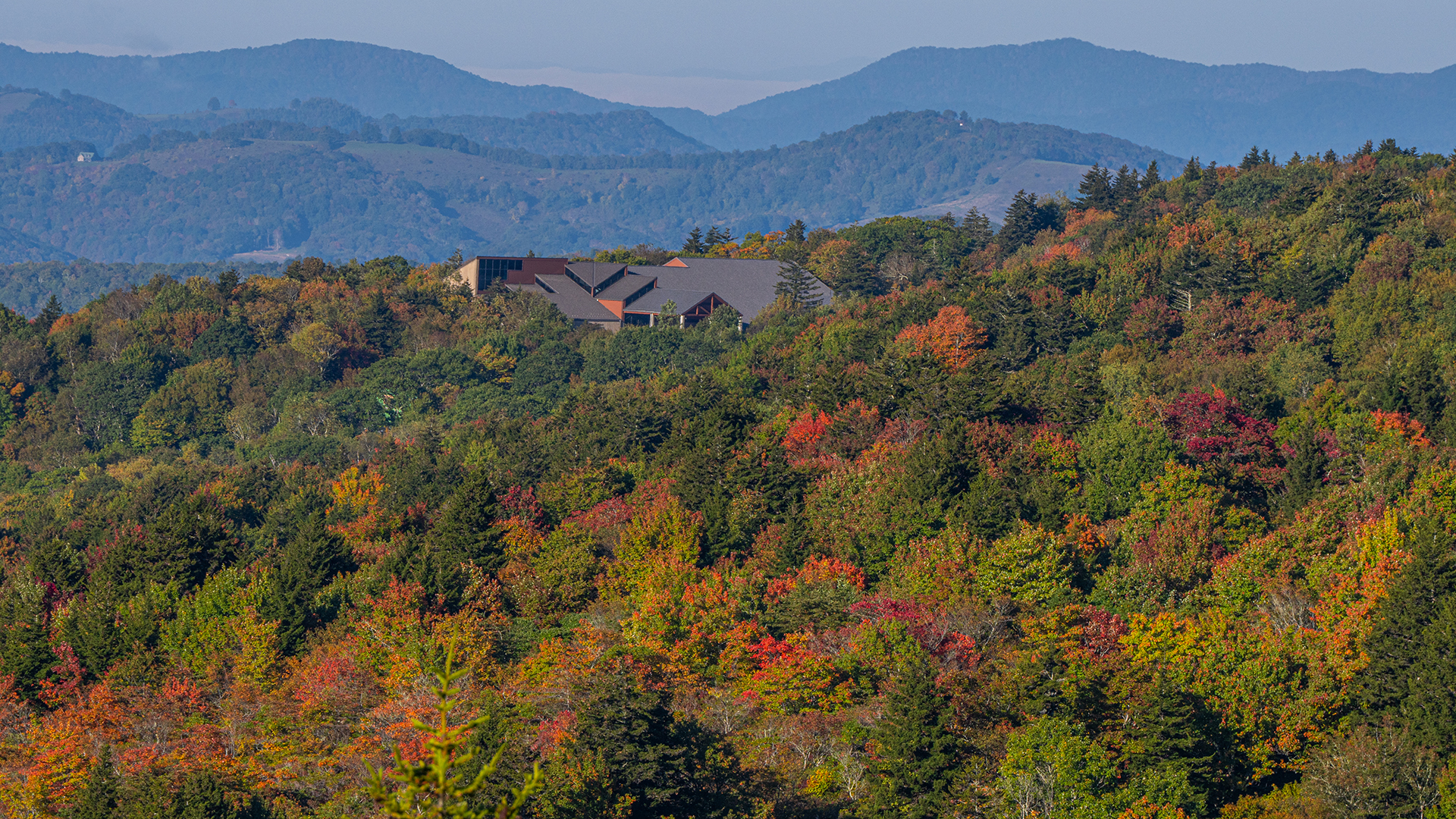
Grandfather Mountain Daily Fall Color Report | Oct. 2, 2023:
Hints of fall color are appearing in the N.C. High Country, especially at higher elevations, as seen here in this photo of Grandfather Mountain taken from the Blue Ridge Parkway. The area has experienced many sunny days and cool nights the last few weeks, prompting the seasonal transition.
While some pockets of color and certain trees are very vibrant at the moment, the overall landscape is still mostly green. The weather forecast for the week looks pleasant for those wanting to get the first glimpses of fall.
Photo by Skip Sickler | Grandfather Mountain Stewardship Foundation
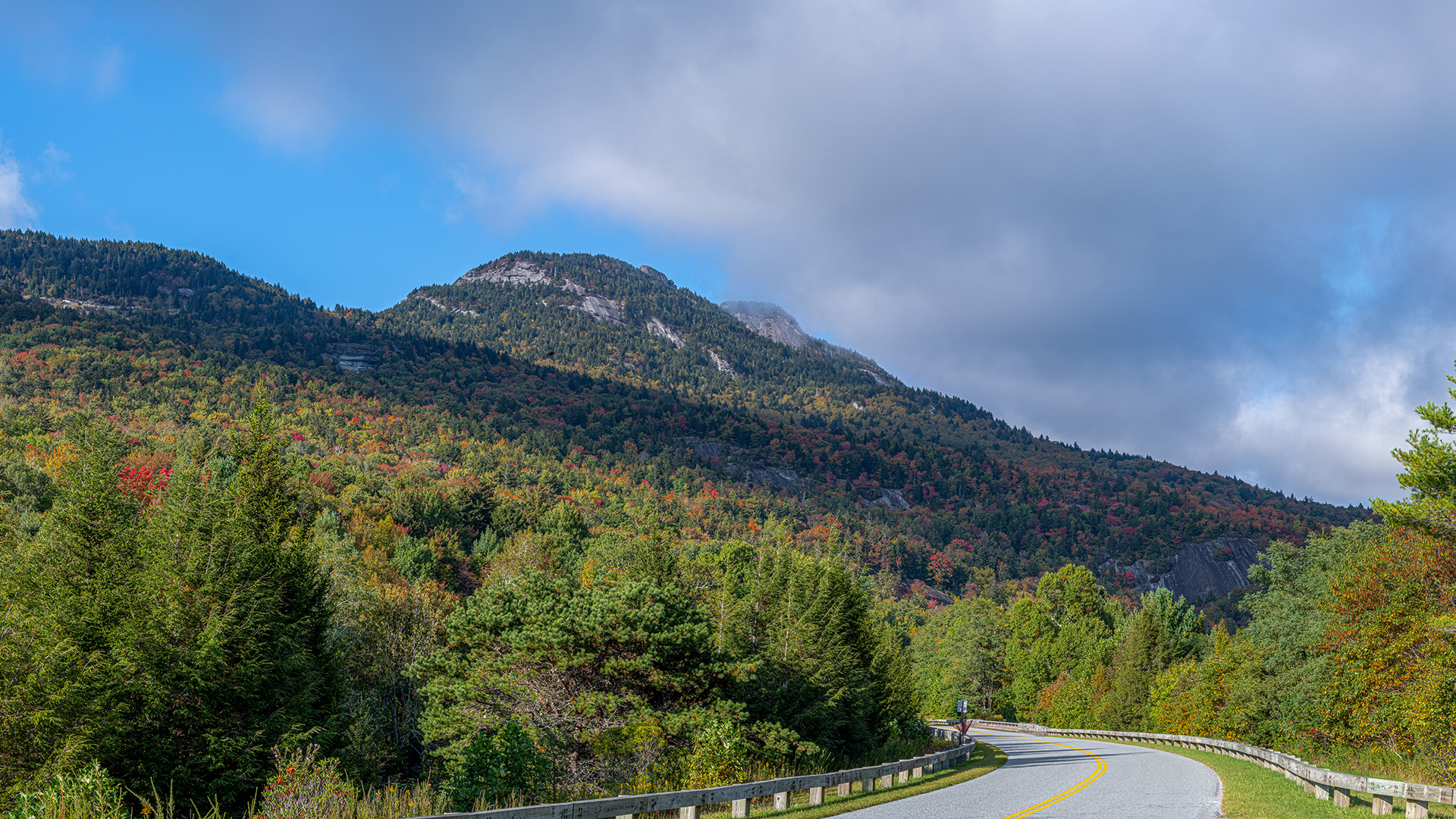
Fall Color Report for the Week of Oct 1, 2023
This week I traveled to Roan Mountain on the NC/TN border along with a colleague from the Chemistry Department at Appstate, Eduardo de Campos, who hails from Brazil. This was his first foray to the mountain and also to the Blue Ridge Parkway.
Roan is an easy drive from Linville, NC (about 35 minutes) and about 1 hour from Boone. Just head into TN from Elk Park, NC on US 19E, turn left at the sign for Roan Mountain State Park, and 10 miles or so later you’ll get to Carver’s Gap at the top. There is parking at the Gap and a rest room. Begin your hike by heading north on the Appalachian Trail (on your left as you come up the mountain).
The best hike is to head out for about two miles, going past Jane Bald and heading up the tall mountain past that point to the monument on the rock. From there you can see Grandfather Mountain and the Linville Gorge Wilderness area, and to your right Mt. Mitchell. Not too hard a hike, although there are significant portions with a lot of uphill climbing, and it is rocky in parts. But well worth it!
I’m happy to report that above 4,000’ elevation colors are coming along nicely. Based on the amount of color that I saw here and along the Blue Ridge Parkway (which we took on the way home), forests are about 25% colored up now, with a few places more than a third colored. Next weekend should be great for foliage viewing and even the next week after that.
The weather has warmed up this week, but because the skies are clear, temperatures drop significantly at night. But the forecast is calling for a significant decrease in temperature by the second week in October, with highs in the 50s and 60s, which means 40s and 50s at the higher elevations. as a major cold front moves in. Temperatures could drop into the 30s at night. That will speed up the development of color and so far, we are still looking at a fall color season that is on time. It may also be a vibrant one too, since the conditions for good color are present this fall.
This is THE year of the Mt. Ash (Sorbus americana). Roan has an abundance of this species and all the trees this year are fruiting profusely (a mast year). The berries are a bright red that is stunning when viewed against a deep blue sky. I have posted lots of photos of this species here because I like this tree, so pardon my bias! Other woody species that are turning color are mountain maple (yellow/orange; Acer spicatum), birch (Betula alleghaniensis, turning yellow), and blueberries/huckleberries (Vaccinum sp.; red) and blackberry (Rubus allegheniensis and/or Rubus canadensis), a deep purple.
Roan is also a “bald”, that is, a large portion of the summit has no trees, even though it looks like they could grow there. Why there are no trees is still a matter of debate, but hypotheses include burning by Native Americans to attract deer for easier hunting, lasting effects from settlers grazing cattle, lightning, or perhaps grazing by Pleistocene mammals that no longer exist now. The matter is still being debated.
Roan is also known for its rare and endangered plant species. “There are more rare and endangered species found on Roan Mountain Massif than any other location in the Southern Appalachian Mountains,” said Paul Bradley, district ranger of the USDA Forest Service, the agency responsible for managing Roan Mountain (see more about this at https://greensboro.com/…/article_6839afc3-f6e4-559f…).
The drive up to Roan from the small town of Roan Mountain takes you from about 2000’ elevation to nearly 5,512’ elevation at Carver’s Gap. As you exit Roan Mt. State Park, which you drive through on the way up to the top, you will see fall colors become showier with increases in elevation. There are several turn-offs where you can get great views into TN of the fall colors. Colors should peak between next weekend and the one following.
Once you are on the Appalachian Trail you can view fall colors at the lower elevations in both TN and NC, depending on which way you are facing. Be aware that the weather can change quickly in this exposed high elevation habitat, and you should be prepared by taking warm clothes that you can layer on or off if you get warm or cold (like when the sun is hidden by clouds). You should also take along rain gear, as storms can come up quickly and without proper clothing you can quickly get hypothermia. If there is a thunderstorm in the area (somewhat rare in the fall, but not totally absent), you should head down off the mountain to be safe. Lastly, there are bear up at Roan, so I recommend hiking with someone to be safe.
After Roan, we headed to Newland and then Linville, where we got on the Parkway and went south about ½ mile to the Flat Rock Overlook Trail. This is an easy 1-mile loop trail with views to the west and north (of Grandfather Mt). It also has a lot of interesting plants, including the Table Mt. Pine (Pinus pungens) and Carolina Hemlock (Tsuga caroliniana), both of which are endemic to the Southern Appalachians.
Then we drove north on the Blue Ridge Parkway, went across the amazing Linn Cove Viaduct, onour way to Price Lake. At Price Lake you can take an easy 2-mile hike around the lake. Our last stop was at the Cone Manor before heading home.
Next week I’ll be going to Grandfather Mountain and surrounding environs to check things out. If you get out and do some leaf looking in areas I haven’t been to yet, don’t hesitate to let me know how the colors are doing (send photos!). In conclusion, color is picking up at the higher elevations, is noticeable down to 3,000’, and should get better by next weekend and the weekend after that. Ciao!
Fall Color Report for the Week of September 24, 2023
Last week I started off my report with a whole lotta “greens”. This week isn’t much different, but if I were to do that again, I’d take off two greens because there is just a teeny hint of color now at the high elevations which is now extending down to about 3,500’. The maples, particularly sugar and red, plus some birches, are beginning to color up. Buckeyes, which normally lose leaves early, are dropping them quite rapidly now and they will probably be leafless by next weekend. Dogwoods continue to intensify in color and some tulip poplars are starting to show some upper canopy yellowing here and there.
We’ve had seasonally cool temperatures this week and on several mornings the lows were in the mid to high 40s, with others in the low 50s. Combine these with the moderate daytime temperatures we’re having, and low cloud cover, we setting up perfect conditions for an on-time and vibrant fall color season. However, we should temper our enthusiasm since there is still plenty of time to get an unwanted heatwave which would stall the development of color, but so far, there is no evidence of that happening.
Tropical Storm Ophelia came up to the NC coast this weekend, but because it was heading rapidly north, the rains never really made it to the mountains, nor did we get exceptionally strong winds. I went to Grandfather Mountain this morning, with my graduate student Leigha, and Dr. Jason Fridley and his wife Genevieve. Jason, who is a professor at Clemson University, gave an excellent seminar yesterday at Appalachian State University about how certain non-native woody plants can become “superinvaders” in the understory of our southern Appalachian forests.
It was very windy at the Swinging Bridge Saturday morning, but not so much as to ruin our trip there. From the bridge and the overlooks, you could see the beginnings of color in the forests below, but you really had to look hard to see it. I think that by next week, it will be much more noticeable. The most fully developed colors are still mostly confined to urban street trees, particularly the red maples, but I did see a sourwood in town in full color.
Weekends are going to become more and more crowded as we approach peak color, so if you want to avoid large crowds, try to come up during the week instead. Grandfather was quite busy today, but remember, you have to reserve a ticket online to get into the Park. They do this to avoid overcrowding and also to avoid blocking Highway 221 with cars waiting to get into the Park. Also, if you go out early, you’ll miss the big crowds.
That’s about all I have for this weekend. Next week, I’ll be heading up to either Roan Mountain, on the border with NC and TN, or to Elk Knob State Park, just north of Boone. If you’re wondering where to go this week, I’d recommend high elevations along the Blue Ridge Parkway, including Waterrock Knob south of Waynesville; Graveyards, just south of Asheville (note: parking is tight at Graveyards, so an early visit will be the least stressful for you); Craggy Gardens, about 20 miles north of Asheville; and of course, Mt. Mitchell State Park, 15 mins north of Craggy Gardens. Views will be mostly of green trees, but Graveyards often turns color early due to cold air drainage there, so it might be more showy than the other locations.
Off the Blue Ridge Parkway, I’d recommend Roan Mt. and Elk Knob State Park, with having hikes that are not difficult or strenuous. On Roan, you’ll be hiking on the Appalachian Trail, and once you reach the top of the mountain, you’ll encounter a mostly treeless bald, with unique plants and great views. There is one section near Jane Bald (about a mile or so out from the parking lot going north) where there is a great stand of Mt. Ash trees off to the left. Since this is a mast year, meaning the trees are fruiting abundantly, that should provide you with some great photo opportunities.
Elk Knob has a 2-mile hike to the summit, with lots of switch backs, so the grade up is not that steep and there are benches along the way if you want to rest. About halfway up there is a nice viewpoint with benches, plus a lot of hobblebush, which should be at peak color this week. At the top, you’ll have 360-degree views from the two viewpoints (one faces north, the other south). From the north-facing vista you can see Whitetop Mt. in VA, the second highest peak in that state and right on the Appalachian Trail, while from the southern vista, you can see Grandfather Mt., the Linville Gorge Wilderness Area, and possibly Mt. Mitchell if it is really clear out.
I’d also consider heading out to Jefferson State Natural Area, which is adjacent to the mountain town of West Jefferson. You can drive right to the top and then begin a 1-mile hike along the ridge to great views before heading back on a loop trail. The forests up there are reminiscent of those further north in VA and MD (oak, hickory) but they also have American chestnut trees, remnants of time when this species dominated these forests. This species can sprout from its roots but it still has the blight and when the shoots get about 15-20’ tall, they die back and the tree resprouts. If you didn’t know that this species wa once one of the largest trees in eastern North America, you’d think it was an understory shrub or small tree like a dogwood.
Finally, a travel warning for those who want to head north on the Blue Ridge Parkway toward Virginia. There is major road construction taking place and it would be best to consult the Park’s road closure website before heading that way, and also if heading south toward Blowing Rock and Grandfather Mt. Go to https://www.nps.gov/blri/planyourvisit/roadclosures.htm to see all road closures and notices, both in VA and NC. That’s the report for this week
Fall Color Report for the Week of September 17, 2023
Green! Green! Green! Green! Green! Red! Green! Green! Green!
That about describes the state of the fall colors for this week. With the occasional red maple that has turned red, and the dogwoods, which are nearing peak color, the rest of the trees along the Blue Ridge Parkway (BRP) and in the mountains of North Carolina, are still quite green. However, there are some signs of the upcoming fall color season, but we still have several weeks to go before we get to peak color.
On Saturday I went to Craggy Gardens (about 20 miles north of Asheville) and on my way back to Boone I also stopped off at Mt. Mitchell State Park. These are two high elevation sites on the Parkway (Mt. Mitchell is the highest peak in eastern North America) and if anything was going to be happening this week, it would be at these two sites.
There were lots of folks making the short hike to the top of the Craggy Garden view point. I should mention that when you get near the top, the trail splits and the one veering to the right ends up at a lower observation point but has many fewer people. While the trees that you see from the top were mostly green, there was some hint of color on the lower slopes, most likely some early turning maples or dogwoods (couldn’t make out species because the hills were too far away).
But along the trail there was an abundance of wildflowers and two woody species that were adding a nice bit of red color: hobblebush (Viburnum lantanoides) and Mountain Ash (Sorbus americana) with its bright orange-red berries. Hobblebush is one of my favorites because the leaves turn a deep orange, then red, then purple, often in a splotchy pattern on the leaf before the entire leaf turns just one color. It’s common on this trail and also very abundant midway up the trail going to the top of Elk Knob State Park.
Mountain ash don’t have very showy leaves and in fact, many of the leaves are dropping now, but the berries stand out from a distance, especially when viewed against a deep blue sky. Last year for some reason, despite a spectacular foliage season with bright colors, there were almost no berries at all anywhere along the Blue Ridge. But this looks to be a banner year, and they are at peak color right now above 5,000’ elevation. Although some people say the fruits are edible, they are very astringent and could be unsafe according to WebMD, so I’d advise against eating them. Leave them to the wildlife, which need them for a food resource.
Native trees often exhibit irregular patterns across the years when they fruit in abundance, and when they do, we say that is a “mast” year (https://www.woodlandtrust.org.uk/…/what-is-a-mast-year/….) Oaks are especially known for doing this. What the cues are for determining when a tree has a mast year are still not fully understood. The prevailing theory for why trees have mast years has to do with “predator satiation”.
In a good year, the tree saturates the environment with fruits (a single oak can drop hundreds of acorns in one square yard, for example). This in turn, provides abundant food resources for animals that eat these fruits, like mice, squirrels, and jays, and in these good years their populations build up to large numbers.
But if all these animals eat the seeds, then there is no successful tree reproduction and that’s not good for the species. So, after a few years of good seeds, trees will have a fallow year where they produce very few fruits, like acorns. This causes a massive die off of the seed predators. If the next year is a mast year, then many of the seeds will survive because the predator populations were decimated the previous year. By doing this on an irregular basis, the predators can’t figure out which year will be a good one and which a bad one. Thus, the tree sacrifices seeds in some years to ensure they will escape predation in another year. Pretty smart tactics on the part of the tree I must say!
Back to fall color. Today I occasionally observed the lone red maple that had totally turned color. As with people, no two maples are exactly alike, and some may be genetically predisposed to turn color early, or, perhaps they may be growing on a dry or nutrient poor site and be more stressed than other trees, and hence they color up before the other trees do. Whatever the reason, they were rare on the landscape this week.
There are lots of native perennial wildflowers in bloom right now, including green-headed or cutleaf coneflower (Rudbeckia laciniata), while snakeroot (Ageratina altissima), Eastern Aromatic Aster (Symphotrichum oblongifolium, but correct me if I have mis-identified this one), maybe white heath aster (Symphyotrichum ericoides), Solidago species (several different ones, and which are difficult to identify to species), a morning glory (possibly in the genus Ipomoea), and a yellow composite (related to coneflowers, but I don’t know the species), plus others. So, while the trees may not be doing much this week, there is a profusion of color, ranging from white to blue to yellow, at ground level.
And finally, if you aim your view toward the ground, or look up at the trunks of trees, you notice all the mosses that grow at these high elevation sites. These small plants cover logs and rocks and also grow on tree trunks, and are exceptionally abundant in high elevation forests, in part because of the higher rainfall that these sites receive.
Mosses have been around since before flowering plants and conifers evolved (over 400 million years) and are thus very successful life forms. Yet we often overlook them due to their small stature. North Carolina is home to almost 400 taxa of mosses (https://auth1.dpr.ncparks.gov/bryophytes/index.php), and it is one of two areas in the United States with the highest number of endemic moss species (meaning they live only in the Southern Appalachians and nowhere else; California is the other endemic hotspot).
Places with abundant moss cover are indicative of healthy ecosystems, since their absence usually indicates something is wrong, like too much pollution or disturbance. The Fraser fir – red spruce forests at the top of Mt. Mitchell are home to many moss species which can serve as refugia for very small animals. For instance, tardigrades, which are primitive microscopic animals, live in these mosses (https://www.npca.org/articles/1067-the-mosses-at-our-feet), as does the endemic spruce-fir spider (Microhexura montivaga, the world’s smallest tarantula at only 1/8” long and which is extremely endangered; https://www.nwf.org/…/Conservation/Spruce-Fir-Moss-Spider). So, give the mosses a look-see the next time you’re wandering around these high elevation ecosystems.
This coming Saturday, September 23rd, at 2:49 am, is the fall equinox, when the length of the day equals the length of the night. It also marks the official end of summer and start of autumn. After this date, the days get shorter until we reach the winter solstice on December 21st at 9:47 pm, after which they will start to get longer.
Next week I’ll check out some other high elevation sites, including Grandfather Mt and the surrounding area. So far, its looking good for the upcoming fall color season. The weather has cooled off this week, which is something we need for bright, on-time colors, so let’s hope that continues. Until next week, wishing you the best.
Fall Color Report for the Week of September 3, 2023
I’m a day late with the report for this week, but I’ve been under the weather since last Thursday with some flu-like bug and it sapped all my energy such that I was laid up all day Saturday. It unfortunately caused me to cancel my trip to Atlanta to see my son and his wife and my new grandson, but better to not give them what I got! Plus, it so wiped me out that I couldn’t have endured the long drive down. And no, it wasn’t COVID – I tested negative for that. Oh well, I’ll see them another time!
The other bummer is that Spectrum and Disney are having a contractual dispute and like a petulant child, Disney turned off all its ESPN stations (even on ROKU and on phones) and so I can’t watch the US Open unless they show matches on the ABC station. Disney has turned away from what its founder wanted and become a greedy mega-company that throws its weight around at the expense of regular people. I hope the two companies can come to an agreement soon. This hurts everyone.
As for fall colors, I present you with this article from the Raleigh News & Observer by Martha Quillin. It’s a very comprehensive guide to fall color viewing in the High Country, and I am using it as this week’s report. She really got it all together here!
https://www.newsbreak.com/…/3143286103771-nc-s-fall…
Our urban trees continue to color up and were helped along by a cool front that moved in last week and which lowered our night time temperatures into the low to mid 50s. However, starting Labor Day (today), temperatures are rising substantially and the high today is already in the lower 80s, which is too warm for my comfort. Let’s hope it starts to cool off in the next two weeks as that will bring on the fall colors.
Fall Color Report for Week of August 27th, 2023
I am asked each year whether I expect this year’s fall colors to be “on time”, or whether they will be late. I admit that I often forget when they occurred in previous years, so I have a difficult time answering this question.
Last year I went back over all my fall color reports from 2008 to 2021 (14 years’ worth of reporting) to determine what week I told people would be peak color time for each of those years. This year, I have added in 2022 and revised the statistics. The numbers I report are for the Boone-Blowing Rock drive along the Blue Ridge Parkway, which ranges between 3,000’ and 4,000’ elevation.
As we found last year, there were some surprising findings.
Below is a graph labeled “Trend in Peak Fall Color in October by Year”. This is simply a plot of the day in October when colors were at their peak. More specifically, it is the day in the middle of the week that I specified in my reports. Note I have added in last year’s peak color time.
Here’s the surprising finding: despite what it looks like on the graph, there is NO statistical relationship between year and the week when peak fall colors occur. Although the slope of the line appears to be going up, indicating that peak color is coming later each month as the years go by, it is variable enough that this could just as likely be due to chance. That means we can’t conclude that there is a significant relationship between year and peak color time. At least for now.
But one senses that something is going on there. Let’s look at some other statistics to see if we can find out what else is happening.
In the other graph, labeled “Week of Peak Fall Color in NC Mountains”, I have plotted the week that my reports said would be peak fall color along the Parkway. It’ s just another way of plotting the data shown in the other figure, but this time I highlight the entire week, not just the midpoint of that week.
Note that in 2017 I have two lines. That’s because this was a very unusual year. Here’s what happened: as we got into October, it cooled down and leaves began to turn color, only to have a heat wave move in and stop further color development. Then, after a bit, it began to cool down again. But by this time, the trees that had turned color earlier had dropped most of their leaves, and without them, the forest turned back to green again, as if fall colors hadn’t even started. I had never seen that happen before! But, shortly thereafter, due to this second cool period, the remaining trees started turning color, and we had a second, albeit late, display of color, hence the two lines.
Now back to the second figure. You can see that in most years, the week of peak fall color fell within a narrow window between October 9th and October 20th. For example, from 2008 to 2016 (a 9-year period), 8 out of those 9 years had peak colors essentially “on time”, that is, between October 9 and October 18. Only one year, 2010, had a delayed color season, and it started around October 18 and extended to nearly October 24. Up to 2016, there doesn’t appear to be any trend with time.
But look at the years after 2016. Now the weeks of peak color are all over the place, and four of those six years, which includes the second line in 2017, have their peak week at least one or more weeks later than those in the preceding 9 years. But on occasion, we can have years when the colors are right on time, such as in 2020 and 2023. In fact, last year was not only on time, but also perhaps the most vibrant in terms of color for any of the past 15 years. And that vibrancy was seen all up and down the east coast, from Maine to Maryland to North Carolina. Something was going on that led trees across a wide swath of North America to produce more pigments in their leaves than in past years. Wish I knew what that recipe was!
Now, regarding this increase in the variability of peak color timing. How can we quantify this? One way is to calculate a measure of variability known as the standard deviation. I won’t go into the heavy statistics on this, but all you need to know is that if this number is high, there is more variability in your sample.
For the years 2008-2016, the standard deviation is 2.93 while for the years 2017-2022 it is 7.93. If I calculate the ratio of the standard deviation to the mean for each of these periods, which gives me a statistic known as the coefficient of variation, I find that in the earlier years the CV is 20, while for the more recent years it is 37. This means that the variability in peak color timing is almost twice as high as the earlier years. Or to put it another way, it is now nearly twice as hard for me to predict the timing of peak fall color!!
If climate change begins to extend warming farther into the fall, as scientists predict it will, then I’m pretty sure that in a few more years, the trend for later peak color will become statistically significant (the new normal!) and I’ll be able to answer the question poised at the beginning of this report by saying “Yes, fall colors are coming later in the season than they did in past years.”
As for this year, stay tuned. If I have to guess now, I’d say we might be 3-5 days late this year, because the long-range NOAA forecast calls for slightly elevated temperatures through November. Otherwise, all other conditions point to a good fall color season (no drought, no major diseases, no new insect infestations that I am aware of). The only other cause for concern would be hurricanes, since this might be an active year. But the chances of one hitting right during peak week, which is when the leaves are the easiest to dislodge, is small. When the trees have green leaves, they are quite resistant to high winds and rains, but once they start changing color, they can be blown off quite readily.
That’s the report for this week. Forests are still green, while the dogwoods and urban maples are coloring up quite well right now. And all those brown trees along the roadsides are the black locust trees whose leaves are being eaten by the locust leaf miner (a native insect) and not a cause for concern.
Next Saturday is my son’s birthday and I’ll be going down to the Atlanta burbs to see him, his wife and my first grandson, Oliver, born just over 4 months ago. I’ll check out the trees up and back for you (I travel through Franklin, NC to Clayton, GA down US 441 to Gainesville, GA, then get on I-85 and finally the Beltway (5 hrs). A nice trip until you hit that beltway, which is always under construction. But it will be good to see everyone. Hope you all have a good week!
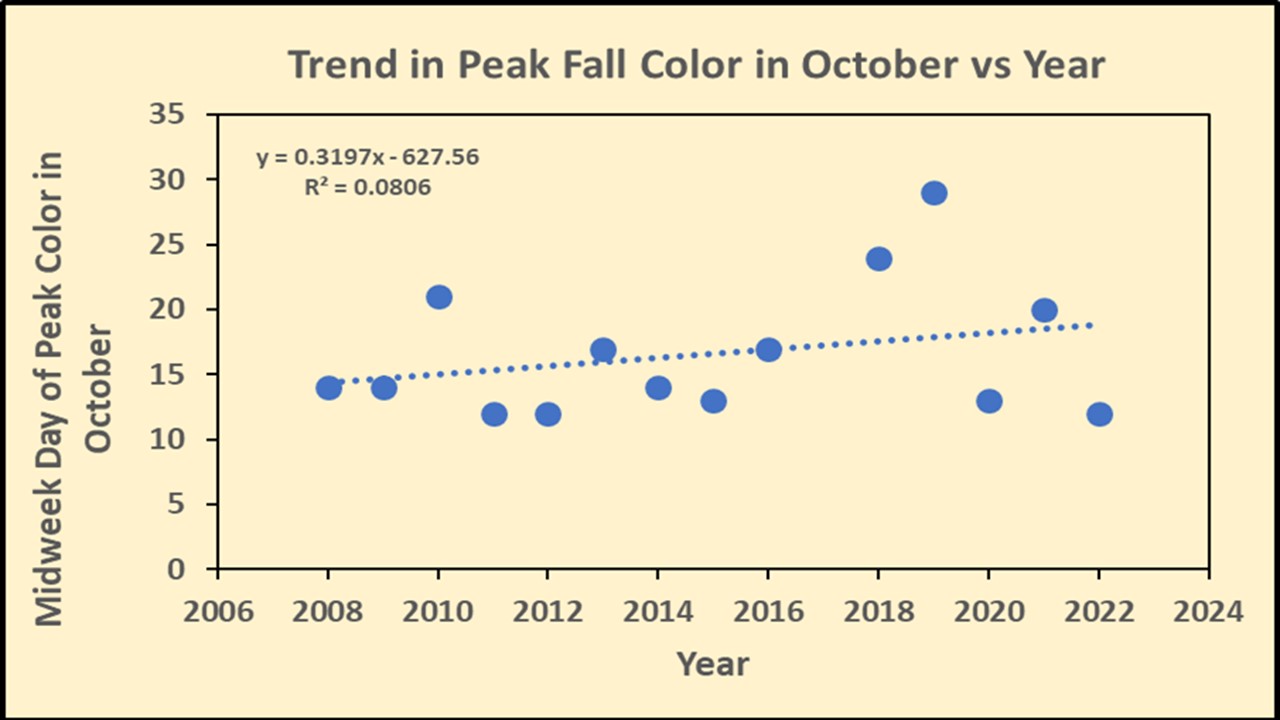
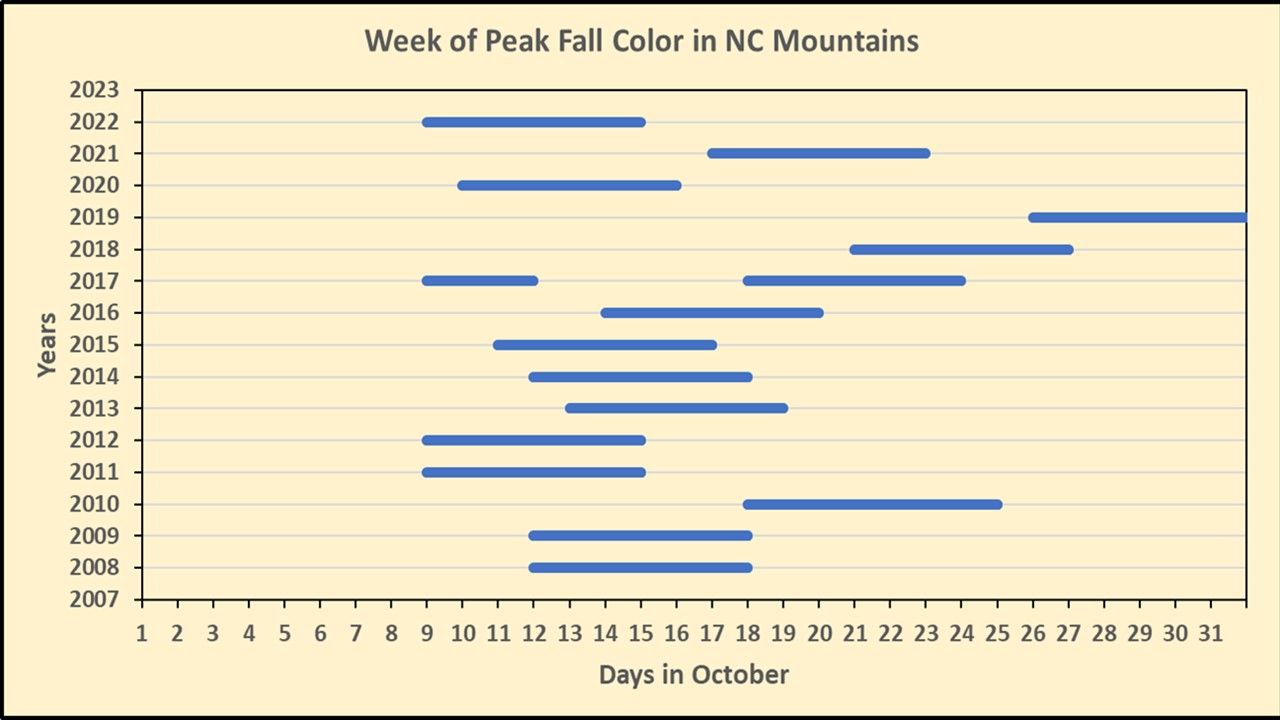
Fall Color Report for Week of August 20, 2023
It’s still quite early in the season to be making any definitive predictions about the fall colors we’ll get in a few months, but there are some signs to take note of. First off, we are not in a drought situation. We’ve had abundant rain this summer, the soils are quite moist, and the trees aren’t showing any signs of distress. Of course, that could change between now and the end of September, but so far so good.
Second, the long-range NOAA forecast (see attached figure) suggests that we will have slightly elevated temperatures through November and above normal precipitation. Both of these would lead me to predict that colors could be slightly delayed this year. The excessive rainfall, if it happens, could dampen the brightness of the red colors, especially if we get a lot of cloudy, rainy days in late September and early October.
As I noted in a previous posting, our urban maples are starting to turn color, as they always do at this time of year, as are the native flowering dogwoods. Buckeyes are also losing their leaves now, which is something they do early each fall. You may also be seeing a lot of browning along roadsides. That is most likely black locust, which is attacked in late summer by a native insect known as the locust leaf miner. This is an insect that eats out the inside of black locust leaves (it mines the leaf for food, so to speak, hence its name). The leaves then turn brown, die and fall off. It looks worse than it is, but this is a native predator and the trees seem to tolerate the damage, no worse for wear.
There are numerous native wildflowers and garden plants putting on a flowering show at this time of year, including evening primrose, jewelweed (both yellow and orange), goldenrod, ironweed, white aster, bee balm, yarrow, phlox, hydrangea, and Joe-Pye weed. You can also find the white Indian pipe in wooded areas. Most of the species mentioned are attached in the photos provided.
For those planning a trip up to the High Country, remember that colors will start first at higher elevations, and then move downward over time. In the Boone/Blowing Rock area, that means peak colors will be around mid-October (12-20th), unless warming delays the onset of coloration. But we won’t be able to pin it down better until we get closer to those dates.
Hope you have a good end to your summer and a fun Labor Day weekend. I’ll post again next weekend.
Fall Color Report for the Week of October 31, 2022
My wife and I took a trip down to Charlotte on Saturday to see our daughter and her fiancé, not to mention their two dogs (Hank and Layla). We also had a very nice brunch at a fine French restaurant in downtown Charlotte. On the way down we noted the state of the fall colors and I was pleasantly surprised by how vibrant they were just outside of Blowing Rock and nearly all the way down to Lenoir on either side of US 321. It was very overcast as we drove down, so the colors didn’t jump out at you as they would if it were sunnier, but believe me, they were great!
The best fall colors have now moved off the mountain to the foothills, but we were also pleased to see vibrant colors in Charlotte too, especially in and around the Plaza-Midwood section, which has wonderfully old and stately trees and nice walking paths throughout. The peak of color hasn’t quite reached Charlotte yet, but there is plenty as you walk around, and some trees are even past their peak, while others are still either green, or halfway toward their peak.
Charlotte has a lot of red and sugar maples planted along the streets and the different varieties turn a range of colors, from bright yellow sugar maples, to orange, to deep red maples with bright red leaves, and the entire range in between. Many of the oaks in Charlotte are willow oaks, and they mainly turn brown, although there can be a tinge of yellow right before they drop. There was one tree we saw with compound red leaves that has me stumped as to its identity, so if anyone knows what it is, please let me know. Overall, it’s a beautiful time of the year in the city and you can see some spectacular color right outside your home.
In some sections of Charlotte, leaves may persist until Thanksgiving, although I think that most of the colors will be gone by then, with just a few isolated trees showing off at that time. State parks in and around Charlotte are coloring up now, so if you get out to Kings Mt or Crowder’s Mt in the next week you should have good viewing.
We are approaching the end of my reports for this season, aalthough I may do one more next week. But because colors were on time this year the season is coming to end in the High Country, about two weeks earlier than in previous years. Have a great week!
Thursday, October 27, 2022
As I've said recently, fall colors are on the wane here in the High Country (not absent, but noticeably past peak). However, I've just spoken with people at several lower elevation state parks about their fall colors and here's a summary of those discussions:
Stone Mt. State Park at Roaring Gap, NC: They are at peak NOW and the colors are stupendous this year (first time I've used that adjective!). So, if you can, head out to this park this weekend. If you can't make it this weekend, the coming week will still be good, and even next weekend, although by then they will be slightly passed their peak (but still worth a visit!). A ~1 mile hike takes you up to the top of large rock outcrops with great fall foliage views. There is also a beautiful waterfall that you can visit along the way. I highly recommend this park and there are no entrance fees.
Chimney Rock State Park, Chimney Rock, NC: colors are showing up nicely there but are not yet at peak. However, a trip this weekend, or next week into the following weekend would be enjoyable. Colors may peak in about 10 days there, but are good now. They do charge an entry fee. It is a spectacular park and Last of the Mohicans was filmed there!
Gorges State Park in Sapphire, NC: this park, located at about 1,900′ elevation, should have foliage colors in about the same state as Chimney Rock. There are nice hikes throughout and Rainbow Falls is worth the hike. One of the falls in the park cascades over 800′ down and is the tallest in the eastern United States. This is a relatively new state park, but highly recommended.
Crowders Mt State Park and Kings Mt Park, south of Charlotte, near Gastonia: both parks are approaching peak colors, but are not yet there. But a hike to either this weekend or in the coming week, including the following weekend, would be ideal if you want to stay close yet see great fall color. And one might also try Lake Norman State Park, about which I know very little, but I suspect they will get to good color in about 10-14 days.
Lastly, don't forget Daniel Stowe Botanical Gardens west and south of Charlotte. They have displays of fall foliage and flowers, plus greenhouses and walking paths. It is a botanical gem in the growing suburban area of Charlotte. There is an entrance fee charged.
Hope this has got your juices flowing for a fall foliage expedition this weekend or next!
Fall Color Report for Week of October 16, 2022
This morning, not bright, but early, I headed out toward Doughton Park, which is on the northern section of the Blue Ridge Parkway about 30 miles north of US 421. A front is moving in and the skies were clouded up, with the sun peeking through some breaks early in the morning. It is now overcast over most of the High Country. This is a less popular section of the Parkway, but it has rewarding views, great hiking trails, as well as numerous picnic areas. I highly recommend it, especially because it is peaking right now and will provide some good views for this week.
Do note that they are repairing a bridge on this section of the Parkway, so right after the Trading Store on the Parkway it is closed to all traffic. They do have a nicely signed detour to get around this section, which is about 20 miles long, but it’s well marked and I had no problem following the signs to get back on the Parkway going north. If you are coming up from Winston-Salem on US 421, I’d suggest you veer off near Wilkesboro and take Rt. 18 up to the Parkway. It will put you on to the Parkway just a few miles south of Doughton Park and you’ll avoid the long detour if you get on the Parkway where it crosses US 421 in Watauga County.
By the way, Google maps will route you up I-77 off of US 421 to Roaring Gap, but I suggest you stay on US 421 to Wilkesboro and take Rt. 18 N to the Parkway. It is a pretty drive, with good foliage over the last 5-8 miles as you climb in elevation and less of a hassle (I wouldn’t want to get on I-77). Distance-wise it is 81 miles from Winston-Salem if you take Rt. 18 and about the same if you take the I-77 route.
Once you get to the Parkway, you can only head north so stop off at the Visitor Center to find out about hiking and other places to visit. There is a small restaurant there (not sure how much longer it will be open for the season) so you can get lunch if you want. If you turn right instead of left at the visitor center, you can follow that road to a large picnic area. When you get to the fork, veer left, and it will take you past an abandoned motel and then dead end shortly thereafter in a parking lot filled with cement picnic tables for some reason! Take the short walk up from the parking lot toward the water tower to the overlooks and you’ll be able to see great views (even Pilot Mountain on a good day).
Look straight down and you’ll see a cabin that was once occupied by a family at the turn of the 20th century. I’ve posted the sign that explains who lived there. Last time I wrote about this, a descendant of the people who lived there wrote back to let me know the family is still around in the area.
Then, get back in your car and go to the fork and take it to the end where you can park. Take the Bluff Mountain Trail from the parking lot through the old field – it is only 0.2 miles long and it will take you to some nice rock outcrops where you’ll have more great views. You can also get this trail off the Parkway and hike up (maybe a mile or two) or, you could hike down to the Parkway from the top. It’s a very nice trail, but of course, if you do that, you’d have to reverse hike to get back to your car.
As you approach the top of Bluff Mt, there is a trail that goes off to the left to a shelter and it has a nice view plus you walk through mountain laurel and forest to get to it. Very nice place to just sit and take in the peaceful nature of this place.
You can also hike to the picnic area from the overlook I first described above if you want. It takes you though high elevation mountain meadows and is a very easy hike. Also highly recommended.
Colors are looking great on this section of the Parkway. I got on at US 421 and headed north until I had to detour. There are some great overlooks on this part but it is also a more rural and pastoral landscape (farms, some houses, etc.) and when you get to Jeffress Park, just a few miles up the road, there is a picnic area on the right which also has a short 1-mile loop trail you can take. This is a very easy hike, parts of which are paved, and if you take the fork on the right, it will drop you down to an overlook and you’ll be adjacent to a nice waterfall. I highly recommend this little trail.
Then, if you get on the Parkway where I did and want to go to Doughton Park, you’ll have to detour off the Parkway onto country roads and highways until it brings you back where Rt. 18 crosses over. This takes you through rural Ashe and Allegheny counties, and the drive is quite pleasant, part of which is adjacent to the New River. There is a rafting company (Zaloos) that hosts river outings there.
Today was cloudy as a front is moving in which will bring our coldest weather of the fall so far. Temperatures in Boone might drop as low as 20 F with highs only in the 40s by Tuesday. This may cause significant leaf drop, especially if we get strong rains tonight as predicted and this will take down a significant number of leaves.
Leaves started falling in droves last Wednesday, so the Parkway around the Linn Cove Viaduct is getting past its peak, but colors lower downslope are reaching their peak. Most other high elevation areas are now moving past peak, but they still have good color. Elevations lower down are rapidly coloring up, so it’s still worth a drive up here if you want to see some good color. This has been one of our best fall color seasons in years.
If you get up to this area this week, you’ll still have significant colors to see, especially on this northern section of the Parkway. I also recommend a visit to Mt. Jefferson State Natural Area right outside West Jefferson in Ashe County. You can drive all the way to the top and then take the 1-mile loop trail with great views at the end.
That’s the update for this week. Similar conditions can be found down to Highlands, which is on nearly the same fall foliage schedule as Boone. People have been sending in photos from the Smokies and colors there are picking up nicely too. So, if you can get out this week, you should have a great experience. I’ll let you know what happens to the leaves after this week’s rain and cold.
Ciao!
Fall Color Report for the Week of October 9, 2022
Today was one of the most spectacular fall color days we have had in the High Country in several years. The weather was perfect, starting off with temperatures in the mid-30s and only getting to the mid-50s, with clear blue skies. I’ll say up front that we are at peak color above 3,000’ elevation in the Blowing Rock to Chestoa overlook section of the Blue Ridge Parkway. Colors will continue looking good through to next weekend, although there is a forecast for rain and possible thunderstorms on Thursday. If that happens, we may lose some leaves for next weekend, but hopefully they will be scattered and most areas will retain their leaves.
The red colors, where they are abundant, are very vibrant this year, a result of the cooler weather we saw in mid- to late September which, fortunately, persisted into October. It also helped that we had mostly sunny skies too. Those are the ideal conditions for having bright fall colors and for the fall color season to be on time, which it is this year. In fact, I would say it’s a few days ahead of normal.
There is still green at or below 3,000’ elevation, but colors can be seen all the way down to 2,000’ and a couple I met on the trail today told me that colors are coming along nicely right in Asheville itself, which is a good two weeks earlier than usual.
Birch trees, which turn yellow, are especially bright this year, and large stands of them are providing great color on the hillsides now. Sugar maples are doing especially well this year, and provide an orange/yellow display that contrasts with the vivid red of red maples. Striped maples, an understory tree, are turning a bright yellow, as are American Chestnuts. Witch hazel also turn yellow, with brown stripes, and they are coloring up also and are in bloom now (one of the few woody plants to bloom in the fall). Additionally, Fraser firs are turning now, and they briefly become light green to yellow before quickly transforming over to chocolate brown. Sumacs are in peak red color as are fire cherries. Sassafras continue to turn and hickories and several oak species, especially those growing on rocky outcrops, are turning now. Hickories turn a dull yellow color, while chestnut oak turns yellow and black/red/scarlet oaks turn deep red.
Galax, one of my favorite plants, is a perennial native wildflower with thick, tough, evergreen leaves that can form large clones on the forest floor. Usually a waxy green, they turn red when exposed to high light during cold periods. For the past several years I haven’t found many leaves turning red in October, due to high temperatures, but this year, I’m already seeing a number of clones with red leaves.
Based on my observations here, I suspect colors are also great down in the Highlands/Cashiers area, and along the higher elevations on the Parkway from the Smokies north to Craggy Gardens. After several years of delayed and somewhat dull fall colors, we are having one of our best years in a long time. So, if you can get out this week, come on up. If I had to pick a 24 hr period for the peakiest peak colors, I’d select this Wednesday, but in reality, all week will be at peak, and areas still a little green will quickly color up through to next weekend.
I’m going to post my pictures in batches, since I took 300+ today, some of which are the best I’ve ever taken (in my humble opinion). One of the reasons the pictures are so good is that I took the advice I give prospective visitors – get out early and take photos then, because when the sun is at a low angle in the sky, the color saturation is so much better than if you wait until midday.
Today I left the house at 6 am and was at the Chestoa overlook just after 7 am to catch the sun rising over Table Rock Mountain. Then, I headed north toward the Linn Cove Viaduct (I didn’t have time to stop off at Linville Falls, but that would be a great stop if you come up). I stopped at Beacon Heights, which was full with people who wanted to catch the sun rise from the large rock outcrops at the summit. Then, I got back on the Parkway and headed toward the viaduct, but before getting there, I parked in the Stack Rock lot and took the hike to the rock and beyond. This is a rigorous, albeit short (0.2 miles) hike to a large rock called Stack Rock. At first, I thought, what a bummer, as there were no good views there, but then I discovered that the trail continues on beyond the rock, and there are wooden steps and a bridge to take you farther into the woods. After a bit of a hike you get to a cliff that is fenced to keep you from falling off, and from that part of the trail you can take beautiful pictures of colorful forests and Stack Rock itself. Interestingly, the trail wanders along and beneath the Linn Cove Viaduct, so you can get a very different perspective on that structure on this trail. The trail continues on for another 2.5 miles, and then you have to turn around and come back. I didn’t attempt to do the entire trail today. It is a rigorous hike, with lots of roots and rocks, so it’s not for the faint-hearted.
Then, back in the car, over the Viaduct and on to the Yonahlosee Overlook and then the Rough Ridge trail. Today, I hiked all the way to the top of Rough Ridge and was rewarded with great views and great fall color. If you want, there is a side trail at the top that you can take all the way back to the Linn Cove Visitor Center (about 4 miles), but if you want to do that, you should have a car at Rough Ridge and another one at the visitor center, or otherwise you going to have quite a hike back.
I stopped once again at Price Lake to see how the colors there have changed since last Tuesday, and I’m glad I did, as they were at peak condition today. My last stop was at the Cone Manor just north of Price Lake. The National Park Service has spent the last several years fixing up the manor house and it is now freshly painted and repaired and looks better than it ever has in all the 36 years I have been in the High Country. They did a great job on it. Even better, they have opened up the second floor so you can tour around and see all the bedrooms (and bathrooms!), plus the kitchen in the back on the first floor.
Those were different times when Moses Cone built the manor house (right at the turn of the 20th century). For example, white servants were housed on the third floor, where there are five bedrooms (you can’t go up there though). However, African-American servants weren’t allowed to stay in the manor house and the Cones provided them with two separate homes not far away, one for males, one for females. One of those houses was preserved by the NPS and now houses interns working at the place. The manor house was the first one with electric lights and it had hot and cold running water.
I did all this from 6 am to noon and back home in time for lunch! So, come on up! Some of the best color in years is peaking now!
Thursday October 6 – from the back of Grandfather Mountain. Photo: Lance Dotson
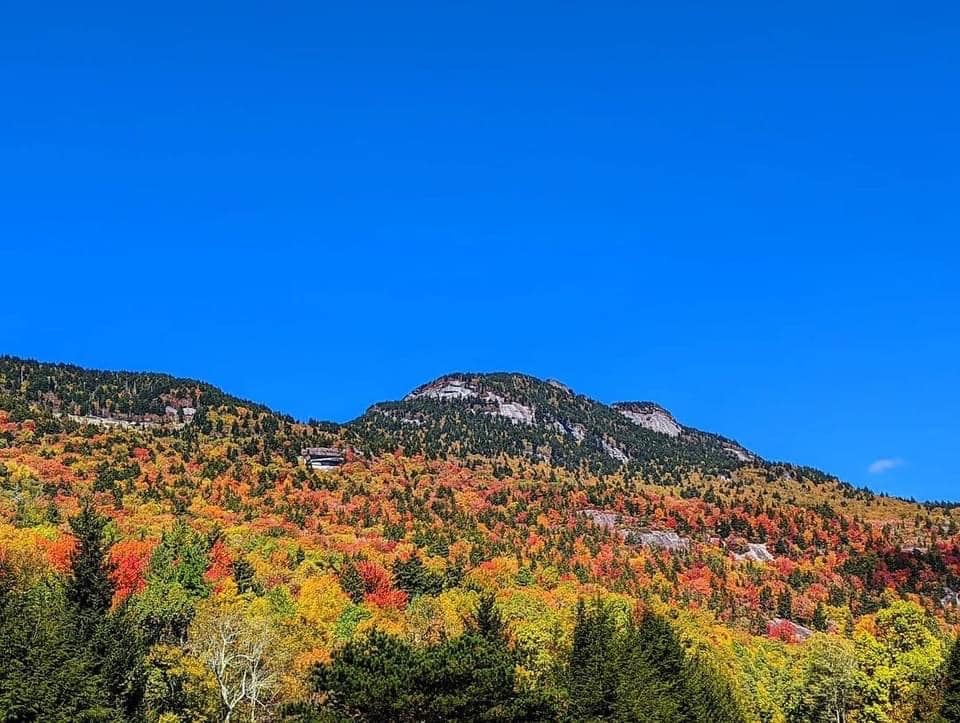
Grandfather Mountain Daily Fall Color Report | Oct. 6, 2022: A particularly great spot for seeing fall color right now is outside the Wilson Center for Nature Discovery, looking up at Linville Peak. The sugar maples near the parking area and habitats have turned a mix of orange and red (as illustrated in this photo), and the striped maples on the paths to the habitats are now turning yellow. Photo by Monty Combs | Grandfather Mountain Stewardship Foundation
Though still early in the season, staff members are observing color progression each day on the mountain. The forecast through the weekend continues to call for ideal fall weather, making it a perfect time to visit Grandfather Mountain. During this busy season, booking reservations in advance online is strongly recommended.
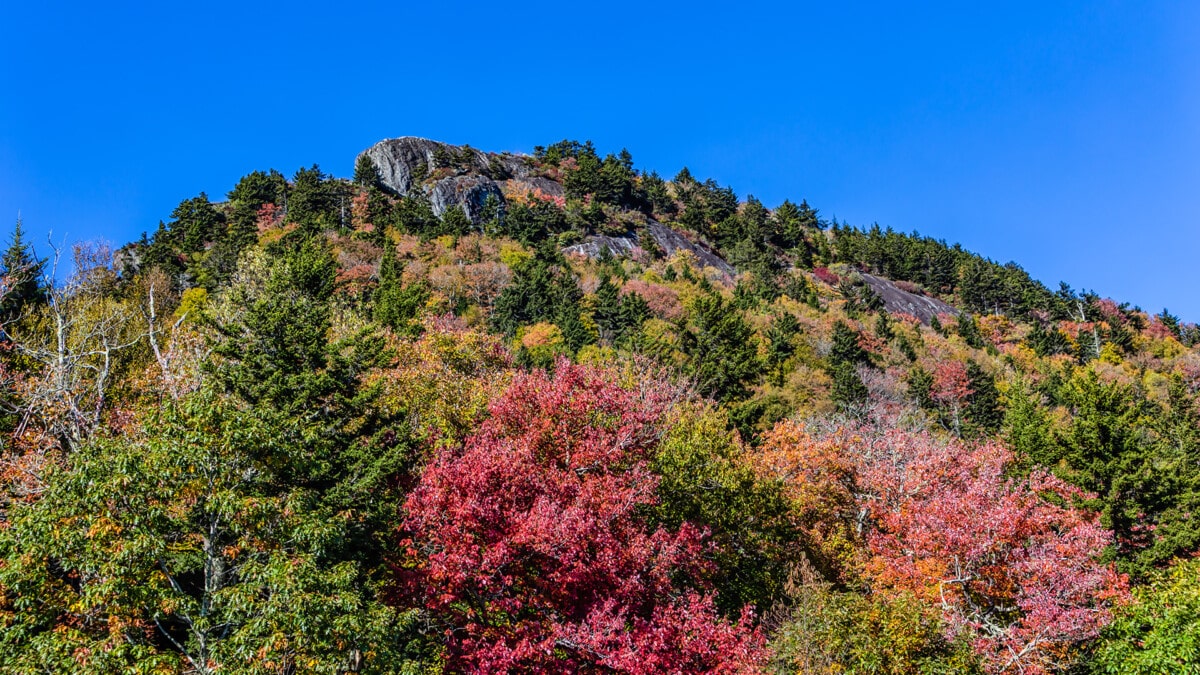
Fall Color Report for the Week of October 2, 2022
This weekend I attended the wedding of my sister’s daughter at the Linganore Winecellars outside of Frederick, MD. Although it was rainy and the ceremony had to be held inside, the hall they had was beautifully crafted with wood paneling and wood beams, and it felt very warm and cozy inside. We all had a great time.
Because of that trip, I didn’t get to go out and scout around for fall colors until this morning. But what a morning it was – cool, in the low 40s, maybe even in the 30s, with clear blue skies and low humidity. There was valley fog, but Grandfather Mountain and the Blue Ridge Parkway were clear and stunning. I hiked the Flat Rock Trail, which faces east, and is about 4-5 miles south of Grandfather Mountain on the Parkway.
Then, I drove the Parkway north to the Beacon Heights parking lot, took some pictures, and then made my way to the Rough Ridge trailhead and hiked up to the wooden viewing platform. While there I met Skip Sickler, who takes pictures for Grandfather Mountain (I just posted one of his pictures). Skip is also an award-winning photographer and last year won 7 individual awards for his wildlife photography!
Congrats to Skip on those achievements!
Colors have progressed nicely over the last week and with this cool weather and blue, sunny skies, will continue to do so through this next week. While colors along the slopes of Grandfather are not yet at peak, they are colorful and worth viewing. By this coming weekend they should be further along, and it would be worth your while to come up if that is the only weekend you can spare. I think colors will be great from this weekend through to the next weekend (Oct 8-15). Of course, colors will persist beyond the 15th, but as time goes on, they will move downslope. But the next two weekends should be great for fall color viewing in this area.
The best colors in this region are from the Boone Fork Trailhead south to the Linn Cove Viaduct on the Parkway. Farther north, they’re looking good around Price Lake, and should peak there in the next week or so.
I expect similar trends will be found around the Mt. Mitchell area and at Waterrock Knob along the Parkway, as well as north of US 421 in Doughton Park. It looks like colors will be close to ON TIME this year, mainly a result of the cool weather we’ve been having. Hurricane Ian didn’t really impact the colors because when it came to the mountains the winds died down and the rain was fairly gentle.
So, come on up and take in the views!
Grandfather Mountain Daily Fall Color Report | Oct. 5, 2022: Nice pockets of fall color are developing at the highest elevations (above 4,000 feet) in the N.C. High Country, as illustrated by this image from the Rough Ridge area. An extremely popular spot in fall for long-distance views, the trail to Rough Ridge is located at Milepost 302.8 along the Blue Ridge Parkway near Grandfather Mountain.
The weather forecast for this week and weekend continues to look optimal for fall color progression and for visits to the region. “Peak” is still to come, but visitors to the area right now are seeing colorful spots along the landscape, as well as standout trees among their green-leafed neighbors. Photo by Skip Sickler | Grandfather Mountain Stewardship Foundation
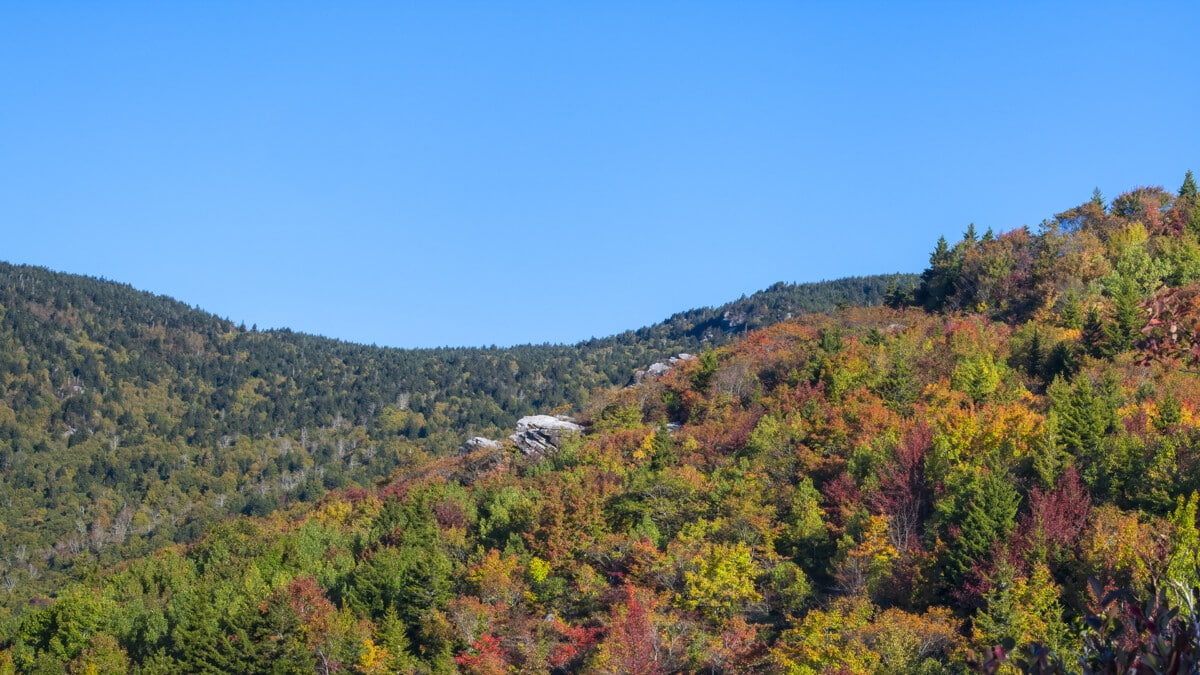
Grandfather Mountain Daily Fall Color Report | Oct. 4, 2022: Today’s photo was taken at the top of Grandfather Mountain, near the Top Shop parking area. Typically a showstopper early in the season, the wild blueberries, also known as huckleberries, have turned a beautiful red at higher elevations. Grandfather Mountain and its immediate area are still mostly green with hints that a nice fall season is ahead of us. The weather this week is picture perfect with sunny days and chilly nights, also great ingredients for fall color progression. Photo by Skip Sickler | Grandfather Mountain Stewardship Foundation
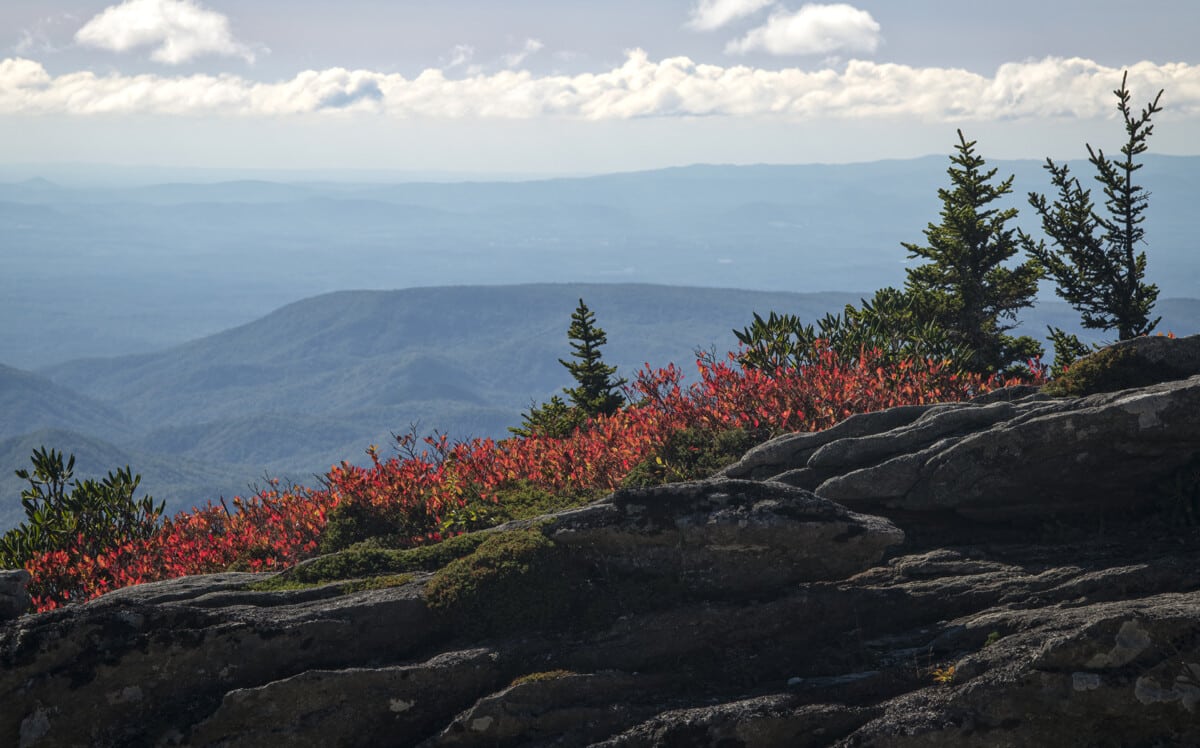
Tuesday October 4 – captured in Banner Elk today. Photo: Scott Green
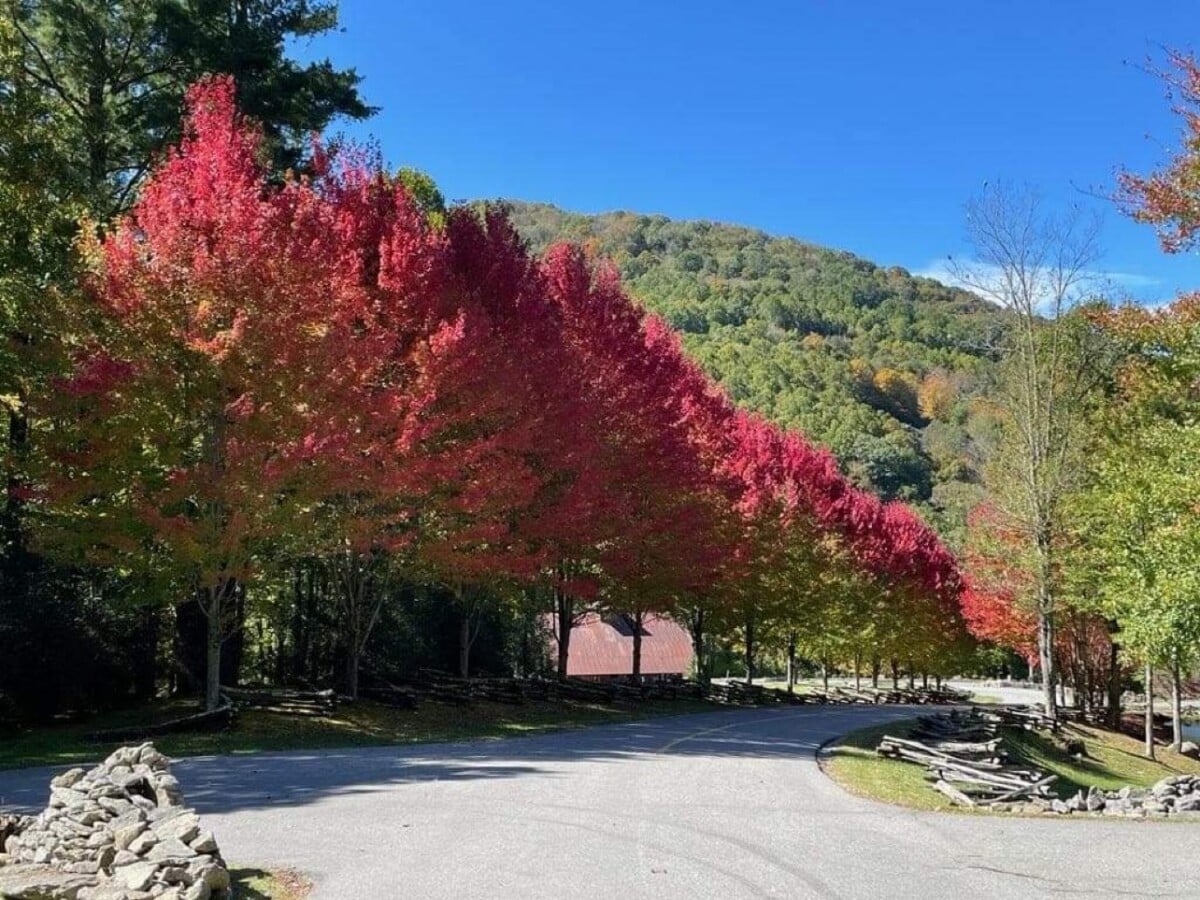
Fall Color Report for the Week of September 25, 2022
Today I went on a fall color excursion to Craggy Gardens and Mt. Mitchell accompanied by two of my students, Hannah Lilly, and Leigha Henson. Trees are coloring up nicely above 4,500’, although green is still dominant. However, there are individual trees in full color, adjacent to others that are just starting, which themselves are adjacent to yet others that are mostly green. In another week, if the weather remains cool, colors should be fine at these high elevations.
We had an exciting encounter with a bald eagle just before we got to Linville Falls – it was feeding on some animal in the road and as we drove by it flew off next to our car before taking off above the trees. Then, not five minutes later, we came upon a flock of turkeys along the road. Later in our trip, we had to slow down to let two turkeys cross the road. Why they crossed the road I don’t know, but maybe they talked to some chickens about it (joke, joke!).
Some trees are completely leafless now, such as buckeyes, which you can identify by the fruits still on the branches. A lot of the mountain ash are beginning to lose their leaves, and unfortunately, many of them didn’t set fruit this year. But there are a number with their bright red berries at the summit of the Craggy Gardens trail, which starts half a mile north of the visitor center on the Parkway.
There are a number of wildflowers in flower now, and these include asters and some unknown yellow composites, plus saxifrage. Viburnum leaves are coloring up and there are at least two species up at Craggy Gardens. Other shrubs include Rhododendron catawbiense and blueberries, plus a few unknowns. Birches are starting to turn yellow, but beech are still mostly green.
I highly recommend the hike up to the top of Craggy – it’s not a hard trail, nor is it very long. The bunker-style overlooks afford a 360-degree view. Toward the northwest you can see I-26 snaking its way out of Asheville. Note that the restrooms all along the Parkway are closed and you’ll have to use the porta-potties, which depending on the time of day, and day of the week, may or may not be usable, depending on your tolerance for varying degrees of sanitation. Be prepared!
From Craggy we went north on the Parkway for the relatively short drive to Mt. Mitchell State Park, the oldest state park in the state, established in 1916. Mitchell is named after the UNC-Chapel Hill professor Elisha Mitchell, who devoted a large amount of his time trying to prove that Mt. Mitchell was the highest peak in the eastern United States, which it is, at 6,684’ elevation.
Sadly, while on a trip in June of 1857, he fell off some rocks at a waterfall and died, at age 64. After an initial burial in Asheville, his remains were moved to the summit of the mountain that bears his name, and you can see his burial tomb if you hike the short, paved trail to the top. There is a nice elevated viewing platform on the summit, from which you have a 360-degree view. We were able to easily see Grandfather Mountain, Table Rock and Hawksbill today.
There isn’t much color at the top of Mt. Mitchell, because you are in the spruce-fir forest that dominants there and those species are evergreen. However, there are some birches and other deciduous woody plants that provide a little color.
But the main attraction of Mt. Mitchell, besides being the tallest eastern peak, is the beauty of those high elevation forests. There are numerous trails you can take, some of which can be quite strenuous and long, but just past the education building on the paved path to the summit is a short and easy loop trail that takes you through a dense, dark, Fraser fir forest. I highly recommend it because it gives you a real feel for these unique forests.
They are glacial relicts and those with Fraser fir only occur on 7 of the highest peaks in the Southern Appalachians, making them one of the most endangered ecosystems in the United States. And there are some unique animals in these forests, including hawks, bobcats, coyotes, and of course bears. There is even a small tarantula, the spruce-fir spider, that occurs nowhere else in the entire world! This trail only takes about 20 minutes and is mostly level, so try it out.
Before leaving Mt. Mitchell, we got a snack and drink at the food stand there. Then we headed north on the Parkway and got on Rt. 80 north toward Spruce Pine/Burnsville. This takes you downslope into the Toe Valley by the Toe River. There are some nice views off to the left of the Blacks, the mountain range that extends northeast from Mt. Mitchell. In a few weeks when colors start to change at lower elevations, this would be a good road from which to view them from a distance.
That’s about it for this week. If temperatures keep within normal ranges for this time of year, I think we’ll have peak fall colors close to historical times (see my chart that I posted several weeks ago, or my newly updated map). As we got near to Boone in late afternoon, it began raining and that means we won’t be in any drought situation in the near future, which bodes well for good fall color. I am keeping an eye though on hurricanes in the Gulf and Atlantic. So far, none are headed our way. But more and more are forming each day and I’ll have to keep watching where they might go.
Next week I will be in Maryland for my niece’s wedding so I won’t be able to do a fall color outing, but I’ll take a look at the colors as I head north on I-81 into Virginia.
Have a great week!
Updated note – Just a note that next weekend could be wet and dreary up here in the Southern Appalachians due to Hurricane Ian. It's current path has it moving north after it hits Florida.
But because it's coming somewhat before leaf colors peak, I don't think it will have a huge impact on later fall colors. Some leaves will come down, but if the winds aren't too high, we should be ok.
Stay tuned!
Captured this morning (Thursday September 22, 2022) in Banner Elk. Photos: Scott Green
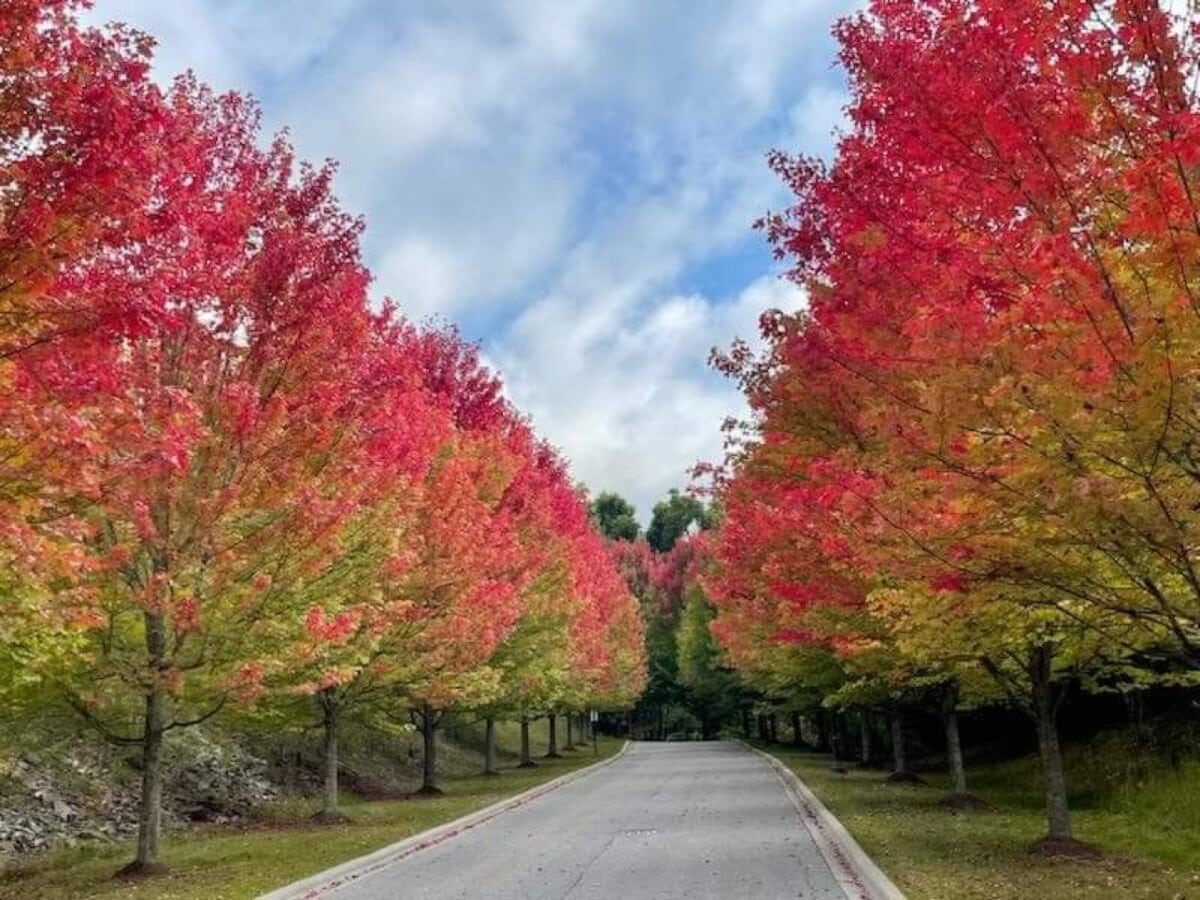
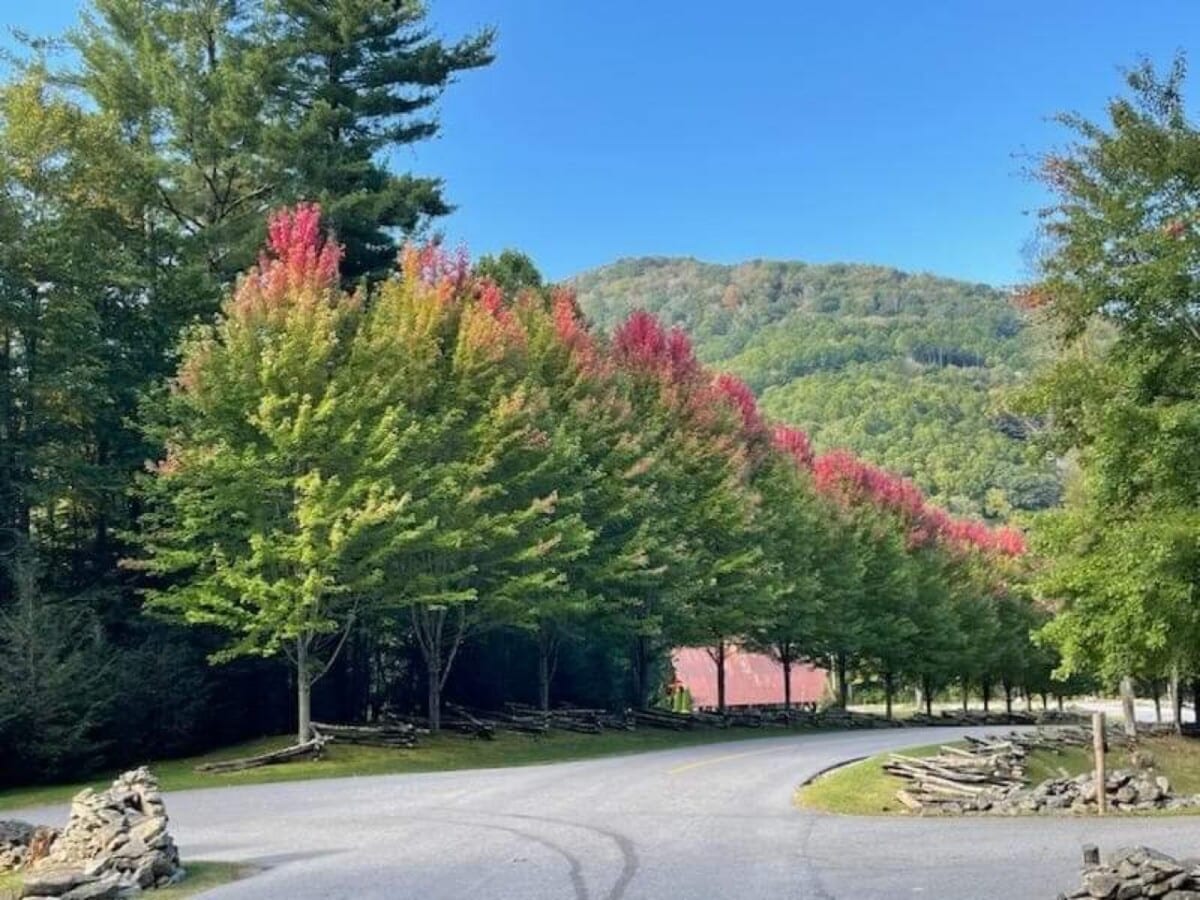
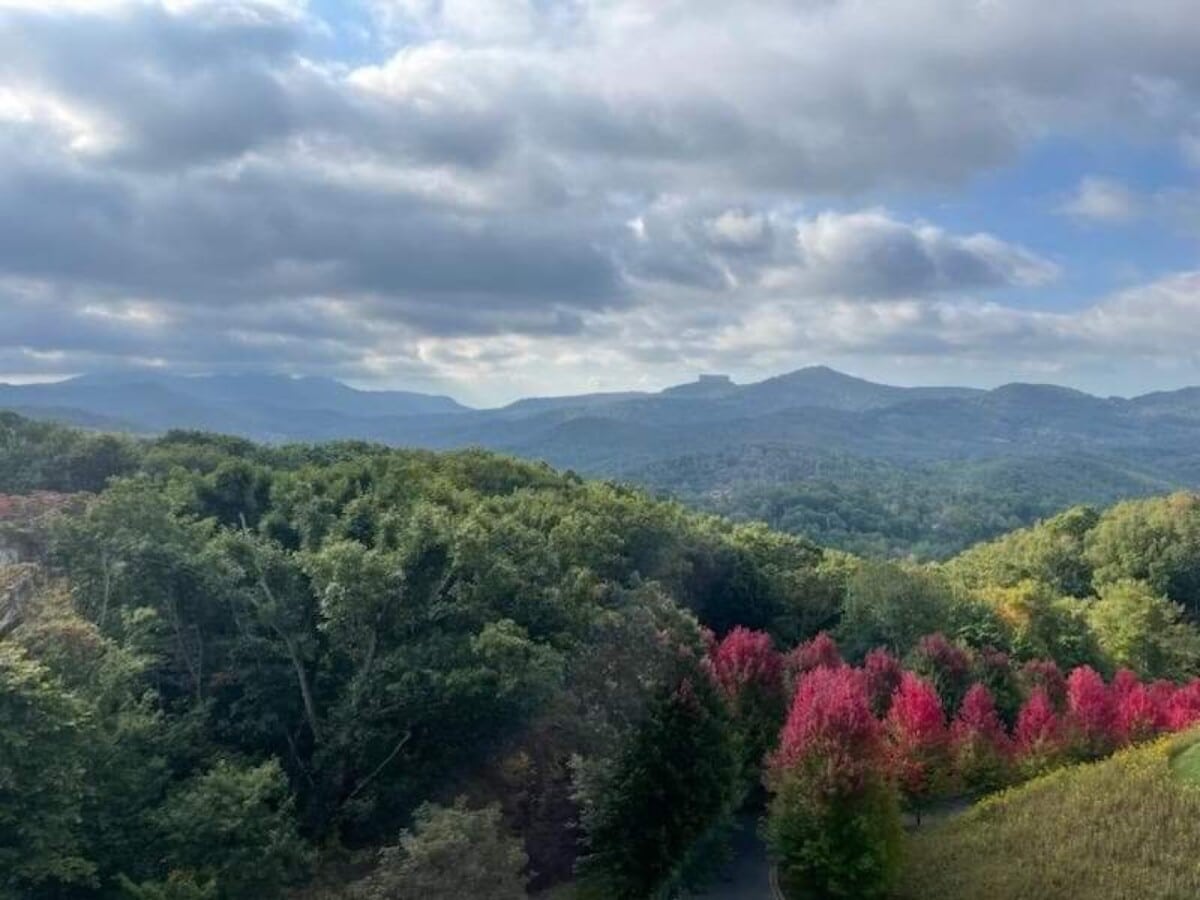
Fall Color Report for the Week of September 18, 2022
One thing you can never do when forecasting anything is to become complacent. If you do, you will miss things. Today, I hiked up to the summit of Elk Knob State Park, just north of Boone, and I’m glad I did, because otherwise, I would have missed the beginnings of fall colors here in the High Country! The peak at Elk Knob is 5,520’ and offers panoramic views of the mountains in Watauga and surrounding counties as well as into southwestern Virginia. I highly recommend this hike, which is 2 miles to the top, and because there are switchbacks, the grade is fairly shallow and it is not that rigorous a hike. You could easily get to the top in 1 hr.
However, what disappointed me today was seeing how many hikers have been trying to cut short the switchbacks, just to save a few feet of extra walking. This is extremely destructive to the trail system, and can be dangerous, because if you head downslope off trail the result can be a twisted ankle or worse, since the slopes are so steep. Furthermore, such behavior exacerbates erosion, damages the plants, and just plain ruins the experience for everyone else. The Park has had to put up plastic fencing to discourage people from doing this. So, for your safety and the enjoyment of everyone else, please stay on the trails.
Fall colors have started showing now in the High Country, particularly above 4,500’ elevation. You can view the photos attached to this report to see the evidence of that. It’s just starting, and I would say that in the forest below the Elk Knob NW overlook, color is about 10-15% progressed. In a few more weeks, this particular forest will show off some of the best color in the High Country. I think the trees showing color now are sugar maples, a few red maples, and perhaps some buckeyes. Being way up on the peak I could not discern the individual trees below me, but based on my observations from other locations, I think I’m right.
Along the Elk Knob trail there are a number of native wildflowers, including goldenrods, asters, and gentians, and sporadic instances of other tree species beginning to turn color. Much of the mountain is dominated by beech, and some of those at the upper elevations are yellowing, while mountain maples (Acer spicatum) in the understory are just starting to yellow. There are larger maples on Elk Knob (maybe sugar, A. saccharum) and they too are turning color, usually orange-yellow.
Of particular note are the viburnums, known locally as hobblebush. This understory shrub is peaking in color right now, and this will continue into next week too. The unusual feature of this shrub is the haphazard pattern of leaf coloring – individual leaves have splotches of color, or in some cases, one half of the leaf will be colored, and the other completely green. The leaves eventually turn a deep burgundy red over time, but for now, they are putting on quite the show. You will encounter these about half way up the trail around the 1 mile marker. There is also a bench at the 1 mile overlook (which faces NW) and they are common there.
In much of the remaining area in the NW part of NC, the forests are still mainly green, especially below 4,000’, although with the cool weather we’ve had this past week, maples, buckeyes, and dogwoods are coloring up nicely. We’re supposed to have a mini-heat wave later this week, but then that will dissipate and we’ll be back to cooler weather again. That bodes well for color development, since these patterns of lower temperatures and clear skies bring out the colors. If temperatures continue to follow the cooler pattern, we’re looking for peak colors to be on time this year. See my chart which I posted a few weeks ago which outlines when colors peak at different elevations.
This Thursday, September 22, marks the Autumnal equinox. On this date day and night lengths are approximately equal, and afterwards days become shorter than nights until we get to the winter solstice, on December 21st, when they begin to get longer again. The Autumnal equinox also marks the beginning of the fall season.
Next week I’ll try to head down to Mt. Mitchell and Craggy Gardens. Since those areas are also at high elevations, colors should be showing up there also. I’ve heard reports that colors are well on their way in Graveyards, which is south of Asheville on the Parkway.
Finally, we had a heck of a weekend here in Boone. First, yesterday (Sat) ESPN hosted their football show Gameday from 9 am to noon on the campus of Appalachian State University, and there were thousands of students there. Then later that same day we played Troy State in football. Coming a week after knocking off #6 ranked Texas A&M, there were fears that we might have a letdown, which turned out to be true, as we trailed Troy 28-24, with just 55 seconds left in the 4th quarter. But then App got a safety on Troy for 2 points, and the ball back. With App on its own 42-yard line and time running out, our quarterback heaved a Hail Mary pass which came down among half a dozen players somewhere around the 7 yard line, and lo and behold it bounced into an Appstate receiver’s hands and he ran it in for a touchdown and we won 32-28. Talk about a crazy time here!
I’ve posted photos from my hike today and you can go there to find out more about the plants I saw today. Have a great week.
Fall Color Report for the Week of September 11, 2022
Greetings from the High Country! The students up here are all in “high” spirits after watching the Appalachian State University football team defeat the #6th ranked program in the country yesterday, Texas A&M University. Students piled out of their apartments and dorms and congregated on King Street in the middle of town (which is also US 421!) to celebrate. This was our second win over a top 10 team: last time was when we beat Michigan 34-32 in what Sports Illustrated said was the greatest upset of all time in college football history. Although I have problems with the business side of university athletics, they do provide pride and a sense of community when they achieve milestones like this. If only they paid professors what coaches get!
But I digress…a lot! Back to fall leaf color. It’s still too early for much color, but here and there one can see hints of what is to come. Tulip poplar (Liriodendron tulipfera) leaves are just now starting to turn yellow. And for the last 10 days, yellow buckeyes (Aesculus flava, formerly octandra) have been running yellow, then turn brown, and falling off. Trees in this genus also include A. pavia (red buckeye), and A. sylvatica (Georgia buckeye) and bottlebrush buckeye (A. parviflora), which are native, understory trees in the Piedmont and coastal plain, but do not occur in the mountains. All the species in this genus tend to leaf out early in the spring, often before any other tree, and then in late summer they lose their leaves before most other species. The understory species, in particular, tend to take advantage of the high light conditions in early spring to do most of their photosynthesis, much like spring vernal flowers do. I once co-authored a scientific paper on Georgia buckeye on this very topic. Anyway, the point here is that the early leaf coloring and drop is normal for this group of trees.
Flowering dogwoods continue to increase their color intensity and both red and sugar maples are showing hints of coloring up now. Of course, urban trees are well into their coloration and I’ve included in this report photos of trees on the Appstate campus to illustrate this effect.
We had nearly 5” of rain last week, and with just a few more weeks to go until peak fall color, drought is not going to be an issue this year. Given that, the biggest determinant of when the peak colors will occur is going to be the prevailing temperatures, both day and night. We have had some cool nights this past week, down to the low 50s, but it would better if we could get into the mid-40s. That would spur the colors on. But the long-range NOAA forecast is for above normal temperatures. If only slightly above normal, then colors may be delayed just a few days, but if significantly above normal (like temperatures in 80s here), then they could be delayed a week or even longer (as happened in 2018 and 2019). The good news is that NOAA predicts below average precipitation, and that means more sunny skies, and that, in turn, contributes to more intense red colors.
While you’re waiting for the trees to change color, there is plenty to see closer to the ground. Goldenrods (Solidago sp.) are now blooming and they form dense colonies in old fields and along roadside and trails. For those worried about allergies, know that goldenrods do NOT cause allergies. Ragweed (Ambrosia artemisiifolia), a completely different species, does. But not goldenrods, so you can enjoy them without concern. If you see tall plants with deeply purple flowers, they are probably New York Ironweed (Vernonia noveboracensis), and one of my favorite late season bloomers. Evening primroses (most likely Oenothera biennis) are also blooming now, with their prominent buttery yellow flowers. And one of my favorite late blooming species, due to its gigantic flower displays and height (up to 10’ tall) is Joe-Pye Weed (most likely Eutrochium purpureum, formerly known as Eupatorium purpureum).
Next week, weather permitting, I’ll try to head out to Elk Knob State Park, which is above 5,000’ elevation to see how the trees are doing at higher locations. In the meantime, I’ll keep a watch on other high elevation locations such as Mt. Mitchell, Graveyards, and Craggie Gardens, which are all along the Blue Ridge Parkway.
Finally, I also publish these reports on the Appstate Biology webpage, which you can navigate to if you want to review past postings in previous years, or want to read some of the scientific essays I wrote about fall color. The link to that site is posted here: https://biology.appstate.edu/fall-colors and if you scroll about you can find links to other fall color resources and a map showing when colors will change all along the mountain chain in western NC.
Enjoy!
Fall Color Report for the Week of September 2, 2022
Today I took a short trip up to Grandfather Mountain to check out the trees and their new Nature Museum, which opened in July. The museum, known as the Wilson Center for Nature Discovery, is a modern, interactive complex that both children and adults will like, and it has displays that show off the unique aspects of Grandfather Mountain, including its geology, weather and climate, and of course, its fascinating biodiversity. There is also a large classroom where students and the public can enjoy learning about the mountain and nature.
There isn’t a lot to report concerning fall colors because the surrounding forests are still quite green. There is the occasional red or yellow leaf here and there, but we won’t really see much until near the end of this month. The native rhododendron, Rhododendron maximum, is losing its older leaves now, so you’ll notice a lot of yellow leaves on them. This is natural and nothing to worry about. Goldenrods are blooming now and adding a nice yellow accent to the landscape, and up near the swinging bridge, you can find some late blooming Liatris also.
It was in 1952 that Hugh Morton, the owner of Grandfather Mountain, put up what became known as the Mile High Swinging Bridge. Today there were celebrations in honor of its 70th anniversary. It’s one of the most popular attractions at the park. The Grandfather Mountain Stewardship Foundation has also updated their garden plantings around the Museum which has visually improved the area. Behind the grill area there is a wildflower garden designed to attract pollinators, so if you go there, be sure to check this out.
When I crossed the swinging bridge, I encountered several rangers and volunteers on the far side, where they were assisting people with nature interpretation, as well as participating in the raptor flyby counts. Each fall, volunteers and employees count the number of hawks and eagles that are migrating south for the winter, since this particular area is one of the major fly by routes in the eastern United States. Three of the people I met, I’m proud to say, were recent Appalachian State University graduates: Amelia and Jacob, up on the peak, and Page, who was working in the Museum. Martina, who was also at the top, was volunteering from North Carolina State University. What a great opportunity for these current and former students who get to work in such a beautiful place.
If you don’t know, Hugh Morton, the former owner of Grandfather Mountain, served in WWII, and was a combat photographer. Many of the photos posted about the Museum and grill were taken by him. After he passed away, the family sold most of the land to become Grandfather Mountain State Park, while the area surrounding the bridge was kept by the Grandfather Mountain Stewardship Foundation whose proceeds go to protecting the mountain. Grandfather Mountain is a UN Southern Appalachian Biosphere Reserve, due to its unique biodiversity and you can read all about it at the link provided below.
That’s about it for this week. Remember, if you want to visit Grandfather Mountain (https://grandfather.com/), you need to make reservations ahead of time. As we get closer to peak color, you may want to consider visiting during the week instead of on the weekend, which will help you avoid the crowds. And going early in the day will likewise do the same, plus when you are there early in the day, the sun is at a low angle in the sky, and the fall colors will be more saturated, enabling you to take better pictures.
Fall Color Report for Week of August 28th, 2022
Welcome back Fall Color Enthusiasts! This begins my 15th year following the fall color season in the mountains of western North Carolina, and it’s been a great experience watching the trees turn each year and interacting with all of you. I hope my reports have helped you over the years to plan great trips to the mountains to see the beauty of the High Country and that this year will be no different.
So, what do we expect for this upcoming fall color season? Believe it or not, it is still too early to make accurate predictions, but I can say this: we have had a moderate to warm summer (July was hot and dry, but August started off cool and wet, but has recently transitioned to the “dog” days with high temperatures and low rainfall). We’ve had adequate rainfall, so we are not in a drought situation at this time. And for some reason, and this is only anecdotal, the trees look particularly lush and full of leaves this year. Maybe it’s wishful thinking, but others have remarked on this also. It may have been the result of good spring weather, or it may simply be that we’re all delusional. But there are plenty of good-looking trees out there right now, and that bodes well for the fall color display to occur later on.
The month of September is the most crucial for determining the timing, and to some extent, the quality of our fall color display. I will be watching the weather closely to see how it progresses through the month. NOAA predicts that we will have above normal temperatures over most of the US, but in the southeast, it is a tossup – that is, it could equally be warmer, on average, or even cooler, which is NOAA speak for “it is difficult to predict exactly what’s going to happen”. Regarding precipitation, September looks to have above normal precipitation. It is supposed to be an active hurricane season too, but so far it has been quiet. There are at least four disturbances now though, and weather forecasters are keeping track of them. You can find these predictions at the National Weather Service’s Climate Prediction Center (Click HERE to view).
Going into October, the longer-range forecast is for above normal temperatures in almost all the lower 48 states. Precipitation is expected to be below normal for the southern Appalachians, which bodes well for our fall color display. Colors are better if the period leading up to the peak display is sunny. Cooler temperatures, combined with sunny days are best, but if you can’t have cool, sunny will do.
These weather predictions suggest that the timing of fall colors may be slightly delayed this year. In a normal year, we would expect the following timings for peak fall color displays, which strongly depend on elevation, with leaves turning first at high elevations and then colors work their way downward each week. Note also that peak color may vary a few days on either end. Here is a listing of the average times for peak color displays, separated into elevational ranges:
• Above 4,500’: late September into first week of October
• 4,500’ down to 3,000’: around Oct 10th to Oct 20th
• 3,000’ down to 2,000’: Oct 20th – Oct 31st
• 2,000’ down to 1,000’: Oct 31st to Nov 14th
• Below 1,000’: Nov 14th to end of November
With that expectation of warming, I’d say colors may be delayed a few days to a week, depending on just how above normal the temperatures are in late September and early October. I’ll get better at setting dates as we closer to peak color times. In fact, I should be able to perfectly predict the day it peaks, on the day it peaks (wink, wink!).
I have attached some pictures of trees in and around the Boone, NC area from this week. Most are urban street trees. Red maples and a few urban sugar maples are coloring up already, as they do every year, and native flowering dogwoods are well on their way now also. But the hillsides and forests are still lush and green, and should start showing color in three weeks or so. I will be going out regularly starting the first of September to report on the progression of color in the mountains.
That’s about it for this week. I’ll heading out in mid-September to some higher elevation sites along the Parkway around the Asheville area, as these areas turn earlier than other places. Watch for it and have a great rest of your week!
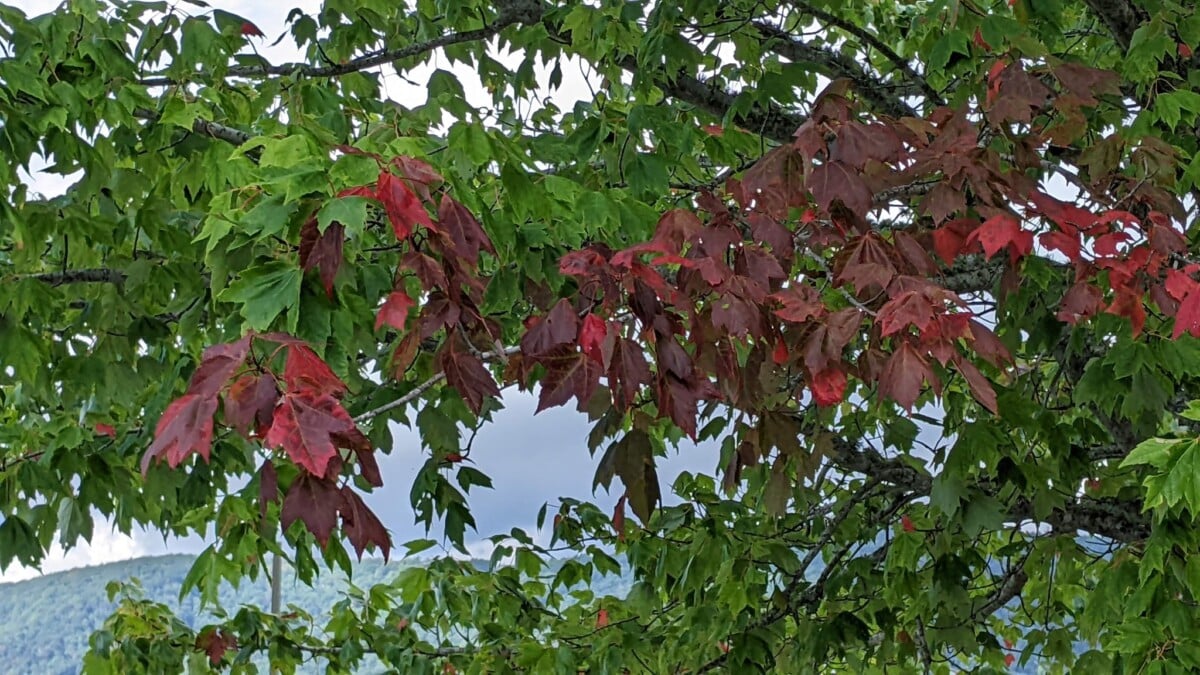
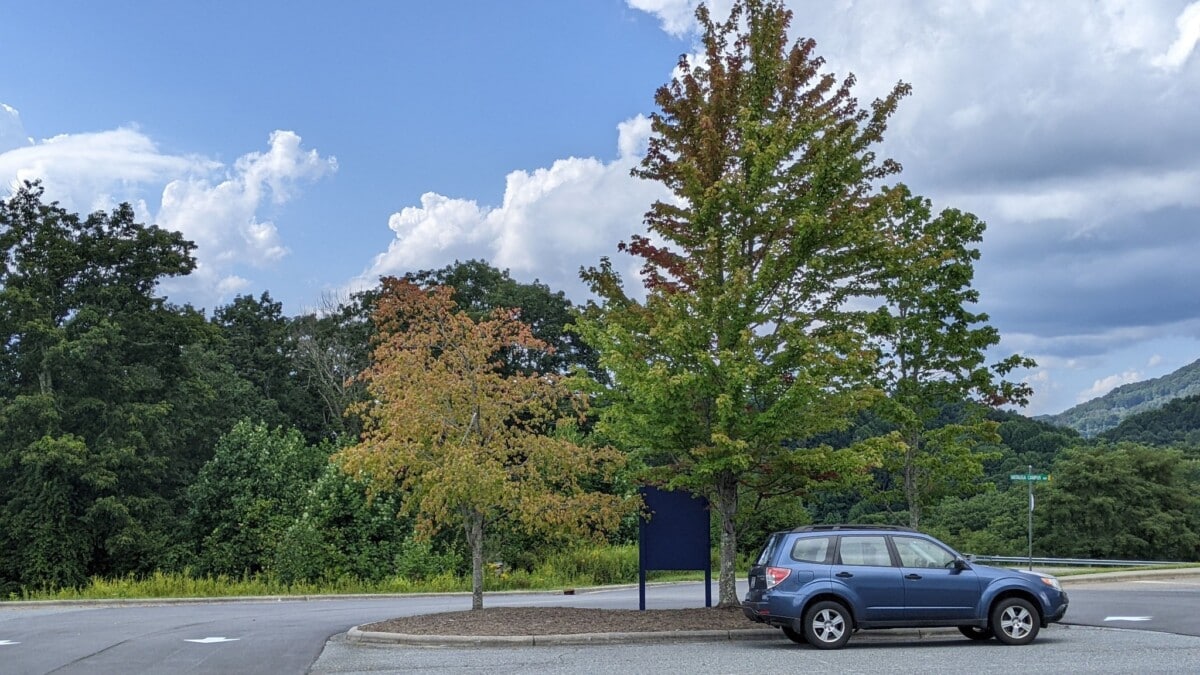
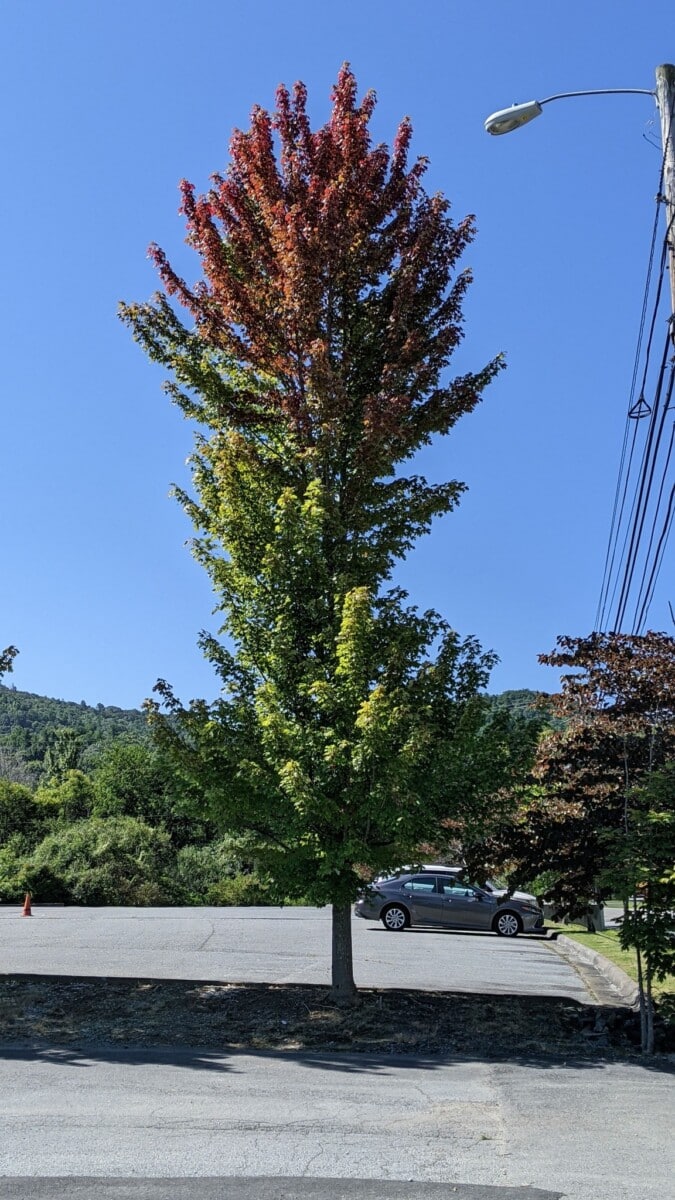
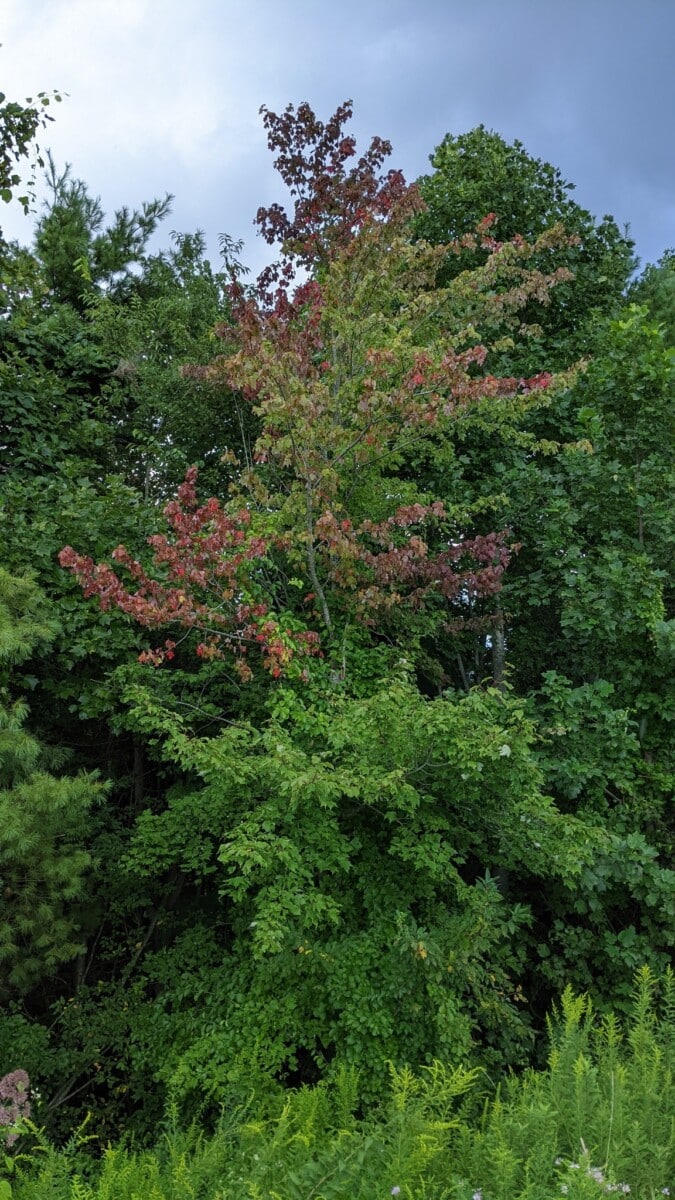
Fall Color Report for Week of November 10, 2021
I’m getting down to the end here. Today my wife and I traveled to Stone Mountain State Park (https://www.ncparks.gov/stone-mountain-state-park/home, https://www.carolinacountry.com/…/a-sheet-of-granite…) in northern Wilkes County and also Alleghany County, just east of the Blue Ridge Parkway, at about 2,300’ in elevation. This is a beautiful park, with 18 miles of hiking trails and overnight camping. It’s especially beautiful in the fall when the surrounding woods are ablaze in color. It’s only 1.7 miles to the summit with the granite rock outcrops at the top and which afford you excellent viewpoints in nearly all directions. This is the week to visit this park, as the colors are peaking now. They should last through this week into the upcoming weekend. Colors might also persist into next week too, but it is supposed to get cold after the weekend, which could hasten leaf fall. But I think you have a 7-10 day window to see great colors.Be aware that this is a popular park, and if you come on the weekend, get there early, because if it fills up, and you might not be able to get in. Coming during the week is the best way to avoid crowds.
Other plants you may see are Virginia pine, sumac (bright red leaves), blueberry (low shrubs with red leaves), various mosses and many different lichen species, particularly on the rock outcrops. There was also a fire some time back and the beginning of the summit trail passes through the burned area.
Next week I have to go to Black Mountain, so while there, I’ll take in Chimney Rock State Park, which is not too far away. That will definitely be (cross my heart and hope to live!) my last leaf color trip of this season. I wasn’t planning on this trip, but I was invited to visit some people there and decided I could squeeze in a visit to the Park that same day. I’ll report on it next week, which should be coming along nicely now and have good color then.Have a great weekend!
Fall Color Report for Week of October 17, 2021
Today I went up to Carver’s Gap at Roan Mountain, which straddles the NC and TN state line. The Appalachian Trail runs north/south across the top. It was cold today – way below freezing when I got there at around 9 am (and it was already crowded with people!). I found a parking space and decided to check out the Fraser firs on the south side of the gap: quite dense woods, with an understory of Fraser firs about three feet tall, just waiting for the taller trees to die before they take over as the dominants. Then, I headed back to the parking lot and went north up onto the balds, where most people hike.
I’m glad I wore warm clothes – it was in the 20s when I started off, with a stiff wind blowing from west to east. I hiked up to Jane Bald at 5,807 feet, then about a mile farther onto another bald even higher (I must have been above 6,000’ by then). Lots of hoar frost on the plants there. Hoar frost forms when vegetation gets below freezing and water vapor in the air begins to form on the leaves and stems, frozen dew so to speak. Hoar frost gets it name from its appearance, which resembles hair growing on the plants and hoar is an Old English word for old age.
I’ve posted some photos of the hoar frost on the bald. You often see it around the margins of leaves. This is because leaf edges cool quicker and to a greater extent than the main part of the leaf, a result of a smaller “boundary layer” at the edges of the leaf. A boundary layer is a layer of relatively still air that retards the loss of heat from a leaf. The thinner the layer, the faster heat will reradiate to the atmosphere from the leaf, thereby cooling it, sometimes below air temperature, which is why the hoar frost can appear even when the air is above freezing.
The colors up at Roan are peaking now, and quite spectacular I must say, once you enter the Cherokee National Forest coming up from Roan Mountain, TN. Take Rt. 194 south from Banner Elk, turn right onto U.S. 19E toward Elk Park, then go five miles and take a left at the sign for Rt. 143 and head for the state park. Go through the state park all the way to the top (about 8 miles). You can park at the top and then hike the Appalachian Trail, either north or south from there.
The maples, birches, and beeches are in fine form starting from the Cherokee National Forest sign to just below Carver’s Gap. Up on the bald, you’ll find red spruce and Fraser firs (this latter species is the one grown for Christmas trees), rhododendron (which bloom beautifully in mid-summer), and blueberries, plus lots of grasses, mosses and ferns.
Balds are an enigma in the Southern Appalachian Mountains, but have been around for thousands of years. The reasons for the absence of trees are still being debated, but if fire is kept out for too long, woody vegetation tends to encroach. Native Americans may have routinely burned the balds to favor grasses to attract the deer they hunted.
I highly recommend hiking at least to Jane Bald (maybe a mile or so), where you can have wonderful views in all directions. To the southeast you can see Mt. Mitchell, the tallest peak in eastern North America at 6,684 feet. To the north, you can see Grandfather Mountain, and on clear days, maybe all the way into Virginia.
As for other locations for fall color, the Blue Ridge Parkway around Grandfather Mountain is peaking this week, including Rough Ridge and the Linn Cove Viaduct. The same can be said for Elk Knob State Park north of Boone. More areas will be coloring up now that it has cooled down and is mostly sunny. Lower elevations will be developing color this week and by next weekend, there should be excellent color along the Parkway in most places. Below Asheville, places like Waterrock Knob are peaking now, and may be past peak by next weekend. However, even if higher elevation sites are past peak, lower elevation sites will be coming into their best color over the next two weeks.
Temperatures are going to begin rising again later this week, which is unfortunate, as we need the cold to bring out our best colors. But I think it will be cool enough in the mountains to spur on the colors. So, this week and next will be ideal to head to the mountains here. Have a safe trip if (when!) you decide to come up.
Fallen leaves line the Tanawha Trail footbridge over Wilson Creek, just off the Blue Ridge Parkway (Milepost 303.6), as the remaining greenery begins turning to gold.
Color continues to progress at higher elevations along the Blue Ridge Parkway and Grandfather Mountain. One of the most perennially colorful stretches is Rough Ridge, near Milepost 302.8 on the Parkway, and color can be seen popping between that particular milepost and the Grandfather Mountain exit (Milepost 305). This weekend marks the last of 2021's Fall Color Rambles on Grandfather Mountain, as the daily hikes through the park's most colorful areas conclude this Sunday, Oct. 10. These short and easygoing guided strolls are offered free with admission. Learn more at www.grandfather.com. Photos by Skip Sickler | Grandfather Mountain Stewardship Foundation
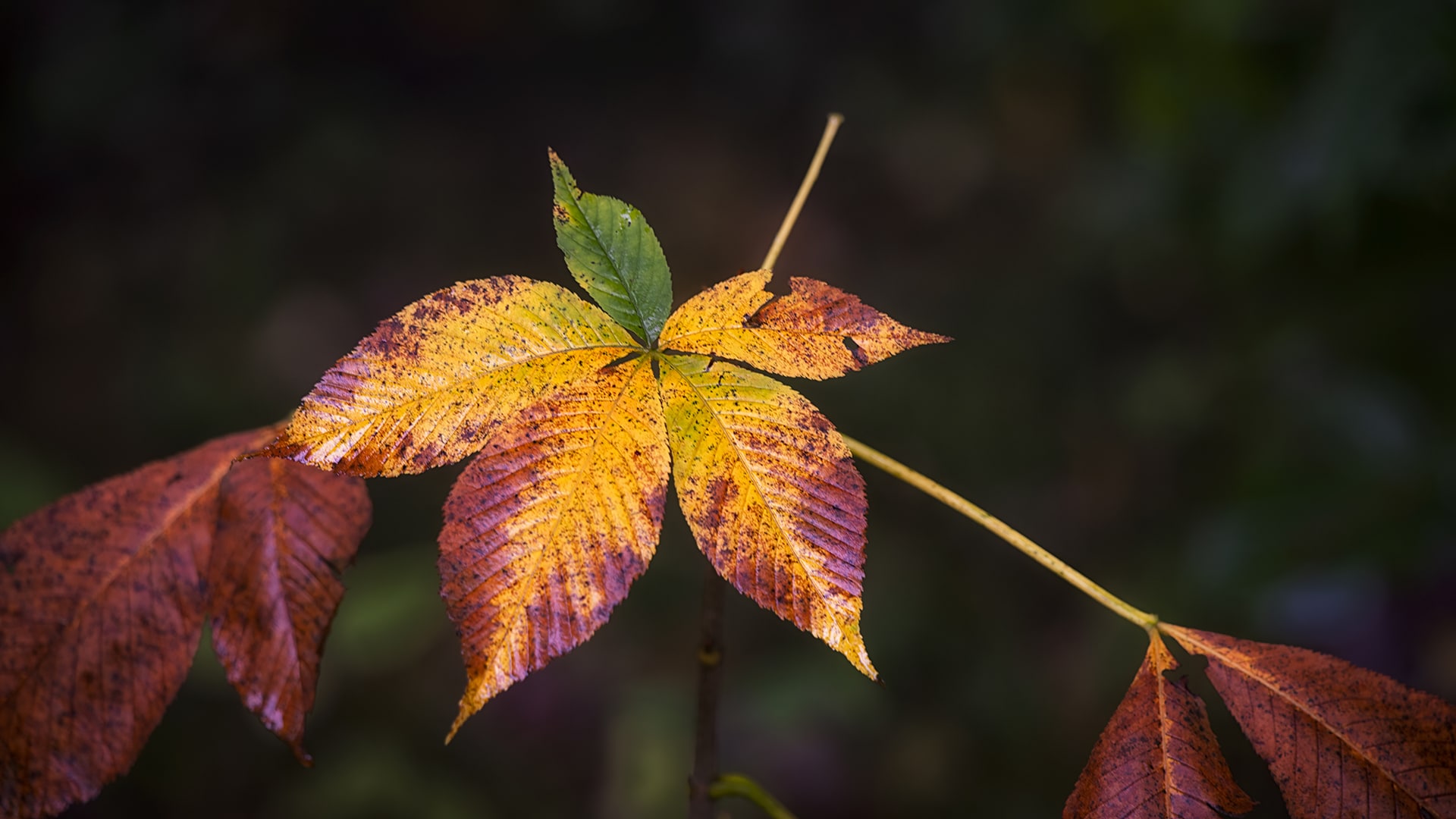
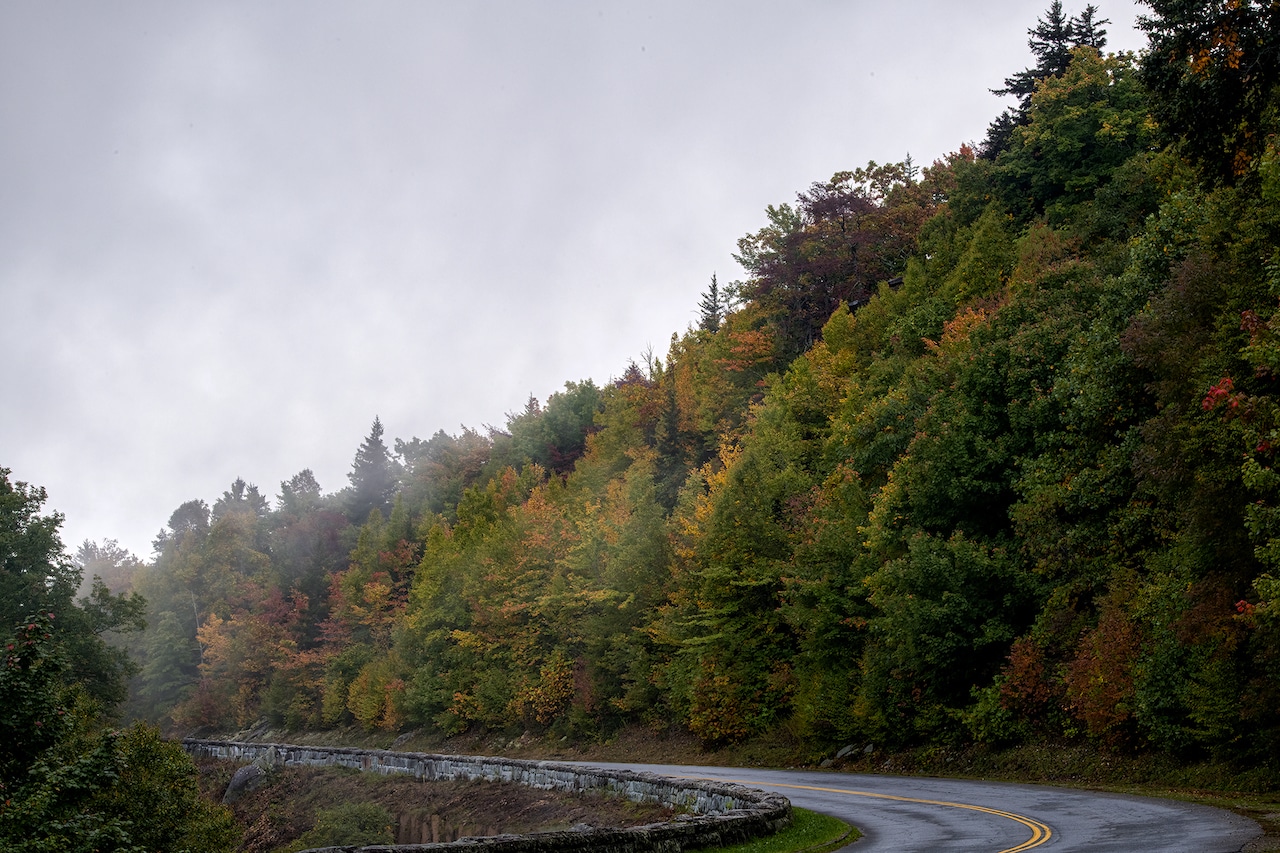
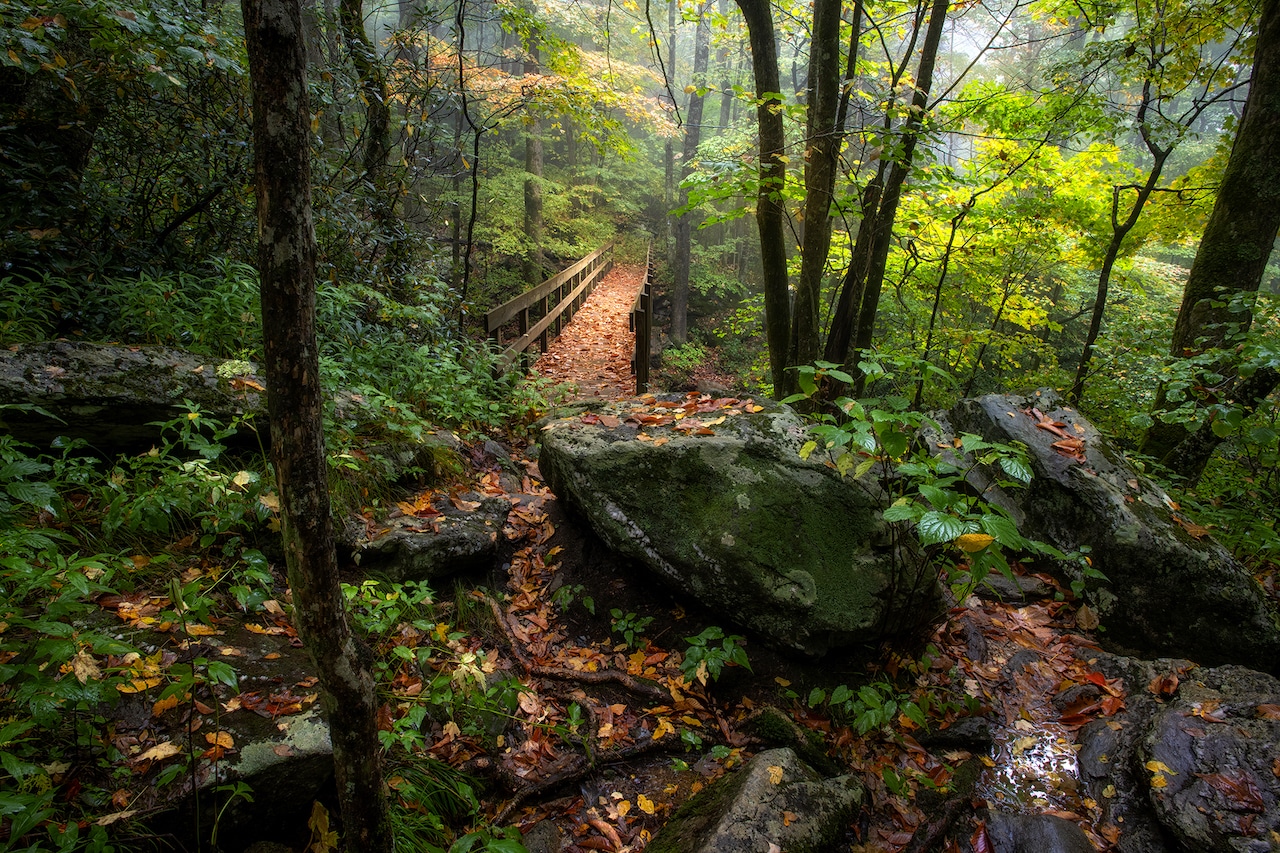
An early morning break in the clouds offers stunning views of color-dappled hills and valleys, as seen from atop Grandfather Mountain’s Linville Peak and the Mile High Swinging Bridge. For more fall color photos, visit grandfather.com/fallcolor. Photos by Skip Sickler | Grandfather Mountain Stewardship Foundation | grandfather.com
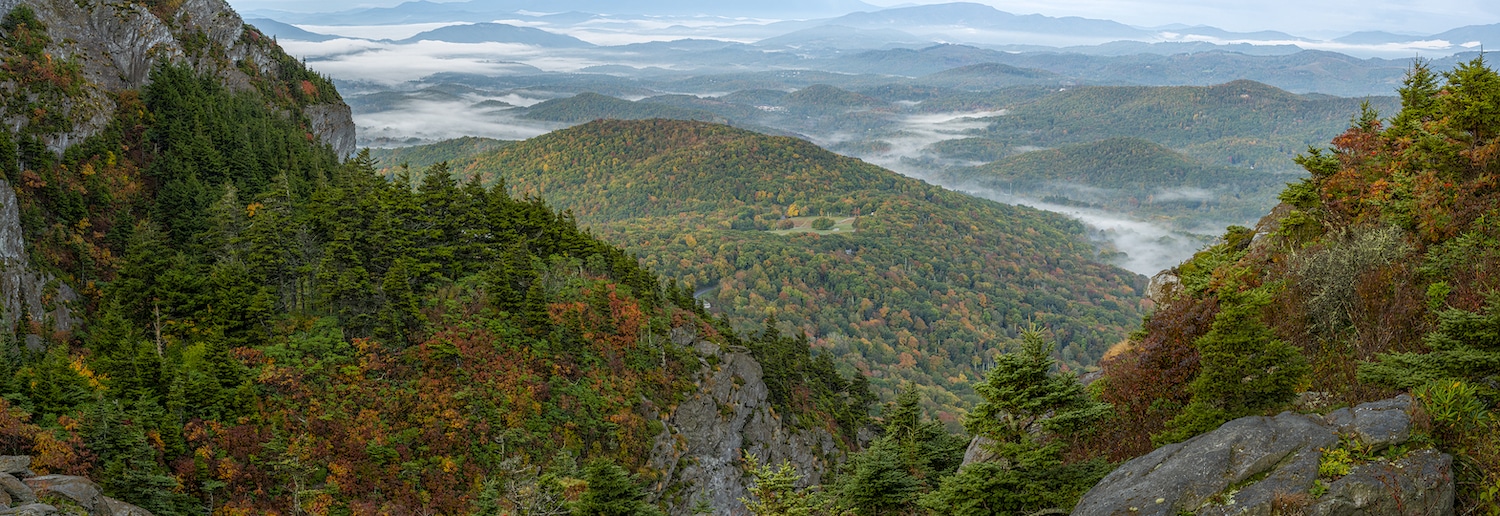
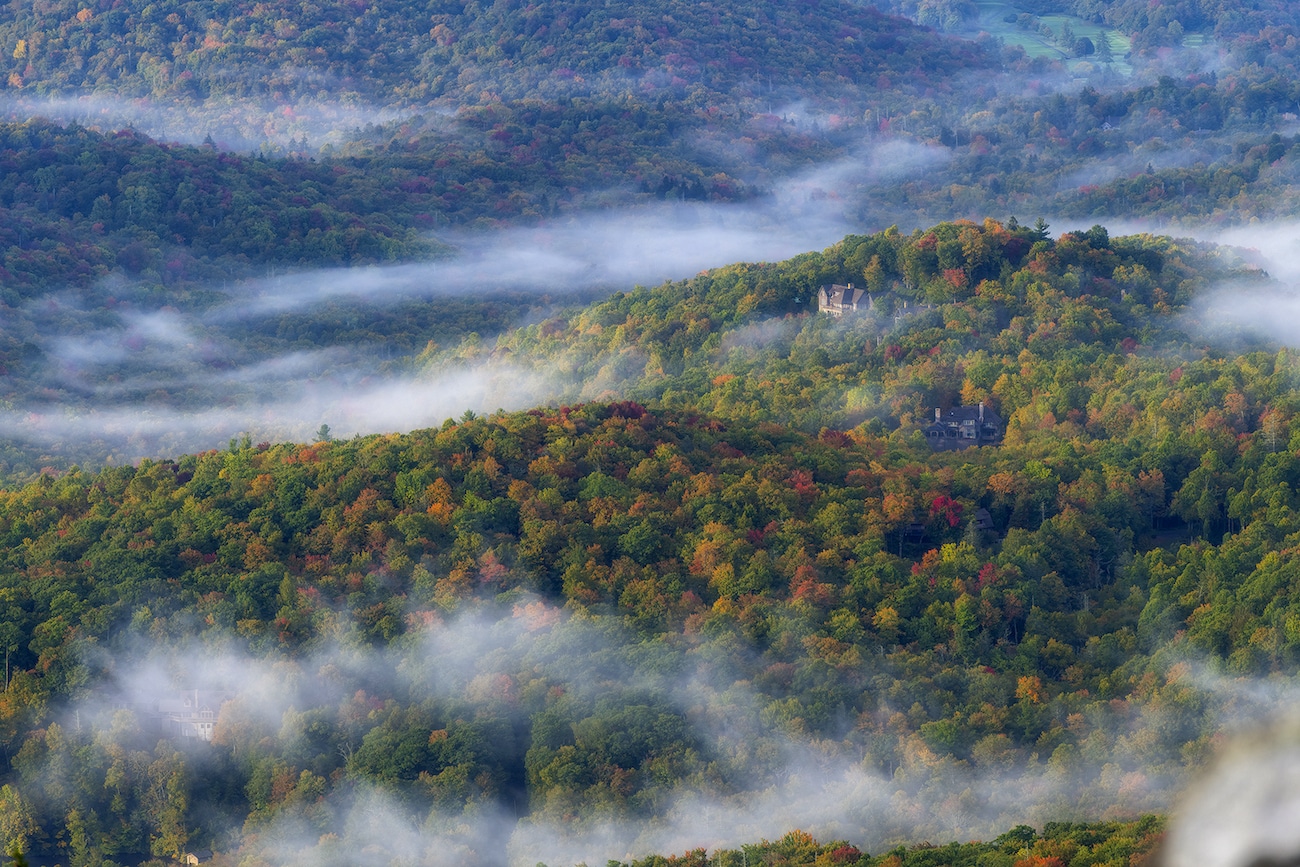
While fog typically obstructs views, during autumn, it can serve as a striking contrast for vibrant fall color, as seen here near Rough Ridge on the Blue Ridge Parkway (Milepost 302.8). Color is just starting to appear along areas of the Blue Ridge Parkway 3,500 feet and under in elevation. However, as one travels along the parkway's higher elevations, such as Rough Ridge (4,773 feet), vivid fall foliage is nearly impossible to miss. Experts anticipate that this coming weekend (Oct. 9-10) could see peak color at the higher elevations of Grandfather Mountain (5,496 feet and below), with the following week and weekend offering prime fall color viewing opportunities from atop Grandfather and many Blue Ridge Parkway overlooks. Photos by Skip Sickler | Grandfather Mountain Stewardship Foundation | grandfather.com
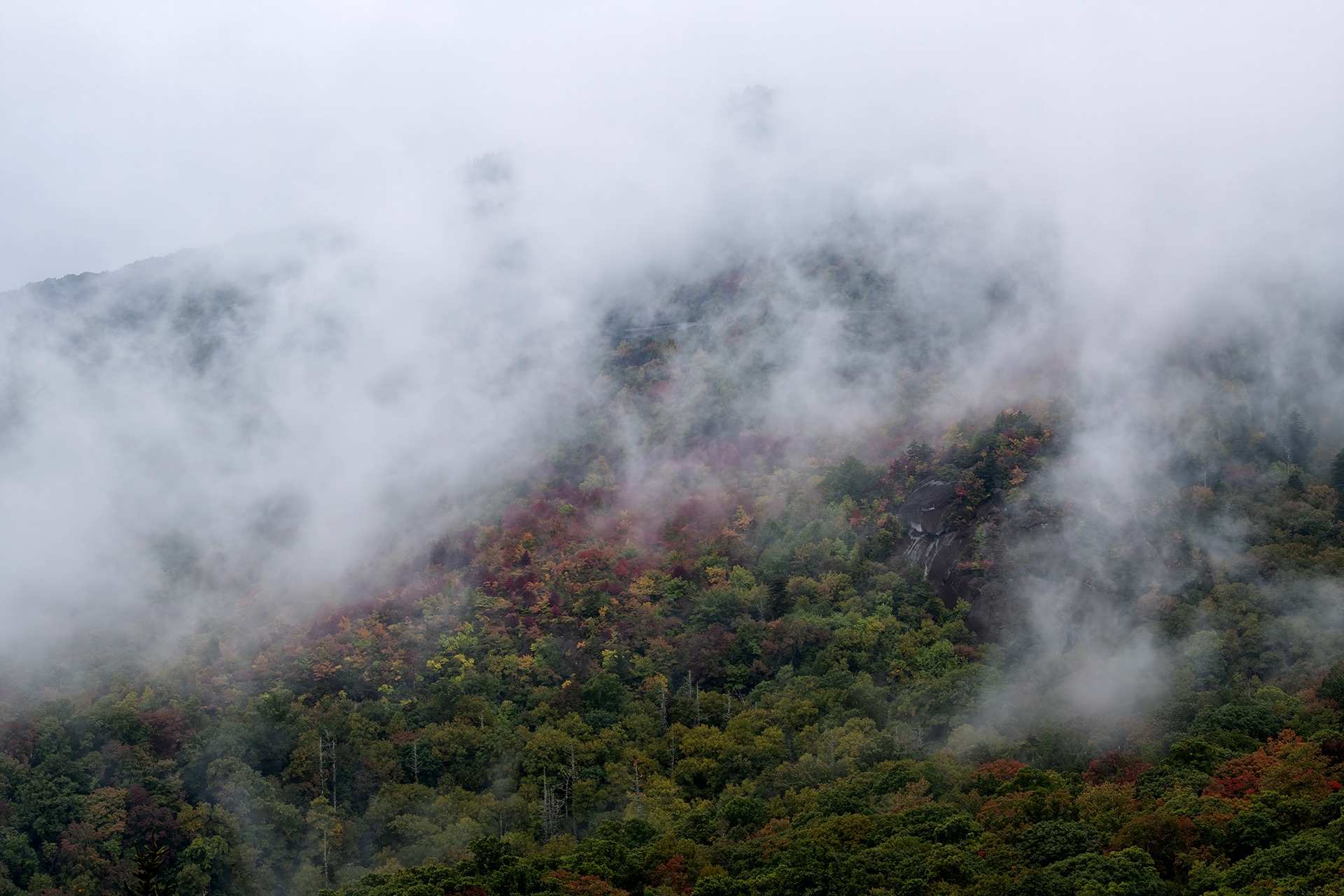
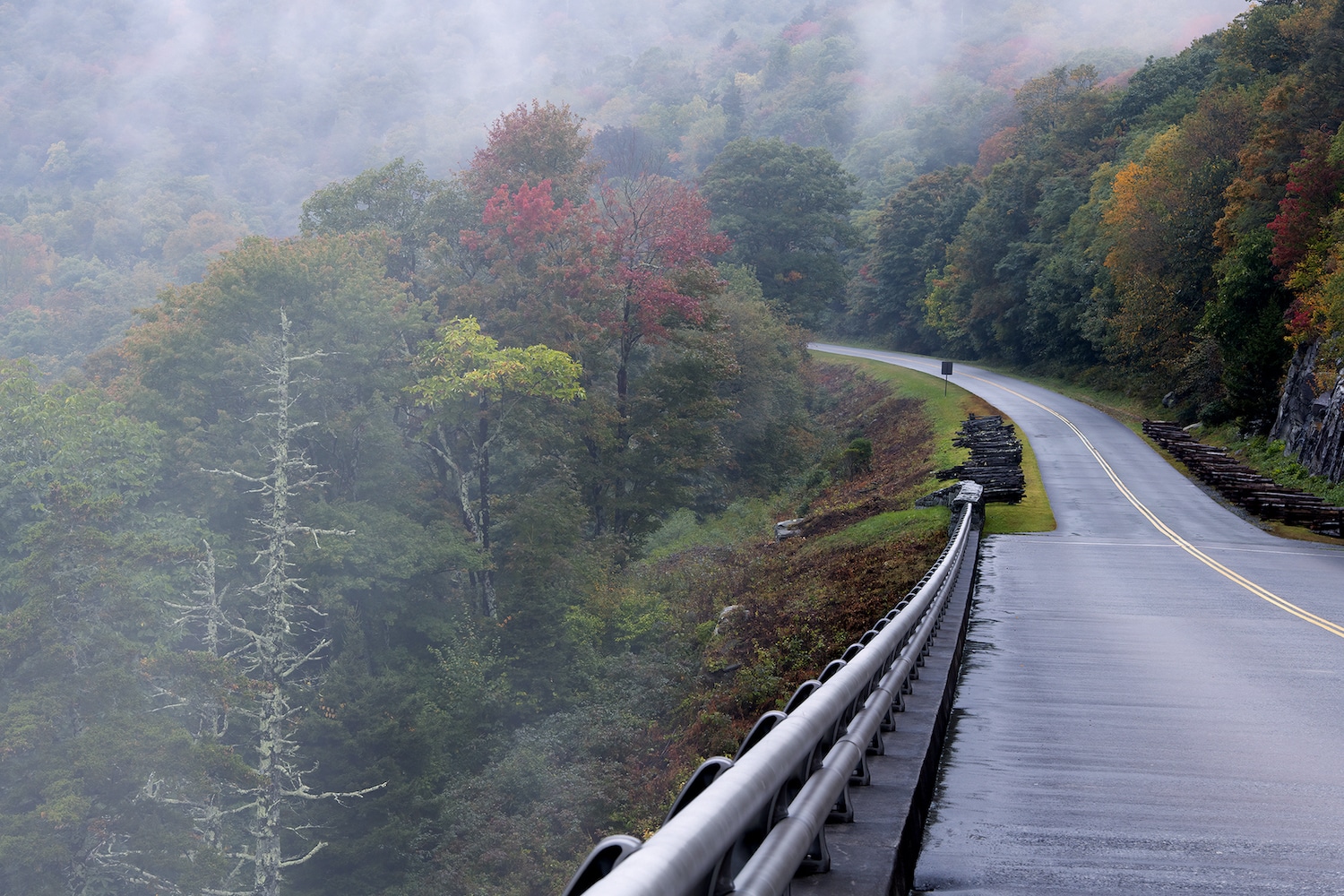
Sunrise cascades over the WNC High Country, highlighting bursts of fall color appearing in the area's lower elevations, as seen from the town of Banner Elk this past Sunday. Standing more than a mile high in elevation, Grandfather Mountain in nearby Linville offers the ideal vantage point to enjoy the entirety of autumn, allowing guests to see the whole season unfold before their eyes into the valleys and foothills beyond. Photos by Todd Bush | bushphoto.com
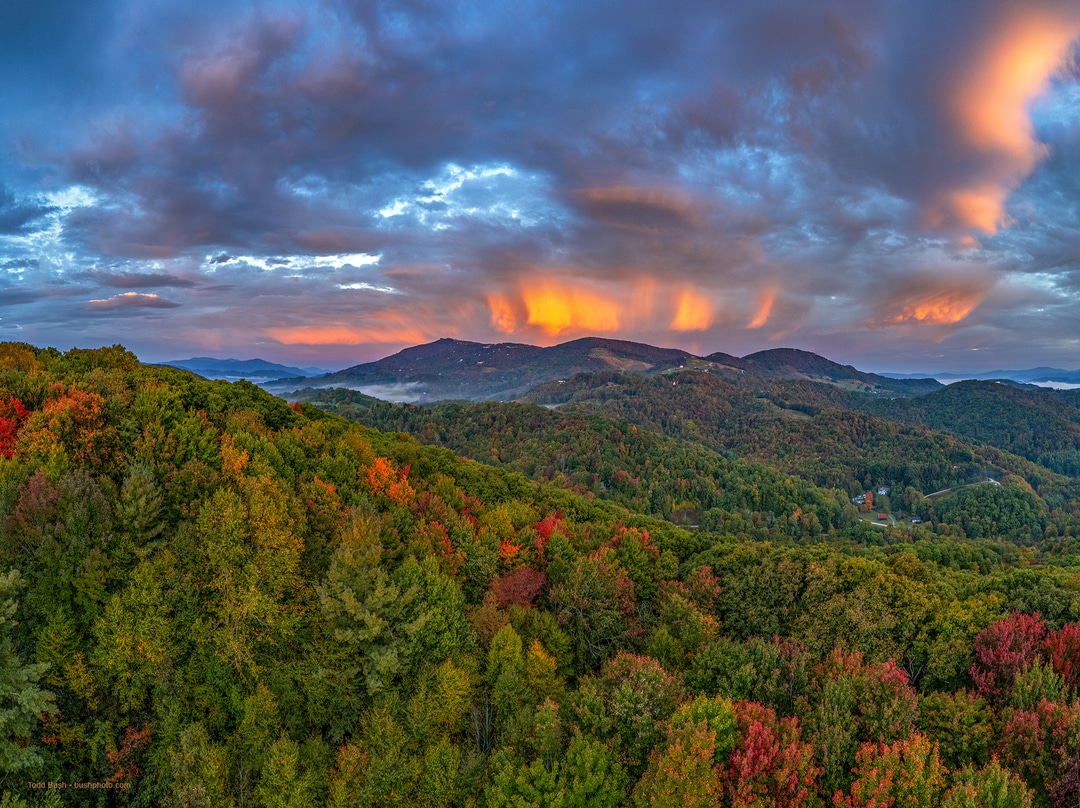
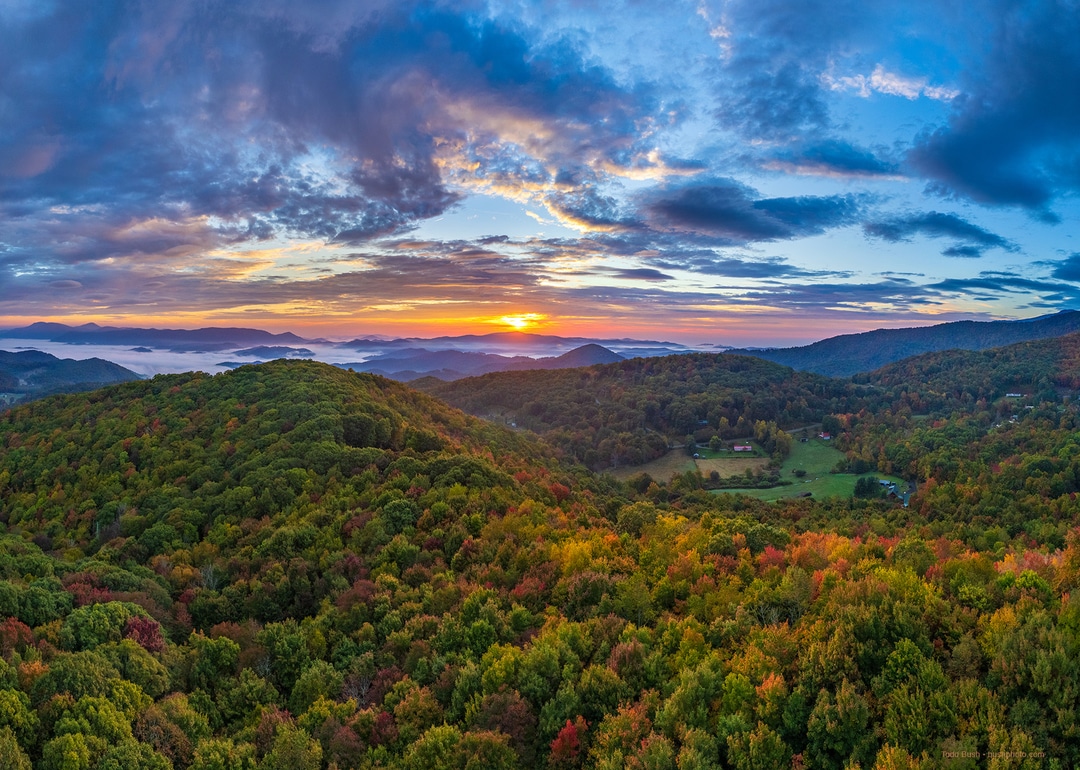
For some of the sights of the fall colors over this past week visit this link – Sights of leaf weekend October 1-3, 2021
Fall Color Report for Week of October 3, 2021
went out before the rains moved in today and went north onto the Blue Ridge Parkway from US 421. It was hazy out, but on occasion, the sun broke through and there was some color to see in places, but for the most part, the dominant color is still green in this area. The BRP in this region ranges mostly between 3,100’ to 3,500’ in elevation, and at these elevations, colors are just starting.
If you go south on the BRP toward Linville and Grandfather Mountain, colors are somewhat further along at the higher elevations, especially in the Rough Ridge area and the east flank of Grandfather. Same for the high elevations at Elk Knob State Park north of Boone. I’ve also seen reports (and photos!) that Graveyards is at or near peak now, and I suspect, so will be Craggy Gardens, just north of Asheville. I will check out some of these areas next week.
As for my drive today, I headed up to Doughton Park, the largest park on the BRP and went straight to the old hotel and picnic area (take a right at the intersection by the visitor center). By the way, the restaurant next to the visitor center, which hadbeen closed for some time, is now open and serving customers. You can sit inside or out and I hear the food quality is very good (see a very nice review in the latest issue of Our State Magazine).
If you take the left fork on the road to the hotel you will dead-end in a parking lot. At the end is a trailhead, and you can either take a long and downward hike (which means you have to come up it on the way back!), or a very short walk of just a few hundred feet to a stone overlook with tremendous views. Right below the overlook is a cabin in Basin Creek Cove that was occupied in the early 20th century by a couple, Martin and Janie Caudill, who raised 14 children in that small cabin – that must have been something!). It is 1,500’ below the overlook to the cabin, so the drop off here is quite impressive. The view is northward and on a clear day, you can see Pilot Mountain, or, you can see forever, and ever, and ever (I like that song!).
Today, there was just a hint of color on some hillsides, but for the most part, the forests are still quite green. I don’t think peak color will hit this area for another 10-14 days. There are isolated trees with great color, but they are scattered and far and few between. There are nice wildflowers in bloom or seed, including asters, goldenrods, clematis, milkweeds, and witch hazel, a shrub that strangely blooms in the fall.
I saw lots and lots of monarchs flying around on my hike today. More than in past years. They preferred the asters and I saw this at several stops on my drive today. These insects may be headed for the endangered species list because their native habitat and food plants here in the U.S. are being depleted, and in their overwintering grounds, in just one forest in Mexico, the threat of logging could wipe out large numbers of the main migrating population. We need to do more to preserve this iconic species on the landscape. Planting native wildflowers in your gardens is one way, and avoiding overuse of pesticides is another. You do want your children to see this majestic butterfly when they grow up, right?
Doughton Park has a number of good hikes of varying difficulty and length, and many provide you with good views. A few more miles to the north, you get to Cumberland Knob, where the BRP first started back in the 1930s. There is a nice picnic area and some good hikes there too. Just 4 miles north of the entrance to the BRP off of US 421 is the Cascades Falls picnic area. There are good views here too, plus a nice 1 mile easy loop trail to a waterfall. There are restroom facilities too.
At the intersection of Phillips Gap Road and the BRP, on the left as you head north, is a farmer (sorry, I don’t know his/her name) with a very large pumpkin patch. So, if you have kids, you might head up that way and check out those very large, orange things! Closer to home in Boone, the Appalachian State University campus has numerous trees in various stages of fall color display, so a walk around the campus will reward you with some nice views.
We are supposed to have rain all this week, up to 5” total over 5-6 days. It may not be raining all day each day. The weekend though, is looking good, so Oct 9 and 10 should be fine for fall color viewing and colors should be peaking then at the higher elevations and showing up better lower down. Once this low-pressure system moves out, I think we are in for a good fall foliage display this year.
Fall Color Report for the Week of September 26, 2021
Since fall leaf color starts first at the higher elevations and then works its way downslope about 1000’ every 7-10 days, I decided to hike to the top of Elk Knob State Park, which is about 10 miles north of Boone with a summit at around 5,500’. I highly recommend this hike – 2 miles on switchbacks to the top, with an easy grade all the way up. At the summit, there are two overlooks, one facing south where you can see Grandfather Mt. as well as Mt. Mitchell and Roan Mt. The other overlook faces north into Ashe County and you can get great views of color from that overlook, as well being able to see the second tallest mountain in Virginia, Whitetop Mt. Mt. Rogers is not too far away either, and on a really clear day, you can see Pilot Mountain. Get there early though. I was the first person there yesterday and when I arrived back at my car around 12:30 pm, the parking lot was overflowing.
Fall colors have just started appearing now in the High Country. The forest below the north-facing overlook always has great color, even in bad years, and I was able to notice the beginnings of color on the slopes yesterday. Colors will progress rapidly now and it seems the weather is cooperating – it was 39F the other morning here, with a high only in the low 60s, and with absolutely clear, blue skies. These are the perfect conditions for a good fall color display.
The hike up Elk Knob has a number of interesting plants to observe. My favorite is the hobblebush, a native viburnum species, whose leaves turn a reddish-purple, but in a highly stochastic pattern. Sometimes one side of a leaf will be red, while the other is still perfectly green. Sometimes the red/purple develops in what seems like randomly placed splotches all over the surface. Eventually, the leaf turns completely red/purple. Because most of its neighboring plants are still green, these colorful leaves show up dramatically in the forest understory. The best time to see this plant is NOW and for the next two weeks. I have posted pictures of this species, plus others I saw yesterday.
Most of the forests in the area are still green at lower elevations. Mountain ash, which only grow above 3,500’ usually, and are common even higher up, are fruiting nicely this year (last year was a bad year for them). These fruits are initially an orange color, but when ripe turn a bright red that contrasts sharply against an azure, cloudless sky. There are some really nice ones adjacent to the north overlook on Elk Knob.
Elk Knob has a lot of beech trees and these form dense stands along the trail. Once you get to the top, the weather is so severe that the trees up there are much shorter (only about 6-8’ tall). At lower elevations, there is a mixture of maple, beech, birch that give rise to great color in mid-October.
As for other sites in Western NC this week, most are still quite green. But over the next two weekends I expect more and more color to develop. We’re supposed to get another cold front in about a week, and that should spur the colors on. To avoid crowds, get out early, go during the week, and take some back roads instead of just the Parkway. Don’t forget Roan Mountain, on the NC/TN border, about 45 miles from Boone. Great hiking on the Appalachian Trail, and beautiful views of color from the top. Now would be good times to visit the high elevation sites such as Craggy Gardens and Graveyards, as they always color up early.
Next week I’ll head toward Asheville to check out the colors down in that neck of the woods.
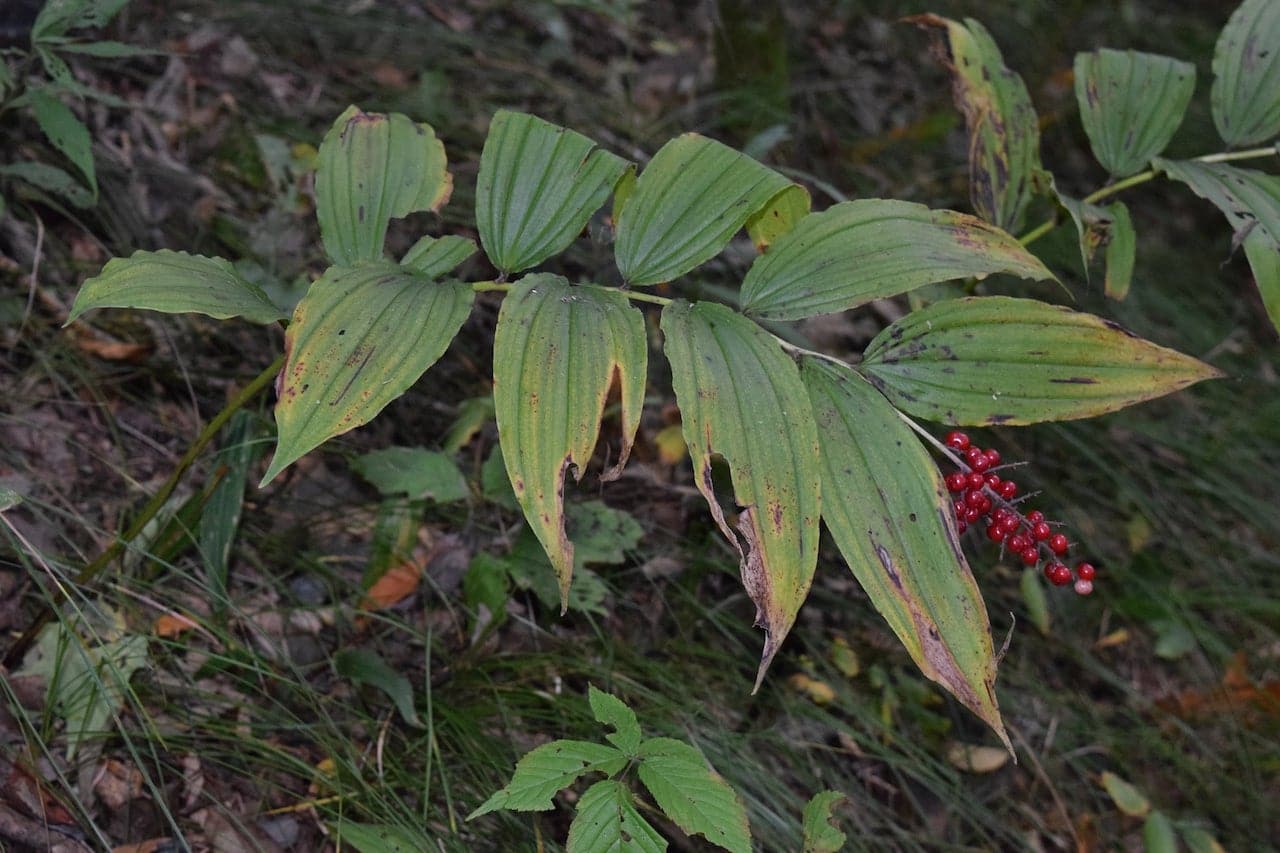
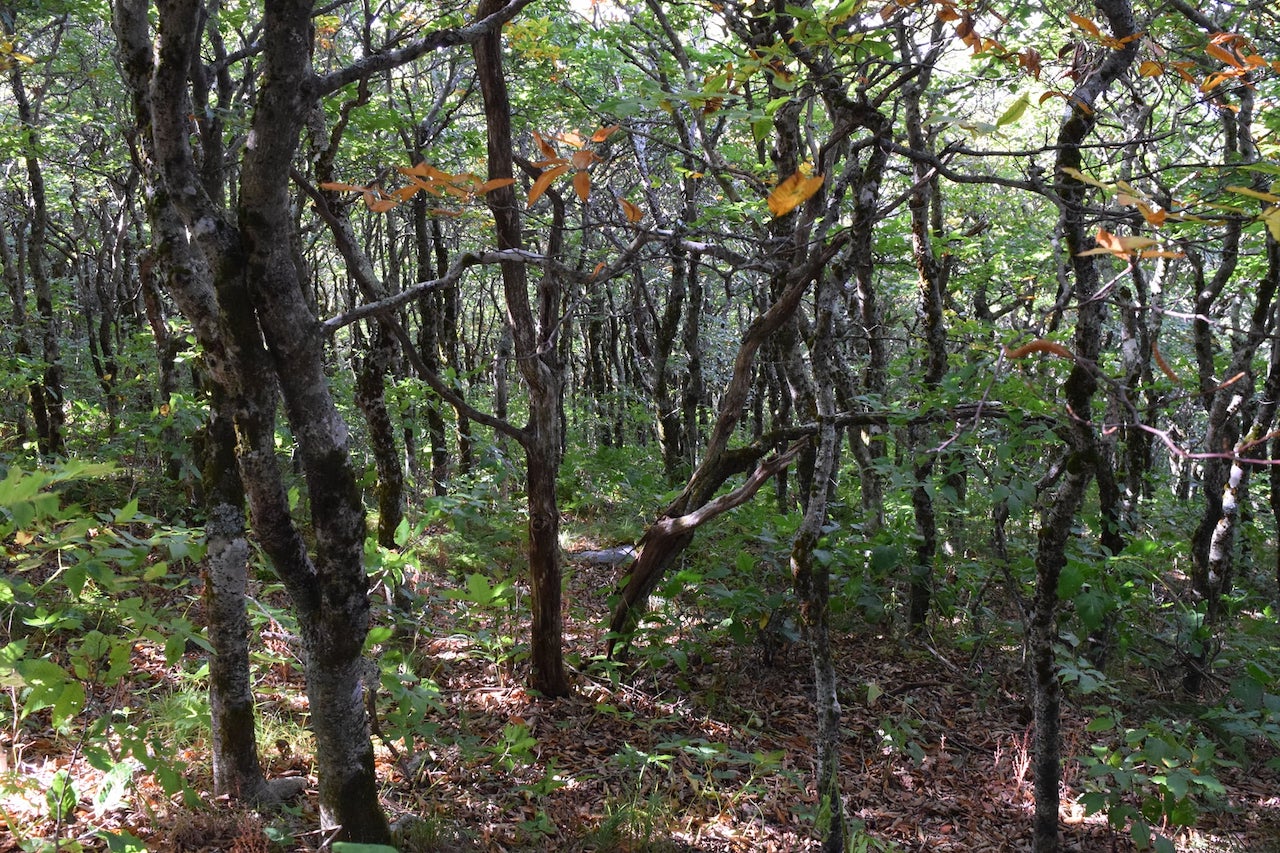
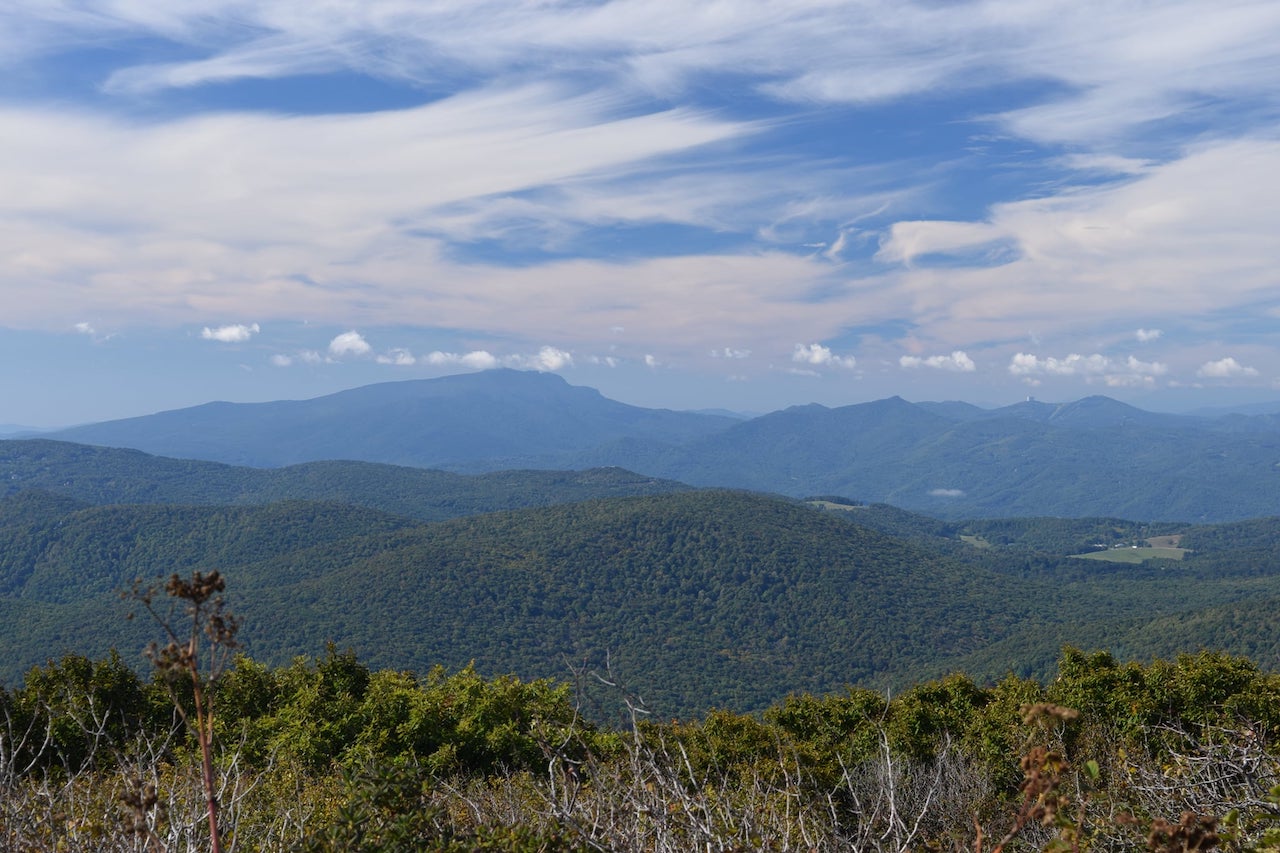
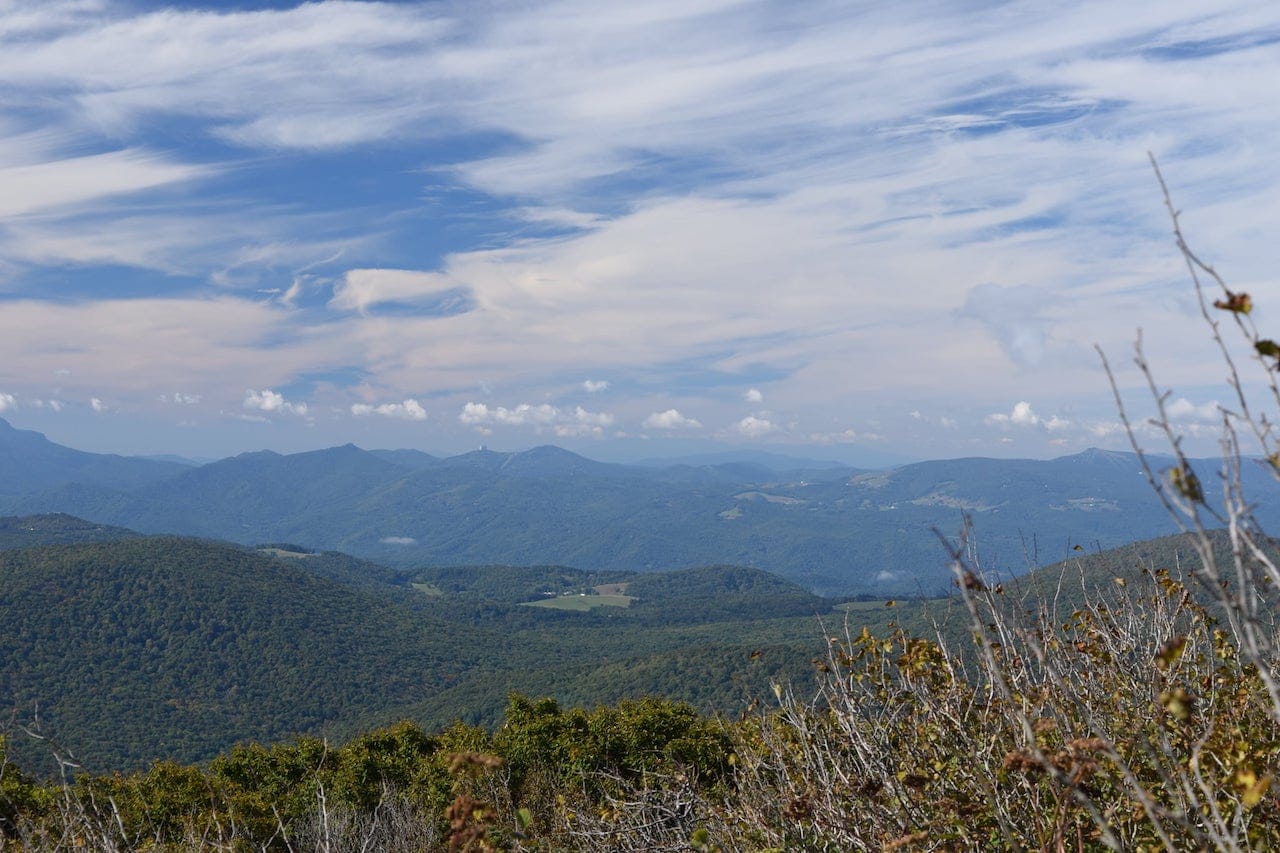
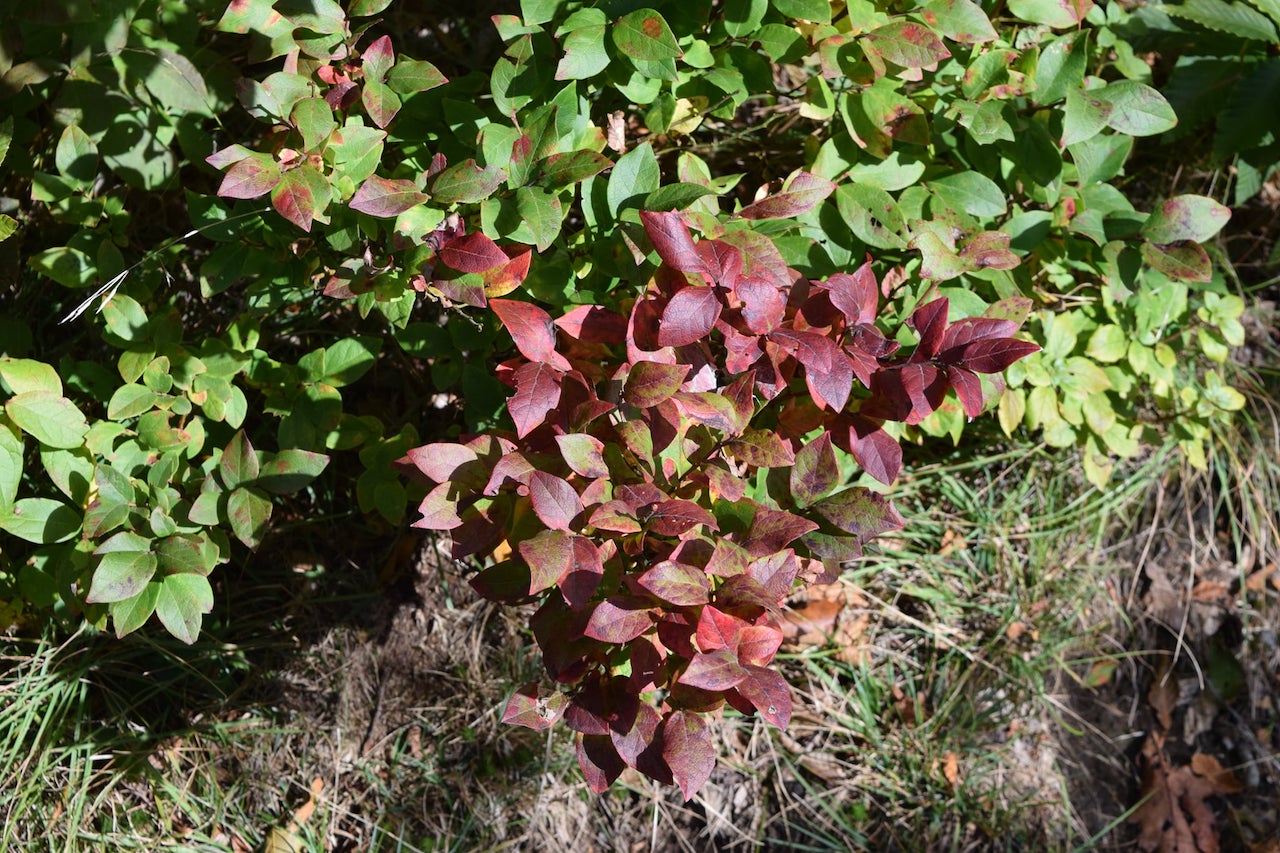
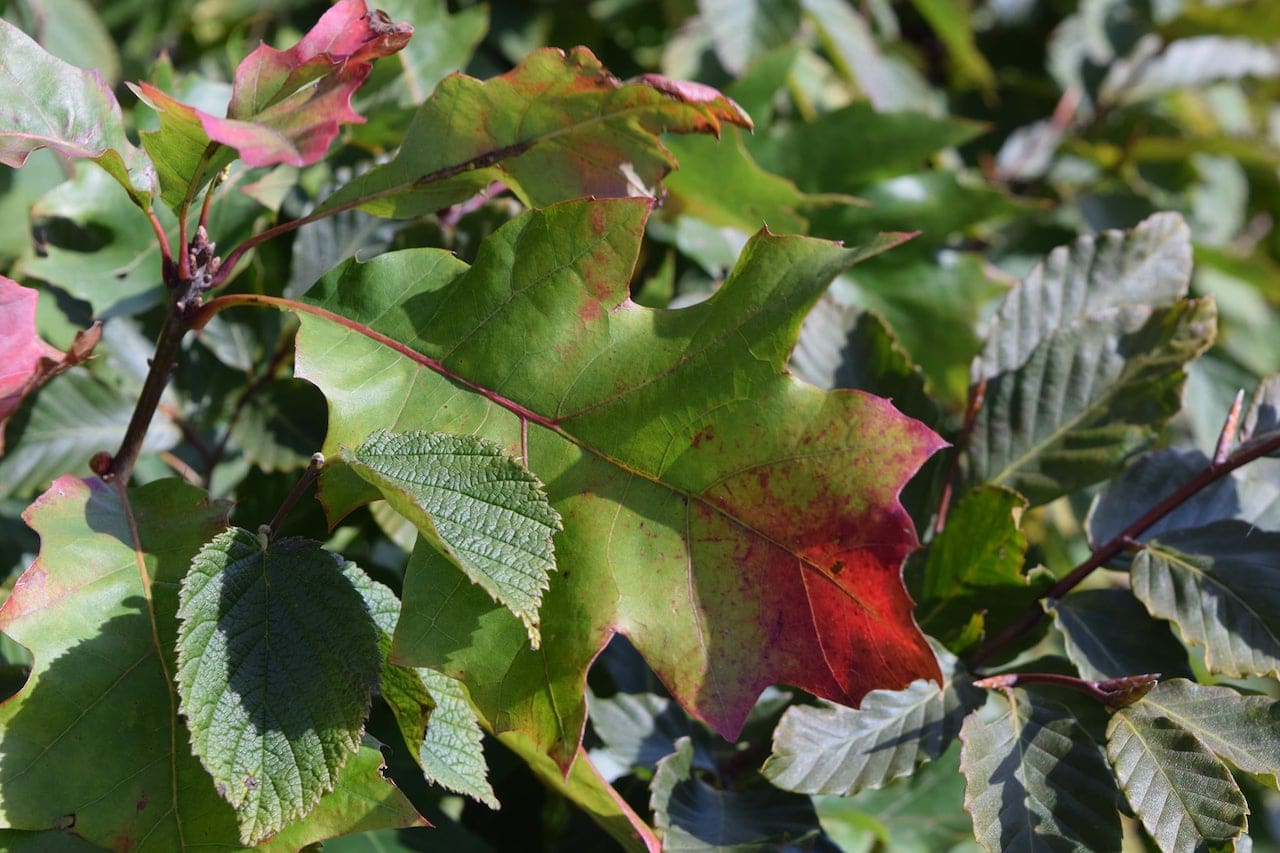
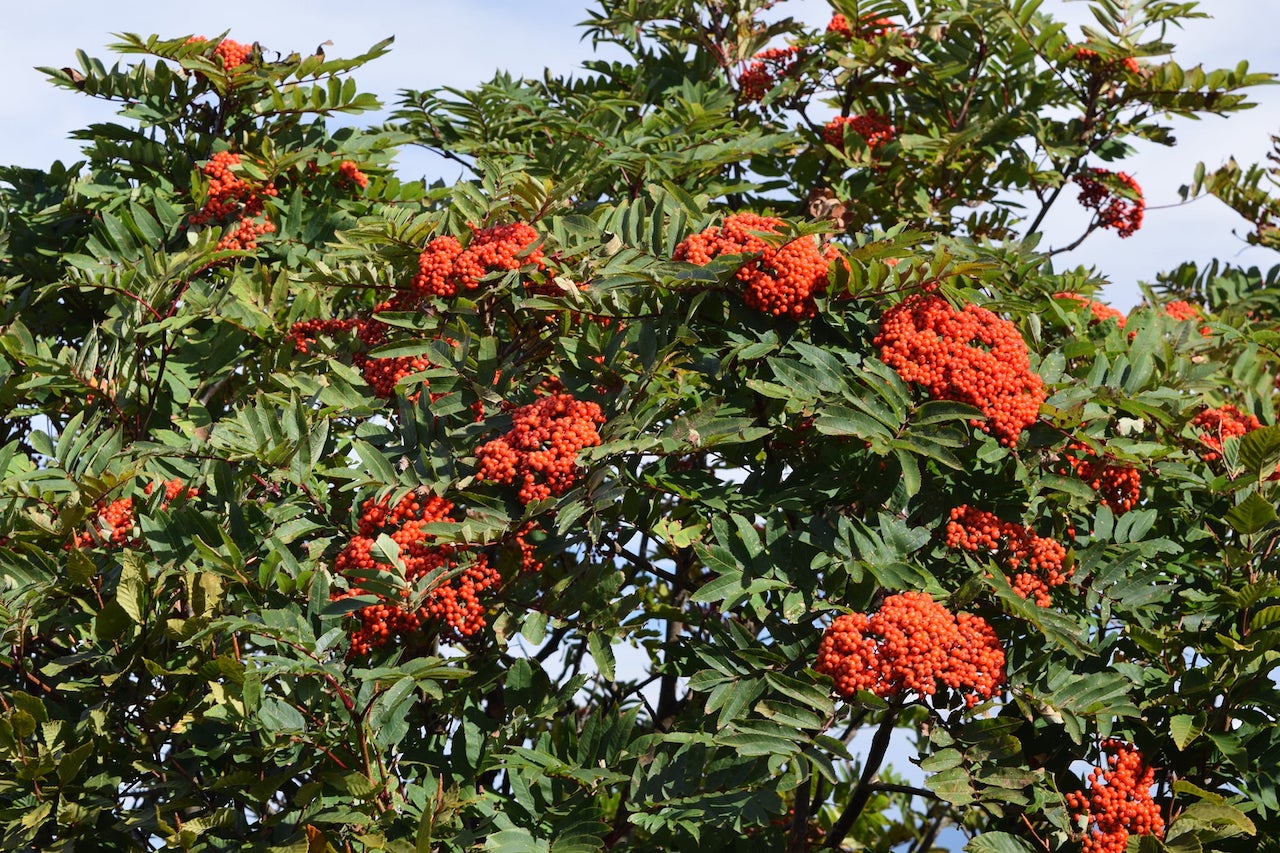
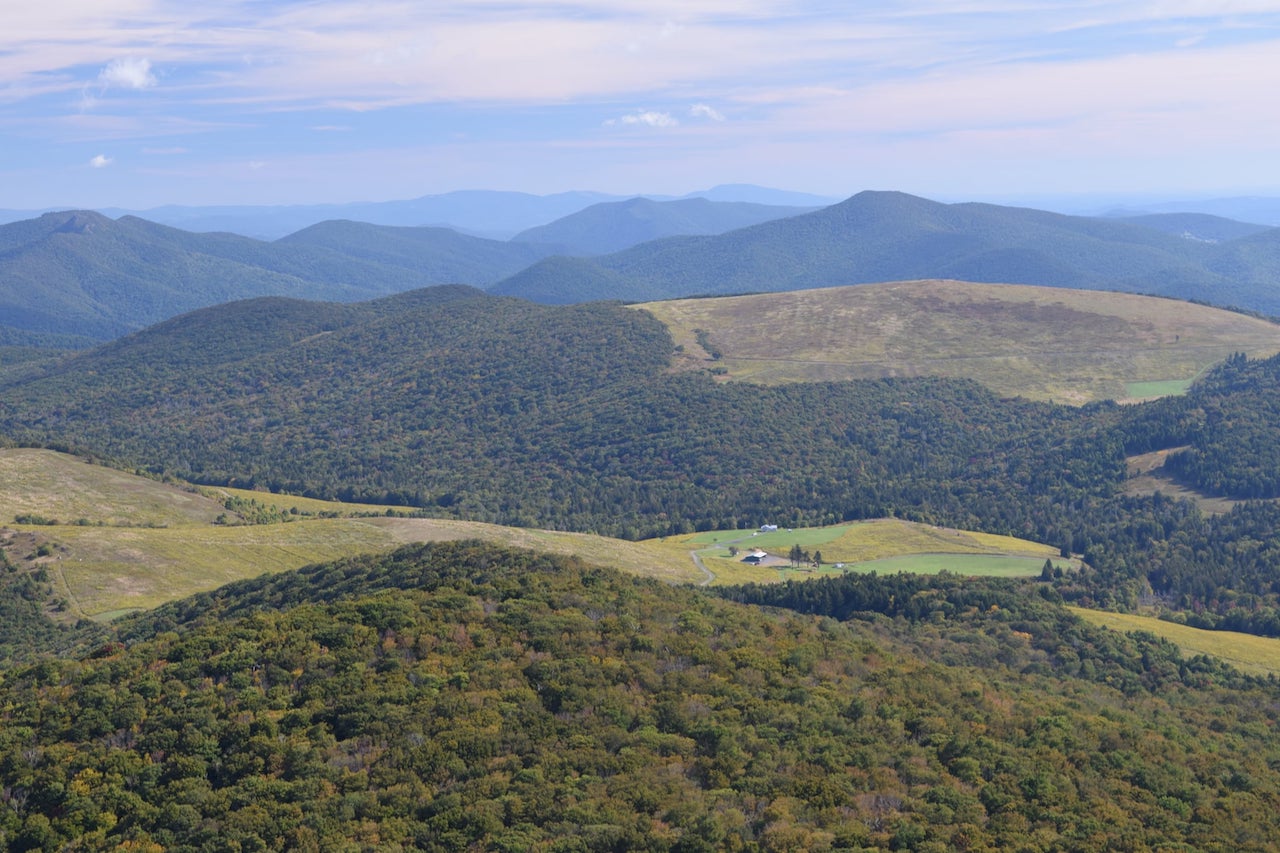
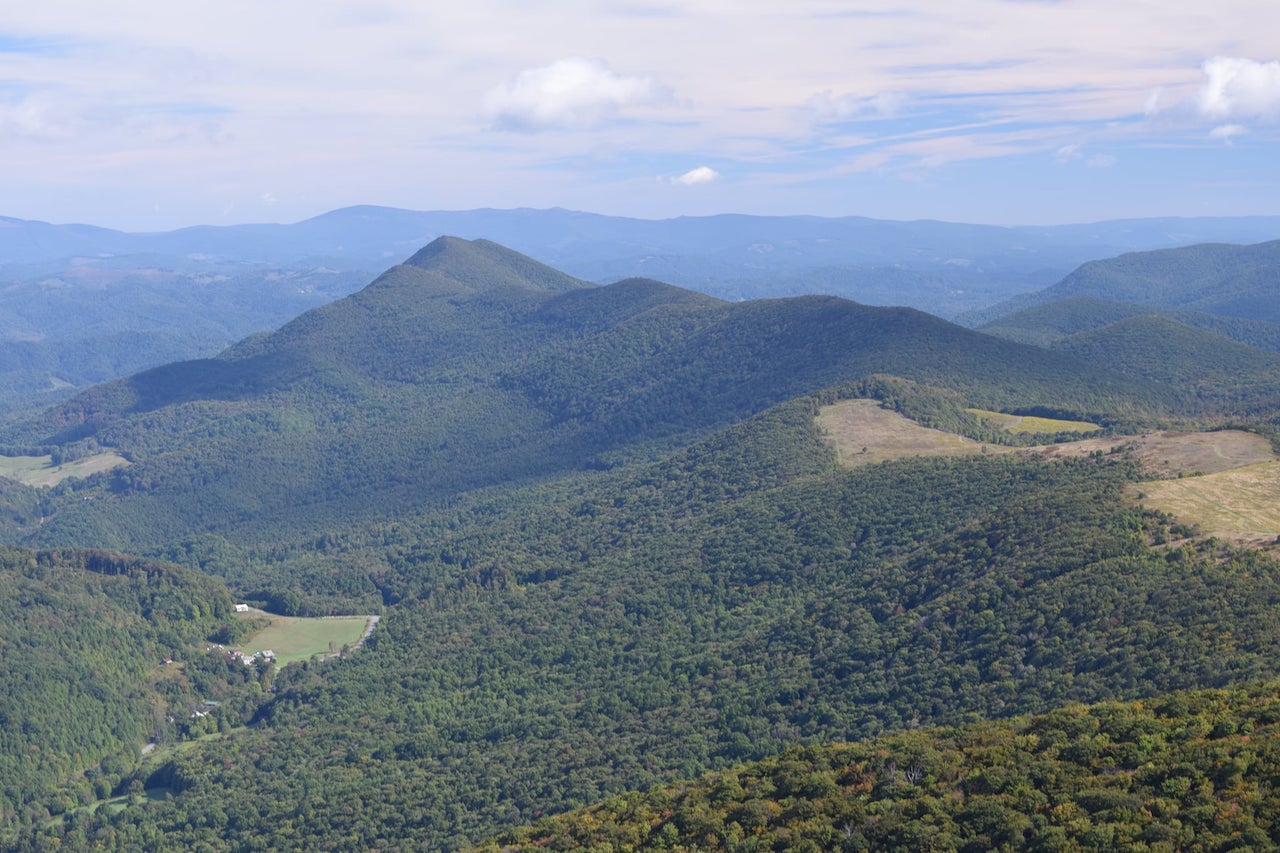
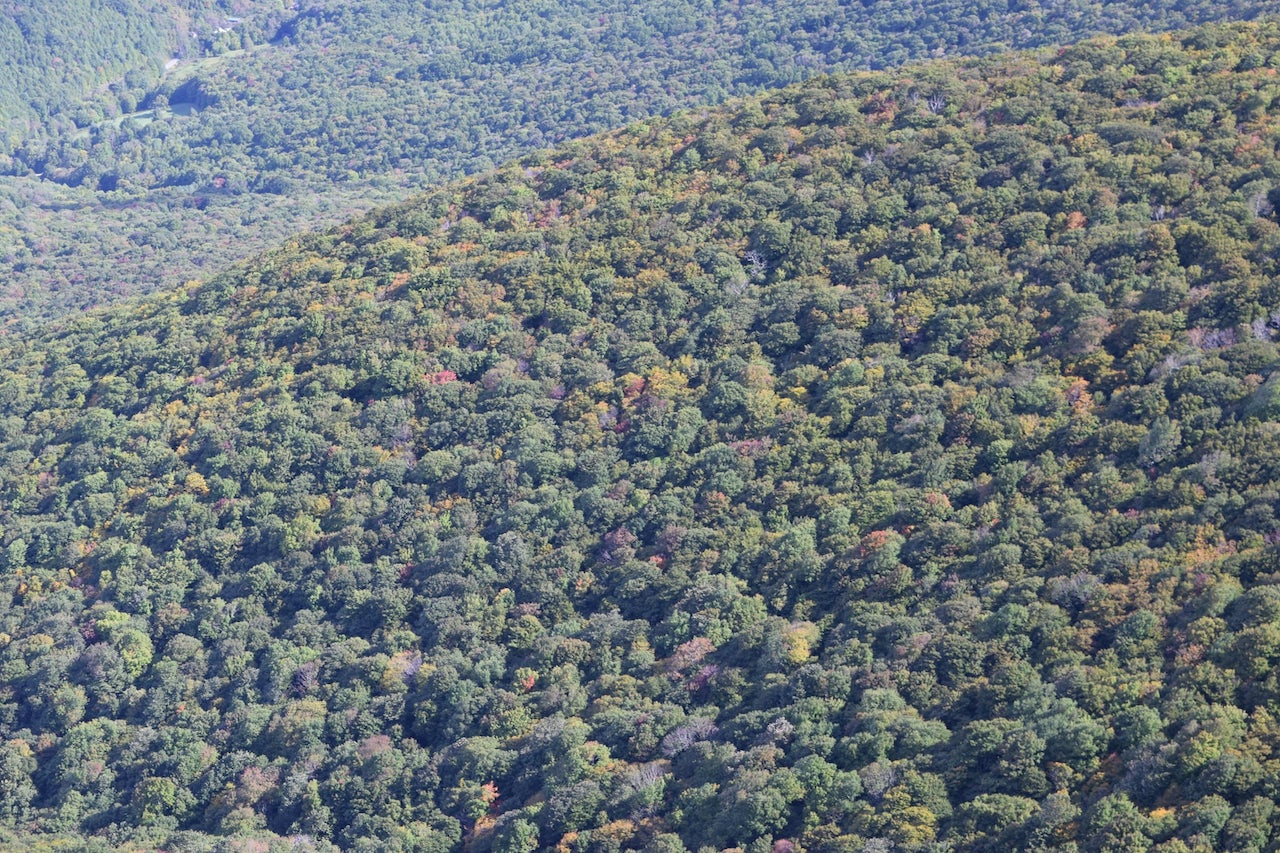
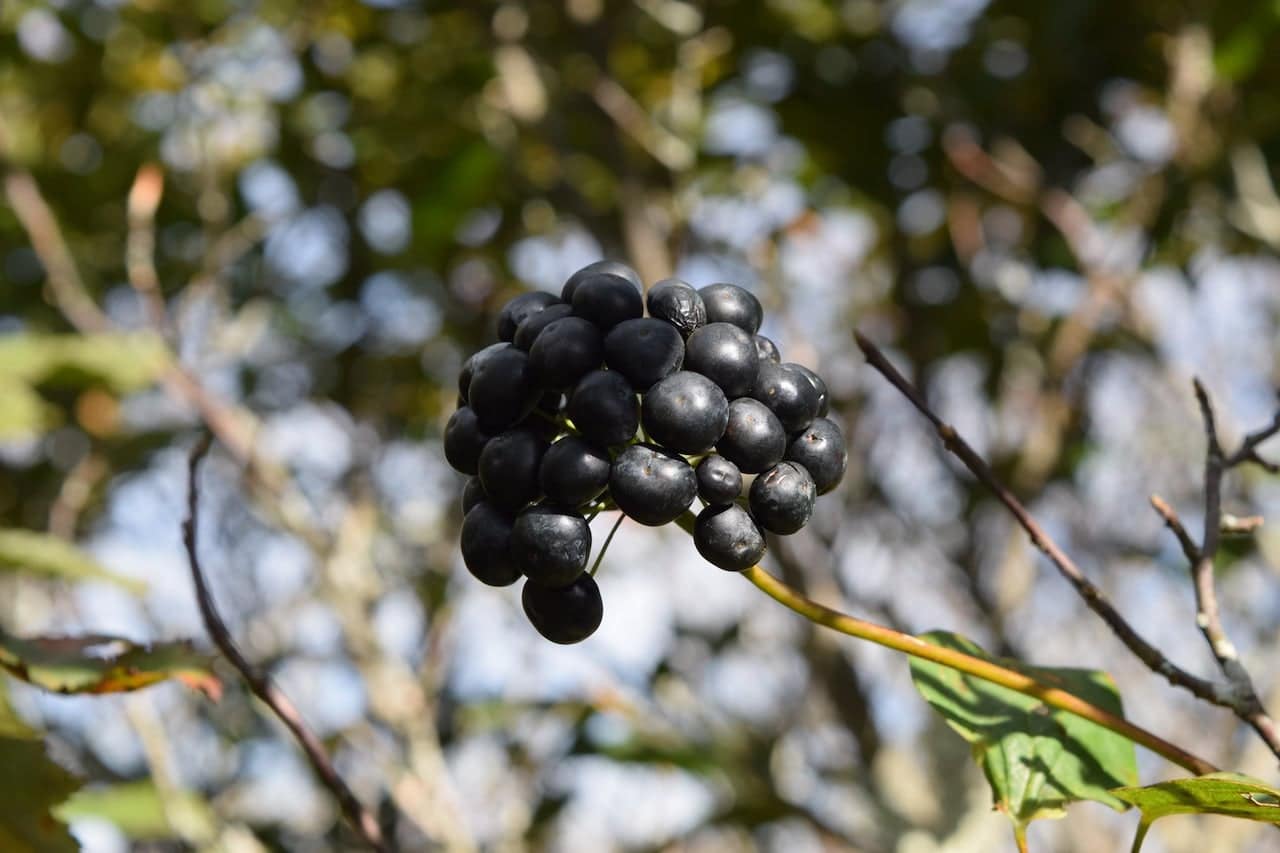
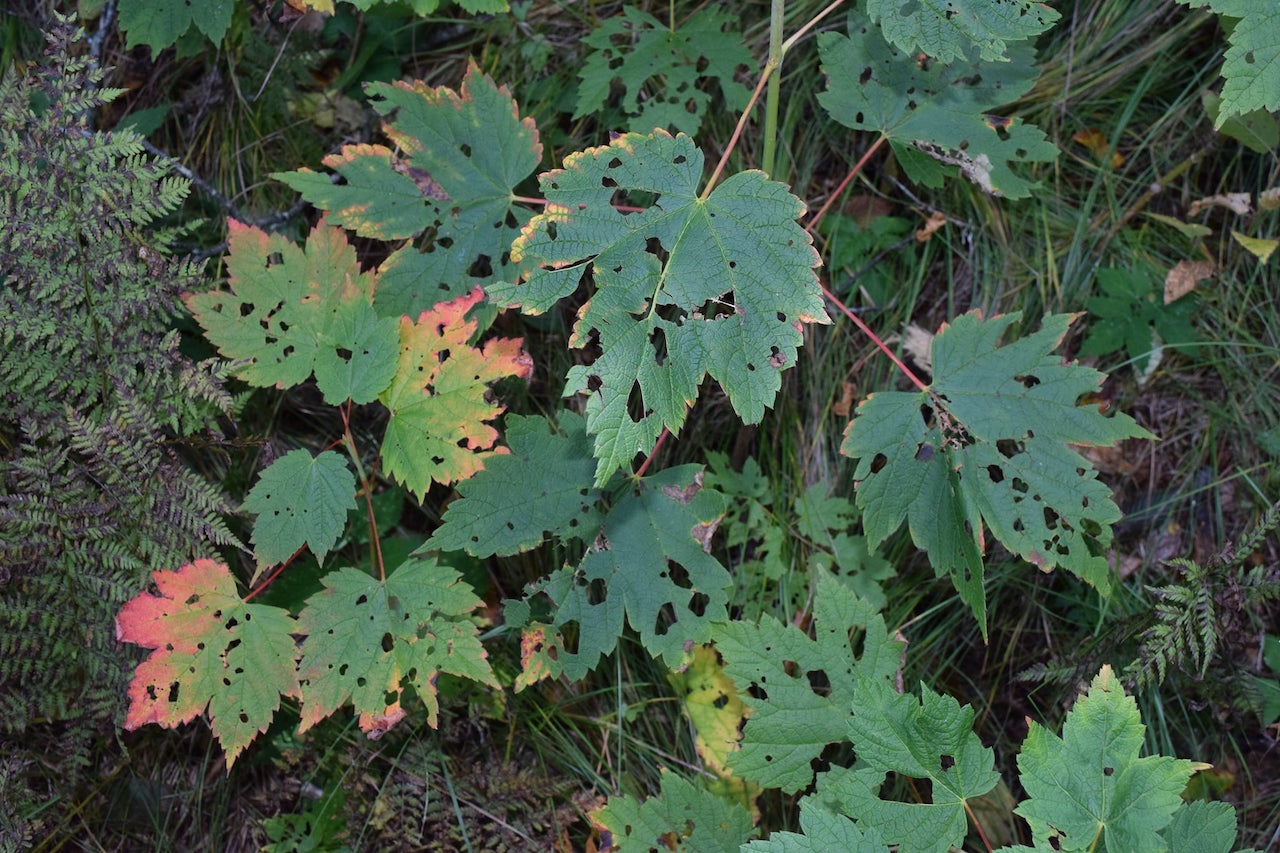
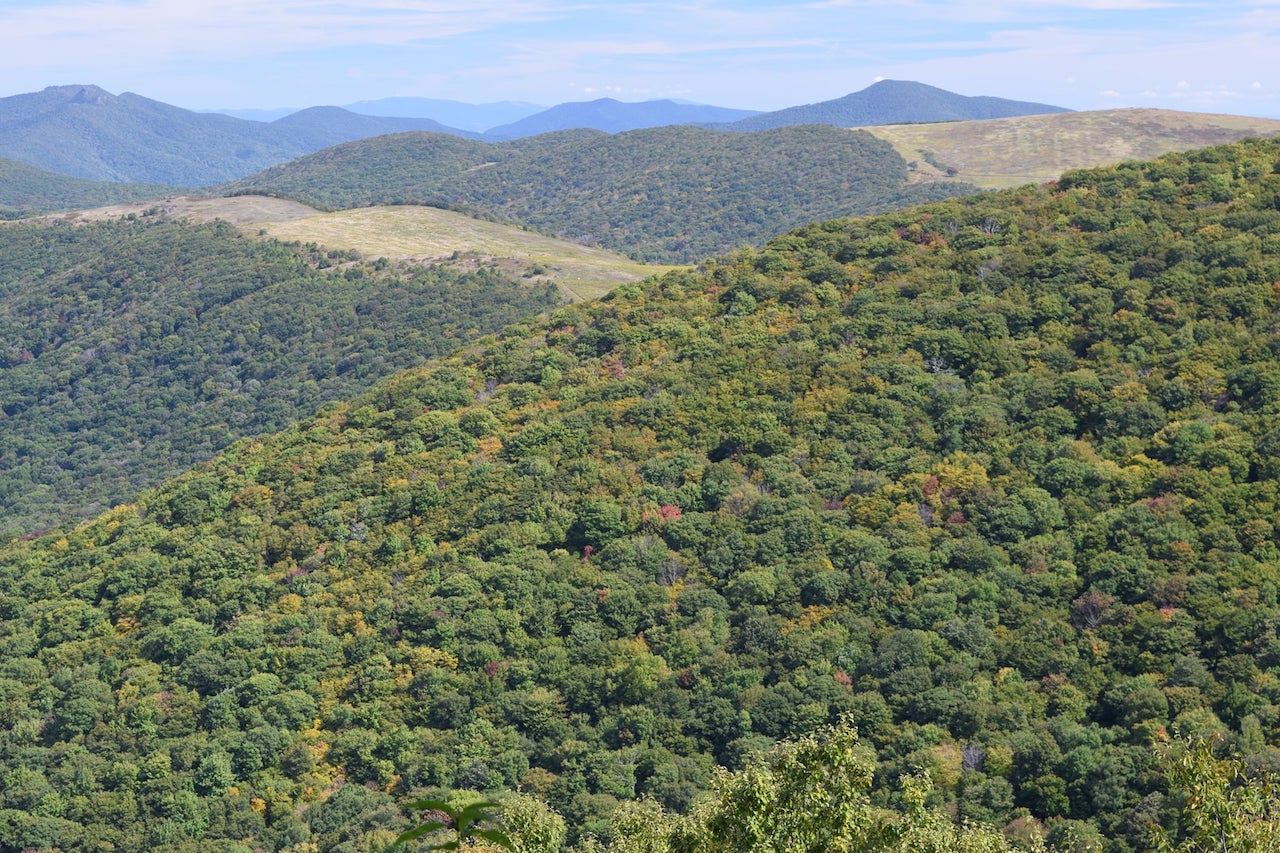
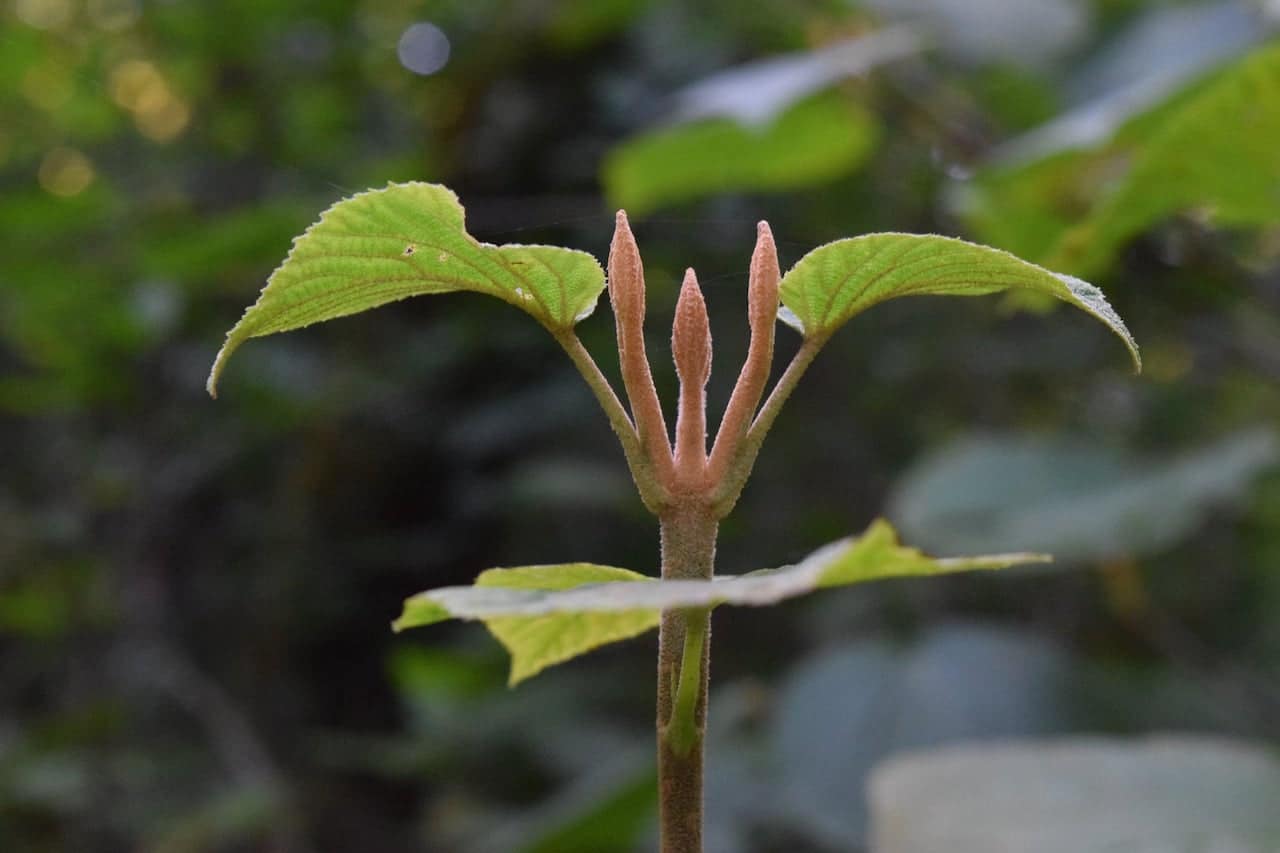
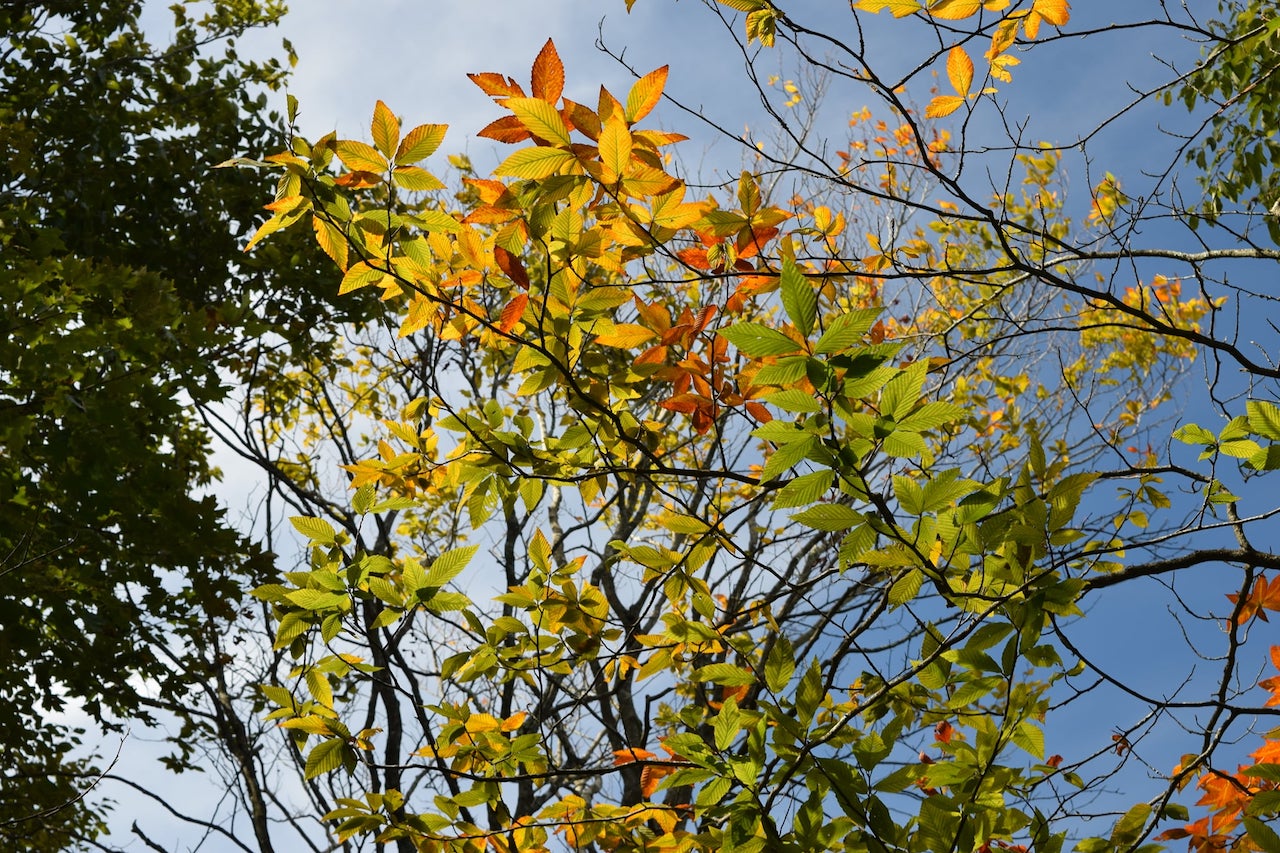
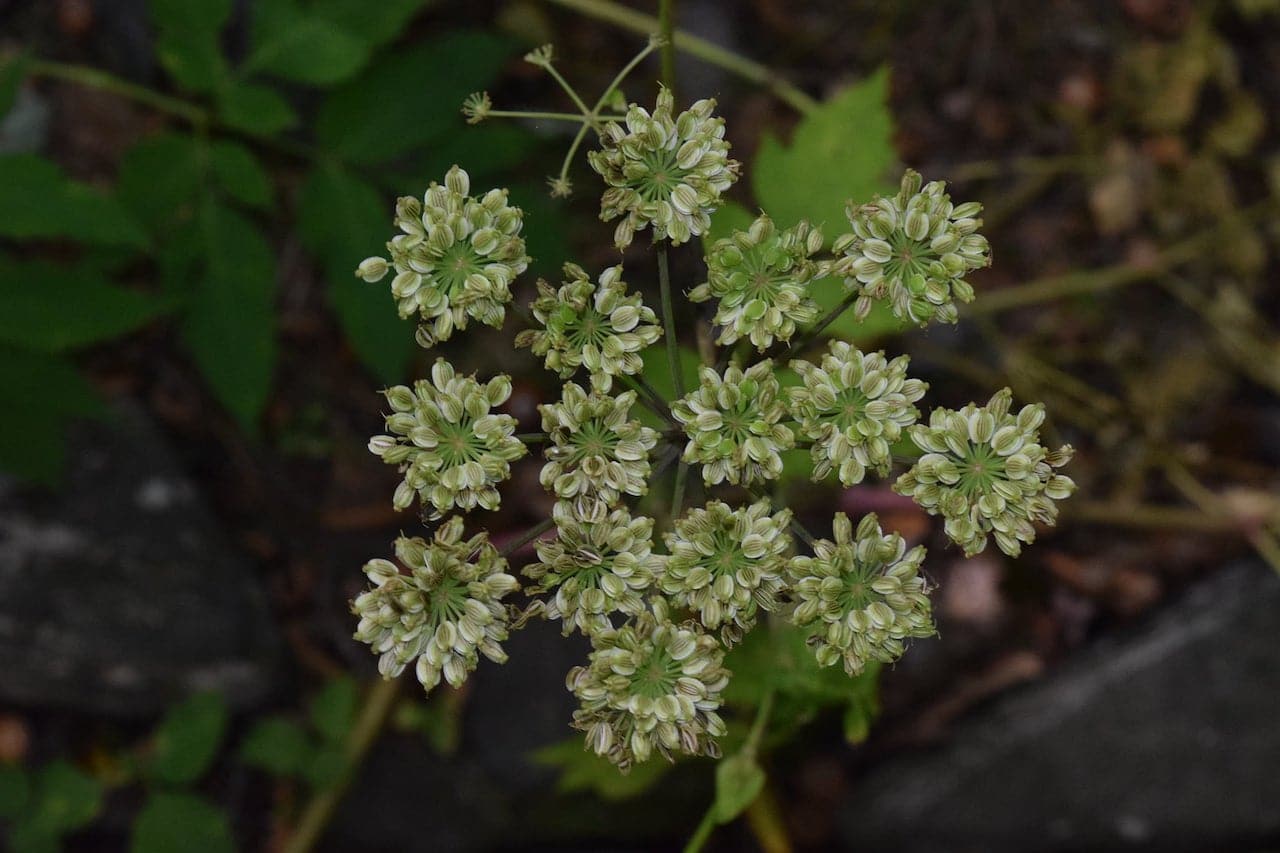
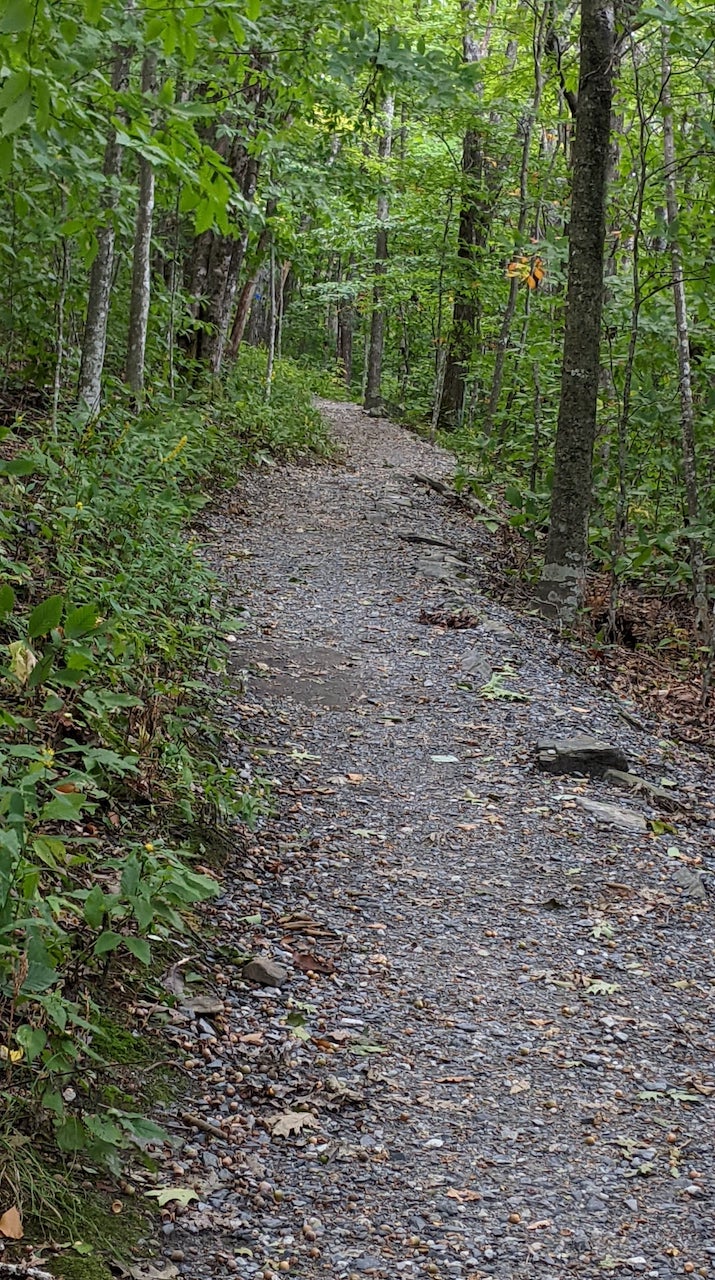
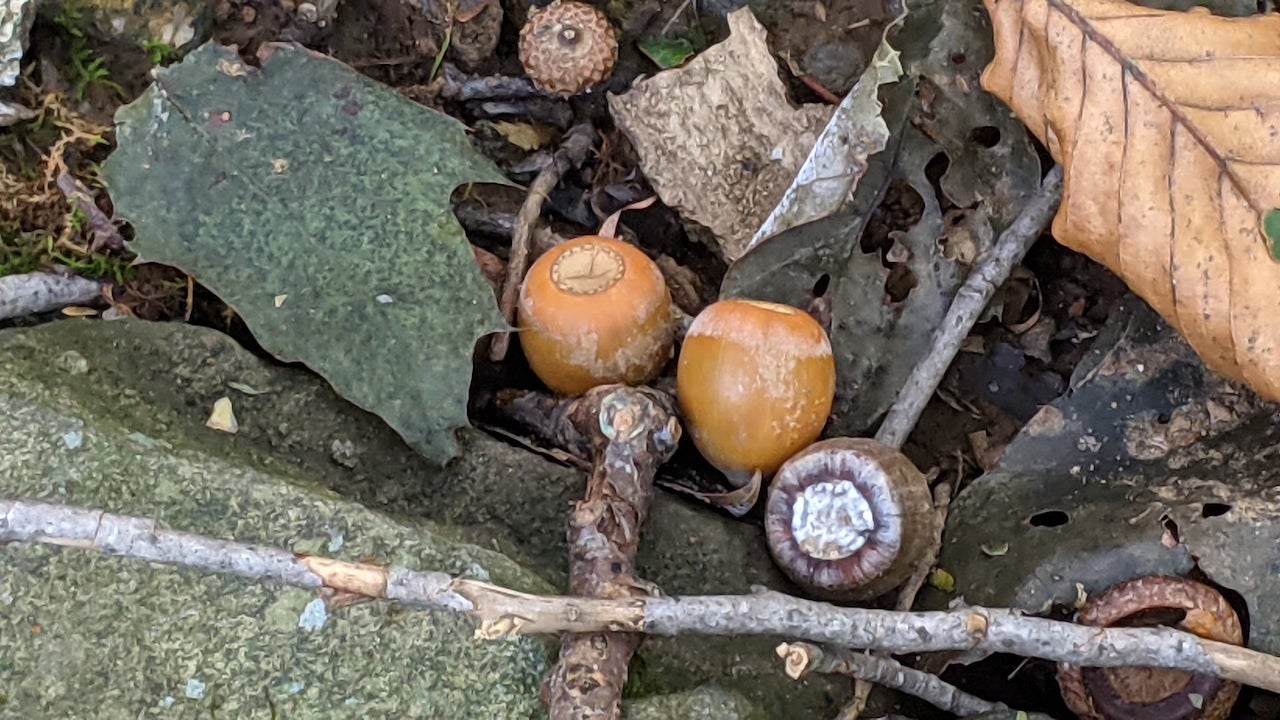
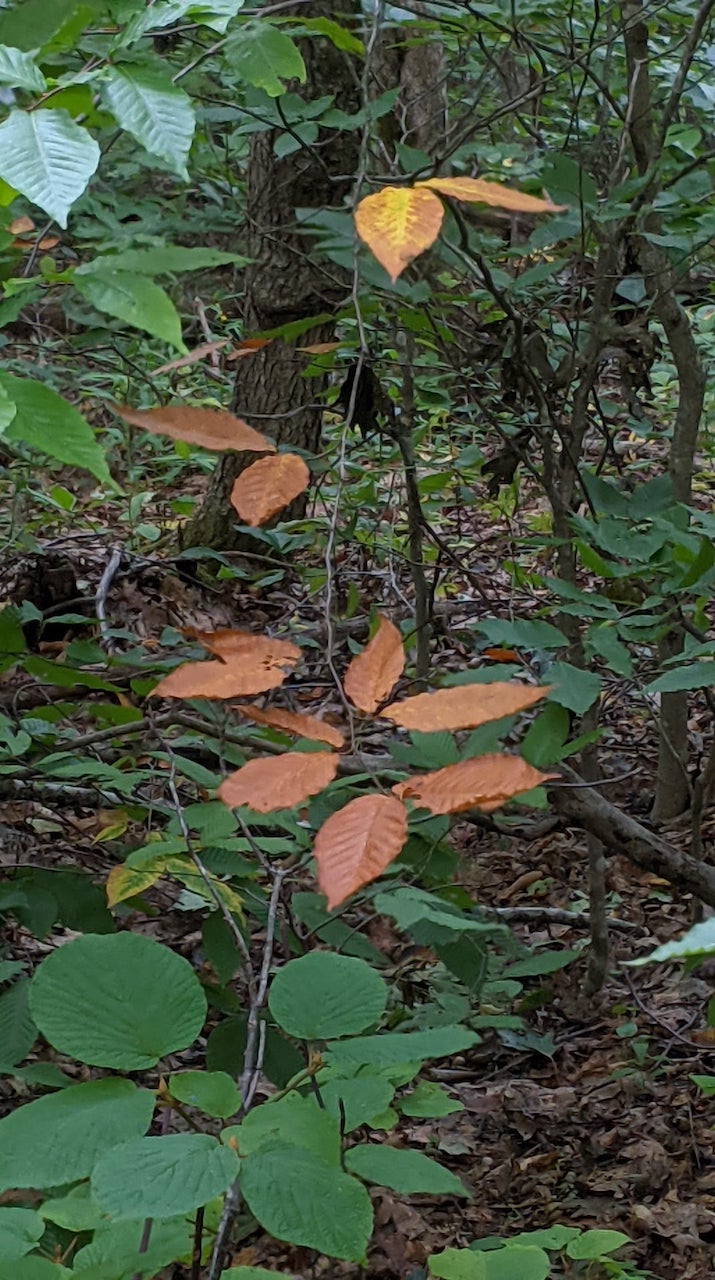
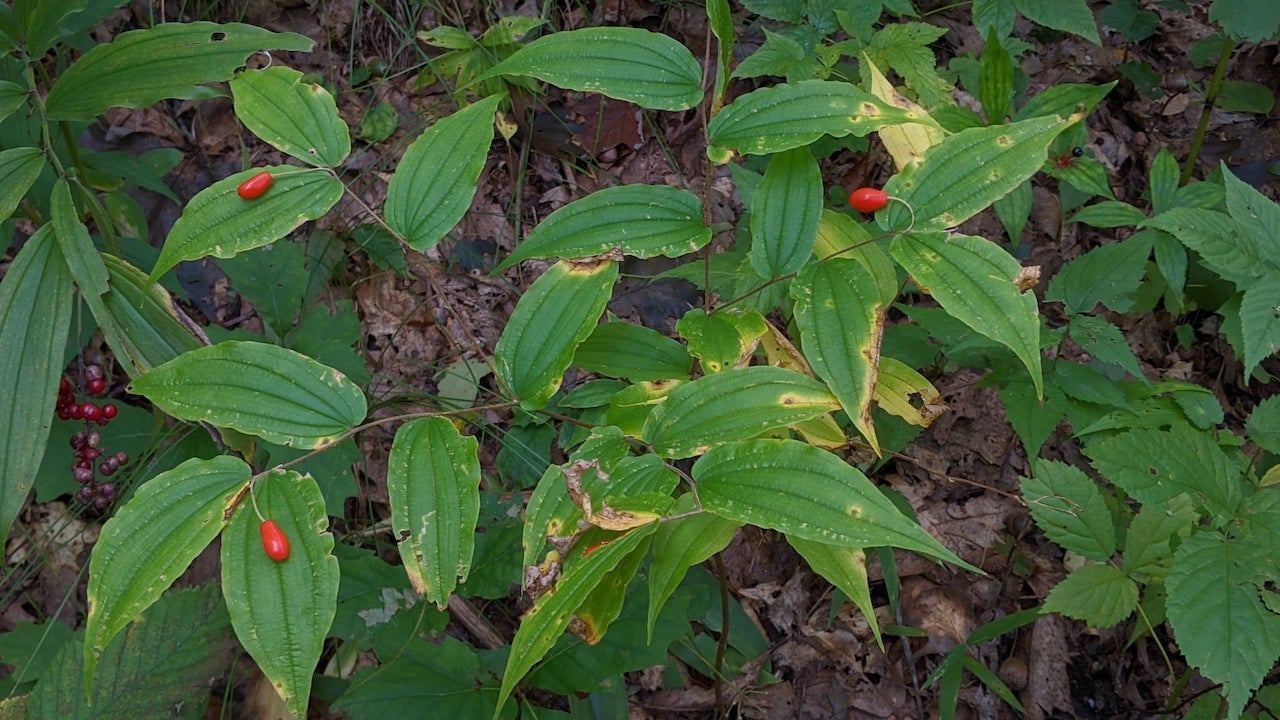
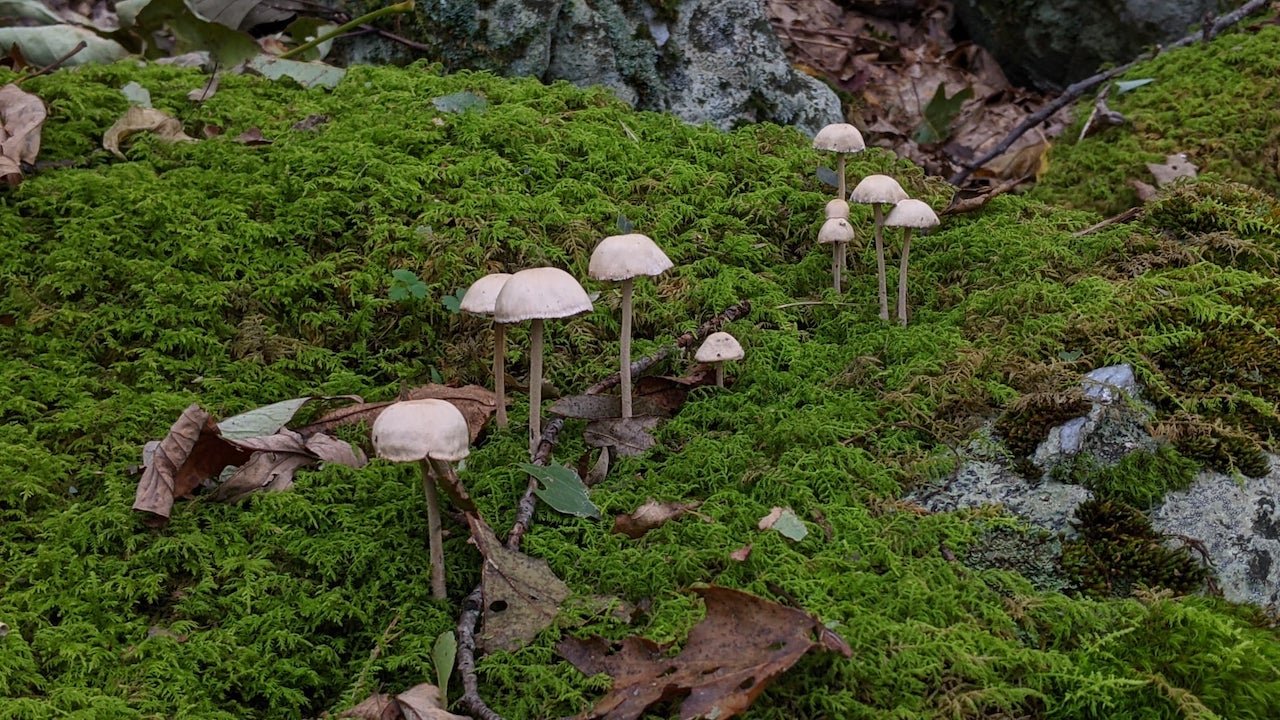
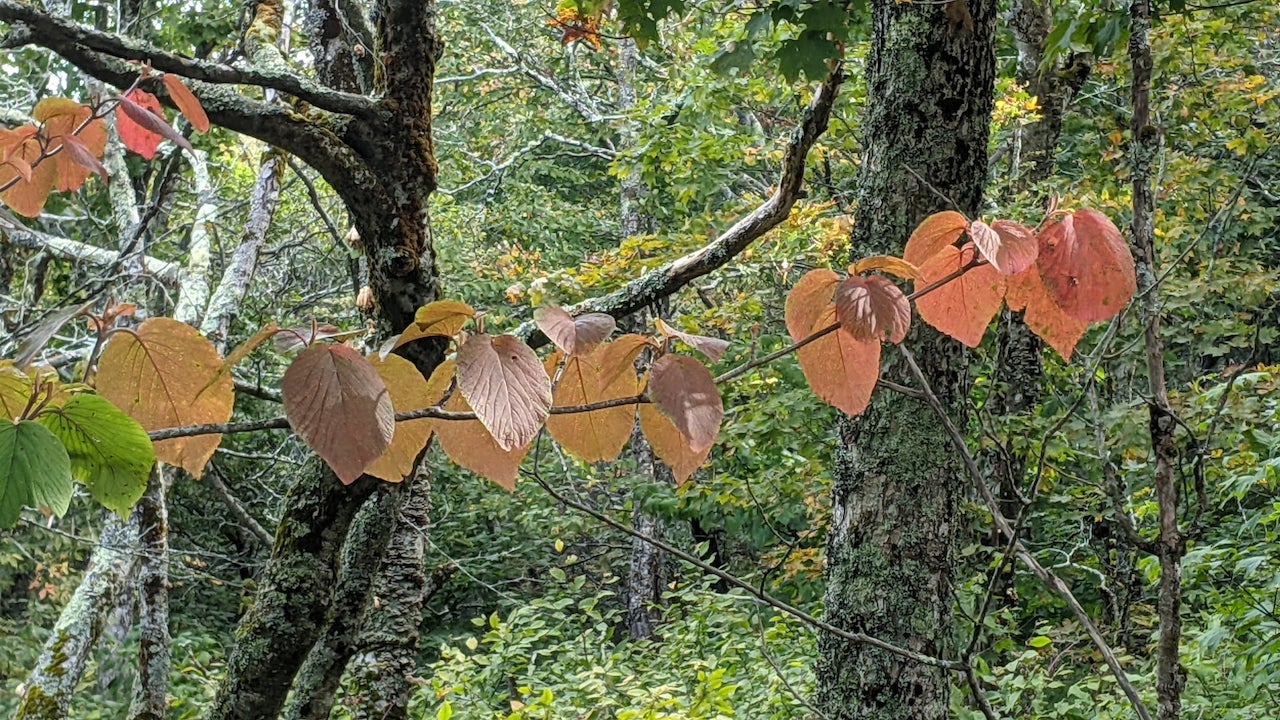
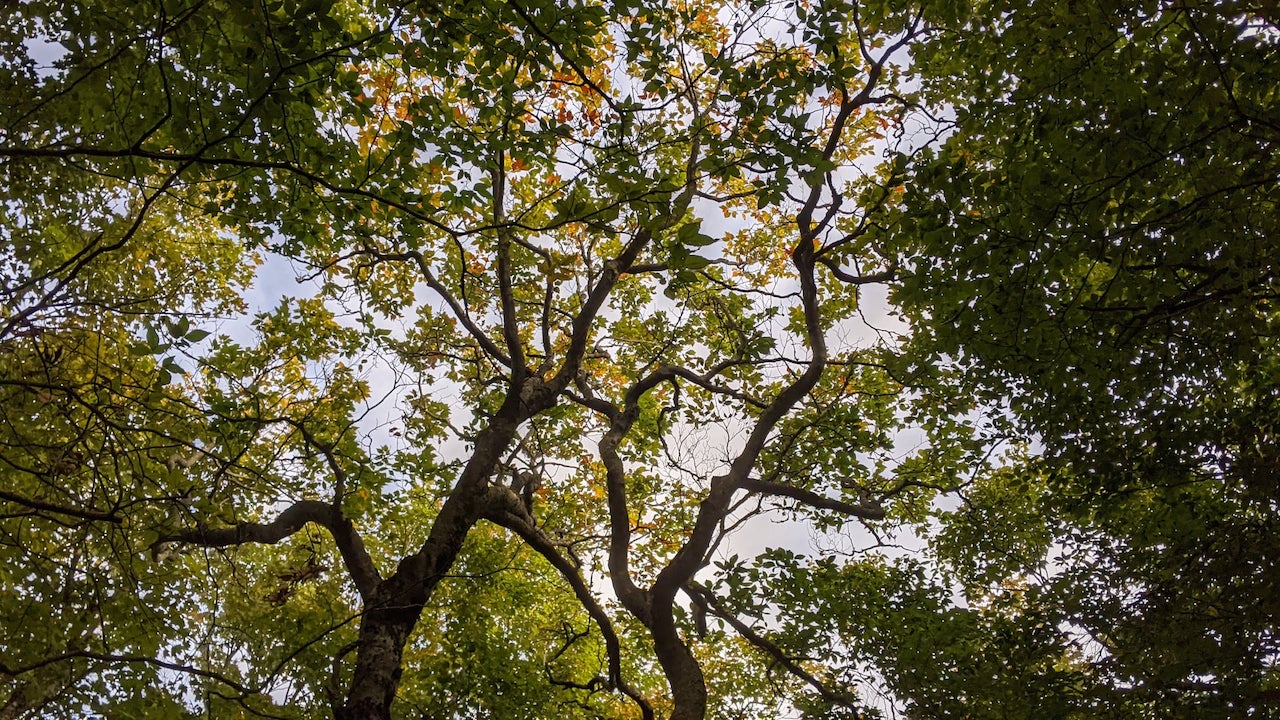
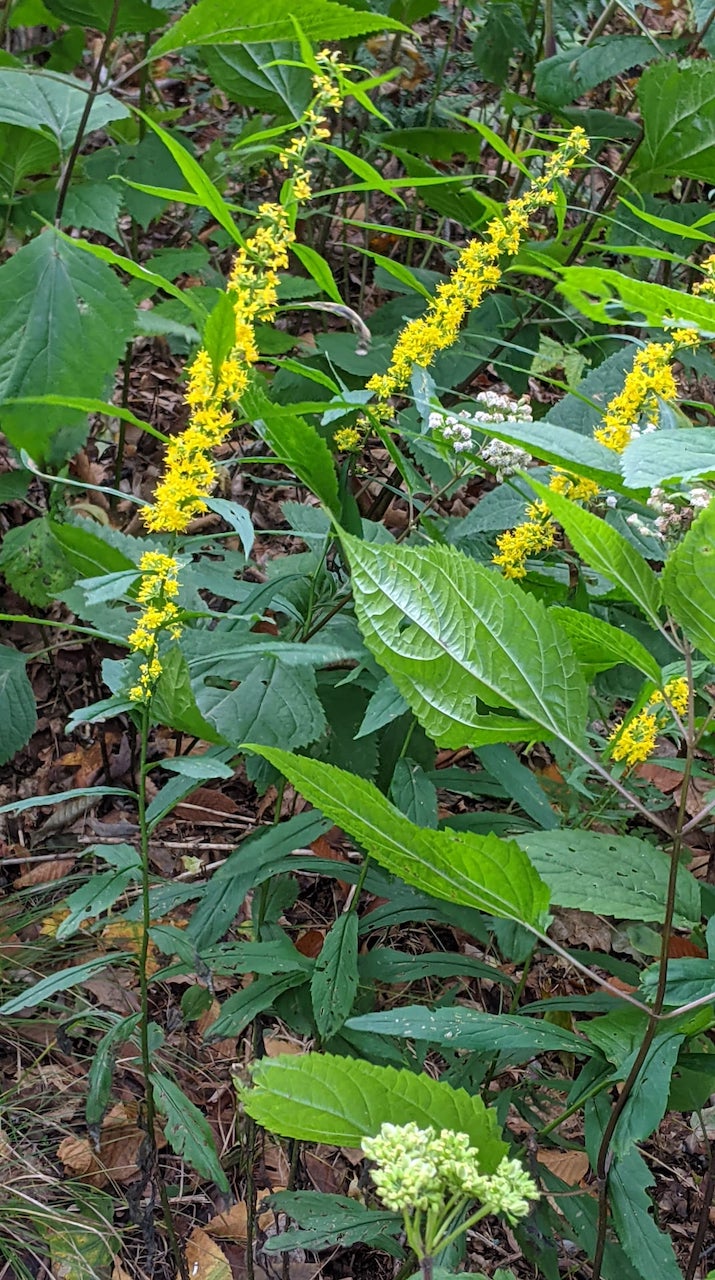
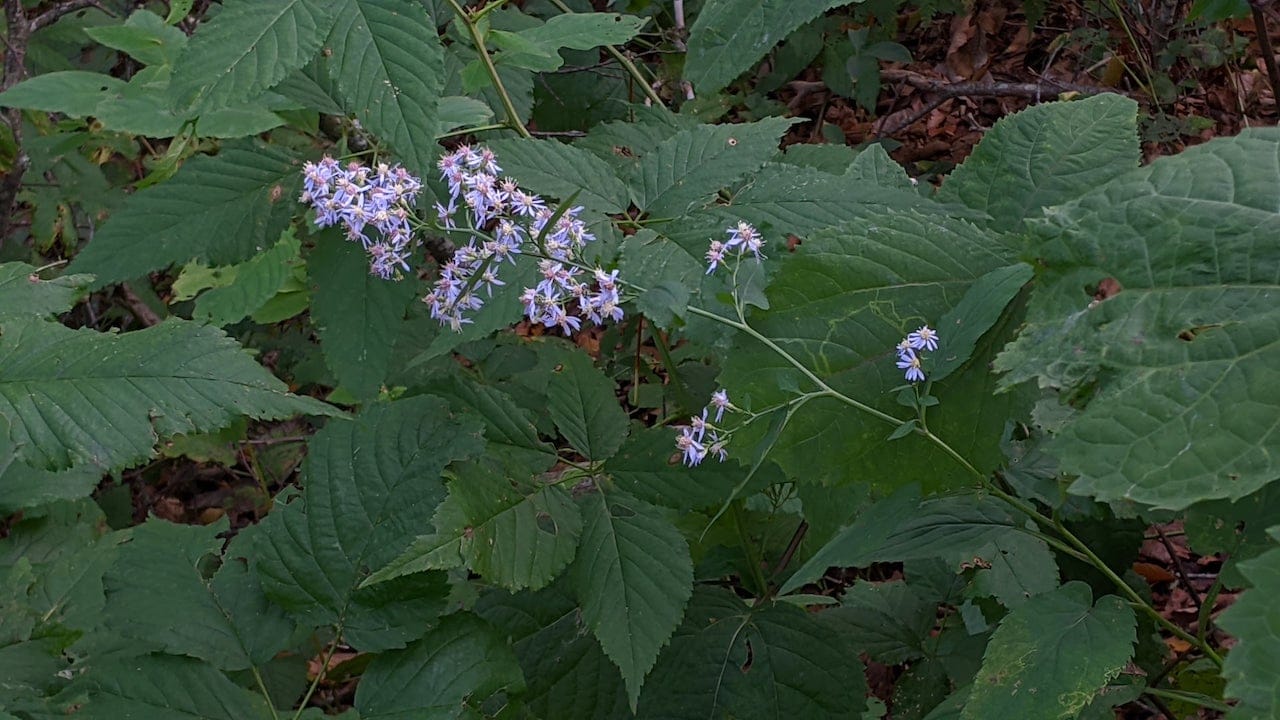
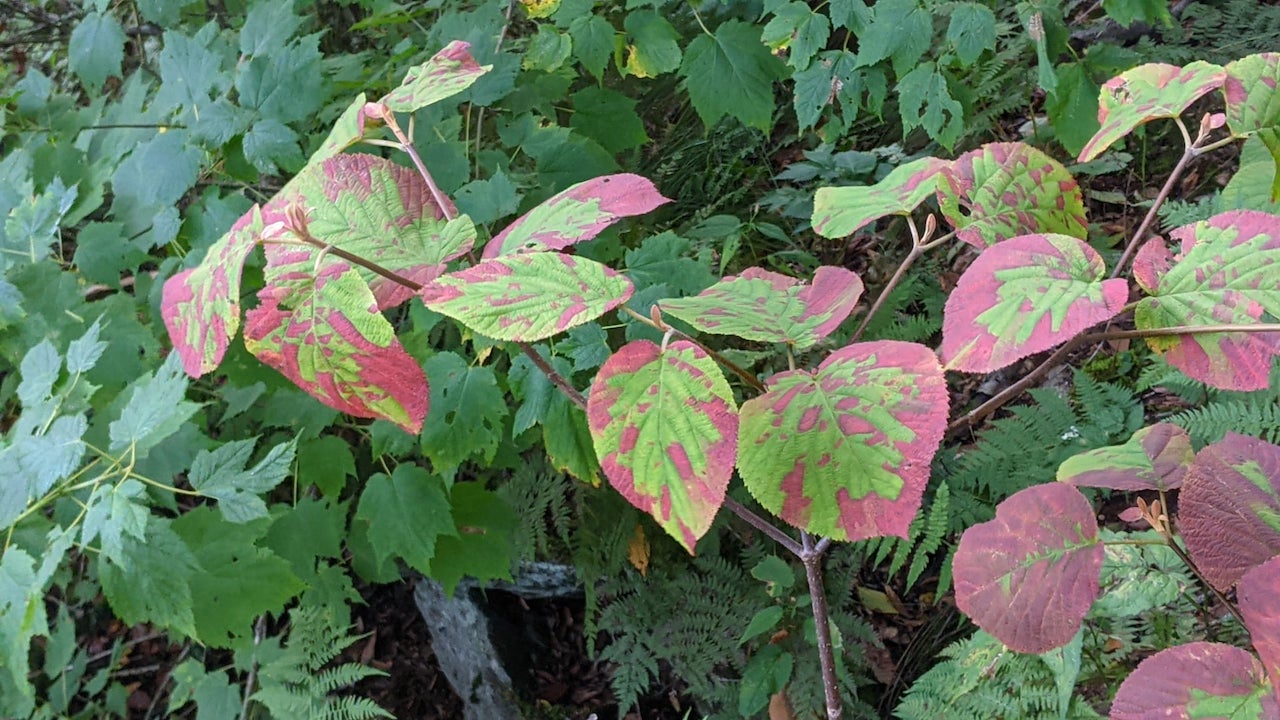
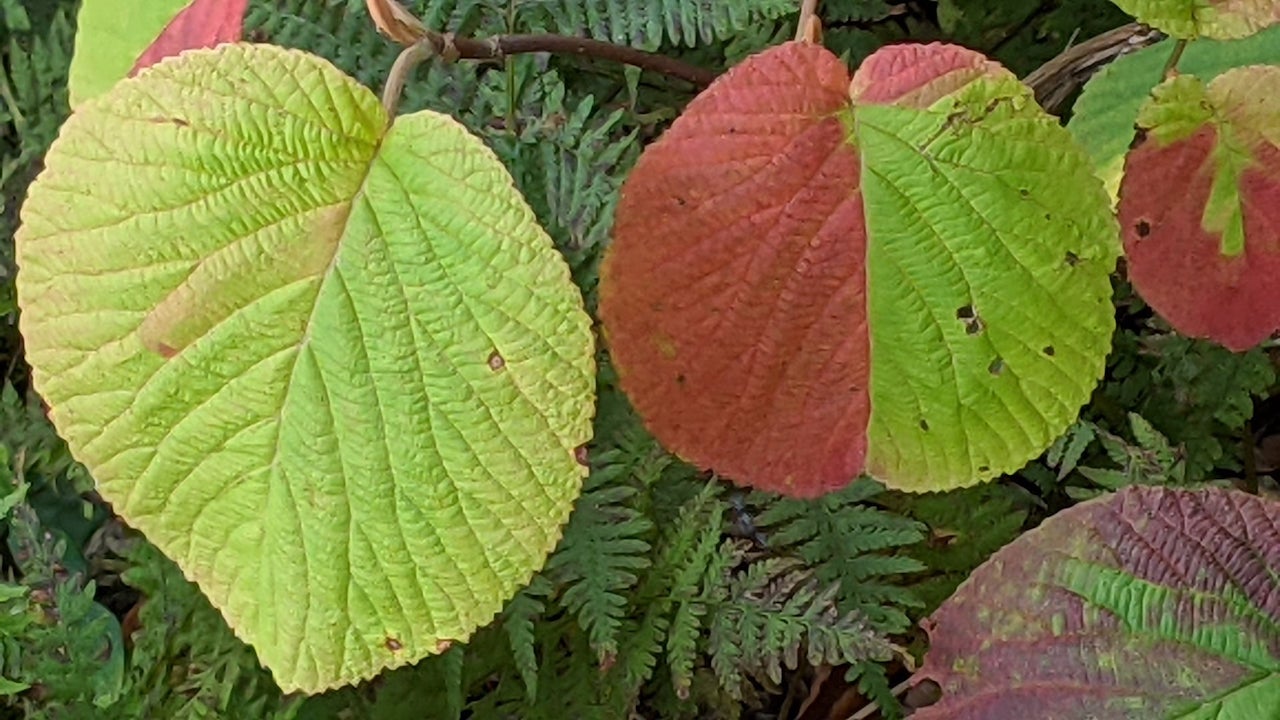
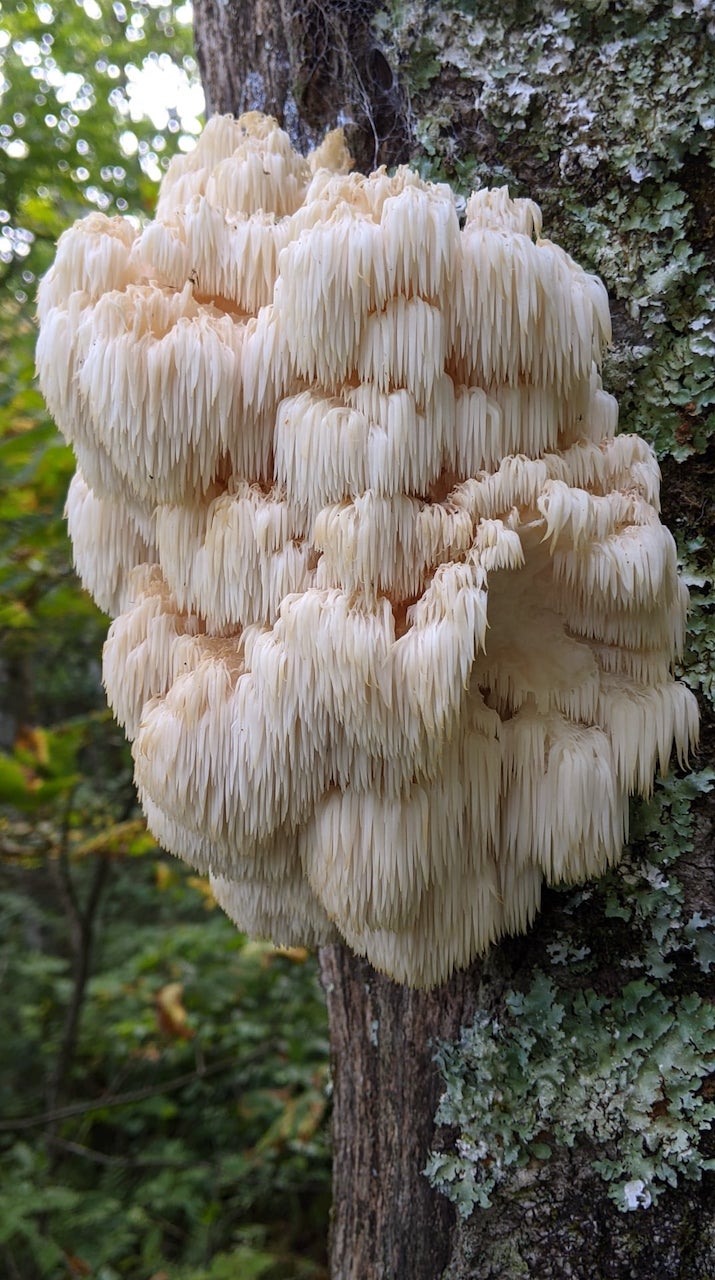
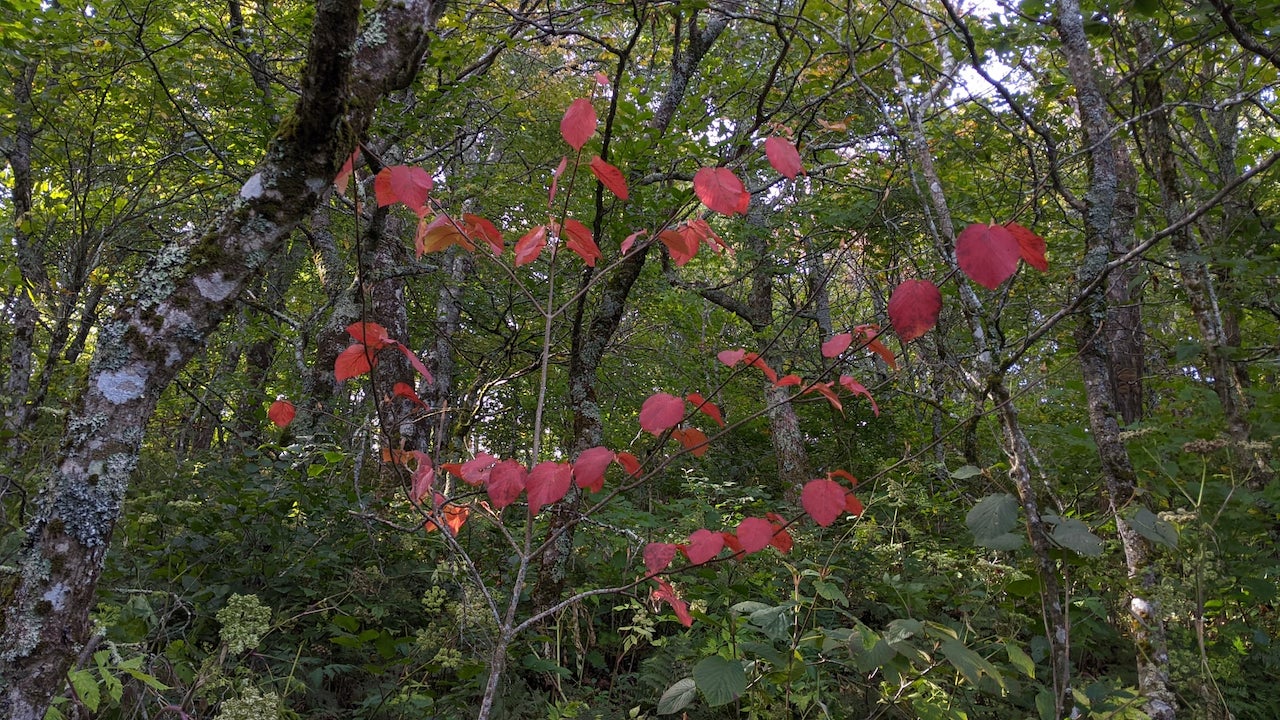
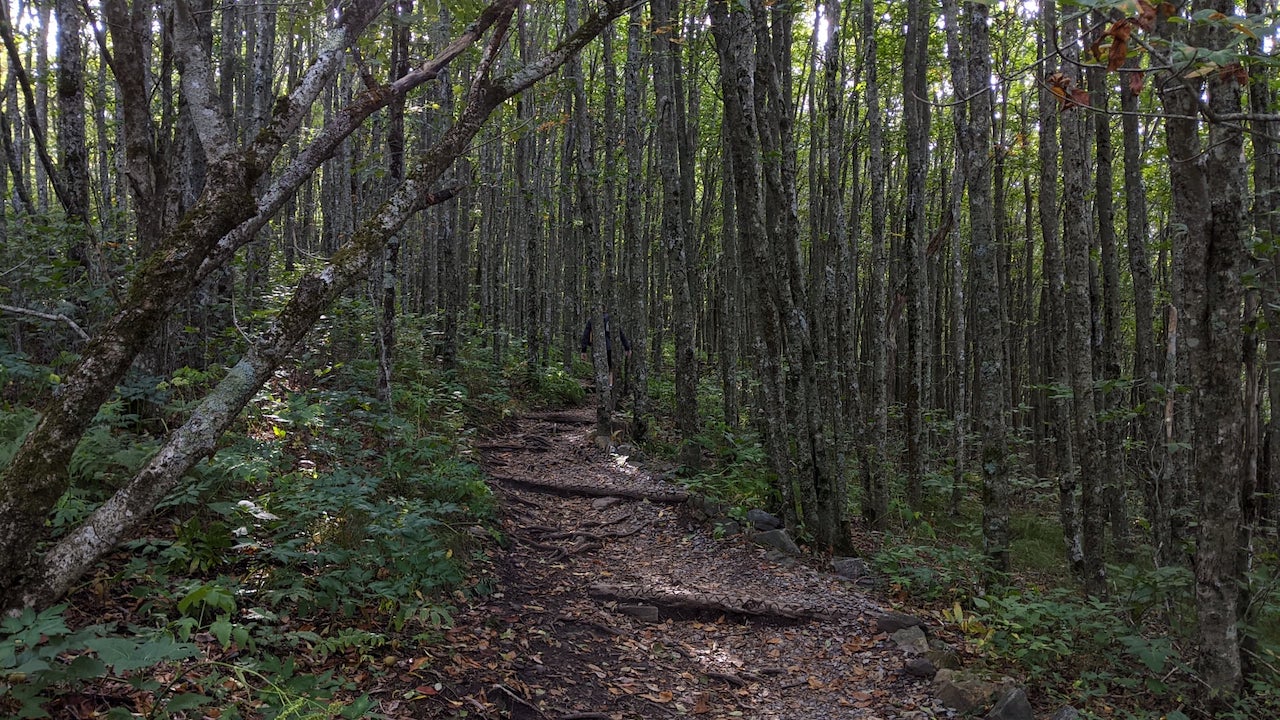
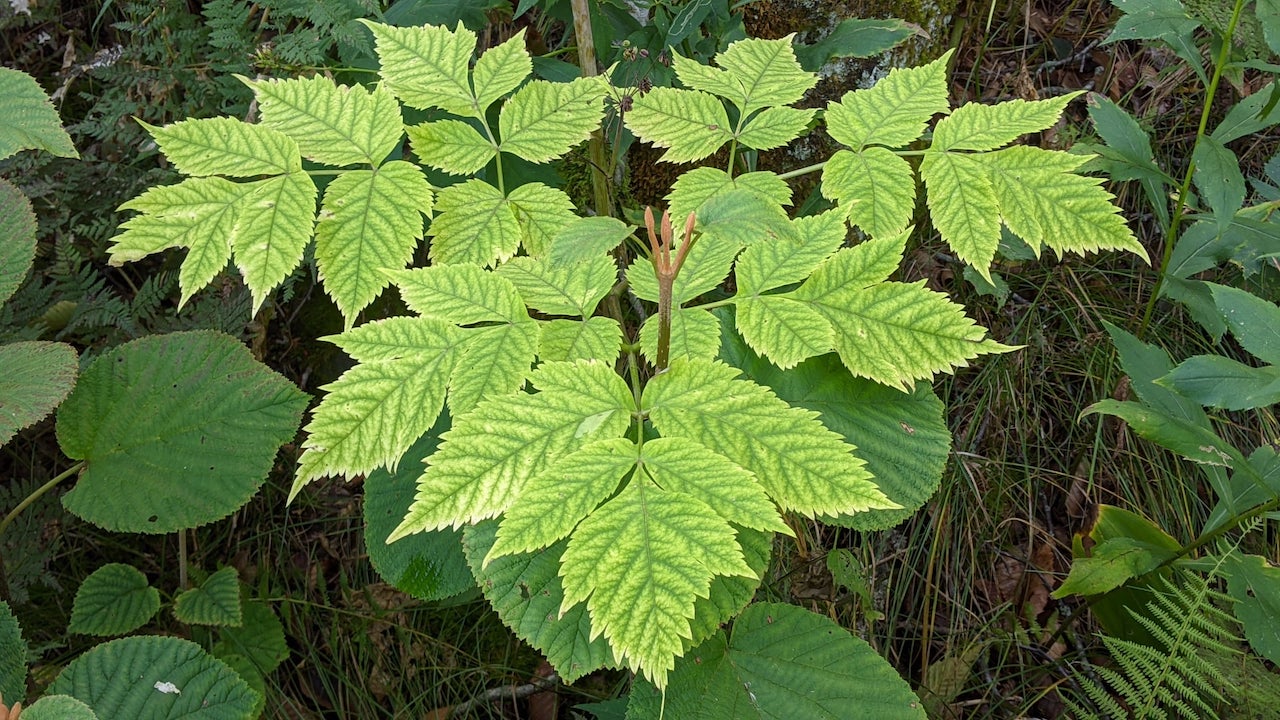
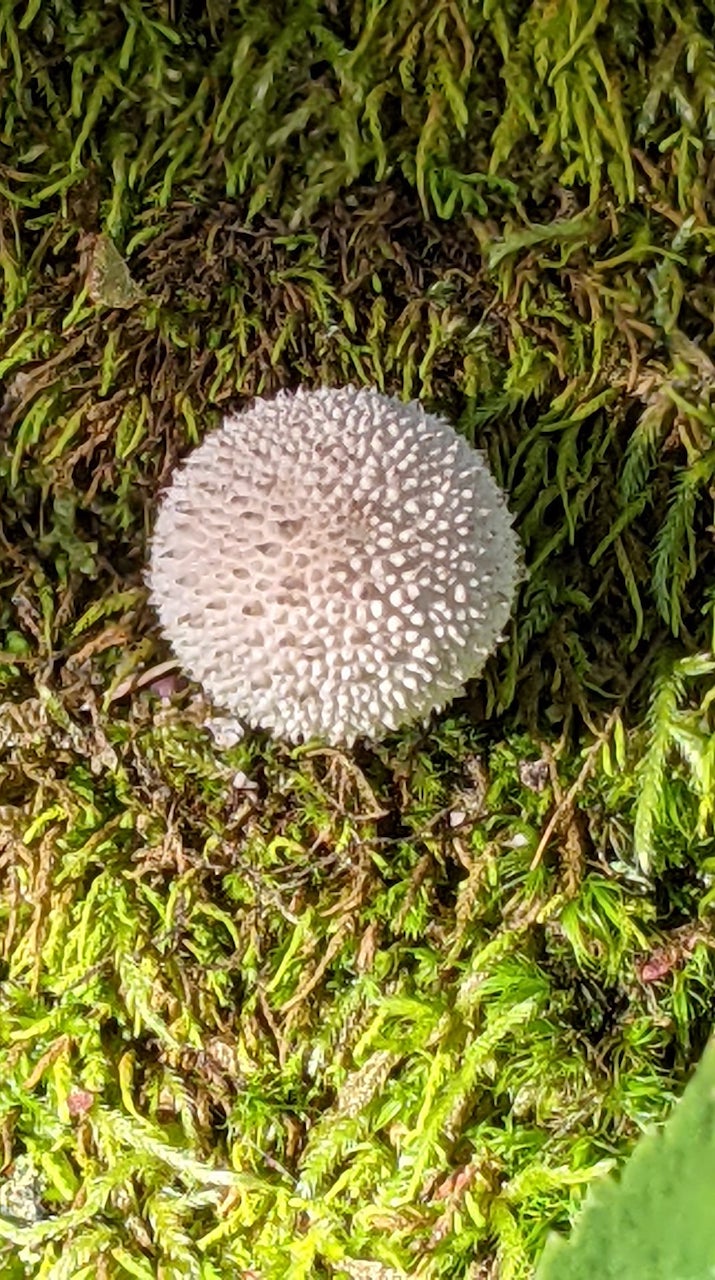
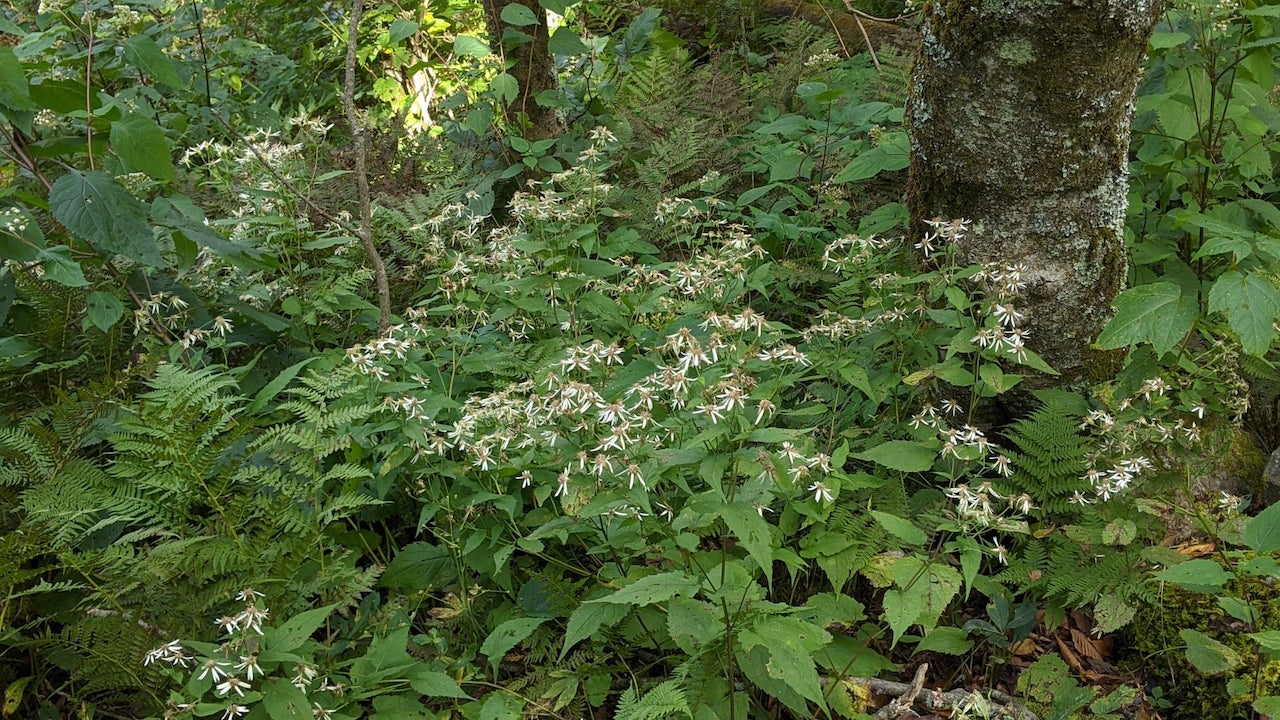
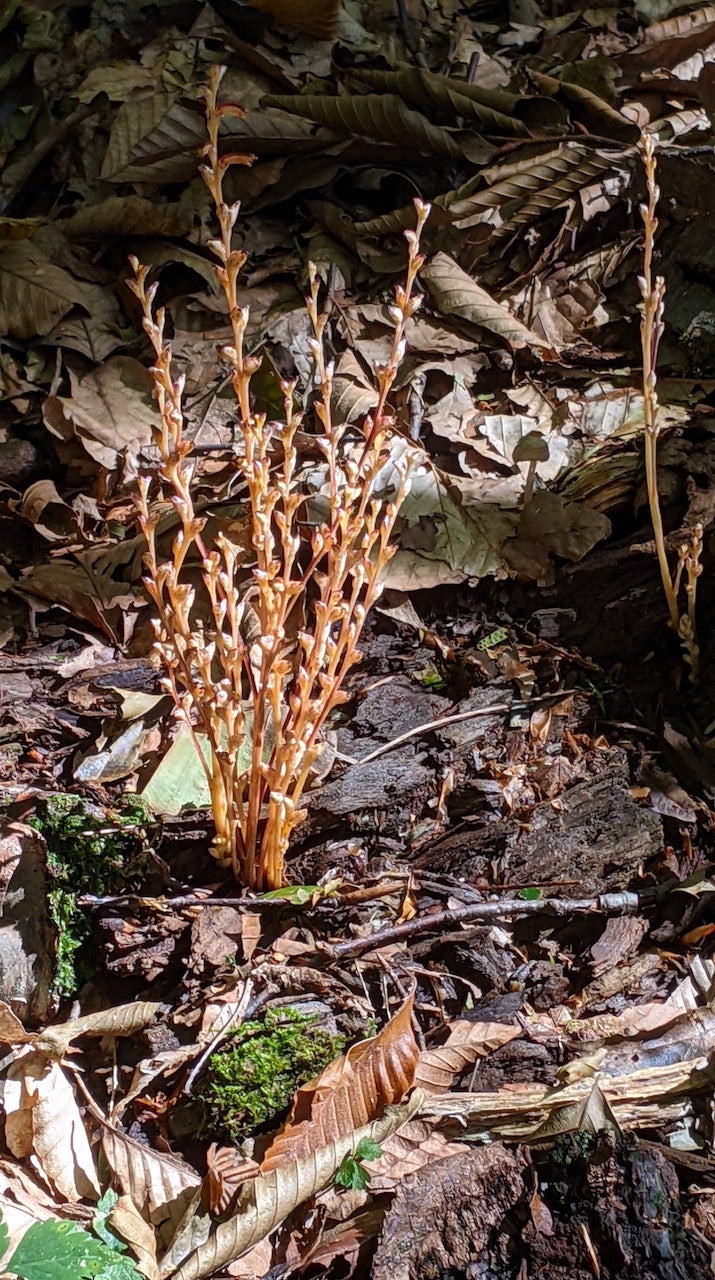
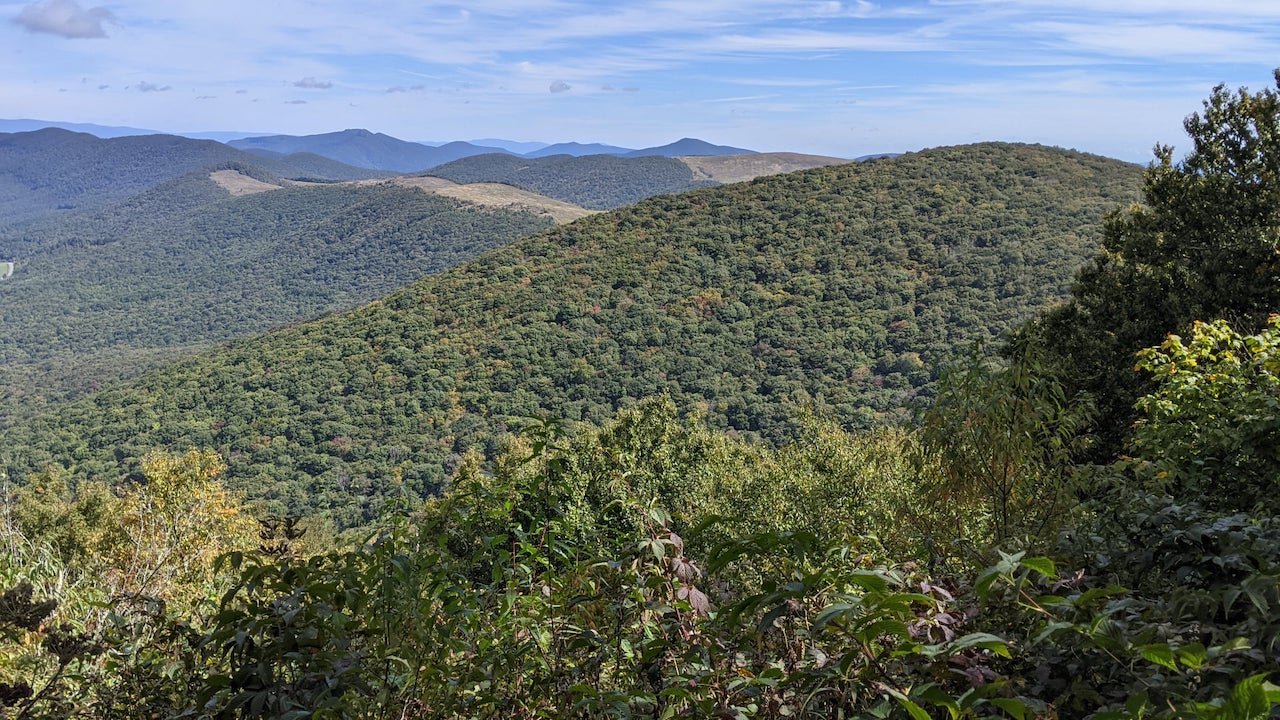
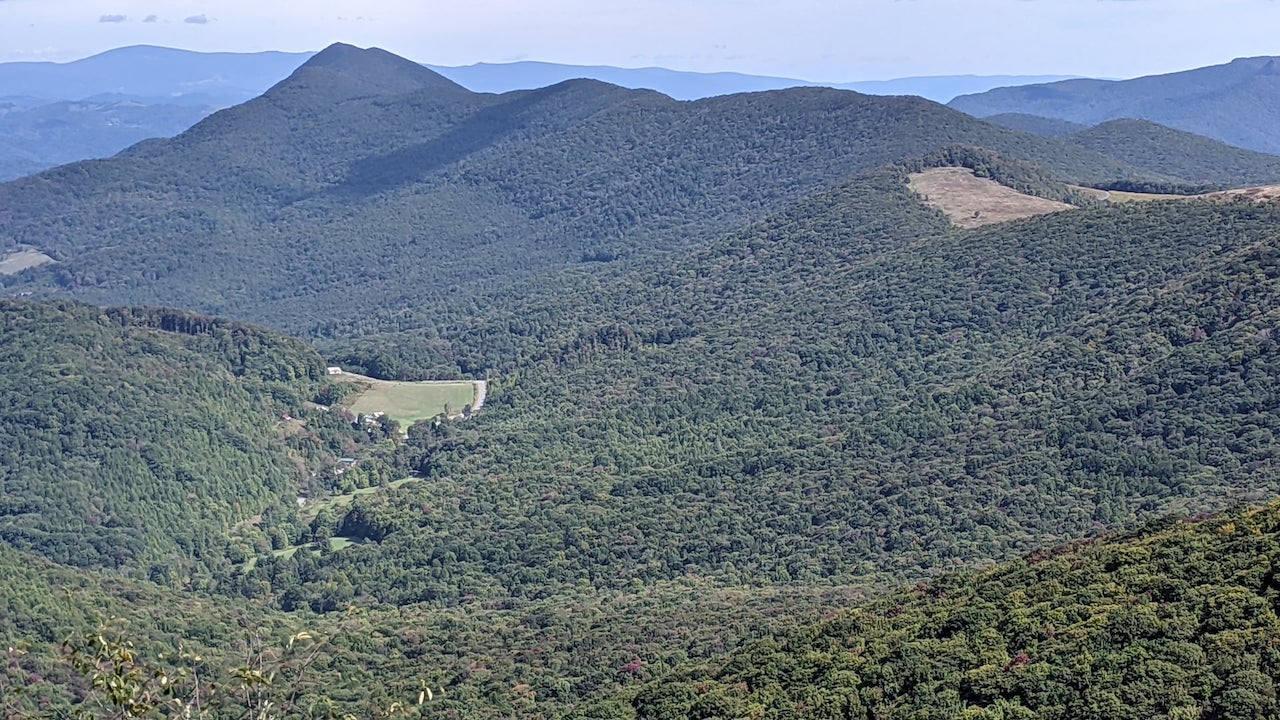
Fall Color Report for Week of September 12th
The word is: green! Nearly all of the western mountains are still quite green. There is a hint of color on the way, with red and sugar maples starting to show some color on isolated branches and branch tips. Dogwoods have been turning red since mid-August, and sourwoods are coloring up now. Pin cherry (Prunus pensylvanica) leaves are turning a deep orange-red and dropping early now.
This week I ventured up Grandfather Mountain just south of Boone and Blowing Rock. This isolated mountain in the Blue Ridge is the highest in the area, with Mt. Mitchell, about 60 miles south, the highest peak in eastern North America. Since colors turn first at higher elevations, I thought it prudent to scout out what was happening on this peak. The answer: not much yet. A few trees, as noted in the previous paragraph, are turning, but the majority of trees are still quite green. There are many wildflowers blooming right now, so for you wildflower enthusiasts, this is a good time to catch the last of the lot before it gets cold.
The weather has been cooperating lately. We’ve had clear blue skies, cool, crisp mornings, and no rain to speak of. If these conditions keep up through September, then we are heading for a good fall color season. But what happens in the next three weeks is critical. If it is warm and/or rainy, expect the peak colors, especially reds, to be duller and later occurring. If cool and sunny, expect brighter colors that will be on time. On time means between Oct. 10th-20th here in the southern Appalachians of NC. A week earlier at higher elevations, and a week later at lower ones.
Fall Color Report for the Week of August 29th – 2021
We are now about six weeks away from what should be peak fall color along the Blue Ridge Parkway in the Southern Appalachian Mountains, at elevations between 3,000-4,500’. Right now, the forests are mostly still green, although after my excursion today on the Parkway, I did see scattered instances of trees starting to turn color. These trees seem ahead of schedule compared to past years, but I don’t think fall color will be unusually early this year.
I drove the BRP between Blowing Rock and the Linn Cove Viaduct today. This section is one of the most popular parts of the Parkway, so when we near peak color, you may want to schedule your visit for a weekday and early in the morning, when the crowds are smaller. Also, if you are driving the BRP, you’ll get the best lighting for pictures early in the morning. If you wait until midday, the colors will look washed out, and if you try to take pictures late in the day, you’ll need to face north because the sun will be to the south, and most of the overlooks in this section face south.
So which trees are showing color already? Red maples are turning color now, mostly at the tips of branches. You can see some of this in the attached photos. This was particularly noticeable near Grandfather Mountain and the Linn Cove Viaduct. Mountain Ash trees along the boardwalk on the Rough Ridge Trail have nicely colored berries that currently vary from yellow to orange to red. By October, these will all be bright red, and stand out against the somewhat dull foliage of this tree. Sourwoods are fruiting now (making seeds) which hang down in white sprays over the green leaves. By October, the leaves will have turned a deep red, which will further highlight these white seeds, making this one of the more spectacular trees to see this fall. A few sassafras have begun to exhibit leaf color, and on the same tree one can often find all color of leaves, ranging from green, to yellow, to orange and finally to red. Finally, a few ash trees have just started to turn color. Leaves on these trees become deep purple in color and ash trees are among the first to color up in the fall.
For those new to this site, I’ll be posting weekly updates, usually by Thursday of each week, so you have time to decide if you want to come up for the weekend. So far, we are in good shape with regard to the upcoming fall color season. We are not in a drought situation, we haven’t had unusually extreme temperatures, and the trees are looking good after a fairly mild summer. I predict that if the weather continues to behave (and I have had some long discussions with Mother Nature about this!), we should have an excellent fall color season this year. What happens in mid- to late-September and the first two weeks of October will be crucial. If unusually warm or rainy, expect duller colors and a later peak. If cool and sunny, then expect on-time peak color and brighter colors. For the elevational range between 3,000-4,500’, that would be mid-October. For higher elevations, the first week of October, and below 3,000’, the last week of October. For those in the Piedmont, where you are at 700’ elevation, you can expect colors well into November.
Happy Fall Color Season!
Fall Color Report for the Week of August 8th, 2021
This is the first of my fall color reports for 2021. Of course, starting off in August there isn’t a lot of color development yet, but there are some isolated cases among urban trees, which always begin changing color before trees in the woods. In particular, urban red maples, dogwoods and sourwoods, as well as some stressed sugar maples are coloring up now, but don’t panic, as the major fall color display will still occur in mid-October.
My graduate student, Claire Martin, is studying how urban red maples, including the Armstrong and Autumn Blaze cultivars, develop their fall colors, especially with regard to where in the canopy colors first appear. For the Armstrong cultivar, past years indicate that color develops all over the canopy at approximately the same time, whereas for the Autumn Blaze cultivar, there is distinct development in the upper canopy first, with lower leaves coloring up afterwards. We are trying to figure out why this cultivar does that and whether it is because the weather is different in the upper crown, or the leaves differ there, or both. In the attached photograph, you can see Claire taking measurements of photosynthesis in a bucket truck some 25 feet up a red maple. The Autumn Blaze cultivar started showing red leaves the first week in August, which is somewhat early, if I recall past years correctly.
I’ve seen sourwood trees starting to turn color this week, and dogwoods have been turning since mid-July. They develop their fall colors slowly and incrementally over a 6-8 week period. I’ve included a progression of color development for the dogwood trees that are growing across the road from my house.
Another of my students, Bubba Pfeffer, who recently graduated from Appalachian State University, has been digitizing images of trees to learn more about their phenology (the science of when organisms go through distinct phases of their life cycle, such as leafing out, coloring, and dropping leaves). We have a camera that takes digital images of the same forest every day and we have now accumulated five years of data. Bubba is in the process of analyzing when the trees green up and when they lose leaves, and how long the fall color periods last. We have found some differences among the years in the timing of these events and we are now trying to figure out what aspects of the weather have the most influence on them. Once we’re done we’ll post our results for you to see.
Finally, a New York Times article allows readers to find out how many days of the year the temperature gets above 90 degrees Fahrenheit, from 1960 to 2018. In 1960, Boone averaged only 3 days over 90 degrees, but the trend over the past 58 years has been inexorably upward to the point that we now average 9 days over 90 degrees each year, a three-fold increase. That is alarming, but goes along with the dire predictions just released this week by the International Governmental Panel on Climate Change (IPCC), which unequivocally states that human activities have warmed the Earth and that unless actions are taken immediately, we will have no chance to avoid significant warming in the future, often to levels that will have catastrophic effects on countries.
It is definitely a wake-up call. I mention this because warming is the single most important variable affecting fall leaf color displays, both with regards to timing and intensity. Warmer years result in delayed onset of color, as well as a reduced intensity of color, particularly the reds, and will diminish the quality of the display compared to past years. Last year was a throwback to earlier years in that the colors were back on time (mid-October) and they were vibrant and quite beautiful.
So far this year, the weather in the High Country has been fairly mild, with no long-term dry periods and there is lush tree growth everywhere. The first week of August this year we had morning temperatures in the low 50s and highs only in the mid-70s, which is quite remarkable. It will be warmer this week, but if this trend continues into the fall, we should be setting up for a good fall color season. What happens in September will be crucial!
So, welcome back. I hope everyone has had a good summer. Schools have already started and others will be back in the next few weeks. It’s super busy here in Boone as the students are now moving into the dorms and off-campus apartments. Classes start here on Monday, August 16th. If you’re coming to the High Country, most trails and roads are fully open. To avoid the crowds, get out early or come during the middle of the week. If you want to go to Grandfather Mountain be aware that you need to make reservations online first.
Ciao!
August 11, 2021 from Dr. Neufeld – A sugar maple on the Appalachian State University campus coloring up quite early. I think this is partly due to the stress of growing in this particular location and the fact that this tree may have a more northerly origin. When such trees are planted in the south, they turn colors earlier than the same species that is indigenous to the area. The shorter daylengths fool the northern tree into thinking it is later in the fall than it really is. This means they are not cueing in on temperature, but rather, on daylength.
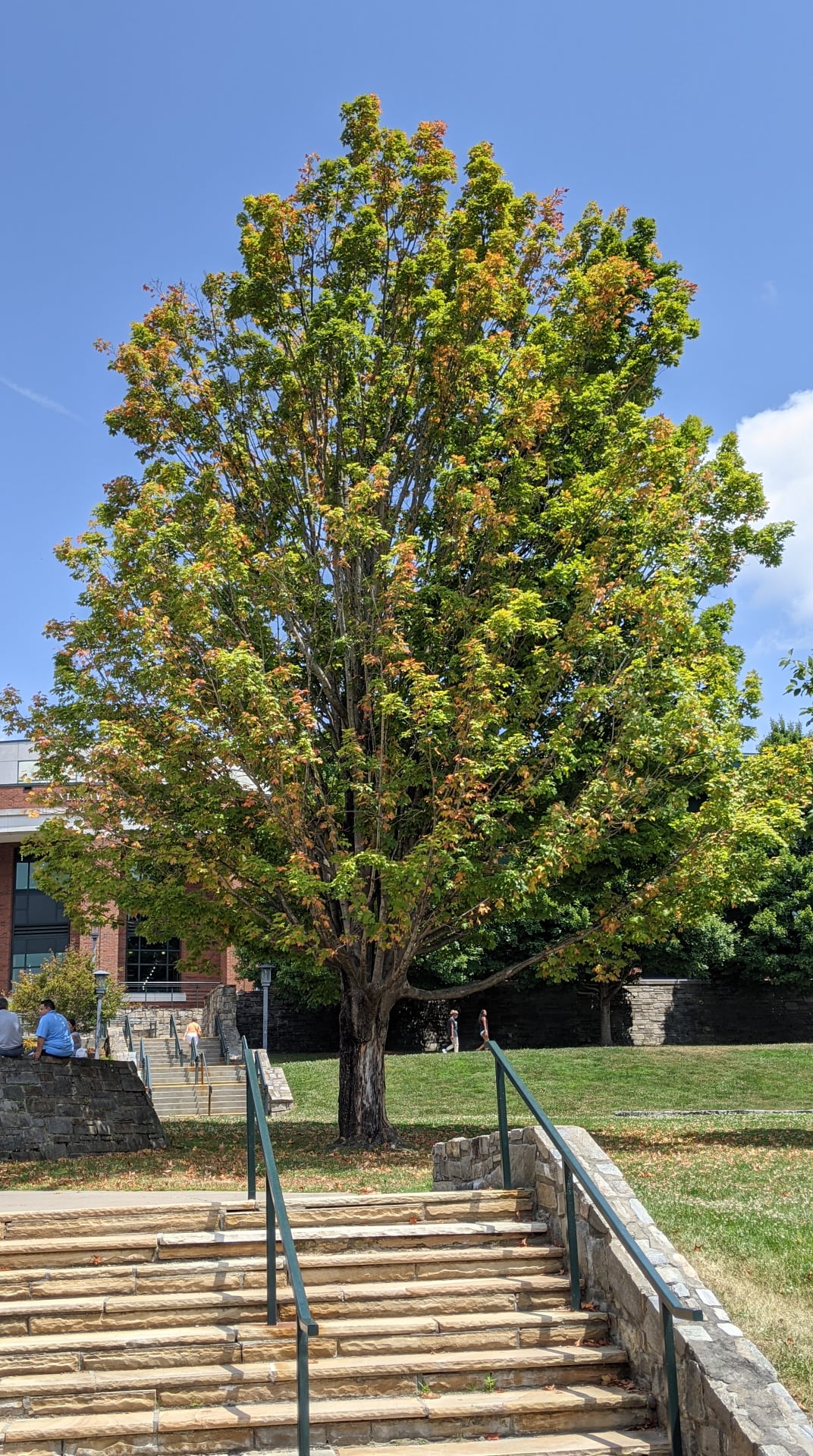
August 11, 2021 from Dr. Neufeld – The progression of color change from May to Aug for flowering dogwoods in Vilas, NC.
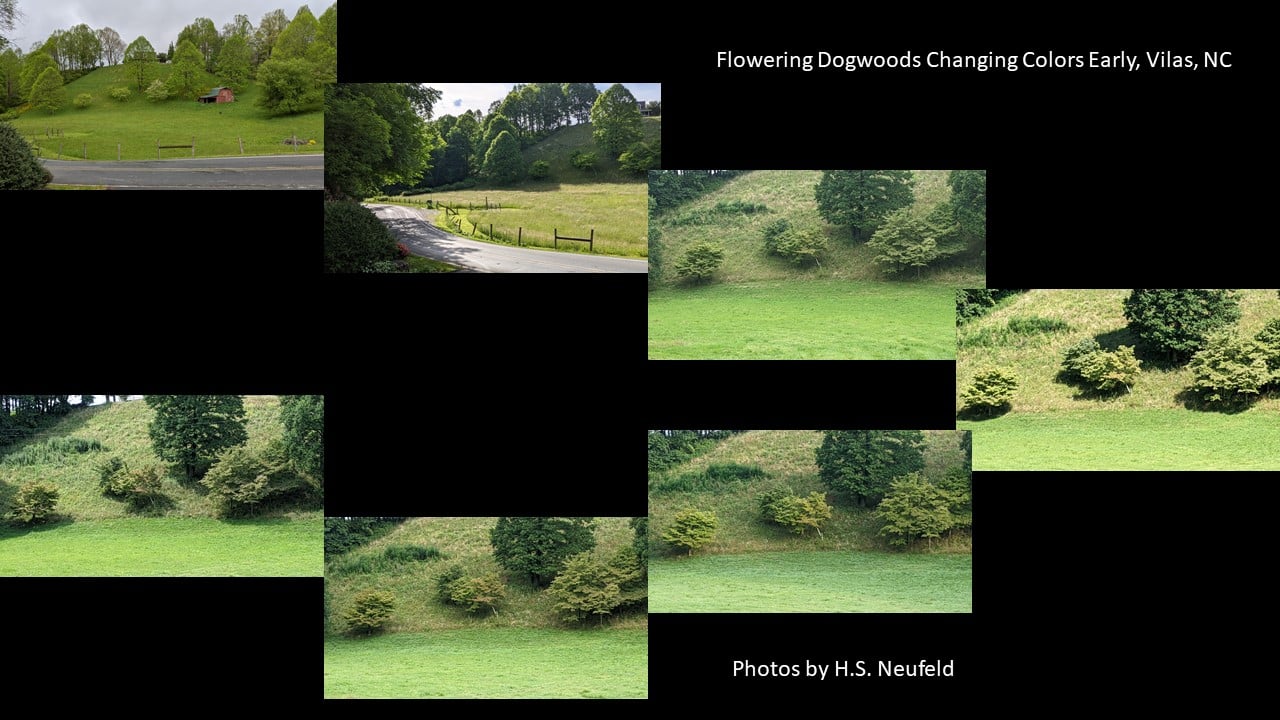
Fall Color Report for October 15, 2020
I went out with my wife’s mother this morning to check out the leaves one last time this week. The weather is beautiful today – no clouds, warm, and the leaf colors are at their peak now. In fact, a few of the higher locations are getting past peak. But if you are driving the Parkway from Chestoa north past Linville Falls to Grandfather Mt and Blowing Rock, you will be seeing some of the best colors we’ve had in the last few years. This weekend will be the peak weekend for the High Country. That doesn’t mean there won’t be any color the following weekend, but they are at their zenith right now.
A little rain is forecast tonight and on Friday, but Saturday and Sunday are supposed to be clear and cool – perfect fall weather. If you are coming up, be aware that the Parkway is already getting crowded, so come early (we were at Grandfather this morning at 8:30 am and had the place nearly to ourselves for short time. But as we were leaving 45 mins later, it was getting crowded). So, get up early – the color is better then and you’ll take home nicer pictures.
If you want to get away from the crowds, try Roan Mt, on the NC/TN border just west of Elk Park; Elk Knob State Park, just north of Boone, with a 2 mile easy hike to the top and spectacular views in all directions. The forest below the north-facing overlook has some of the most vibrant color anywhere in the High Country; and finally, Mt. Jefferson State Natural Area, where you can drive to the top, picnic, then take a leisurely level hike about a mile to some rock outcrops and great views. Doughton Park up in Ashe County also has great hiking trails and overlooks. The Smokies will be coloring up over the next two weeks, so they should be on your radar, but be forewarned that traffic can come to a standstill there during peak leaf season.
I will be checking out Roan Mt. this Sat or Sun. Happy Leaf Looking!
Fall Color Report for October 13, 2020
I went out on the Blue Ridge Parkway today to see how the leaves survived the storms that rolled in on Friday and stayed until Monday. Luckily, for us, the rains were fairly gentle and there was no wind to speak of, so while a goodly number of leaves did fall off over the weekend, most remained on the trees. Which means that they are there and showing off some great colors now! Today was a spectacular leaf looking day – skies were clear blue beginning late morning and the leaf colors were bright and varied.
Today in my opinion was peak color day on the Blue Ridge Parkway from Boone Fork, south of Blowing Rock, all the way to Grandfather Mt. Birches and tulip poplars were at their peak, giving the forests a golden hue, accented by orange-red sugar maples and browning Fraser magnolias. Red maples and sourwoods were at their best today, providing spots of bright red against the mostly yellow-orange of the forests. Colors were brightest above 3,500’, but extended down to 2,500’, although it was relatively greener at those lower elevations.
This would be THE week to see the colors in the High Country of NC. I hear they are also at or near peak in the Highlands area too, so if you can get out this week or the coming weekend, you should have a great experience. The colors are on-time this year, and exceptionally bright, and I would rank the fall color season this year as an 8.5 to 9.0, depending on where you are.
Colors should last through this week and into the weekend. After that, and because of some rain predicted for Saturday, the best colors will move downslope some. But the oaks are still coloring up, so some color will persist after this weekend in the High Country.
I’ll be heading out to Roan Mountain, on the NC/TN border this Saturday to check out the colors there. If you haven’t been to this location, it is on the Appalachian Trail and somewhat off the beaten track of the Parkway. You can hike either north or south on the trail, and because the peaks are grassy balds, you have 360 degree views from them. You can access it by heading out US 19E from Elk Park, NC about 20 miles to Roan, TN, and at the sign, take a left and head up the mountain. There is parking at the top.
I’d also suggest heading out to Mt. Jefferson State Natural Area in West Jefferson, right off U.S. 221. You can drive right to the top, have a picnic, and then take an easy level hike to the rock outcrops at the end of the trail (about 1 mile) and see some great views. Another suggestion is Elk Knob State Park – it’s probably past its peak given how high this park is, but the views from the top are the tops! It’s just north of Boone about 8 miles on Rt. 194. Lastly, Doughton Park on the northern section of the Blue Ridge Parkway. There are numerous hiking trails and some great overlooks and the colors should be good this week and next.
Despite the pandemic, the BRP is crowded (even on a Tuesday morning), so if you head up here this weekend, expect traffic, slowdowns and crowds. Best to avoid the weekends if you can!
Happy Leaf Looking!



Fall Color Report for Week of September 27, 2020
Wow, somebody hit the color switch this week! From Thursday to Sat, the colors just popped out all around Boone and along the Blue Ridge Parkway. This cool weather has really jump started the fall color season for us this year. Between Boone and Grandfather Mountain there is noticeable color, maybe even up to 20% in some places, and it is progressing quickly. The next two days will be warm, but then after some rain on Monday and Tuesday, we are supposed to get some of our coldest weather yet, and that should push the trees to color up quickly after that happens.
I got up early today and hoofed it all the way down to Graveyard Fields (mile 419 on the Blue Ridge Parkway, south of Asheville, https://www.blueridgeheritage.com/desti…/graveyard-fields/). This bowl shaped valley, at over 5,000’ elevation, always has early color change, and so most years, I miss it because I go there too late in the season. But this year, I hit it just as it is approaching its peak – now! Fall color is well on its way there now and by next week, it should peak for the season. I highly recommend a visit, but go early, as there is very limited parking. And because it is so popular, it gets crowded and you won’t be able to find a parking space.
The initial trail down to the creek from the parking lot is paved and then switches over to wooden stairs and boardwalk, so it is fairly easy hiking. Once you reach the creek you have two options: one is a loop trail that goes to the upper falls. This is about 2 miles roundtrip, and it can be muddy and slippery, with some places so eroded that you have to negotiate fairly large step ups to continue your hike. It takes you to a falls known as Yellowstone Falls. It is also prime bear country, so if you don’t need to, don’t bring any food with you on this hike.
The other hike is down to the bottom of the lower falls, and is only about a quarter of mile, with much of it on a boardwalk. At the bottom, it reverts to dirt and there are some slippery rocks at the bottom, so you should be careful there. But you will be rewarded with a very nice view of the falls from this vantage point.
Today, the red maples, blueberries, and sourwoods were in great color at Graveyards and a tree with dark blue drupes, that I am currently trying to ID. Some birches were also turning yellow. Goldenrod is abundant at this site, along with asters and St. Johnswort plants, which are fruiting now. I also saw some Galax leaves beginning to turn deep burgundy, something they don’t usually do until mid-October in other locations along the Parkway.
After Graveyards, I went to Craggy Gardens. This high elevation site is behind Graveyards, but colors are starting to appear on the hills that you see from the overlooks. If you go past the visitor center there (going north) there is a larger parking lot and you can take a very nice trail up to the top were there are some very nice stone overlooks. It is not a hard hike, maybe 1 mile roundtrip, and the view from there are stunning.
I took the Parkway all the way from Craggy Gardens back to Boone. As you approach Mt. Mitchell State Park, there are occasional hillsides with well-developed color now, mostly 4,500’ and above in elevation. Unfortunately, there are very few places to stop and take pictures on this stretch, because it is part of the Asheville city watershed. But there are occasional overlooks with great views.
Lower down on the Parkway, around 3,000’, maples and buckeyes, sourwoods and Virginia Creeper vines (which are peaking in red color right now) are providing most of the color in the forests. Each weekend now, as we get into October, we will see more color than the week before, and if our weather stays cool, we should have a normally timed fall color season (see earlier posts for exact dates, but at 3,000’ or so, I’m predicting around Oct 10-18th). We might even be a little early this year in fact, something that hasn’t happened in many years!
I’ll be posting an album of pictures soon and I’ll let you know the link to it. On the trails today, I’d say only about 1/3 of the hikers were using masks. It was hit or miss on that. I wish people who shun the masks would think more about their failure to take responsibility when they are out in the open, because all they are doing is endangering others who want to get out and view nature at its best. My rant of the week. I wore a mask, and when anyone approached, I put it on. It’s not hard to do!
If you come up to the High Country to see the fall leaf colors, have a safe drive and an enjoyable time outdoors!
Dr. Neufeld shared some thoughts with WataugaOnline.com on Sunday, August 30, about the upcoming 2020 season:
“In short, we've had a mild summer, with no extended periods of high temperatures or drought. The next four weeks will be crucial for determining the timing and quality of this year's fall leaf colors, as September temperatures are the the most important. The long-term (30 day) NOAA forecast is for September temperatures to be either slightly above, or slightly below, the average, and no drought.
If it gets sunny and cool, especially at night, then we should expect good color this year, particularly among trees that turn red, like red maple and sourwood, red oak and black gum. It should also place the peak timing near it's usual, which would be Oct 12-18 in the High Country at elevations between 3,000′ and 4,000′: a week or two earlier at the highest elevations and 7-10 days later for each 1,000′ drop in elevation.
So, at this point all things point to a good fall color season. Let's hope the weather cooperates and we don't get any hurricanes near peak leaf color.”
Dr. Neufeld shared some thoughts just before previous fall seasons that are still relevant for this or any fall season:
As for wet weather, there have been some publications on the impacts of weather on fall color (especially timing, not so much quality). Precipitation has only minor effects on timing in the fall. Temperature is more important. So, at this point, I don't see anything to make me think that fall colors will be adversely affected, either in timing or quality.
What happens in mid- to late August and in September, temperature-wise, will be more important, especially for quality (notably the intensity of the red colors)”.
People think fall colors are good when they last a long time, and have plenty of brilliant reds interspersed with the oranges and yellows. So, the quality will depend on how much “redness” we have this fall.
Trees tend to make more red colors (anthocyanins) in the fall when it's cool and sunny, and if we have a slight but not severe drought.
Sunny days means more photosynthesis, and more sugars produced in the leaves, and sugars induce anthocyanin production.
A slight drought impairs uptake of nitrogen (we think) and some experiments suggest that plants low on N make more anthocyanins.
Usually, fall colors peak around Oct 11-14 in the Boone area; sooner by a few days up to a week at higher elevations, later at lower ones. Nice colors can stick around for a week or more, although the peak usually comes and goes in just a few days, weather permitting (no high winds for example)”.
2019 UPDATES
For the 8th year in a row WataugaOnline.com is teaming up with Dr. Howard Neufeld, Professor of Plant Eco-physiology at Appalachian State University, better known as The Fall Color Guy to provide information as the colors start changing. For reports from previous years click here.
Friday October 4 Grandfather Mountain’s 2019 Fall Color – Fall color spreads along the slopes of Grandfather Mountain,
Mountain ash and

October 1, 2019 – This post kicks off Grandfather Mountain’s 2019 Fall Color Gallery, featuring regular updates to showcase the phenomenon
For a surefire glimpse of the autumnal brilliance,
The Fall Color Ramble culminates with a celebration of fall
Photo by Skip Sickler | Grandfather Mountain Stewardship Foundation

Fall Color Report for the Week of September 29th, 2019
I went to Elk Knob State Park this morning to check out the colors there. Because this park rises up to 5,520’ elevation, there can be dramatic differences in the degree of fall color display since elevation exerts such a strong influence on the timing of peak color. I was surprised to see substantial color development beginning this weekend – isolated maples were showing up against a mostly green background, along with birches and beech and tulip poplars. We are definitely in the beginning stages of fall color development. And we’re on time, something I attribute to the cool mornings we’ve been having, even though our afternoons are unusually warm.
Witch’s Hobble (Viburnum lantanoides) is in full color development, at about the 1 mile mark on the trail. See the picture album I will put up after this posting for pictures of this and other species from my hike today. This species has large leaves that turn orange then purple, in splotches on the leaves, before becoming entirely dark purple. It is one of my favorite fall leaf color plants.
One of the most common herbs is Filmy Angelica (Angelica triquinata), a member of the parsnip family. This species is common along the lower 2/3 of the trail and at this time of year is beginning to senesce (meaning the leaves are dying off for the winter). It does so by first losing the chlorophyll in the leaf blade, but retaining it in the veins, giving it a distinctive pale color against the other green plants. I suspect the veins remain green longer than the blade so the plant can continue to withdraw nutrients from its leaves, and sending them to its underground rhizome, where they can be remobilized next year when the plant sends up new shoots. That saves the plant some energy and enables it to get a head start in the spring.
At about the 1.5 mile mark you will find some beechdrops (Epifagus virginiana) spindly, ghostly looking plants, about 6” to 12” tall. These plants lack chlorophyll and cannot carry out any photosynthesis on their own. They are parasites on the roots of beech trees, which is how they get sugars to grow.
As you get to the top, the heights of the trees begin to drop until at the summit, the beeches are only about 6-8’ tall. Beech leaves first turn a deep gold color before transforming over to a nice brown. Their short stature is due to the harsh weather that can occur at these upper elevations. Beeches form clones and send up new shoots from their roots, so many of the trees you see are really all part of one, large clonal organism.
You can also find shrubs with inch long sharp spines (anyone know what those are?) and beaked hazelnut (Corylus cornuta), whose leaves turn a nice golden yellow. Mt. Ash (Sorbus aucuparia) occurs at the northwest lookout, and usually has bright red fruits at this time of the year, but for the last two years, these individual trees have not produced any and I’m not sure why.
There are a number of maples on Elk Knob, and the understory striped maple (Acer pennsylvanicum) is turning yellow now. They are common along the first half mile of the trail and quite distinctive due to their large leaves. Further up you will come across mountain maple (A. spicatum), whose leaves turn an orange color. Red maples (A. rubrum), as their name denotes, have red leaves in the fall. Sugar maples occur throughout the Park and their leaves can be a range of colors, from yellow to orange and even red at times. Red and sugar maples are important fall color trees because their leaves contrast so nicely with the yellows and oranges of other species.
When you get to the one-mile point, there is a nice bench to rest on and you will have great views facing northwest. At the top, the best fall color viewing is from the north viewpoint. The forests spread out before you are the most colorful in Watauga County aside from the ridges east of Grandfather Mt on the Blue Ridge Parkway. If you go to the south viewpoint, you can look back toward Boone and Avery County. Grandfather Mt is easy to pick out as is the annoying apartment building in Banner Elk.
The best time for pictures is either early in the morning or near dusk. The park is open 8 am to 8 pm, although later on it will get dark way before closing time. So, if you’re in to seeing some great fall colors, and want to avoid the large crowds on the Parkway, head north out of Boone about 12 miles and you’ll be at Elk Knob State Park. Happy leaf hunting!
September 22 Fall Color Guy Update Yesterday, Saturday, Sep 21, I went to Grandfather Mt as part of a social outing for the
Colors are starting to appear at the highest elevations. Out of scale of 1-10, I'd say the colors are between 1 and 2 now, but they are definitely visible to the eye.
Mt. Ash (Sorbus aucuparia) fruits are on full display – a brilliant red-orange color that is spectacular when viewed against an azure sky. Last year was a bad year this species, with few if any fruits, but they have rebounded this year. They will be on peak display for the next two weeks or so before falling off. You can find them at or above 4,000′ elevation all along the Parkway and in open areas. The foliage of this species turns a dull yellow, and is not much to look at. But the fruits – super!
Yellow buckeyes (Aesculus octandra) are losing their leaves now, which is normal for them. They are early to bud in the spring and early to drop in the fall. But don't look for any great color – they yellow up, turn blackish brown, and fall off.
Tulip poplars and birches continue to yellow and drop their leaves due to drought. Nearly five weeks now without significant rainfall. But it takes a long time for other species to show signs of drought, so I don't think this will have a major impact on colors this year.
Some maples are beginning to color up at the tips of their branches, as are dogwoods and sourwoods. Sassafras on rock outcrops are in full color, which is early for them, and most likely a drought effect.
So, the colors are starting. We're having warm days, but cool mornings (it was in the 40s here the other morning and low 50s this morning). I think cool nights and mornings are important for color development, even if we have warm afternoon temperatures, so although it's supposed to be warm for the next few weeks, I think we'll still get decent colors this fall.
That does it for this week. After this posting I'll put up an album of pictures from my trip yesterday. If you are deciding to come to Grandfather Mt., one of the, if not THE most visited state park in NC, be aware that crowds are already building up. Come during the week instead of on the weekend and avoid long lines. If you can only come up on the weekends, then get to the mountain early, otherwise you will be sitting in a long line of cars waiting to get in ( and the wait can range from 30 mins to 2 hrs!!). But do come. Grandfather is one of the most beautiful mountains in the United States.
September 16 Fall Color Guy Update – Temperatures are supposed to drop 20F here in Boone by Wed,
Importantly, we also have a chance of rain too, which we desperately need. So, some good weather news for once!
The pics of the trees, which I took yesterday, show a tulip poplar dropping nearly all of its leaves due to drought. This is the most dramatic leaf drop for this species that I have seen in many years.
In the meantime I took these photos today of the mountains above Boone. You can see some color starting at the higher elevations. Again, I think much of this is drought-caused.
September 15 Fall Color Guy Update – Forests are still green, but if you look closely at the summit of Grandfather Mountain, you can just see the beginnings of some
In particular, tulip poplars are dropping their leaves now – they turn yellow and then fall off. Same for birches. And sassafras has turned colors at least a month ahead of when it usually does, at least up at Beacon Heights.
Tuesday August 20, 2019 – In getting a preview for the 2019 season, Dr. Neufeld tells WataugaOnline.com, “This year has had moderate temperatures and adequate rainfall. We are not in a drought situation. I am waiting to hear back from the NC Climate Office with more official weather data. But as of now, the longterm NOAA predictions is for slightly above normal temperatures and either above or below normal precipitation.
The higher temperatures would mean that colors might be delayed from their longterm averages by a few days. The lack of drought means that the trees should hold on to their leaves well into the fall. If we did get a drought now, it wouldn't develop fast enough to really impact leaf colors and could even improve them somewhat, since colors (especially red) are brighter when the trees are slightly droughted and also a drought means sunny skies mostly, which favors more red coloration in the trees.
So, at this early stage, I'm hopeful for a good fall color season. Last year was not a good year, and I hope that was an outlier year, so maybe we will be back to a good fall leaf color season!”
2018 UPDATES
For the 7th year in a row WataugaOnline.com is teaming up with Dr. Howard Neufeld, Professor of Plant Eco-physiology at Appalachian State University, better known as The Fall Color Guy to provide information as the colors start changing.
Dr.Neufeld shared some thoughts just before previous fall seasons that are still relevant for this or any fall season:
As for wet weather, there have been some publications on the impacts of weather on fall color (especially timing, not so much quality). Precipitation has only minor effects on timing in the fall. Temperature is more important. So, at this point, I don't see anything to make me think that fall colors will be adversely affected, either in timing or quality.
What happens in mid- to late August and in September, temperature-wise, will be more important, especially for quality (notably the intensity of the red colors)”.
People think fall colors are good when they last a long time, and have plenty of brilliant reds interspersed with the oranges and yellows. So, the quality will depend on how much “redness” we have this fall.
Trees tend to make more red colors (anthocyanins) in the fall when it's cool and sunny, and if we have a slight but not severe drought.
Sunny days means more photosynthesis, and more sugars produced in the leaves, and sugars induce anthocyanin production.
A slight drought impairs uptake of nitrogen (we think) and some experiments suggest that plants low on N make more anthocyanins.
Usually, fall colors peak around Oct 11-14 in the Boone area; sooner by a few days up to a week at higher elevations, later at lower ones. Nice colors can stick around for a week or more, although the peak usually comes and goes in just a few days, weather permitting (no high winds for example)”.
Fall Color Report for the Week of October 28, 2018
This is the peak weekend for fall colors in the High Country, some two weeks later than normal. Unfortunately, for many of you, Saturday was a bust, with rain and wind. However, today, Sunday, was quite nice, with clear blue skies up to about 3 pm, at which time the clouds moved in. Peak colors should persist for a few more days but by next weekend will be past in the High Country.
Also unfortunately, peak colors does not mean great fall color. This year has been one of the least colorful fall displays ever, primarily due to the unusually warm temperatures in September and early October, high wind events (but not from the two hurricanes that came through though!), and excessive rain. All of these have contributed to premature leaf loss and a failure to color up as in past years.
There are isolated locations with decent color, but they are scattered and few in number. The hillsides on either side of Rt. 105 just north of Foscoe around Devil’s Den were looking quite nice today, but there are no good places to pull over for a view – you have to admire the colors while driving.
Many of the higher slopes are defoliated now and gray, and more leaves will no doubt come down tonight. As I write this, the winds have begun to blow vigorously outside and according to the weather reports, we will be in a wind advisory tonight. In addition, we have just had a huge bang of thunder and heavy rains are falling! How unusual for this time of year!! There go some more leaves! And Mila our red-tick hound dog, is shaking like crazy!
I took a drive today on the Parkway down to the Chestoa Overlook, which sits at about mile 321 at about 4,000’ elevation. Despite its high elevation, the trees in the understory still had leaves on them, although many of the dominant overstory trees along the ridges were mostly leafless. This overlook is an easy walk from the parking lot, and you can see Table Rock Mt. to the southeast. There is also a view of the Linville Gorge Wilderness Area and Grandfather Mt.
I’m afraid the colors were quite muted from this overlook – at the lower elevations they are coloring up, and there is a smattering of reds among the yellows and oranges, but I don’t think it will ever get as colorful as in past years.
From Chestoa I drove north to Beacon Heights and took the short hike up to the granite rock outcrops. The views there were much the same – lower elevations were coloring up slowly, and were very muted. I will post some pictures in an album shortly.
If you still haven’t come up to see the fall colors, this week would be good, as well as next weekend, although the colors will be lower down, and not so much on the Parkway or in Boone or Blowing Rock. After next weekend, the colors will all be below 3,000’ elevation, which means you could see them from the Parkway, but they will not be on the Parkway.
Sorry to be the bearer of such muted news about the fall colors – but the lack of brilliance this year is occurring all the way from the southern Appalachians up into Virginia and Maryland, according to reports from leaf lookers in those regions, and, most importantly, my mom!
Fall Color Update from Grandfather Mountain – October 17 – 26, 2018
Fall Foliage Report for Week of October 21, 2018
Today started off dreary and drizzly, but by noon, it began to clear up. However, as the skies cleared, the winds picked up, and throughout the day, we were buffeted by strong gusts. Of course, this took some leaves off the trees, especially those that had started to turn color.
That’s sort of been the story here this fall – just about everything that could go wrong for good fall color has happened this year: I said for good fall color we needed cool, sunny weather, starting in September. Instead, we had record warmth and excess rain and clouds. I said we needed to avoid rainstorms with high wind, and we had two hurricanes. As a result, I think we are going to have a sub-par fall foliage season. On a scale of 1 to 10, with 1 being no color and 10 being excellent, I am going to rate this season as between 2 and 3. That’s the lowest I’ve ever rated it in 11 years of doing this! Bummer!
There is isolated color here and there, but for the most part, the forests still have a lot of green showing (at least 40% or so, and even greater in some locations). Color is popping out, but there is a noticeable lack of brilliant red colors – we’re seeing mostly yellows and oranges. Most people think the quality of the display is lower if the reds are not showing brightly. To add to the mess, many trees at the higher elevations have already lost most of their leaves, so those hillsides have a gray appearance now.
Below the Parkway, forests are still primarily green, although I did see color extending down to about 2,000’ in some locations today. These areas usually peak at the end of October, and sometimes into the first week of November, so if conditions get more conducive for producing fall colors, the best colors may be in the foothills instead of the High Country.
I drove the Blue Ridge Parkway north up to Doughton Park, then reversed myself and took the Parkway south all the way past Grandfather Mountain. The story all along the way was much same: lots of trees with green leaves, trees missing leaves at higher elevations, and trees showing only muted colors in isolated locales. I’m afraid this year is a bust.
Because there are still a lot of green leaves out there, I’m predicting that colors will continue to develop this week, and peak by next weekend. After that, the best colors will appear at lower elevations down to 2,000’ or so, and then in early-November they should be peaking at 1,500’, e.g., in places like Chimney Rock State Park below Asheville.
I will be posting an album of photos from my trip today, so look for that once I get it uploaded. One last word: even though colors will not be great this year, there is still no better place to see great views than up here in the High Country, or all along the Blue Ridge Parkway down to the Smokies and up into Virginia. Last Saturday, when I was at Grandfather, it was so clear that we could see the Bank of America building in Charlotte, a distance of 82 miles as the crow flies. So, if you’re wondering whether to come up or not, remember, a day in the mountains will give you memories for a lifetime.
Fall Color Report for Week of October 14, 2018
Today was the Fall Foliage Ramble up on Grandfather Mountain. I gave a talk on the natural history and science of fall colors at 2 pm in the auditorium at the Nature Museum. There were also exhibits by a number of groups, including the North Carolina Native Plant Society, represented by local chapter chair Dr. Annkatrin Rose. I’d like to thank Gabe Duff and Amy Renfranz, from the Grandfather Mountain Stewardship Foundation, for inviting me up to speak.
It was windy, cloudy and cool in the morning, but by 2 pm the weather calmed down and there were deep blue skies, low humidity, and views that went on for miles. 82 miles at least, because it was so clear that we could see the Bank of America tower from the top of Grandfather.
How were the trees doing? Well, they are………green! There has not been much if any color development in the two days since temperatures dropped. In fact, there is actually less color now because the ridges below Grandfather that were showing color two weeks ago had their leaves blown off by storms, and the ridge is back to mostly green. This is the first time I’ve ever seen retrograde fall color development!
At the high elevations on Grandfather the birches are much more noticeable, but other than that, there is not much to report. Just look at the photos I took in the accompanying album to get an idea of just how far behind the colors are this year. I estimate they are 10-12 days behind normal. We should be past the peak at the highest elevations on Grandfather, yet they have barely begun to show color as of today (Sat, Oct 13).
So, is there any good news? Yes. First off, temperatures are predicted to remain cooler over the next week with lows in the 40s and highs in the 60s. That should be perfect for stimulating color development. Second, trees below 3,500’ are still mostly green, which means that they still have the potential to turn color in the next two weeks. So, if you take the usual peak color dates and simply move them two weeks later, you’ll be on schedule for when the trees will change this year.
I’m still holding out hope that we will have some decent color over the next two weeks. I’ll be checking things out between now and then, and will hit the Parkway next weekend to report on colors from there down to Asheville.
If you are wondering whether you should head up to the mountains, my advice is that you should. Each week now we should have more color, especially since the weather is moderating,. And even if the colors don’t do well this year, it’s always better in the mountains, color or not. Keeping my fingers crossed!
Fall Color Update from Grandfather Mountain – October 8 – 16, 2018
Fall Color Report for Week of October 6, 2018
The warm weather has persisted all week and is predicted to continue into next week. So far, this is the warmest fall on record for the mountains of North Carolina. Because of this, the fall foliage colors are very much delayed. I went hiking at Elk Knob State Park and it was still mostly green, even at the top, which is at 5,520’ elevation.
I’m worried that if the warm weather carries on for another week or two it might result in a very poor fall color season. Already, some trees have dropped their leaves without changing color. Others may do the same over the next two weeks. The shorter days may push some trees to begin changing color even if temperatures main elevated, but it may result in a display of lower quality.
As you can tell, I’m frustrated at this point because we have never had weather like this before, so I have no precedent upon which to make my prognostications. We’ll just have to watch together what happens. The longer it remains warm, the less confident I am that we will have a good fall color season.
At Elk Knob, the forests were still 95% green. Some birches are starting to yellow, as are sugar and mountain maple, witch hobble and some magnolias. But the beech trees, which dominate along much of the trail to the top, are mostly green. Only at the very top have they started to change to yellow and brown.
I then drove down to the Linn Cove Viaduct on the Blue Ridge Parkway, and the story was much the same. Color is mostly absent, with the exception of an isolated ridge here and there. Individual trees, such as maples, birches and cherries are starting to turn, but most other trees are still green. Sourwoods though, are peaking this week, so if you see a deep red colored tree, it is most likely that species.
In town, the ornamental red maples are showing good color at the tops, and some sugar maples are turning yellow/orange. But aside from this, not much else is apparent. It is greener at this date in October than in any previous year that I can remember.
On a more positive not, we will have more color next weekend than this weekend. Next weekend is usually when our peak occurs, but it will not be the peak this year. If the weather stays as is, peak color times will arrive one week to 10 days later than normal. Should we get a cool down, the colors can come on very quickly, and the trees could even catch up to their normal schedule, but the long-range forecast is not calling for that.
Fall Color Update from Grandfather Mountain – October 2 – 5, 2018
Maps via Foliage Network – http://www.foliagenetwork.net
Fall Color Update from Grandfather Mountain – Monday October 1, 2018
Autumn’s brilliance is starting to fall on Grandfather Mountain! Although color change has started a little slowly this year, fall foliage can already be spotted in most High Country locales.
Some of the higher elevations are already off to a good start, as this view from Grandfather Mountain’s Black Rock parking lot demonstrates. However, that’s not necessarily the case elsewhere. According to Dr. Howie Neufeld, professor of biology at Appalachian State University and North Carolina’s esteemed “Fall Color Guy,” “Usually by this time of the year, the upper elevations above 5,000 feet have significant color, and these high elevations often show their peak color at this time. However, this year, color development is way behind normal. Only some birches and mountain maples have started to change in a significant manner, and then only in isolated patches here and there.”
Fortunately, Grandfather Mountain’s mile-high elevation offers a fine vantage point to see that color change. Even after peak color passes locally, the park’s lofty heights allow guests to observe the season’s colors spreading throughout the valleys below. For more fall color photos, visit www.grandfather.com. Photo by Skip Sickler | Grandfather Mountain Stewardship Foundation
Fall Color Report for the Week of September 30, 2018
I am back from my two-day foray to the Smokies and my trip on the Blue Ridge Parkway. To get right to the point of my fall color postings I can state that everywhere and I mean everywhere, along the Parkway, the dominant color was GREEN. Usually by this time of the year, the upper elevations above 5,000’ have significant color, and these high elevations often show their peak color at this time. However, this year, color development is way behind normal. Only some birches and mountain maples have started to change in a significant manner, and then only in isolated patches here and there.
I’ll post an album of photos from the trip once I get them downloaded and labeled. Saturday was beautiful, with dramatic clouds against an azure blue sky, but today (Sunday) was mostly a bust – foggy and rainy. Temperatures are forecast to remain far above normal for the next week at least. If these high temperatures persist too far into the fall color season, not only will colors be delayed, but they might be far reduced in quality. Some trees, like red maples and tulip poplars, may simply drop their leaves before they develop significant color, resulting in a fall color display somewhat like last year, which also had above normal fall temperatures.
There was no color development at all in the Smokies or around Gatlinburg. On the initial portion of the Park road that goes up to Newfound Gap, you can still see the devastation from the wildfires of two years ago, with lots of dead trees on the upper slopes. Those fire scars will take decades to disappear.
After crossing over the Park I descended down toward Cherokee, NC. I couldn’t park and take photos at Newfound Gap because it was too crowded and there were no parking spaces. Also, the Clingmans Dome road was closed because it was being used as a staging area to look for a hiker who disappeared last Tuesday. As of Sunday she had still not been found. This emphasizes an important point – never hike alone! Always have someone with you in case something happens.
Just past the Park visitor center on the NC side of the Park is where the Blue Ridge Parkway starts. I got on there and head to Waterrock Knob, which is just a few miles north of the intersection with Rt. 19. If you got off there, Rt. 19 would take you to Maggie Valley. The Waterrock Knob area has restrooms and a visitor center. There is a short half-mile hike to a nice overlook that you should consider doing. However, be forewarned that it is straight up, so take breaks, wear shoes with good soles (no slippery ones!), and you’ll be rewarded with great views from the top. The most spectacular plant on this trail on Saturday was the witch hobble, which was in the middle of coloring up. See the album for pictures.
As I was leaving this site, I noticed some flowers in the grassy meadow that lies in the middle of the parking area. These flowers belong to a native orchid, which is something you might not expect in a mowed and maintained lawn area! I think these are Nodding Ladies’ Tresses (Spiranthes cernua), one of the most common mountain orchids.
On Sunday, I headed to Graveyards Fields, but it was foggy and rainy. Prior to this, I stopped at the Devil’s Courthouse, which is a few miles south of Graveyards. You can hike a paved path up to a walled-in lookout at the top. As with Waterrock, it is mostly straight up, and again calls for shoes with soles that grip to avoid slipping on wet rocks and leaves. The first two-thirds of the trail is paved, and if you pace yourself, it is not too strenuous. There are rare plants in the surrounding woods and peregrine falcons that nest on the cliffs. Because of this, you are requested to stay on the trails so you don’t endanger either the plants of falcons. If you have good weather, you will be rewarded with great views.
I then headed north to Graveyards. You can take a short 0.2 mile hike to the lower waterfalls. The first portion of the trail is paved. If you cross the stream, and continue on the trail to the right, much of which is a boardwalk, it will take you to a view of the falls from the bottom. I apologize for my pictures from here, but in the middle of my hike, it began to rain very hard, and I got soaked and I wasn’t able to get very good pictures. You can also take a longer hike (about 3.2 miles roundtrip) to see another falls here. Be forewarned that this is a popular place and the parking lot can fill up quickly. There are restrooms.
Lastly, I headed back to Boone. It was so rainy that I abandoned plans to see Craggy Gardens. As I exited the Parkway at Rt. 74A, a large black bear crossed the road in front of me. By the time I got over my surprise and got my camera turned on, I could only catch his/her rear end as it ran into the woods on the side of the road (see accompanying photo). Exciting!
Hope for colder weather – soon!
Fall Color Update from Grandfather Mountain – Tuesday Sept 25, 2018
Maps via Foliage Network – http://www.foliagenetwork.net
Fall Color Update post tropical storm Florence- Monday September 17, 2018 from The Fall Color Guy
Hurricane Florence has mostly left and is moving northeast now. The mountains didn't get as much rain as predicted – amounts varied from 4.4″ in Boone to nearly 7″ further north in Ashe and Allegheny counties. Winds were never that high either, with maximum gusts around 40 mph on average. As a result, we had only minor damage – a few trees down and some branches, plus a smattering of leaves. But the majority of the leaves are still up, and as I mentioned in several posts, it was fortunate that the storm came this early in the fall leaf color season, as otherwise more leaves would have come off.
However, temperatures this week are predicted to be 5-8 F above normal for the rest of the week. It's better for fall colors when temperatures at this time of the year begin to drop, and we haven't seen that yet. It's not as hot as last year, but it's still to high for my liking.
I wasn't able to go out this weekend, so I don't have anything to report on the trees. The Blue Ridge Parkway was completely closed for the hurricane. I expect it will be open up soon if not already.
Talk to you all soon!
Fall Leaf Color Report for Week of September 9, 2018
This week has been almost a near repeat of last week, with slightly above average temperatures and sporadic precipitation. The NOAA long-range forecast has a 33% chance of slightly above normal temperatures through November. Remember, for the best fall colors September should be cool and sunny. Now that we are halfway through September, and it’s still warm, I’m going to make my first comment on potential fall leaf color andsay that it may not be the highest quality, but premised on the fact that it remains warm the rest of this month.
Last year, we had oscillations between cool and warm weather, which totally confused the trees (if a tree can be confused!). The red maples in Durham Park on the Appalachian State University campus started to develop some red coloration, but then in one week dropped all their leaves before they reached their full color potential.
I’m going to keep my report short this week, as not much has changed much from last week to this one. Tulip poplars (Liriodendron tulipifera) are just now starting to show yellow leaves, which is the major change that I see from last week. Otherwise, nothing new to report.
I did try out the Boone Fork Trail today, a 5-mile loop trail that starts at the Julian Price picnic area on the Blue Ridge Parkway. The trail begins in an old field that was once a lakebed, and which is full of old-field herbs, then hugs the creek before heading uphill and into the woods. It was quite muddy today. If you take it, note that there are rocks to climb over, and a ladder to get up one set of rocks, but it’s not a difficult hike. But don’t try it with slippery-soled shoes.
Two of my students are studying how American chestnut saplings respond to sunflecks – these are the short-lived bright flecks of high light that make through openings in the overstory tree canopy. Although they may only occur 10% of the time, they can contribute enough high light for an understory tree to do 75% of its photosynthesis over the course of a season. Thus, they are disproportionately important to the tree. See the accompanying photographs of my students using a portable photosynthesis system to measure photosynthesis and transpiration of a leaf.
Lastly, I now have a circular polarizing filter on the camera. It makes a slight difference but I am still getting used to it. Hopefully it will improve my photos of fall colors and views.
Have a great week!
Fall Leaf Color Report for Week of September 2, 2018
This week has been quite warm, with above average temperatures. We’ve also had sporadic rain storms, including yesterday and today. My wife and I got rained out of our hike to Beacon Heights on Saturday, but we managed to squeeze in the Flat Rock Trail before the heavens gave way.
Today we had rain from 9 am until the early evening, including a whopper thunderstorm. This year has had interesting weather – we get thunderstorms, but with very little wind; just drenching rains. Last year, I had to water plants on my front patio about every other day. This year, since May, I’ve only watered the plants twice all summer! I’m a little worried about all the rain, but there is plenty of time for it to cool off and get sunny, which brings out our best colors.
There have been a few changes from last week’s report. The yellow buckeyes (Aesculus octandra) are accelerating their leaf color changes and you can spot them along roadsides as you drive by, or when you are hiking in the woods. The same can be said for sourwood trees (Oxydendrum arboretum), which are developing deep red leaves now. When displayed against their white sprays of downward-hanging fruits, these trees can be among the most colorful in the south. One of my favorite fall color trees!
The striped maples (Acer pensylvanicum) have started to change leaf color. They turn a dull yellow, with the veins remaining green until the end. These are small, understory trees with large tri-lobed leaves, and the bark often has white stripes splayed on its green to gray bark, hence its name. In exposed areas, like the rock outcrops at Beacon Heights and Flat Rock Trails, the huckleberries and blue berries, along with choke cherries (Aronia melanocarpa), are already turning colors. The blueberries and huckleberries turn a deep burgundy color, while the choke cherry gets bright reddish/orange leaves. Both have dark blue to black blueberry-sized fruits.
Sassafras (Sassafras albidum) has started changing also. It has interesting leaves that come in a variety of shapes: one is a simple ovoid shape, another is shaped like a mitten with one thumb on the side, and yet another is tri-lobed. Why it produces leaves with three different shapes is a mystery. Leaves turn orange to red, but can also be yellow, so this tree can be one of our most colorful in the fall.
Mountain ash (Sorbus americana) is fruiting now. The fruit clusters are initially orange in color, but by October, when they mature, will turn a bright red. This tree only grows at high elevations (generally above 4,000’) so to see it you’ll have to get to those higher areas, such as Grandfather Mt., Elk Knob, or portions of the Blue Ridge Parkway that get that high. The leaves are somewhat of a disappointment, turning a dull yellow and not really contributing to the fall color display, but the fruits are definitely worth it and when photographed against a bright azure cloudless sky, make for a striking image.
Virginia creeper (Parthenocissus quinquefolia) is starting to turn a deep red and over the next two weeks should color up nicely, as should poison ivy (Toxicodendron radicans). To distinguish the two vines, note that Virginia creeper has leaves with 5 leaflets, and the little tendrils that hold the plant onto its host tree are coiled and have a pad at the end (it exudes a glue that sticks it to the tree). Poison ivy, on the other hand, has 3 leaflets per leaf, which are shiny, and has a fibrous root system that sticks it to its host tree. Don’t touch either if you aren’t sure which is which, as poison ivy rash is a real pain to get! Whether poisonous or not, vines are an under-appreciated component of fall leaf color displays.
Suggestions for hikes: if you have young children, then consider the 2 mile round-trip hike around Price Lake. With easy access off the Blue Ridge Parkway, it’s a level walk which makes it kid friendly (although you’ll probably have to carry them over the last part once they tucker out).
Another nice hike, but longer and with minor elevational changes, is the Boone Fork Trail, which begins in the Price Picnic Area (just north of Price Lake). It is a 5 mile loop trail, with pasture, woods, creeks, and forests. You may also see beaver if you’re lucky.
In about two weeks, it should be nice hiking at Graveyards and Craggy Gardens on the Blue Ridge Parkway, south and north, respectively, of Asheville. Both offer great views and hiking. I’ll be visiting these later this month and will report back.
That’s about it for this month. Check out the photo album I posted earlier from the Flat Rock Trail hike and have a relaxing rest of the Labor Day holiday.
Postscript: we’re still excited here about ASU nearly beating Penn State in football. Boy was that a game! After coming back with 4 touchdowns in the fourth quarter to take a temporary 38-31 lead, PSU tied it and then won in overtime 45-38. This bodes well for a good season perhaps! And to boot, Rutgers, my alma mater, won its first game – go RU! For those who don’t know, Rutgers and Princeton (just down the road in NJ) played the very first intercollegiate football game, back in 1869.
Fall Leaf Report for Week of August 26, 2018
The days are getting shorter and the mornings cooler. This past week, after a cold front moved in from the upper Midwest, our morning temperatures dropped to the low 50s and in some places as low as 45F! Perfect temperatures for getting the trees to start changing color.
In Boone, some of the planted red maples (Acer rubrum) and burning bushes (Euonymous alata) are starting to develop their characteristic red coloration. Urban street trees generally turn earlier than trees in the forests outside town. This is most likely due to genetic selection for street trees that provide vivid fall color. Some of the red maple varieties sold to nurseries go by the names Autumn Glory, Autumn Blaze and Autumn Flame! They probably turn early because they are from the north originally, and trees from the north, if they are responding to the changes in daylength, would find shorter days in the south, which would indicate cold weather were they up north where the days are longer in summer.
I found a very nice basic introduction to fall foliage colors. You can access it here:
https://learn.weatherstem.com/modules/learn/lessons/91/index.html. It’s in the form of a PowerPoint presentation and has some nice information and graphics on fall leaf colors. In particular, pay attention to the graph on daylength (slide 13). Daylength varies as a function of latitude: in summer, days are longer the farther north you go. But in the winter, they are shorter.
As the days get shorter (which has been happening since June 21!) trees begin to sense this and several things begin to happen in the leaves, including slower production of chlorophyll, the pigment responsible for making leaves green; less sugars produced because there are fewer hours of daylight for the trees to carry on photosynthesis; and changes in hormones that begin the process of leaf senescence (controlled dying) and eventually lead to the leaf dropping off the tree.
These changes also trigger the color changes. As the chlorophyll degrades, the oranges and yellows (due to compounds known as carotenoids) are revealed, and if there are cool, sunny days, some trees use the sugars produced from photosynthesis to make anthocyanins, the pigments that color leaves red.
So, what’s happening this week with fall leaf colors? I took a hike up Rough Ridge, just north of the Linn Cove Viaduct Visitor center, and one of the most popular hikes on the Parkway. I highly recommend this hike of about 1.5 miles. It ends at a rock outcrop with great views to the east of the Wilson Creek drainage. The trail branches off to the right just before the rock outcrop and winds its way through beautiful forests for a few miles more before ending at the Visitor Center. If you decide to hike through, it’s best to park one car at the Visitor Center, then drive down in another car to the Rough Ridge parking lot and start the hike from there. Otherwise, you’re going to have a very long hike back to your car. Or you could do what a colleague of mine did on Saturday – he dropped off his bike at the Visitor Center, drove down to the Rough Ridge parking lot, hiked back to the Visitor Center, and then rode his bike the 4 miles back to his car. Whew!
I’ll attach an album of pictures that I took on my Saturday hike and one for the street trees that I took today. I noticed that the huckleberries at Rough Ridge are turning red now, and a few shrubs (including witch hobble: Viburnum lantanoides) are fruiting. One witch hobble is located near the beginning of the Rough Ridge trail and its leaves turn a deep purple. This species is unique in that it colors up in patches that over time coalesce until the entire leaf is purple. See the photos I took of this.
Otherwise, the forests are still 100% green and they appear to be on schedule. There is no evidence of any early fall leaf colors at this point in time.
Next weekend is Labor Day weekend and a word of caution: the Parkway will be filled with visitors, assuming the weather is good, and if you’re coming up to see the views, take that into account. Get out early to avoid traffic and crowds. If you’re going to Grandfather Mountain, arrive early to avoid traffic jams and crowds. Elk Knob State Park north of Boone on Rt. 194 is also a great place to visit, with a 2 mile hike to the top where you can have a 360 degree view. Later in the fall, when colors peak, you can see some of the best fall foliage color from this Park.
So, enjoy your week and the upcoming Labor Day Holiday. I have a busy weekend planned of doing …. nothing! For the sports minded, Appalachian State University, where I teach, will be playing Penn State University in football that weekend. A David vs Goliath confrontation if ever there was one. Let’s hope for the best!
Fall Leaf Report for Week of August 19, 2018
We’re still officially in summer, and in some areas, this time of the year is often referred to as the dog days of summer. However, “officially”, the dog days run from July 3rd to August 11th and while it is hot out, we are past that end date. While we tend to associate late summer days with dogs purportedly going crazy from the heat, in fact, the term ‘dog days’ arises because these times coincide with the rising of the dog star, Sirius. In ancient times, this was associated with wars and disasters, but the modern meaning, as we know it, didn’t begin to come around until about 500 years ago. For more on this term, see this short article from National Geographic Magazine.
https://news.nationalgeographic.com/…/150710-dog-days-summ…/
The dog days means there are still 6-8 weeks to go before we hit “peak leaf color”, depending on your elevation and latitude. However, that doesn’t mean trees haven’t started responding to seasonal changes, such as shorter day lengths, cooler nights, and the occasional insect or disease pest. There is some color change occurring, but only sporadically.
As the attached photos show, some trees are already turning, but these are mainly urban street trees, and most commonly, ornamental red maples. Near Galileo’s restaurant, a planted red maple has already completely turned red. I have commented on this particular tree in the past, and I don’t know why it does this, but genetics probably has something to do with it.
For native trees in the woods, you can now observe yellow buckeye leaves (Aesculus flava) beginning to turn yellow and orange. The buckeye genus contains several species, all of which have an unusual leaf phenology: they leaf out very early in the spring and are often the first tree to do so, and then are among the first to lose their leaves in summer. One species, the Georgia buckeye (Aesculus sylvatica), which I have published on, can be completely devoid of leaves by the end of August. Here in the southern Appalachians, yellow buckeyes defoliate by mid-September, but are susceptible to a leaf fungus that turns the leaves brown (https://bygl.osu.edu/index.php/node/837). As such, it does not rank high in terms of its color display.
The earliest display of leaf color occurs on flowering dogwoods (Cornus florida). Dogwoods around my home just west of Boone began coloring up two weeks ago. Although they turn color early, they will retain their leaves through September. They turn red to protect the leaves from the combination of cold temperatures and high light, which can start to occur in September. The red pigment, called anthocyanin, acts as a light shield that prevents the leaf from being damaged from by the high light when it’s cold outside. This in turn, allows the leaf to complete re-absorbing nutrients from the dying leaves, such as nitrogen, phosphorus, and potassium, and storing them in the twigs, where they can be re-used next spring to help produce next season's leaves.
If you are driving the roads these days, you may see many brown trees. These are most likely black locust trees (Robinia pseudoacacia). See the photos attached. The browning is caused by the locust leaf miner (Odontota dorsalis), which eats out the middle of the leaves, causing them to turn brown and die (http://bugoftheweek.com/…/scorched-locust-locust-leafminer-…). It is a native insect, and does this year after year, with no apparent detrimental impacts on the locust trees. It’s just a late summer ‘thing’.
Forests outside city limits here in the southern Appalachians are effectively 100% green this week. We won’t see major coloration on the slopes until late September, although the occasional tree may light up. A fall leaf color display worth a drive up to see will start in earnest by the beginning of October, and peak in the middle of that month, at least at elevations between 4,000’ and 3,000’. Higher up, colors will appear the first week of October, while at lower elevations, the last week of October.
Finally, if you go out for a hike in the next few weeks, look down. There are things happening close to the ground that are worth viewing. This week, for example, Jack-in-the Pulpits (Arisaema triphyllum) are fruiting. These are beautiful woodland herbs, recognized for their unique flower structure, bright red fruits when mature, and glossy, tripartite green leaves. Forest fungi are having a banner season because of all the rain we’ve received this summer. Note the photo below of the large brown fungus I found in the Appalachian State Nature Preserve this week – it is about 16” across!
I hope this brings you up-to-date regarding the latest fall leaf color developments. See you all next week!
In getting a preview for the 2018 season,Dr. Neufeld tells WataugaOnline.com, “It’s been somewhat of a rough going these past two years, but hopefully things will turn around this year. So far, the weather is cooperating. We haven’t had extremely high temperatures, nor any serious droughts in the mountains.”
He also adds, “I haven’t seen any signs of major diseases on trees, although this year the tent caterpillars are having quite a show, mainly on black cherry trees. You may have noticed their webs at the ends of branches. Some trees can get quite infested and they will devour the leaves. So those trees won’t be showing much this year. Black locusts are turning their usual brown now, due to a native leaf mining insect, but they always come back year after year, no harm done.”
“A few trees have already started to turn color, but don’t panic – these are sports that always turn early each year. I will include some photos of them later today. I have no good idea why they turn so early each year. They are simply weird trees.”
“The majority of trees in the woods haven’t done much turning yet – a few tulip poplars are dropping their older leaves here and there, but nothing major. And I haven’t noticed the leaf weevil on them this year, which did a number on them near Asheville a few years ago. However, flowering dogwoods are definitely beginning to color up (see attached photos). This species will begin to slowly turn their usual deep burgundy red, even in August, but the colors develop slowly, and build up all the way into October. It has one of the more extended leaf coloring periods of any of our native species.”
“People always ask if summer weather has any effects on the timing or quality of fall leaf color. In a nutshell, it does not, severe drought not included. But the weather in mid- to late August and through September is critical. Overly warm temperatures in August, and particularly in September, will delay colors by a several days, and reduce the intensity of the color of red leaves. It may also disrupt the fall leaf color synchrony, with some species turning at their normal time (such as sourwoods) while others, such as red maples, delaying their colors until temperatures cool down again. This tends to reduce the visual quality of the fall leaf color experience because by the time the delayed species color up, the early ones have already dropped their leaves. It’s always best when all the species color up at near the same time.”
“The other weather factors that can affect fall leaf colors are precipitation and cloudiness. If both occur with regularity in September they will dull the redder colors. The best conditions for red coloration are sunny, cool (but not freezing) days, and cold nights (again not below freezing). If we get those weather conditions in September, then we will be in for a good show. But clouds hold in the heat at night while during the day they lower the light intensity, resulting in less photosynthesis. Trees need the sunlight to manufacture anthocyanins, the pigment that gives leaves their red coloration.”
“Lastly, if we have a wind storm near or at the peak of fall leaf color, it can take down a large number of the leaves, reducing the length of the fall color season. This has happened on and off over the years, but luckily, such events are not too common.”
“All in all, at this early point in the season, I am predicting a good fall leaf color year.”
2017 UPDATES
For the 6th year in a row WataugaRoads.com & WataugaOnline.com is teaming up with Dr. Howard Neufeld, Professor of Plant Eco-physiology at Appalachian State University, better known as The Fall Color Guy to provide information as the colors start changing.
In getting a preview for the 2017 season, WataugaOnline.com ask Dr. Neufeld his thoughts about what we might can expect. He said, “It has been a cool and wet summer up to this last week, when we have gotten our usual August weather. One positive feature for this year will be the lack of drought, which should favor trees like tulip poplar, which are sensitive to water stress. If they keep their leaves, they should turn a nice bright yellow midway thru the season.”
He added, “Otherwise, I think it should be a good year, but we will need temperatures to start dropping in September, and for clear skies. That should bring out the reds, and when they are brilliant, people think we have a good year. If on the other hand, it stays warm and cloudy, that could both delay the onset of color by several days, and dull the reds.”
On a final note Dr. Neufeld said, “I haven't noticed any major foliar diseases either, which is good news. So, let's hope for good weather during September and October!!
Final Fall Color Report: For the Week of October 30, 2017
Well folks, it’s been a wild ride this fall color season. Below I summarize my thoughts on the colors this year as well as inform you that this will be my last posting for the season. The colors have mostly moved downslope and out of the High Country and some of these areas now coloring up are a little far for me to get to (considering I have another job that actually pays me!). I’ve enjoyed posting fall color reports, meeting a few of you, and answering your questions as best I could. I hope everyone who came to the High Country had a pleasant experience and will think about coming back next year, when hopefully, the leaf colors will be better. As they say, one day in the mountains is better than any day at work!
First off here’s my summary of this past season. I thought the colors were going to come early this year because of the cool and wet summer we had, but then just as they started to turn, the temperatures in the High Country shot up near 10-15 degrees above normal for several weeks in a row, and color development slowed way down. Then, we had one cool week, and they started up again, followed by more warm weather, and they stopped yet again. These up and down temperature swings surely took their toll on the trees. And on top of all that, we had Hurricanes Irma, Harvey and Nate that variously took down leaves (and trees!) throughout the mountains. All in all, the convergence of all the worst possible factors for fall color!
The wild and mild weather upset the traditional coloring up this fall season. Some trees turned early (like American ash trees), while maples were spread completely across the spectrum, with some still coloring up even now in the High Country, whereas others have been leafless for several weeks. In some areas, trees went from beginning to color up to completely leafless, as happened at Price Lake near Blowing Rock, NC.
In some areas, such as the Blue Ridge Parkway along the eastern flank of Grandfather Mountain, the colors were fairly good, as they always are in that section, while other parts of the Parkway, like The Craggies and the section between Mt. Mitchell and Chestoa Overlook, were muted or dropped their leaves prematurely. A lot of trees went straight from green to black or brown and then dropped, like many tulip poplars and birches. This asynchrony was one major factor that led to the diminution of fall colors this season.
When colors did develop, they were dominated by oranges and yellows. Reds weren’t as prominent this year, which is as I predicted, as warm weather reduces the amount of red pigment in leaves. However, when some trees did turn red, they did so spectacularly, especially among urban red maples, planted especially for their fall color, and occasional isolated red maple or sourwood out in the woods. It’s just that this year their peak color seems 1-2 weeks later than in previous years. Boone, for example, had a lot of its urban maples peaking last week, when in earlier years, they did so by mid-October.
There are still colorful areas out there. Yesterday, even though it was snowing in Boone, I headed north on the Parkway, picking it up where it crosses U.S. 421, and where it was surprisingly mostly sunny. This is a less visited section of the Parkway, but nonetheless, with spectacular views from the overlooks, some of which are as good as those from the section around Grandfather Mountain. However, the surrounding countryside is more pastoral, devoted more to cattle farming, with lush meadows and Christmas tree farms here and there. I enjoy this section for its relative isolation and lack of traffic jams at peak color time.
I found that despite this late date, there was good color in sections, although mostly oranges and yellows, but from some of the overlooks, there were smatterings of red from maples, oaks, sourwoods, and black gums. Sassafras were in good color, along with the yellow/brown magnolias, birches, and hickories.
It was hard to take pictures yesterday, as the wind was blowing about 50 mph, and it was colder than a you-know-what. But I had a lovely drive, with little or no traffic, and I recommend this section for those who want to get away from the crowds. Because the front that moved in yesterday took down the humidity, I’ll bet I could see 50-75 miles in the distance!
If you’re still up for fall color viewing this season, I recommend you head to areas below 2,500’ now, places like Chimney Rock, Gorges, and Stone Mountain State Parks. There may even still be color in the Smokies at the lower elevations. And if you head up the Parkway into Virginia, which is even further behind, you might be able to catch some color there.
I hope you’ve all had a good fall color season, and I’ll see you next year. On occasion I’ll post tidbits I find about trees, ecology, or the like. Don’t hesitate to send me a note if you have any questions about nature, trees, or ecology, and I’ll see if I can answer them. See you all next year!
Each fall season WataugaOnline.com receives tremendous photos from Grandfather Mountain Stewardship Foundation. Here are some recent ones.







Maps via Foliage Network – http://www.foliagenetwork.net


Fall Color Report for Sunday October 22 from The Fall Color Guy
The colors have come on very nicely, especially in and around Grandfather on the east side adjacent to the Parkway. In other areas, the colors are very dull, and above 3,000′, many leaves have now completely fallen off. If you didn't get here today, and the rains coming don't do a number on the trees, colors should persist to next weekend.
This has not been the greatest year for fall color, but I must say that they are not bad along Grandfather. Color is spotty this year, so as you drive the Parkway, you'll go in and out of colorful areas. The colors are developing nicely now at 2,500′ and below and all high areas on the Parkway are now past their peak.
If the rains on Mon and Tue of this week don't knock too many leaves off then forests at 2,500′ or below should continue to develop good colors and if you come up to the High Country, that is where you will see the best colors from the overlooks, right up to the next weekend.
After this coming weekend, the best colors will be at lower elevations, so start heading south, and to areas at lower elevation. This would include Brevard, Pisgah Forest and the waterfalls, Chimney Rock and Gorges State Parks, as well as Stone Mountain State Park.
I think the combination of unusually warm October weather and Hurricanes Irma and Nate have disrupted the trees this year. If I had to rank this year's fall display, on a scale of 1 is worst, and 10 is best, I'd rank this year a 3. That's the lowest I've ranked it since I started doing fall color forecasts. Let's hope next year we have more typical fall weather.
However, if you look at the long-term trends, what is unusual now may become the new normal in the future. We are in a warming trend globally (whether you are a denier or not, it is warming, which is a fact, not an opinion), and this means that if such warming continues, we may all have to adjust to a new concept of what fall colors will be in the southern Appalachians. Of course, two years is not a trend – most climatologists use 30 years to discern trends, so those of you who are younger, keep track and 28 years from now, let us know what the trend has been for fall colors. Or, maybe I'll do it – I'll only be 93 then and today, 93 is the new 73, right?
Enjoy your time in the High Country!
Maps via Foliage Network – http://www.foliagenetwork.net


Each fall season WataugaOnline.com receives tremendous photos from Grandfather Mountain Stewardship Foundation. Here are some recent ones.



Fall Color Report for Week of October 15, 2017
I took a drive today down to Chestoa Overlook, about 4 miles south of Linville Falls on the Blue Ridge Parkway. I then worked my way back north to Price Lake and Cone Manor in Blowing Rock.
The take home message is this: the best color can be found starting at the Yonahlossee Overlook near Grandfather Mountain and on up north to the Rough Ridge Trail on the Parkway. Even so, it is not yet at peak. There is still a lot of green, which means that next weekend should be even better. And it’s supposed to get cool this week, which should hasten color development.
Other areas, such as the Chestoa Overlook, have good color in the parking lot and on the trail, but the views to the forests below are still mostly green. It may be a week or even two before those forests color up. Still worth a drive there, as you can see Table Rock from this overlook.
The bad news is I don’t think this will be a great fall color year. The heat wave we’re having (it was 72oF today in the mountains, which is about 10-15oF warmer than it should be this time of year) is doing a number on the leaves. Many trees have already lost leaves even before they have turned color. At Price Lake, for example, it went from no color to no leaves. It’s still pretty there, but the colors are fairly dull.
The same can be said for the state of the fall colors in and around Boone. Now Boone always has dull fall color compared to other parts of the county, perhaps due to species composition, but this year it seems even duller than normal. This is our second year in a row with an exceptionally warm October, and high temperatures are not conducive to great fall colors.
Right now, sassafras are peaking (orange, red, yellow, all on one tree), as are magnolias, birches, and witch hazel (all yellow). Red maples are coloring up, while sugar maples (mostly yellow) are losing their leaves. Tulip poplars have dropped most of their leaves, retaining only those on the exterior portion of their crowns. Sourwoods are still a nice burgundy, as are huckleberrys and black gums.
I think the peak color weekend will be next weekend along this stretch of the Parkway. However, the forests that you view from the overlooks are about a 1,000’ lower in elevation, so they will not peak until even later.
So, if you’re still planning to come to the mountains, you have still have plenty of time. I’ll report about other sections of the mountains later this weekend. Meanwhile, have a safe drive up to the mountains, and happy leaf looking!
Fall Color Report October 12, 2017
The Fall Color Guy says that at elevations below 2,500′, the leaves are mostly green. Returning from a recent trip Dr. Neufeld said, “Good color didn't start until I was on US 321 between Blowing Rock and Boone. Then it fades (as it often does each year) the closer you get to Boone.” This weekend should be excellent for viewing fall color, and the good colors should last through the week to the next weekend. That puts the peak EXACTLY in the time period when I said it would peak – between Oct 10 and 18.
If you're planning a trip to the Boone/Blowing Rock area, Linville Falls, and Mt. Mitchell or Doughton Park, the next two weekends and the week in between should be very good. Luckily, the remnants of Hurricane Nate this last weekend didn't take out all the leaves, and there are plenty still left to develop color.
Maps via Foliage Network – http://www.foliagenetwork.net


Each fall season WataugaOnline.com receives tremendous photos from Grandfather Mountain Stewardship Foundation. Here are some recent ones.




Maps via Foliage Network – http://www.foliagenetwork.net




Each fall season WataugaOnline.com receives tremendous photos from Grandfather Mountain Stewardship Foundation. Here are some recent ones.



Maps via Foliage Network – http://www.foliagenetwork.net


Each fall season WataugaOnline.com receives tremendous photos from Grandfather Mountain Stewardship Foundation. Here are some recent ones.



Maps via Foliage Network – http://www.foliagenetwork.net


Photos from Saturday September 23, 2017 from The Fall Color Guy
Here are photos of trees on the Appalachian State University campus. The sugar maples are especially striking now. Note also, how they change first on the east side, which red maples do also. The deep purple trees are ash trees. These photos were taken on Thursday of this last week.


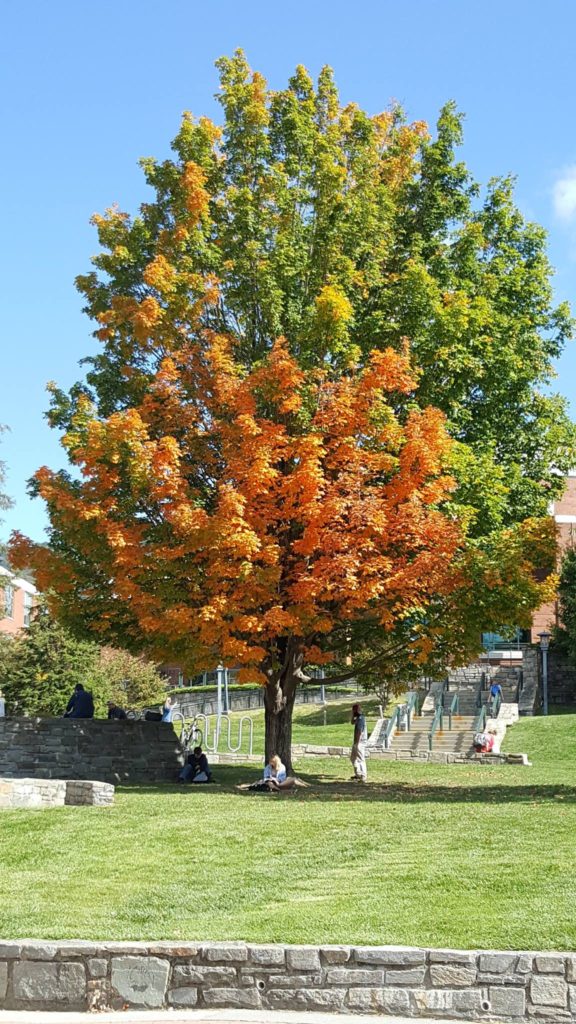


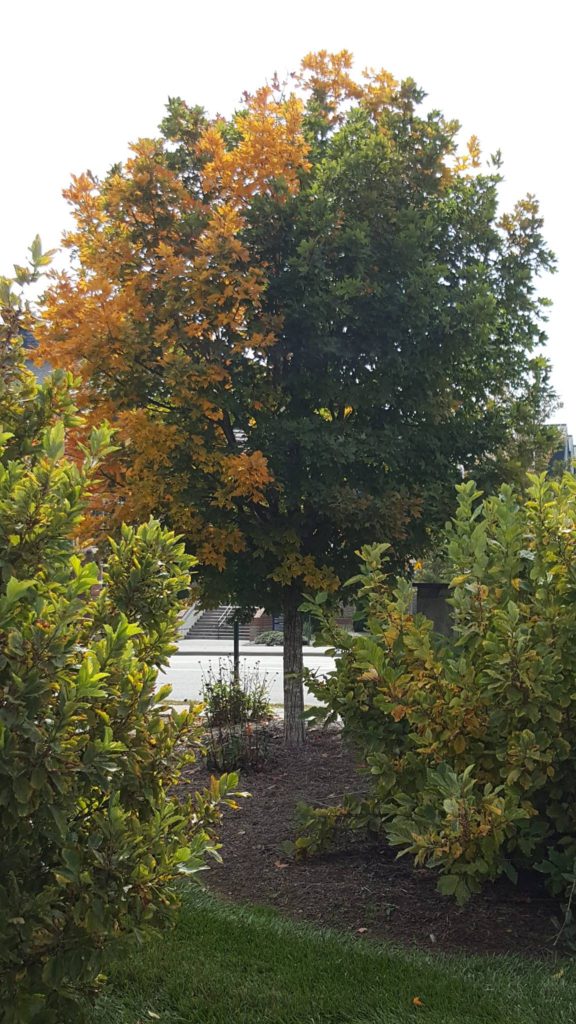
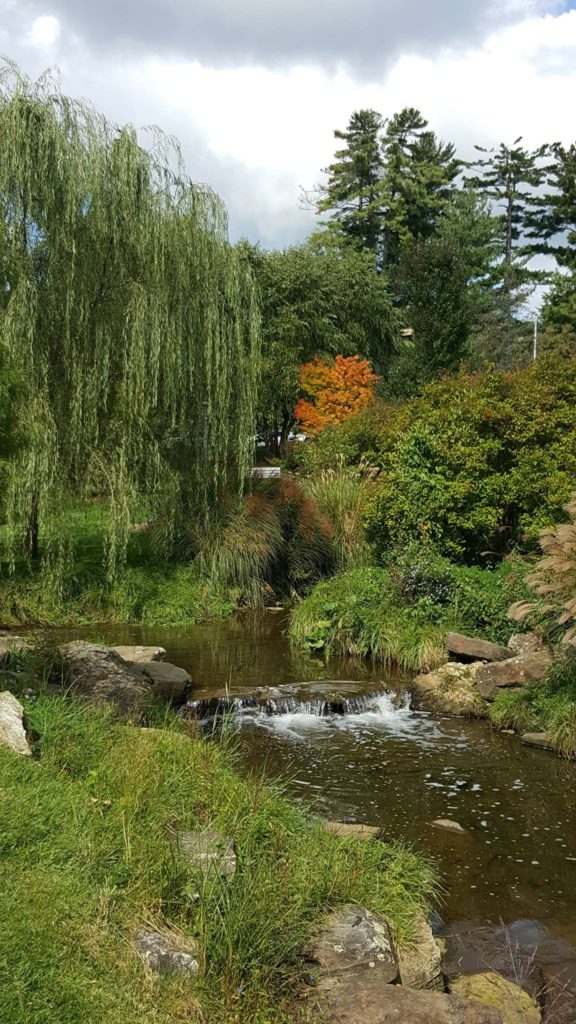
The photos below go with the Fall Color Update for the week of September 24 which can be found below.




Fall Color Report for Week of September 24, 2017
I’m glad to report that the Blue Ridge Parkway is now open again in nearly all locations. I was able to drive from Little Switzerland to The Craggies today. The good news is that colors have not yet peaked, even at the high elevations at the Craggies and Mt. Mitchell. I spoke with the ranger at the Craggies and he thinks they will peak next weekend (Sep 30).
Now, the main trees at the Craggies are yellow birch, beech, hawthorn, mountain ash, pin cherry, and a few black maples. Nearly all of these trees turn either yellow or orange. There are very few trees that turn red at this site, so when it does peak, it will look yellow with a burnt orange tint.
Mt. Mitchell is dominated by spruce and fir at the highest elevations, and there are scattered birch, mountain ash, pin cherries, and elderberry among the evergreens. Because of this selection of species, colors at the peak will also tend toward the yellow/orange, intermixed among the green firs and spruces. But downslope, the forests have more sugar and red maples, sourwoods, and black gums, so they will color up with bright reds among the yellow and oranges, your more typical expectation for fall colors. These forests are just now starting in this section of the Parkway, and have at least another two weeks before they color up nicely.
Sumacs are coloring up along the roadsides, as are blueberries and other assorted shrubs. Viburnum are also turning yellow to purple beneath the birch canopy at high elevations.
There are few flowers at these high elevation sites, but goldenrods and white and blue asters are abundant along the trails now. There are a variety of lichens at high elevations, growing mainly on tree branches and trunks. Lichens are an interesting organism, composed of algae growing symbiotically within a fungal host. Some lichens even host more than one species of algae at a time.
Lichens are very sensitive to air pollution, so their presence is an indicator that the air quality in the southern Appalachians is getting better. In fact, because of the Clean Air Act (CAA), sulfur dioxide pollution is down nearly 75% and ozone has declined to its lowest levels in the Southern Appalachians since we’ve been monitoring it. In fact, no jurisdiction in the United States is out of compliance for sulfur dioxide now, a remarkable accomplishment when you think of it, especially when you consider that the population of the United States has grown considerably since the CAA was enacted.
As you drive north toward Boone/Blowing Rock, you will see more color, especially in the Linville/Tynecastle area. However, the dominant hue is still green, although there is noticeable color showing up on the hillsides. But I’d estimate it’s only about 30% to the peak, although I hear that Rough Ridge, on the Parkway east of Grandfather, is further along (it always peaks early for some reason).
I’ll post an album of photos from today’s trip soon. Each weekend from now on will provide more and more color if you journey up to the Blue Ridge Parkway. While many are predicting an early peak in the High Country, this recent warming trend might slow the colors down, and put us back on track, with peaks in the High Country in mid-October. Only time (and the weather) will tell!
Hope this is helpful. Drive safely and don’t speed on the Parkway – their tickets are yuuuge!
Cheers!
Maps via Foliage Network – http://www.foliagenetwork.net


Friday, Sept. 22, marks the first day of fall 2017, and Grandfather Mountain is already showcasing its seasonal colors. With color rapidly changing at elevations between 6,000 and 5,000 feet, guests to Grandfather Mountain could expect to see peak or near-peak conditions toward the top of the mountain — as seen here from the park’s Cliffside Overlook — this very weekend. Photo by Skip Sickler | Grandfather Mountain Stewardship Foundation

Each fall season WataugaOnline.com receives tremendous photos from Grandfather Mountain. Today, Wednesday Sept 20, is the first of these installments.



Maps via Foliage Network – http://www.foliagenetwork.net


Fall Color Report for Week of September 17, 2017
Well, today’s activities makes me think of the poem Maud Muller, by John Greenleaf Whittier (http://www.bartleby.com/102/76.html), which contains these immortal words:
For of all sad words of tongue or pen,
The saddest are these: “It might have been!”
So what ‘might have been’? Well I was out scouting the leaves and encountered a closed Blue Ridge Parkway just up from Asheville about 7 miles, and had to turn around. The Parkway was closed for the next 20 miles until Park personnel can remove downed branches and trees from the aftermath of Hurricane Irma. This means I could not get to the Craggies, one of my favorite stops on the Parkway. . The good news is that by next weekend that section should be re-opened.
The other thing that ‘might have been’ was a visit to Mt. Mitchell. But instead, my car died on the way there. Luckily, for me, it did so at one of my favorite ice cream stops (Dairyland, at the intersection of U.S. 70 and Rt. 80 just west of Marion). Try the coconut ice cream – to die for! Rt. 80 is a very windy road that will take you up to the Parkway and from there you can go to Mt. Mitchell State Park. Mt. Mitchell is the highest peak in the eastern United States, at 6,684’ elevation.
Well, a kind group of ladies had jumper cables, and I got my car started again, but had to head straight back to Boone, where I left it at my favorite mechanic’s place to be looked at tomorrow. Most likely an old battery, so not too serious. But it did prevent me from taking as many photos today as I would have liked.
Nonetheless, I did take a few photos on the Parkway. As you can see, it is still mostly green, BUT, there is significant color now showing up in the hills. One of the most colorful changes has been the Virginia creeper, which in most locales has now turned its usual deep burgundy red. It makes a nice contrast for a few weeks against the still green trees that it climbs on. The sumacs are also starting to turn a fiery red/orange along roadsides now and they add a brilliant splash of color this time of year.
Elsewhere, red and sugar maples are turning rapidly now, both in town and in the forests. If colors continue to develop at the pace of this last week, I may have to state, for about the first time ever, that I think colors may come early this year, by at least 7 days. However, the coming week is supposed to be warm (mid-70s in the Boone area) and that may slow down the color development. If it doesn’t, then I may predict that colors could peak around Oct 7 in the Boone/Blowing Rock area instead of the 12th-14th. We’ll know for sure by next weekend.
Other notable developments are the continued coloring of sourwoods, which are peaking now in the High Country and foothills. They just turn early for some reason. Many sugar maples are already bright yellow and orange, and red maples are starting to show up nicely. The birches are really coloring up now, a sunny yellow, and tulip poplars are starting too. Ash trees often turn a deep purple color and are now showing up along the Parkway and in town.
Some readers have gone to Graveyards, just west of Asheville on the Parkway (and I highly recommend visiting this spot) and they report that colors are showing there already. I will post a photo from Graveyards soon. This area is very high up on the Parkway, so colors peak much earlier there. I will also get a report from the Smokies to see how they are doing and post that later.
That’s the report for this week. Watch for periodic updates throughout the week. My car should be fixed early this week, so hopefully I can go out next weekend for another excursion and be able to bring back photos from the Parkway for you.
Cheers!
Fall Color Report for Week of September 10, 2017
Yesterday I checked out Mt. Jefferson State Natural Area, just outside West Jefferson, NC in Ashe County. I just posted the pictures from this. This is a really nice place to view fall leaf colors, and to just take in the spectacular views from the top. You can drive all the way to the parking lot there by the picnic pavilion and then head out on the main trail for about ¾ mile to the Luther Rock viewpoint. It’s mostly level hiking, so it’s an easy trip. There are several other trails that go off the main one, and they all loop back so you can’t get lost.
This area is dominated by red, black and chestnut oaks, along with red and striped maples and American chestnut sprouts (the larger trees were killed about a century ago by a fungal blight, but the trees continue to sprout from the roots each year before dying when they get about 20’ tall). The slopes are quite steep at the top, so do as the signage says and stay on the trails so you don’t fall down the steep slopes. This natural area is very popular with families and kids, and you can either picnic on the mountain, or sample the restaurants in nearby West Jefferson.
This week, the Mountain Ash were just starting to turn, as were the striped maple, black birch and a smattering of red maples. At the rock outcrops, the huckleberries are turning red now. Otherwise, the rest of the trees are still quite green.
I highly recommend this hike. It’s easy access, and if you stop at the Jefferson Overlook, on the road before you get to the top, you can see into Virginia, which is only about 20 miles away. The prominent peak is Whitetop Mountain, Virginia’s second highest peak at 5,518’ elevation. Mt. Jefferson is at 4,680’, and noticeably cooler than the valley just below, so be prepared when you go and bring jackets on cool days. The elevation makes these forests similar to those much farther north, in fact, similar to those in New York state.
In town, the ornamental red maples are starting to display now. Many turn red from the top first. I’ll post a few pictures soon. They always turn much earlier than the native trees. The other early turning native trees are dogwoods and sourwoods, both of which have colored up red quite nicely this past week.
Finally, many of you are wondering what the impact of Hurricane Irma will be. Well, it has taken a more westerly track and is only supposed to skim the mountains. Wind speeds may be 40-50 mph, but because the leaves are still mostly green, and held firmly by the trees, I don’t think this will knock many of them off. We often have thunderstorms with more severe winds. I think the fall color season will be just fine. It has been quite cool so far, which is good for stimulating the red colors. So, I think we are still on schedule – mid-October for Boone/Blowing Rock and the Highlands area, a week or so earlier for higher elevations, like the Craggies and Graveyards off the Blue Ridge Parkway, and the end of October for lower elevations like the Asheville/Hendersonville area. The Smokies, with their great range of elevation, start changing in early October at high elevations, and peak in mid- to late-October, since they are slightly south of Boone. Check my links on my fall color page at ASU for links to other sites. Here it is:
https://biology.appstate.edu/fall-colors
Have a good week, and I’ll post again next Sunday!
Fall Color Report for Week of September 3, 2017 from The Fall Color Guy
Today was a beautiful day – clear blue skies, followed by a thin veneer of cirrus clouds later on, with comfortable, cool temperatures – perfect hiking weather. There were lots of people out on the trails along the Blue Ridge Parkway and at Grandfather Mountain State Park. I like to see people out experiencing nature – I overheard one young boy say that this was the best place he could remember. How great to hear something like that!
Well, there is only a slight start to the fall color season. Some of the shrubs, like huckleberry and low and high bush blueberry, are starting to change color. A maple here and there is coloring up, as are a few birch, but the remaining trees are still green.
There are some nice late summer flowering plants, like goldenrods, pokeweeds, impatiens, asters, snakeroot, Joe-Pye weed, and ironweed, decorating the roadsides and forest understories now. This is also a good year for mushrooms, many of which are popping up along the trails now.
The roads to Grandfather were clogged with cars today, so when the fall colors start, be aware that if you delay the time of day you go to the mountain, you could find yourself sitting for an hour or two waiting to get in. Go early, or late, or during the week. Weekends will be crowded.
It’s been cool here in the High Country all summer. It was 54F this morning and only reached a high of 62 yesterday, which is pretty remarkable for this time of year. If this continues throughout September, we should be on schedule for a good fall color season. Interestingly, the urban red maples, planted in town, are only now just turning, but the colors don’t look as intense to me as in previous years. I’ll take some photos tomorrow and post them for you to see.
See you next week!
August 30, 2017 Update from The Fall Color Guy.
Well, not much has happened yet. Urban trees are changing now – the red maples are coloring up, from the east and top sides of the tree at first. Sourwoods are beginning to turn red, a few sumacs, and of course the dogwoods.
We are still on for a good fall color season. Although it's been cool this summer, I predict the schedule of colors will be the same as in previous years, with Boone/Blowing Rock peaking in mid-October, higher elevations a week before, and Asheville that lower elevations toward the end of October. Of course, it depends on weather conditions in September largely. The remnants of Hurricane Harvey are moving toward the Carolinas, so the next few days could be warm and wet. Hopefully, after it passes through, we'll get sunny and cool conditions, which make for good fall color.
In getting a preview for the 2017 season, WataugaOnline.com ask Dr. Neufeld his thoughts about what we might can expect. He said, “It has been a cool and wet summer up to this last week, when we have gotten our usual August weather. One positive feature for this year will be the lack of drought, which should favor trees like tulip poplar, which are sensitive to water stress. If they keep their leaves, they should turn a nice bright yellow midway thru the season.”
He added, “Otherwise, I think it should be a good year, but we will need temperatures to start dropping in September, and for clear skies. That should bring out the reds, and when they are brilliant, people think we have a good year. If on the other hand, it stays warm and cloudy, that could both delay the onset of color by several days, and dull the reds.”
On a final note Dr. Neufeld said, “I haven't noticed any major foliar diseases either, which is good news. So, let's hope for good weather during September and October!!
Dr.Neufeld shared some thoughts just before previous fall seasons that are still relevant for this, or any, fall season:
As for wet weather, there have been some publications on the impacts of weather on fall color (especially timing, not so much quality). Precipitation has only minor effects on timing in the fall. Temperature is more important. So, at this point, I don't see anything to make me think that fall colors will be adversely affected, either in timing or quality.
What happens in mid- to late August and in September, temperature-wise, will be more important, especially for quality (notably the intensity of the red colors)”.
People think fall colors are good when they last a long time, and have plenty of brilliant reds interspersed with the oranges and yellows. So, the quality will depend on how much “redness” we have this fall.
Trees tend to make more red colors (anthocyanins) in the fall when it's cool and sunny, and if we have a slight but not severe drought.
Sunny days means more photosynthesis, and more sugars produced in the leaves, and sugars induce anthocyanin production.
A slight drought impairs uptake of nitrogen (we think) and some experiments suggest that plants low on N make more anthocyanins.
Usually, fall colors peak around Oct 11-14 in the Boone area; sooner by a few days up to a week at higher elevations, later at lower ones. Nice colors can stick around for a week or more, although the peak usually comes and goes in just a few days, weather permitting (no high winds for example)”.
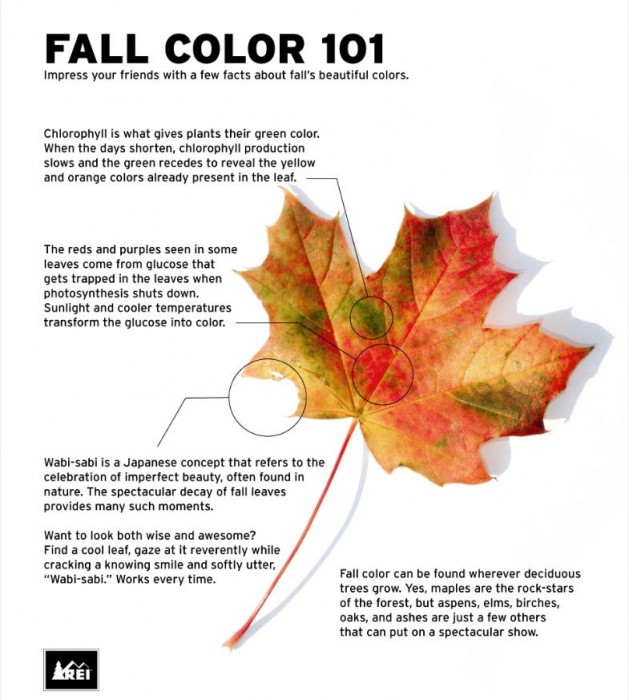
Fall Color Report for Week of August 13, 2017
Well, there haven't been many developments since my post last week. I do include a picture of the dogwoods across the street from my house. You can definitely see them starting to color up.Otherwise we continue in our late summer weather pattern, with higher humidities, making it very muggy here. Still getting ample rain too. Hope everyone has a great week.
Fall Color Report for Week of August 6, 2017
It has been an unusually cool summer here in the High Country. Morning temperatures have been as low as 48F, and this past week, in the low 50s. We had to put on a blanket last night it got so cool! Daytime highs struggle to get in middle or high 70s. And the humidity has been low. Absolutely perfect weather.
Some trees have already decided that it's time to prepare for the upcoming fall. The dogwood in my yard has already started turning purple. Note also on the whole tree photo (below) that the purpling is most noticeable on the left side of the tree – that's the side that gets morning sun. My thought is that trees turn early on their east sides because that's when they get the combination of both cool temperatures and high light. And those together can cause leaves to suffer photo-inhibition and cellular damage. By producing the purple pigment, which is an anthocyanin (the same compound that colors strawberries and roses) they protect their leaves from photo-inhibition. This in turn, allows them more time to withdraw nutrients, like nitrogen and phosphorus, back in to their leaves for use next year when they make new leaves.
Off the mountain, I've noticed that the tulip poplars have been losing a lot of leaves (they turn yellow then brown/black). According to the NC Climate Office, it has been a very hot summer in the Piedmont region of the state, and tulip poplars are sensitive to water stress, and maybe heat stress too. I haven't seen the same leaf loss up here in the mountains. And we're ahead in terms of rainfall this year.
Lastly, as happens every year at this time, the black locust are being attacked by the locust leaf miner, a native insect that eats the leaves and turns them brown. It doesn't seem to hurt the trees too much, but does look bad as you drive down the road.
That's the latest update from the High Country. Enjoy these last days of summer. Remember, there will be a total eclipse on August 21st. DO NOT LOOK DIRECTLY AT THE ECLIPSE WITHOUT SUITABLE EYE PROTECTION. AND BEWARE OF USING REGULAR OR FAKE SUNGLASSES – REGULAR GLASSES WON'T PROTECT YOU AND THEIR ARE FAKES OUT THERE THAT WON'T EITHER. CONSULT YOUR TV STATIONS FOR REPUTABLE SUNGLASS SELLERS.
2016 UPDATES
For the 5th year in a row WataugaRoads.com & WataugaOnline.com is teaming up with Dr. Howard Neufeld, Professor of Plant Eco-physiology at Appalachian State University, better known as The Fall Color Guy to provide information as the colors start changing.
Final Report from The Fall Color Guy – November 7, 2016
It's been an interesting season, with below normal precipitation, and above normal temperatures (2016 will go down as THE warmest year in recorded history globally and it will be the third straight year for which we can say that. Think there is no climate change – think again!
But the colors did come out despite the unusual weather, although about a week to ten days late. On a scale of 1-10, with 10 being Norman Rockwell spectacular colors (or Jackson Pollock colors), I'd say this year was a 7. Not great, but not bad in places.
There were trees that dropped leaves early, and some red trees didn't color up as much as could be expected, but in places, the colors were quite nice. Spotty would be the word. And of course, it didn't help that on THE peak weekend, we had the dreaded wind/rain storm that took down a substantial number of leaves. Sometimes Mother Nature just gets in a mood and there's nothing to be done about it!
Urban maples in particular, looked great this year, so perhaps in the future we should take more time to check out cities for their fall colors as we do the mountains and rural hillsides!
Colors should be peaking now in the foothills and in the Piedmont area soon if not now. Because of my restricted travel this fall, I won't be able to check out as many areas as last year. But Stone Mt. State Park and Chimney Rock State Park ought to be looking good this week and coming weekend.
I hope everyone had a great trip to the mountains. Remember, we have some of the cleanest air in all the east, so breathe deeply.
Maybe, just maybe, it will cool down and we'll have some real fall weather. I know I'm looking forward to a nice frost. And so I leave you this season with the one small pocket of frost and frosted leaves that I found in a corner of my yard earlier this week. Let's hope for more, and I'll see you all next fall color season!
Maps via Foliage Network – http://www.foliagenetwork.net
Final Report
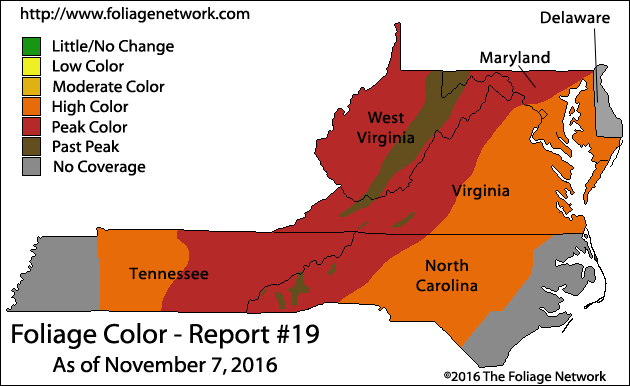
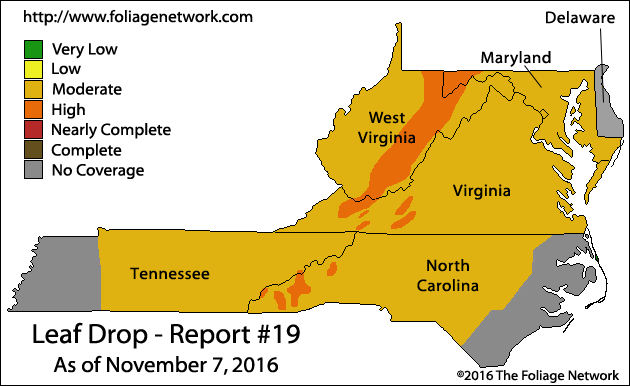
Maps via Foliage Network – http://www.foliagenetwork.net
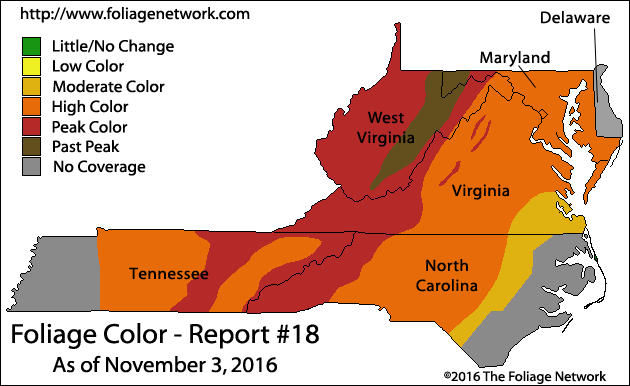
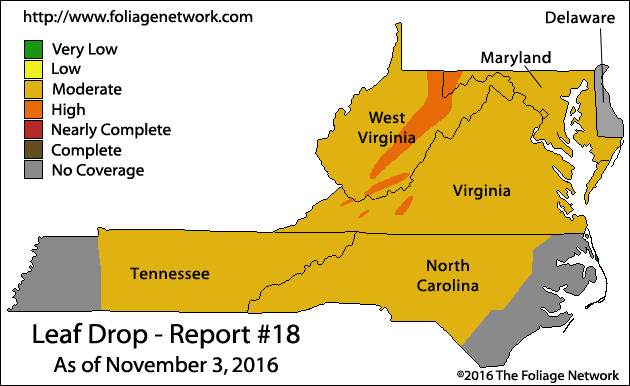
Maps via Foliage Network – http://www.foliagenetwork.net
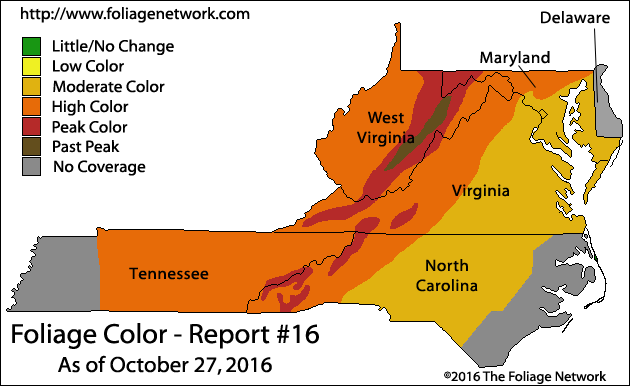
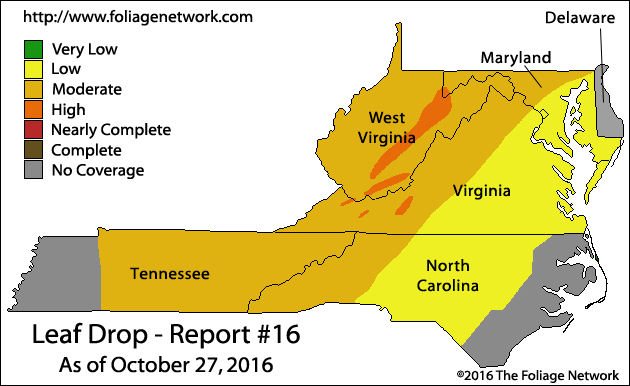
Maps via Foliage Network – http://www.foliagenetwork.net
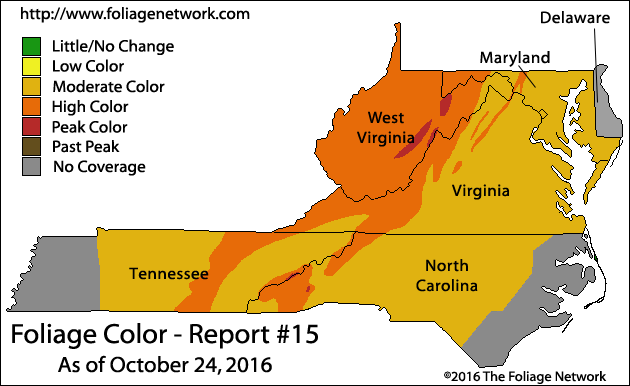
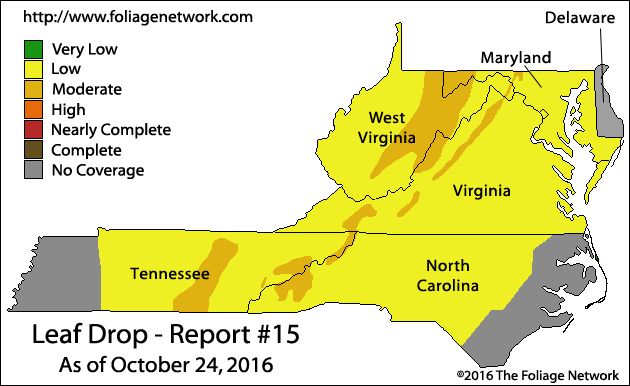
Maps via Foliage Network – http://www.foliagenetwork.net
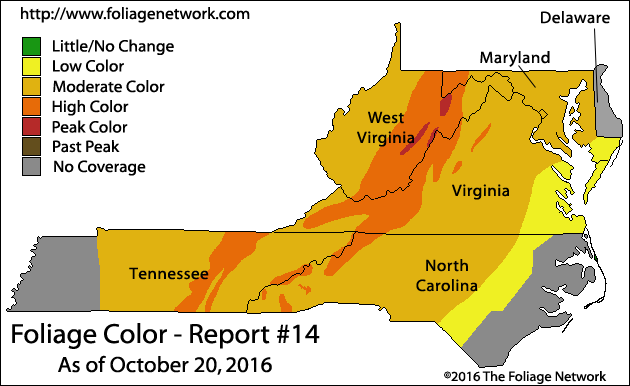
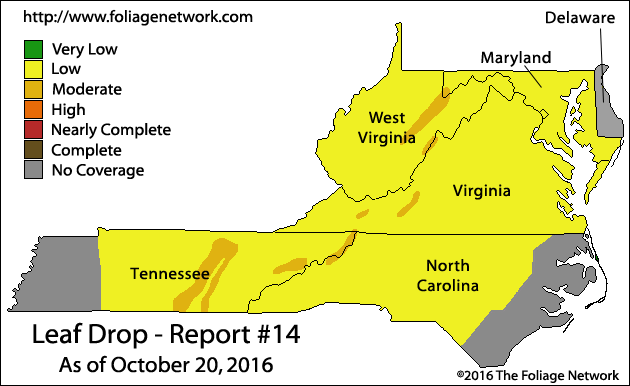
Maps via Foliage Network – http://www.foliagenetwork.net
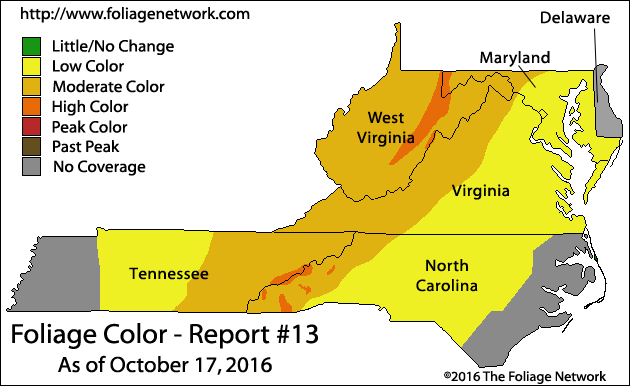
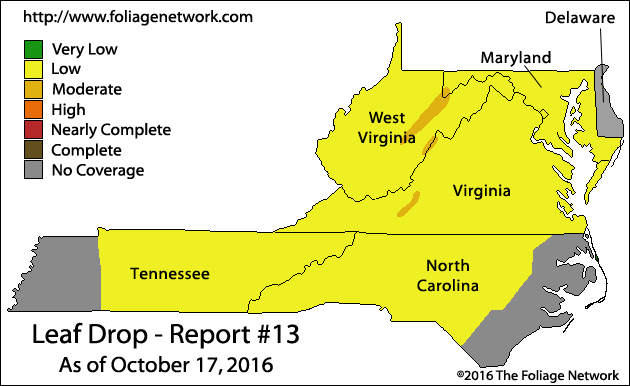
Fall Color Report for the Week of October 15, 2016 from The Fall Color Guy
As I stated in my last report, I thought colors would begin to come out rapidly this past week, and that has been the case. Pat on the back. Colors are about a week behind schedule compared to previous years, but they are now starting to show nicely. Today I was at Grandfather Mountain State Park, taking pictures and you see them if you go to this directory:
https://drive.google.com/…/fo…/0BxpSVO5IUz-EcHgyelJwMk1EUzA…
It was an unusual day today – as you drove from Blowing Rock to Grandfather Mt. on the Parkway, you would go through areas socked in by clouds. But once you got passed Rough Ridge, the clouds fell away, and the Park was totally clear. It was very unusual, because of the cloud cover was several thousand feet down and coming in from the east toward the flank of Grandfather, where it dissipated. It looked like what you would see from an airplane when you fly over clouds.
The highest elevations were just about at peak today, and there were some nice colorful maples, deep purple American ashes, and Mountain Ash trees with their bright red fruits. BThe birches lost a lot of their leaves in the high winds of last weekend (Jesse Pope, the Executive Director of the Grandfather Mountain Foundation, told me today that they clocked winds up to 92 mph on the Swinging Bridge during that period! However, the most of the maples held on to their leaves, and they are starting to show as bright red on the landscape. Sugar maples are turning yellow/orange now, and the magnolias are yellowing and turning chocolate brown. The oaks, which are always late turners, are just starting to show some coloration, and so once these other trees are past their peaks, the last hurrah of color will be from these trees.
The colors will peak at 3,000’ and above around Tuesday or Wednesday this week, but will still be good next weekend, which should be our best weekend to see colors in the Boone/Blowing Rock/Grandfather Mt. areas. After next weekend, the best views will be from the overlooks down into the lower forests, such as the Wilson Creek area, and the forests below Linville Falls on the way to Morganton. The drive on Rt. 181 from Pineola to Morganton offers beautiful views, less traffic than the Parkway, and the roadside stop at the Brown Mountain Overlook (of Brown Mountain Lights fame) is a good place to check out leaf colors. There is also a nice falls (Upper Creek Falls: http://www.hikingupward.com/PNF/UpperCreekFalls/), and it’s an easy hike with great fall color along the way. I highly recommend it!
I will say that the colors seem much duller this year – even though some scattering of trees are bright red. The best reds are the ornamental maples in town, but there is the occasional wild red maple too that is showing off nicely (there’s an impressive one on the right side of the Parkway as you head on the Parkway toward Cone Manor from U.S. 321. But the high temperatures and extreme drought this fall have curtailed colors this year. Nonetheless, the oranges and yellows will still be out there, except for the tulip poplars, which because of the drought, are going from yellow to black almost instantly. But it’s still worth a trip to the High Country to check things out. Now, if we could only get a Dunkin Donuts up here, we’d truly be in paradise (we do have a new Krispy Kreme, which helps).
We’re supposed to have near record highs in the next few days, due to a persistent high parked out in the Atlantic, and which is bringing up warm air from the southwest on its backside. That may slow down color development some, and keep the reds duller than we’d like. Sorry, but I can’t do anything about Mother Nature or the weather!
I’ll post more later on how conditions are further south, below Mt. Mitchell, and on into the Smokies, and down to Highlands. But for now, I’d say if you can get up here anytime this coming week, or the next weekend, you’ll hit the colors full on.
Endnote: next weekend will be jam packed at Grandfather, so if you’re planning on going, get there early (before 11 am), or go during the week instead of the weekend. Otherwise, you could be sitting in a traffic jam for up to 1 to 2 hrs on U.S. 221. The same can be said for the Rough Ridge trail.
Happy and Safe Driving!
Maps via Foliage Network – http://www.foliagenetwork.net
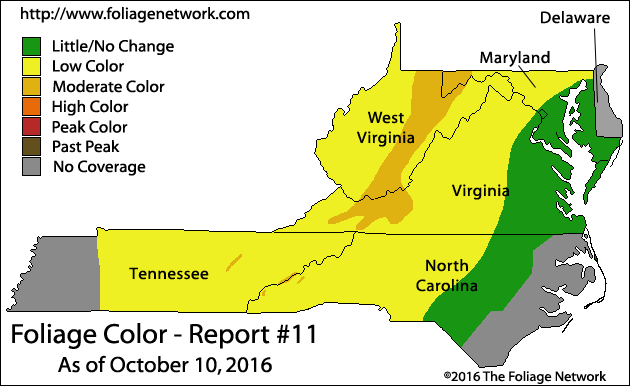
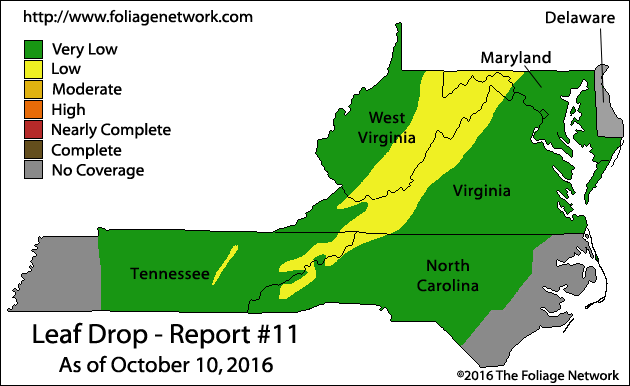
Maps via Foliage Network – http://www.foliagenetwork.net
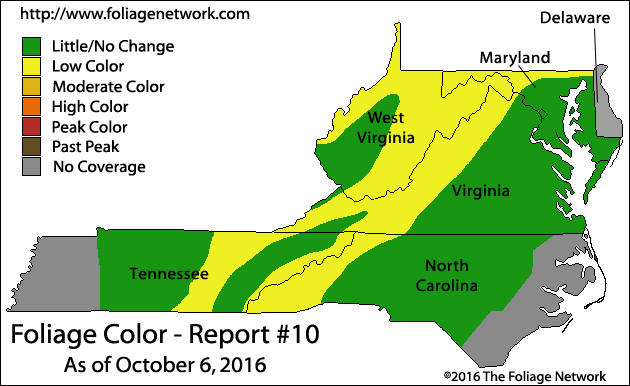
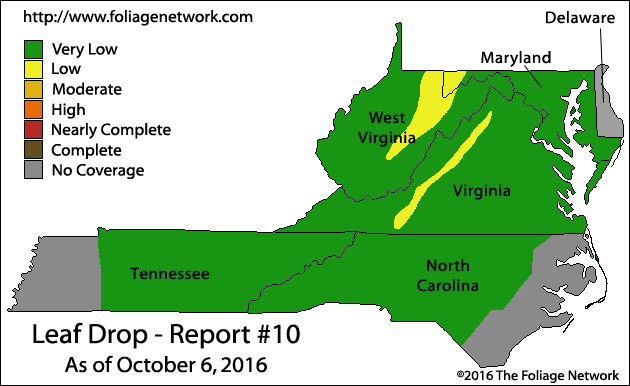
Fall Color Report for the Week of October 2, 2016 from The Fall Color Guy
Colors have started appearing, almost as if someone had slowly turned up the color saturation on the forests, just like you can do with your digital photos or TV, and during the week, they have become gradually more noticeable. Although green is still the dominant color, we are finally seeing the beginnings of the color that attract all of us to the mountains at this time of the year.
However, we won’t see really wide-spread colors until the next weekend. So, if the weather holds as it has for the past week, with mornings getting down into the 40s and highs in the 70s, this should push forward the color development. As it’s been sunny also, that should bring out the red colors too, meaning we could be set up for a really good fall color season after all, despite the unusually warm and dry weather in August and September. For the next 10 days, the forecast is for highs in the 60s, lows in the 50s and then down to the 40s, possibly 30s at the higher elevations. I wish the morning lows were lower, but at least we’re heading toward ideal fall color weather.
The red maples in town continue to color up – the dominant variety colors from the top down, and we have dozens of trees with red tops and green bottoms, and that’s quite striking. The occasional maple and sourwood have started showing up in the woods too, plus birches, tulip poplars, and hickories are yellowing up now. Virginia creeper, a dominant vine in the southern Appalachians, turns a brilliant red color, and it is showing off now in places.
This coming week is the best time to check out the high elevations on the Parkway, as they peak earlier than lower elevations. The next two weekends will bookend the peak color season, although it could extend into the third week of October in the Boone/Blowing Rock area if the weather doesn’t get much colder. Warm weather tends to delay the onset of colors somewhat. As an example, see the two photos posted below, courtesy of Dave, from Raleigh. He shows the same location last year and this, and it is apparent that colors were more advanced last year then this year. This location is Purchase Knob, at 5,000′ elevation, and home to the Appalachian Highlands Education Learning Center, a part of Great Smoky Mountains National Park, near Cataloochee, outside of Maggie Valley. Thanks to Dave for these photos!
In a post following this one, I’ll provide Jesse Pope’s assessment of the colors in and around Grandfather Mountain. Things are picking up there. Remember, if you go on the weekend now to popular areas like Grandfather Mt., be prepared to wait to get in. Best to go early or during the week. I know, you have to work, but if you have any leave available, this is the time of year to use one or two days of it!.
Some drives to consider: try taking US 64 west to Chimney Rock, through the gorge and on to Hendersonville, Brevard and through Cashiers, and ending up in Highlands. This highway meanders along the escarpment, especially west of Brevard, where the mountains drop down into Georgia. Excellent drive, and along the way are waterfalls and numerous hikes. I recommend Whitesides Mountain, between Cashiers and Highlands. Wonderful views. For the easiest hike, go up the jeep path first (not as pretty, but an easy, moderate slope all the way to the top), and then, make a roundtrip by taking the nature trail back to the parking lot (which is much easier to navigate going down than up). Also, just south of Lake Toxaway is Gorges State Park, with Rainbow Falls (2 mile hike one-way, all downhill, but not too difficult) and many trails. This park is somewhat lower in elevation and will change toward the end of October, but it’s a beautiful place, with a very nice visitor center. It is one of our newer state parks. Finally, don’t forget the Cradle of Forestry (where forest science started in North America) and Looking Glass Falls too, not too far from Brevard.
Where to eat? I recommend Randevu in Cashiers – wonderful breakfasts and lunches, great prices. The Market in Highlands is an unusual combination of a deli, pizza joint, and restaurant, also at very good prices. In Maggie Valley, try Butts-on-the-Creek for very good BBQ, while in the Boone/Blowing Rock area you can get good BBQ at Woodlands in Blowing Rock, at McKethans and Pedalin Pig in Boone (and Pedalin Pig also near Banner Elk) and also at Hampton’s Store in Linville.
Lastly, I recommend Linville Falls for a great hike (off of the Parkway), and the Chestoa Overlook a few miles south of the turnoff for Linville Falls. Nice picnic area, hiking along the Parkway through a nice oak-hickory-maple woodland, easy, and a very nice stone overlook with good views of Table Rock in the distance (very short hike, just a few hundred feet).
This week, and next weekend, are the times to check out the high elevations on the Parkway, from Mt. Mitchell, to Craggy Gardens, and Graveyard Fields, all the way to the highest point on the Parkway in the Balsams (at 6,000’). And don’t forget that the Parkway ends in the Smokies, and the drive up to Clingmans Dome is definitely worth it.
I’ll post photos to my Google drive location again, and you can view them here:
https://drive.google.com/…/fo…/0BxpSVO5IUz-ET0t5bmo3Wjg0S2M…
Happy Leaf Looking!!
Maps via Foliage Network – http://www.foliagenetwork.net
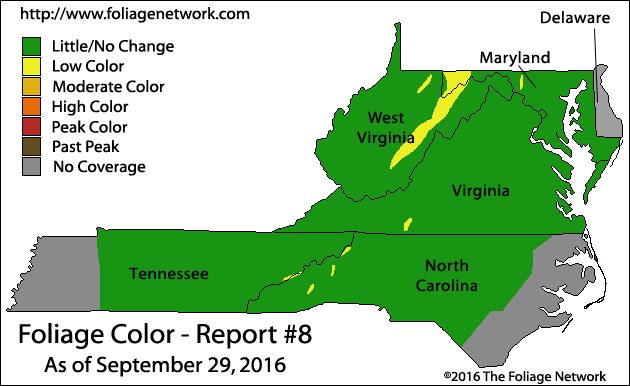
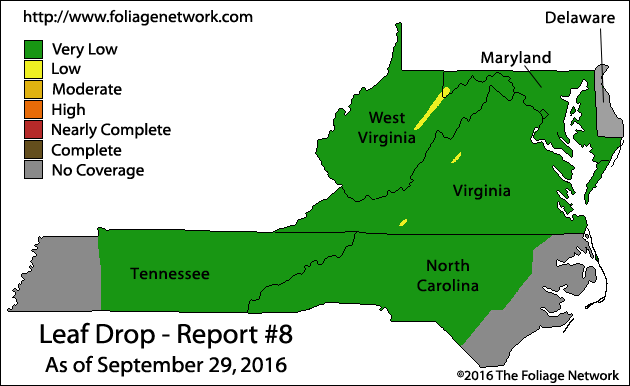
Fall Color Report for the Week of September 25, 2016 from The Fall Color Guy
It’s been hot (like 10 degrees above normal hot) for the past week and we’ve had essentially no rainfall (just a mist on three days). You can check out the history of Boone weather over the past few months here:https://weather.com/weather/monthly/l/Boone+NC+28607:4:US. We have had only 0.07” of rain since the first of September and the last rainfall of any substance was only 0.38” on August 21st. It is DRY here and the drought monitoring system now has us in a moderate drought category:http://www.ncdrought.org/hires.php while the southern portion of the mountains is in even more severe drought conditions.
These weather conditions tend to slow down and delay the onset of fall leaf colors, and when I compare this week to last week, I don’t see much of a change. There is more color development among the ornamental red maples in Boone, and a few red maples and sourwoods are turning in the woods, but aside from those, and a few sassafras, it is still very green up here.
Because of the drought, the tulip poplars, birches, and cherries are losing their leaves prematurely. In addition, I’ve seen some sugar maples with brown leaves at the tips of their branches, which suggests drought stress to me. It is supposed to rain on Mon and Tue of this coming week, and that will supply the trees with some water before they get any more stressed out, and it will bring down the temperatures to normal for this time of the year, and that should jump start color development in the woods. However, the predicted rainfall amounts are low to moderate, so this will not get us out our current drought situation.
You can also check out how scientists are studying phenology (this is when trees leaf out, flower, and lose leaves, over a season), which was set up courtesy of funding from the National Science Foundation. It is at this site:http://budburst.org/phenocam. If you go to this page (https://phenocam.sr.unh.edu/webcam/gallery/) you can see a gallery of webcam photos from around the country, each updated several times a day, and you can follow how colors develop around the country and around the world.
For my local webcam, which is a part of the PhenoCam Network, go here:https://phenocam.sr.unh.edu/webcam/sites/asuhighlands/. Note that as of today, the red maple right in the front is turning color nicely. This site is right off Highway 105 as one leaves Boone going south, and so is very representative of the High Country. The main trees in this forest are black cherry, black locust, yellow birch, and tulip poplar, plus some white pines. It will be interesting to watch, for the first time, the color change in this young forest.
Lastly, I want to thank Margaret Murphy, from Atlanta, whom I met on my hike around Price Lake today, for helping me out with Mila, the fall color dog. Mila tugs all the time we are hiking, making it difficult for me to take pictures. Margaret was kind enough to hold Mila’s leash when I wanted to take photos and I give a shout out to her for her kind help and engaging conversation as we walked the 2.3-mile trail around the lake. I highly recommend this hike for those who want an easy hike with no major rocks or hills. The trees surrounding the lake usually develop very nice color each fall too, and you can rent a canoe or kayak if you want and paddle around the lake.
Since there is little color to report this week, most of my photos focused on what’s happening on the forest floor. Lycopodiums are out and putting up their structures to release their spores, called sporophytes. These plants are also called ground pines, even though they are not pines. These primitive vascular plants, which do not produce seeds, have been around since the time of the dinosaurs! Rhododendrons are now dropping their oldest leaves, so all that yellow you see on them is a seasonal and natural occurrence. They are just getting rid of the oldest leaves. You can access my photos of my hike at Price Lake, on the Blue Ridge Parkway, at this site: https://drive.google.com/…/fo…/0BxpSVO5IUz-ESlFpNmdzM1NMRFU…
Mushrooms are doing their thing now, and the goldenrods are just getting past their peak, while the asters are currently at peak. And lastly, white snakeroot is flowering abundantly in the woods, especially along trail edges. This plant, which is highly poisonous when ingested, can get in the milk of cows if they eat this plant, and in fact, Abraham Lincoln’s mother may have died from drinking contaminated milk because her cows ate this plant.
That’s about it for this week. I expect by next week to be able to report much more color, since temperatures will be dropping nearly 30 degrees by the end of this week. Also, the Grandfather Mt. Foundation will be starting up their daily fall leaf color photos on October 1, and as I’ve done each year, I will post those on my Fall Color Guy site for you. Cheers!
Fall Color Report for Week of September 18, 2016 from The Fall Color Guy
The weather in the mountains has been above normal in temperature and below normal in terms of rainfall. The NC Climate Office predicts drought will develop throughout the mountains this fall, especially near the Georgia border: (http://www.cpc.ncep.noaa.gov/…/expert_as…/season_drought.png). The higher temperatures could slightly delay the onset of fall colors, but only by a few days, so I don’t think you’ll have to change your plans if you’ve already decided on which weekend or weekday that you’ll be coming up to the mountains. However, the drought could have more dramatic impacts, especially on the quality of the display.
Already, I’m seeing tulip poplars (Liriodendron tulipifera) trees losing massive amounts of their inner leaves, which are turning yellow and are then followed quickly by a blackening (caused most likely by oxidation byproducts, like when an apple turns brown after you bite into it). In years with adequate rainfall, tulip poplars hold on to their leaves later into the season, and near the end of a fall color season, stand as grand, yellow beacons against a gray, leafless hillside. But this year, I’m afraid that display may not come to be.
On my hike to Beacon Heights yesterday, off the Blue Ridge Parkway just east of Grandfather Mountain (and a highly recommended, short, easy, hike) I saw the beginnings of fall color, with red maples (Acer rubrum) coloring up, huckleberries and blueberries turning red, and sassafras (Sassafras albidum) on the outcrops showing nice orange-red coloration. Birches were yellowing up and blackberries (Rubus sp.) were turning a deep red in places.
Since the forests are still mostly green, the pleasure of visiting the mountains right now is more down to earth, that is, at eye-level and on the forest floor, where there is a lot happening that at peak fall color time most visitors either miss or never see for want of looking down instead of up. When I did this, I accidentally caught two moths “in flagrante delicto” (see link to my photos below). Well, birds and bees do it, and so do moths, although where these two got romantic came with a great risk of getting squashed, as it was right in the middle of the trail.
One unusual understory plant that has great color, but which most people miss if they are not being observant, is witch hobble, a native viburnum (Viburnum lantanoides) that has large, oppositely place green leaves. At this time of the year, the leaves begin to develop large purple blotches on them, in no particular or obvious pattern that I can detect, and this gives the plant a mottled appearance unlike anything else in the understory. With time, the entire leaf turns a deep burgundy to purple color, which highlights the upright, tan buds located between the two leaves. It is well worth the effort to find this plant when you’re in the mountains, as it is one of the most of our understory plants. They are scattered along the Beacon Heights trail, and also about two-thirds the way up the trail at Elk Knob State Park. I’m sure they are also in many other places, as it is very common.
One color that defines this time of year is yellow, due to the super abundance of goldenrods (Solidago sp.). There are several species here in the mountains, with some restricted to trails in the woods, and others to sunny locations along roadsides and in old-fields. They are at their peak flowering right now, and are beautiful in their own right, with the yellow flowers making a nice contrast to their dark green foliage. Note goldenrods do NOT make you sneeze, as their pollen is not what causes most people’s allergies at this time of the year. Rather, that is another plant, the giant ragweed (Ambrosia trifida). So you can look at goldenrods without stress or discomfort!
Also blooming now are a variety of fall asters (Symphyotrichum sp.) which tend to grow along woodland edges in moist places. Often interspersed with them are gentians, with their deep blue, upright pointing flowers. These diminutive plants, often less than 6” tall, are nonetheless one of the most beautiful, not to mention unusual, flowers at this time of the year.
As noted earlier, this is the peak fruiting time for Mountain Ash (Sorbus americana) and for other berry shrubs (sorry, I don’t know the species photographed on my hike (see photo link below). If you do know the species, send me the name! Red spruce (Picea rubra) are fruiting now and their resinous cones are easy to see along the edges of the northern rock outcrop at Beacon Heights. If you happen to touch one and get that sticky resin on your fingers, a solvent such as finger nail polish remover, or pure alcohol, should remove it.
Despite the drought, there was enough mist and dew yesterday at Beacon Heights to wet up the lichens on the branches of trees and on the rocks. One of the most common leafy lichens is the rock tripe (Umbilicaria mammulata), which is a dull green when wet, and a blackish color when dry. The undersides of this lichen are covered in black fungal tissue and when it dries, it folds over to show that side to the sun, possibly because that black pigment acts as a sunscreen to protect the algae that grow in the lichen (which is an organism composed of a fungal host and algal symbiont). A recent paper in Science has found that many lichens may actually have two different fungal partners to go along with the algae, a discovery that has taken the lichen community by storm (there is such a thing as a community of lichen enthusiasts!). Here’s the link to the NY Times article on this (and if makes the NY Times, it must be BIG news, right?).
http://www.nytimes.com/…/lichen-symbiotic-relationship.html…
In conclusion, I predict that starting next weekend, we will start to see noticeable changes on the hillsides at the higher elevations, such as the summit of Grandfather and other high peaks here in the Southern Appalachians, and then it will begin moving downhill and the true fall leaf color season will get into gear! Remember, at an elevation of 3,000’ to about 4,500’, the peak will be early to mid-October, especially in mountains north of Asheville up to the Virginia border. Lower elevations will peak in late October, and below 2,000’, in early November even.
This week, I’m trying something new – posting my pictures on a shared Google drive. Here is that link: https://drive.google.com/…/fol…/0BxpSVO5IUz-EU1lNUHVzZEdtMDA
As this is an experiment, let me know if it works. If not, I’ll go back to posting on Facebook again, but as you know, that program has been giving me fits lately in terms of posting pictures.
Enjoy!!
Fall Color Report for the Week of September 11, 2016 from The Fall Color Guy
Another week has passed and there have been some noticeable changes in tree leaf color, but most of this is confined to urban trees and bushes and not those out on in the forests on the hillsides. As the pictures below confirm, the ornamental red maples are really starting to turn now. They have a very peculiar pattern of turning – first from the top, and often the east side, which then works downward with each passing day until the entire tree is a bright red. Some turn a lot earlier than others.
Notice this set of red maples in the parking lot at Galileo’s in Boone, where two of them are already at peak red color, while their neighbor is still all green. This may reflect their origin, with some coming from northern stock, and others from southern stock. Northern trees planted in the south tend to end their growing season earlier than southern trees because they are probably cueing in on daylength, and down here, the days are shorter in the summer than they are up north. Hence, northern trees planted in the south “think” it’s later in the season then it really is, and hence a time of year when it is usually colder, so they shut down prematurely. For you purists, I know trees don’t “think” in the sense that people do – it’s just an expression.
A lot of sugar maples are showing flagging now – that is, a single branch or a group of branches in one part of the crown begins to change to yellow or orange while the rest of the canopy is still a verdant green. I’ve even seen some trees in the woods doing this, and since most urban sugar maples are not selected for their fall color, this is just something this species does in the fall. Deserves more study!
Virginia creeper (Parthenocissus quinquefolia) is starting to turn its usual deep, burgundy red color. This common vine, which usually grows up tree trunks, can also be a nasty invasive in your garden, where it creeps along the ground (which probably gives the plant its name!) and grows over your shrubs and flowers. However, it does turn a beautiful color and when the tree leaves fall off the tree it is climbing, you get this interesting play of red against the dark gray trunk and deep blue sky. Quite beautiful, especially in the morning when the colors stand out the most.
Did you know that Charles Darwin studied this species? He did experiments on the tendrils that the plant uses to attach to its host, seeing how much weight they could support before detaching (up to 10 lbs if I remember correctly). This plant secretes a very strong adhesive compound from pads on the ends of its tendrils upon contact with a suitable host and uses it to attach itself to the tree. The tendrils also coil after they attach which provides flexibility so that the plant doesn’t come off its host in high winds. Pretty good for an organism without a brain!
Another tree that is just starting to turn is green ash. This tree (Fraxinus Americana), can turn a deep purple color, and I’ve seen some examples of it along U.S. 421 west of Boone. Other ashes will turn yellow. And winged burning bushes (Euonymous alatus), are turning now also, which seems a little early to me.
I am concerned about the long-range forecast for this month. I heard we were to have above average temperatures in September, but when I checked some sites on the web, they say we’ll have normal temperatures, which is good. However, we’re predicted to have only sporadic rain, and it’s getting quite dry here, with some sugar maples and birches dropping their leaves. If it continues dry, we may lose some fall color to premature leaf drop, including the bright yellow tulip poplars later on. The high temperatures, if they persist, could also reduce the intensity of the red pigments some trees produce (the anthocyanins) and that could lead to a duller fall color season. It could also delay the onset of colors, as some trees continue to hold on to their leaves later into the season if it’s warm. However, there’s still time for cool weather to set in and we may yet have a really good fall color season. The next three weeks will determine that!
Lastly, as you drive around the high country, you’ll notice an abundance of bright yellow flowers. Some of those are related to black-eyed Susans, such as sneezeweed (Helenium autumnale) while those with very small yellow flowers in clusters at the tops of herbs about 3 feet tall are Goldenrod (Solidago canadensis or S. altissima). Ironweed is also out now, with its incredibly deep purple flowers (Vernonia novaboracensis or V. gigantea).
For those contemplating where to go when they get to the High Country, here are some brief suggestions. For more details, contact the tourism sites here in the area, and Asheville area too.
I’d of course, suggest driving along the Blue Ridge Parkway, anywhere, but the higher it is, the earlier you should visit, since colors start earlier the higher up you are. I’d suggest several of our state and national parks, including Grandfather Mt. (there is an access fee), Elk Knob State Park (free), Gorges State Park (free), and Great Smoky Mountains National Park. I’ll post updates on some of these as we get closer to fall color time. Also, I’d suggest the Pisgah National Forest, with its drives near Brevard and its abundant waterfalls. You can also see the Cradle of Forestry, where scientific forest management first started in the United States, on the property of the Vanderbilts, who at one time owned 125,000 acres of land near Asheville.
Have a great week!


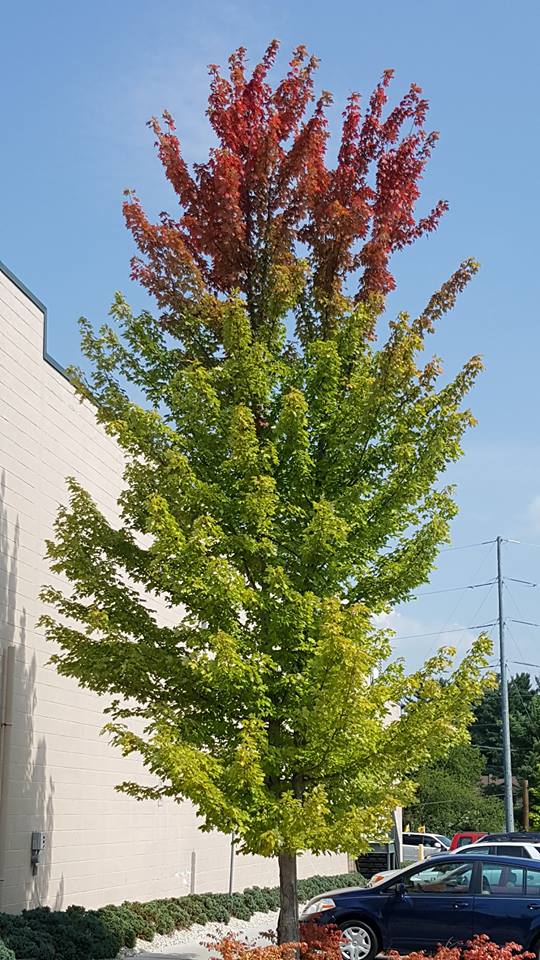
Maps via Foliage Network – http://www.foliagenetwork.net
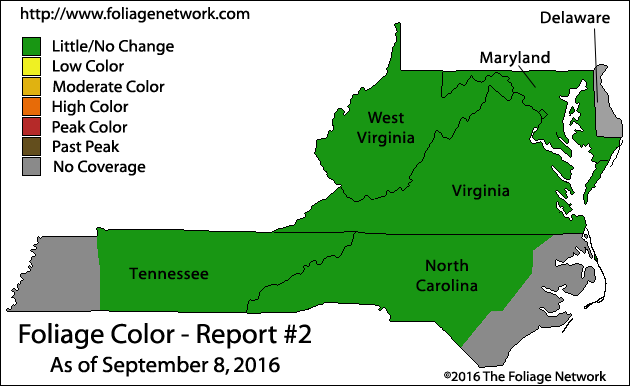
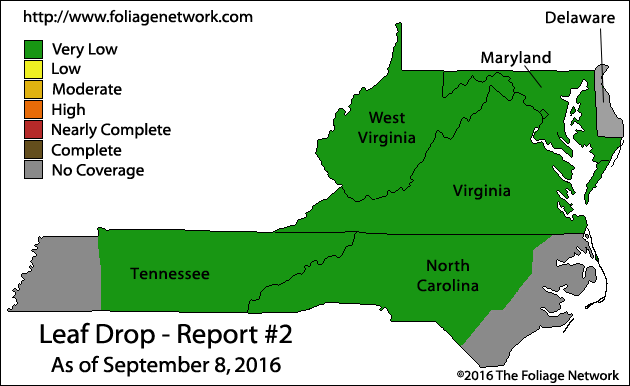
Fall Color Report for August 27, 2016
Well folks, I’M BACK!
This post marks the first official fall leaf color post for the 2016 season and I’m looking forward to yet another great fall color season. So once a week, watch for my posts.
One technical note: Although I consider myself technically savvy, I plead ignorance with regards to social media. I don’t use Twitter or Instagram (and if I do show up on those places, it’s totally by accident!). If you send me something via messaging, like Facebook messenger, I may or may not see it. So if you don’t get a prompt reply, it’s nothing personal. I just didn’t know you sent it. Best to send requests via regular postings, or email (neufeldhs@appstate.edu).
So, what’s up for this week? We are getting out of the dog-days of August (click HERE to see why they’re called that), and temperatures this week are about 10oF above normal, so that’s not good. But we’ve had sufficient rain in August to alleviate the drought conditions that were building up in July. That’s good for trees and may prevent too much premature leaf drop. What we need now is a switch to cooler temperatures, especially in September. Morning temperatures are dropping somewhat in the last week, so perhaps that portends a cooling trend.
Some trees begin turning color in August, such as sugar and red maples, and even dogwoods. Others, like buckeyes and birches and cherries start to drop leaves in late summer. But this happens every year, so I’m not worried. The maples do perplex me though, as they also hold on to their leaves late into the fall color season. I guess it reflects either genetic variation, local habitat conditions, or perhaps horticultural varieties that have been planted in cities (some red maples are bred for their fall color especially and may turn unusually early, particularly if they come from the north).
But the hillsides are still dominated by GREEN. If you want to watch the color change here in Boone, you can go to various webcams, but I suggest you watch our new webcam, which I installed this summer on the outskirts of Boone, and which is focused on a young forest. It is part of a nationwide forest monitoring program known as PhenoCam (http://richardsonlab.fas.harvard.edu/phenocam.html), run out of Harvard University, and which uses video images from cameras all around the country to determine if there are any changes in the timing of leaf flushing, duration, and loss in the fall. You can see the images for our Boone site at this web address:https://phenocam.sr.unh.edu/webcam/sites/asuhighlands/ and for all sites at this website: https://phenocam.sr.unh.edu/webcam/gallery/. Our new webcam is courtesy of a National Science Foundation Grant that my colleague, Dr. Zack Murrell, and I received this year in conjunction with three other schools: UNC-Asheville, Warren Wilson College, and East Tennessee State University. Each of those universities also has a webcam which is part of the PhenoCam network. Your tax dollars doing great environmental research!! Thanks!
For those wondering when to see colors, know that they start first at the highest elevations and then work their way down with time. At Grandfather Mt. State Park, trees will begin changing in late September at the upper elevations, and by mid-October will be peaking at about 3,500’ elevation, and at lower elevations, such as around Asheville at 2,400’, in late October. You can get a rough idea of when colors peak by going to my fall color page at this address and accessing the fall color map:http://biology.appstate.edu/fall-colors and for map:http://biology.appstate.edu/f…/fall-color-map-north-carolina.
That’s about it for now. See you next week!
For the 5th year in a row WataugaRoads.com & WataugaOnline.com is teaming up with Dr. Howard Neufeld, Professor of Plant Eco-physiology at Appalachian State University, better known as The Fall Color Guy to provide information as the colors start changing.
On Wednesday (August 24, 2016) WataugaOnline.com ask Dr. Neufeld about predictions for the upcoming fall season, and his full reply is below:
“I'm seeing some early color in the maples, and some leaf drop in birches, but nothing out of the ordinary. I don't think the drought was severe enough to cause major problems. So, I think we're on for another good fall color season. Mornings are starting to get cooler, so we're entering the typical fall weather patterns. Looking good so far!”
Dr.Neufeld shared some thoughts just before previous fall seasons that are still relevant for this, or any, fall season:
As for wet weather, there have been some publications on the impacts of weather on fall color (especially timing, not so much quality). Precipitation has only minor effects on timing in the fall. Temperature is more important. So, at this point, I don't see anything to make me think that fall colors will be adversely affected, either in timing or quality.
What happens in mid- to late August and in September, temperature-wise, will be more important, especially for quality (notably the intensity of the red colors)”.
People think fall colors are good when they last a long time, and have plenty of brilliant reds interspersed with the oranges and yellows. So, the quality will depend on how much “redness” we have this fall.
Trees tend to make more red colors (anthocyanins) in the fall when it's cool and sunny, and if we have a slight but not severe drought.
Sunny days means more photosynthesis, and more sugars produced in the leaves, and sugars induce anthocyanin production.
A slight drought impairs uptake of nitrogen (we think) and some experiments suggest that plants low on N make more anthocyanins.
Usually, fall colors peak around Oct 11-14 in the Boone area; sooner by a few days up to a week at higher elevations, later at lower ones. Nice colors can stick around for a week or more, although the peak usually comes and goes in just a few days, weather permitting (no high winds for example)”.

2016 UPDATES
For the 5th year in a row WataugaRoads.com & WataugaOnline.com is teaming up with Dr. Howard Neufeld, Professor of Plant Eco-physiology at Appalachian State University, better known as The Fall Color Guy to provide information as the colors start changing.
2015 UPDATES
For the 4th year in a row WataugaRoads.com is teaming up with Dr. Howard Neufeld, Professor of Plant Eco-physiology at Appalachian State University, better known as The Fall Color Guy to provide information as the colors start changing.
Maps via Foliage Network – http://www.foliagenetwork.net
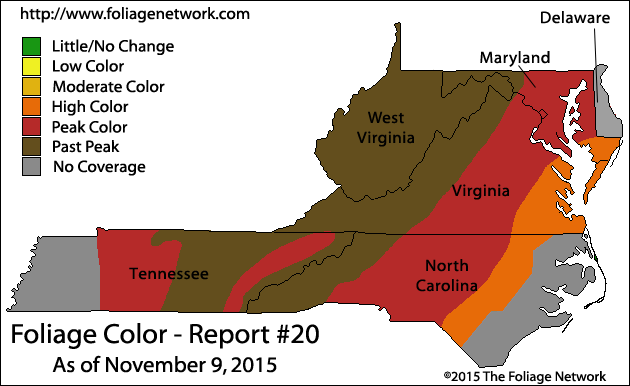
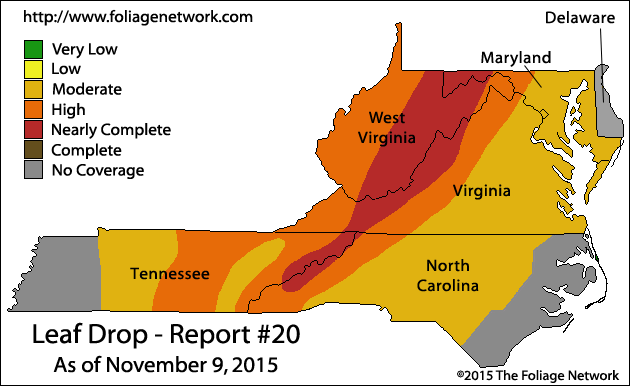
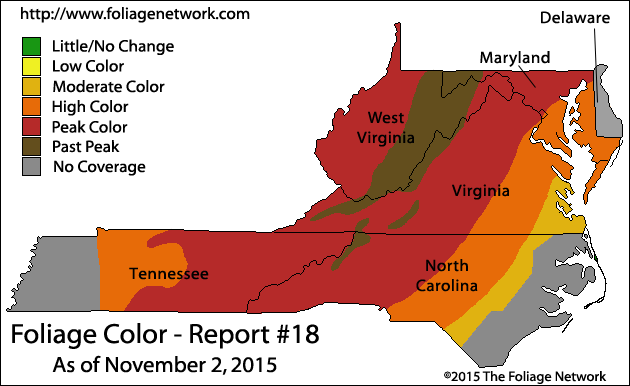
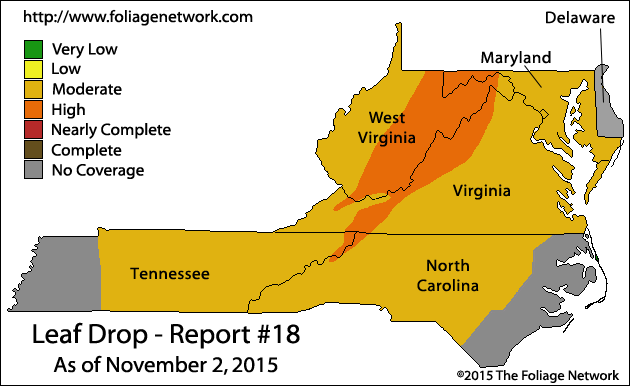
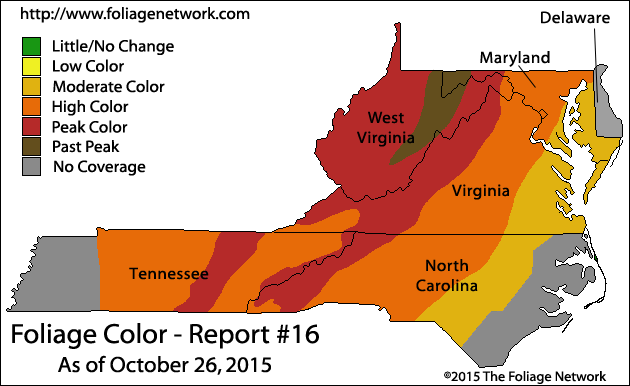
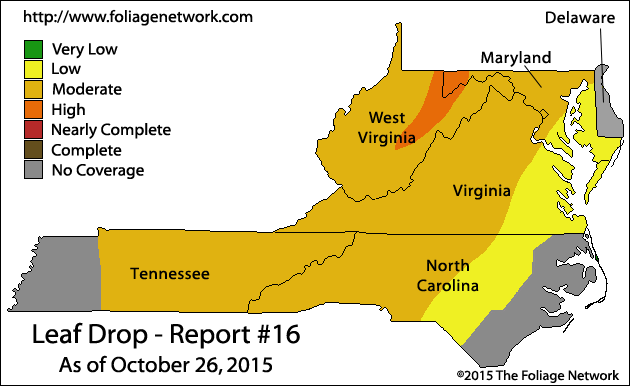
Fall Color Report for Week of October 25, 2015 from The Fall Color Guy. Check out The Fall Color Guy on Facebook :
Regarding fall leaf colors – I was pleasantly surprised at how bright the colors were along U.S. 421 in Deep Gap up to the intersection with US 221 and the Blue Ridge Parkway. As one heads down in elevation going east on US 421, the colors are spectacular down to about 2,000′. Very nice.
A drive along the Parkway from US 421 to Blowing Rock, or north to Laurel Springs would be excellent this week. Of course, the weather may not cooperate, as the remnants of Hurricane Patricia are moving in.
In the Boone/Blowing Rock area, the oaks are looking good, as I mentioned yesterday. But what surprised me was the degree of color lower down in the foothills near North Wilkesboro. More color than I had expected. Even as low down as Lexington there was a lot of color showing already. Good viewing everywhere it seems!
Maps via Foliage Network – http://www.foliagenetwork.net
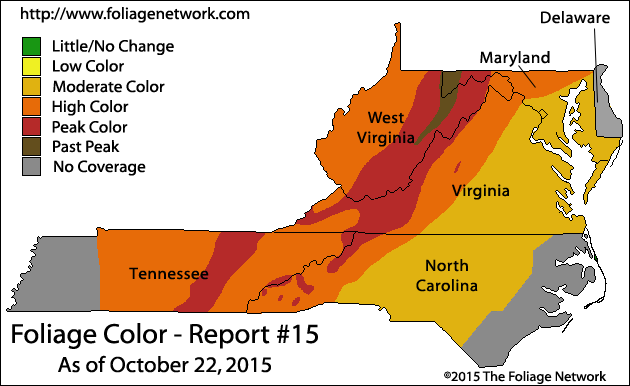
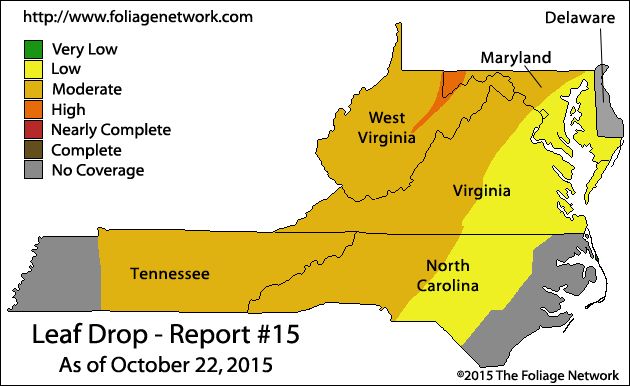
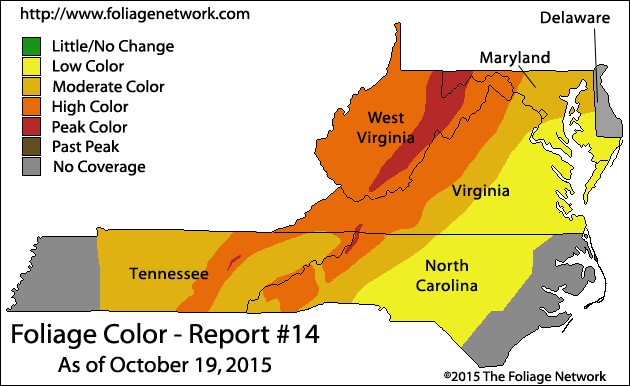
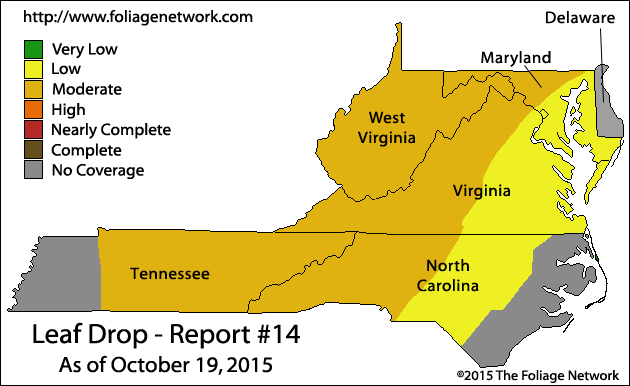
Maps via Foliage Network – http://www.foliagenetwork.net
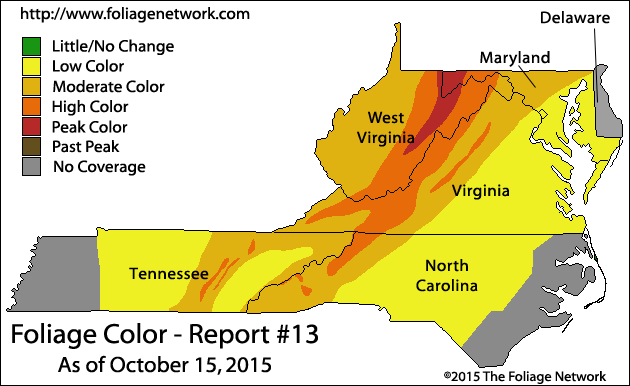
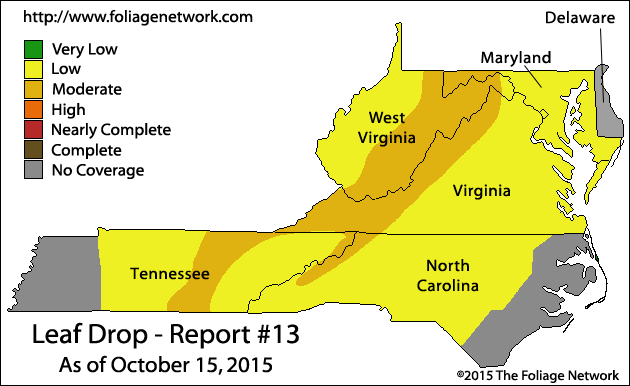
Maps via Foliage Network – http://www.foliagenetwork.net
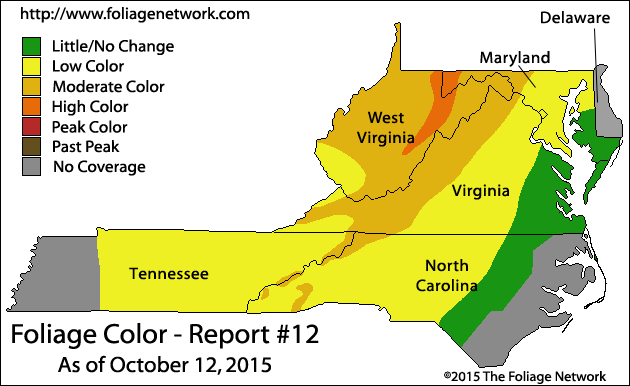
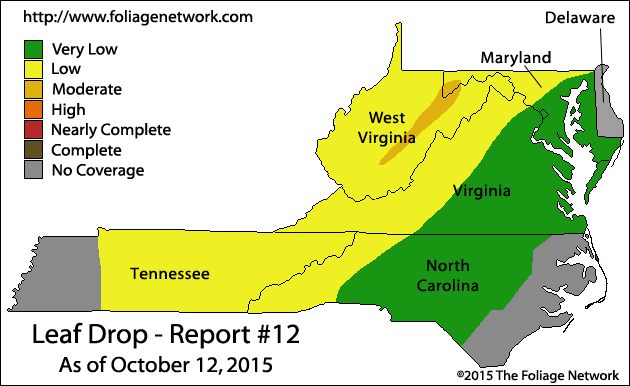
Fall Color Report for Week of October 11, 2015 from The Fall Color Guy. Check out The Fall Color Guy on Facebook and at http://biology.appstate.edu/fall-colors:
Today, the Fall Color Guy and his daughter Gabriela scouted out the Blue Ridge Parkway from the Thunderhill Overlook just outside Blowing Rock down to the Chestoa Overlook about 10 miles below Linville. It was a gorgeous day, and the Parkway was full up with leaf lookers.
This is THE PEAK WEEK for the Blowing Rock to Grandfather Mountain section of the Parkway. The same might be said for the Cashiers/Highlands area, according to my contacts down that way. Colors have exploded out over the weekend, even despite the dreary, rainy Saturday that we had. Luckily for us, there was little or no wind on Saturday, so while some leaves did come down, many stayed up, and are now turning beautiful colors.
One notable color addition this week is the black gum tree (Nyssa sylvatica). This tree turns a lovely deep red color that complements the reds of the maples, sourwoods and sassafras trees. Today, the colors were really spectacular along the Blue Ridge Parkway from below Holloway Mountain road down to the Beacon Heights parking lot. I saw a lot of reds splashed against a background of brilliant orange and yellow. Despite all the bad weather we’ve had, the trees have held their ground, and are now showing us all a magnificent display of color.
Forests below 3,000’ are still predominantly green, and so they will color up in the next two weeks, but right now, the peak color is from about 5,000’ or so down to about 3,000’. If you head south of Linville, the colors become more muted, with fewer red trees and more yellow ones (due to a change in species composition over to hickories, ash and oak). When you get past Little Switzerland, heading south toward Mt. Mitchell State Park, the colors begin to pick up again, and from there to Craggy Gardens, you’ll have great views this week up to next weekend. The same can be said for the area south of Waynesville to the Waterrock Knob area of the Parkway.
The Smokies are still working up to their peak color, and most of the lower elevations are still predominantly green. They will work up to their peak color in the next two weeks, and Gatlinburg should be at peak color at the end of this month.
You can check out the status of the fall color there at this website:http://www.nps.gov/grsm/planyourvisit/fallcolor.htm .
You can also check out their Facebook page:https://www.facebook.com/GreatSmokyMountainsNPS
Maps via Foliage Network – http://www.foliagenetwork.net
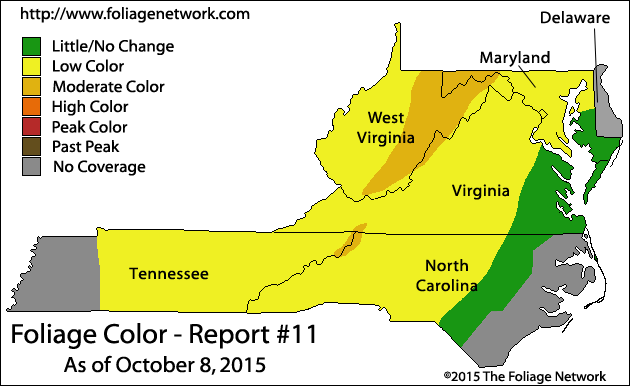
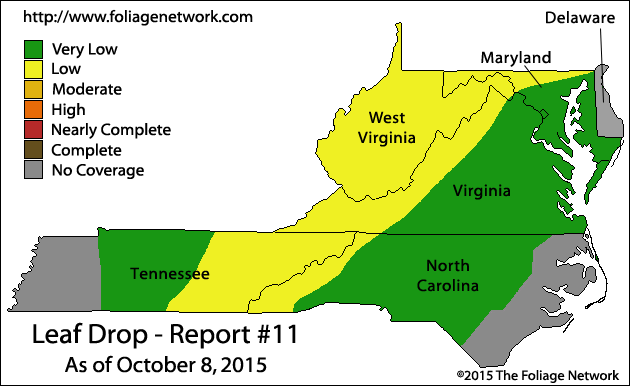
Fall Color Report for Week of October 4, 2015 from The Fall Color Guy. Check out The Fall Color Guy on Facebook and at http://biology.appstate.edu/fall-colors:
That pesky low pressure system that has been plaguing the southeast is still with us this week, but today it seems to be showing signs of dissipating. For one brief instant, late this afternoon, I actually saw the sun! We’ve had something like 12 straight days with clouds/mist/rain, exactly the wrong weather for good fall leaf colors. However, the saving grace is that this all occurred when the majority of trees in the High Country were still green, and were holding onto their leaves tightly. Thus, even though there is a lot of debris on the ground from the rains and winds, many of the trees, especially those at mid-elevations (2,500’ to 4,000’, i.e., Boone/Blowing Rock area) still have their leaves. And because the weather will improve starting tomorrow, getting sunnier and warmer, I predict that those trees will quickly begin turning color.
However, I have to be honest – after my travels today, I was amazed at just how many leaves have been taken off the trees. In some places, I’d estimate 20%-40% of the leaves had been knocked down, mainly from just two species: yellow birches and tulip poplars. There are some maple and magnolia leaves on the ground too, but the birches and poplars probably make up 90% of the fallen leaves.
The other important observation from today is that in the Boone/Blowing Rock area, many of the hillsides are now 50% to 70% colored up, much more than I expected. To me this means that as the weather improves and gets sunnier and drier, colors will rapidly approach their peak for the High Country, perhaps by the end of this coming week and into that trailing weekend (Oct 8 – 10th), with good color still persisting into that following week (Oct 11-15th). I’m not seeing a lot of reds (which is what happens when it gets cloudy/rainy), so I’m inclined to knock down my prediction from being an exceptional year to just a very good year.
Higher elevations were already starting to turn color prior to this episode of bad weather, especially around Grandfather Mt., and at other sites along the Blue Ridge Parkway, such as Graveyards, Waterrock Knob, and Craggy Gardens. However, if you go to those sites, and the leaves are gone, they still offer wonderful trails for hiking to overlooks, and from them you can view the fall leaf colors at the lower elevations.
This past week, the birches really began yellowing, along with the tulip poplars and magnolias. By the way, magnolias and tulip poplars are closely related and among the more ancient flowering plants, so it’s not surprising that they both change colors at near the same time, and that both turn yellow, although the magnolias quickly morph over into a lovely chocolate brown.
Our sugar, mountain, and red maples are also turning colors now. Mountain maple, a lesser known maple species, turns an interesting orange/red color. It is found mainly at higher elevations, and is a prominent species along the road in Grandfather Mountain State Park. It doesn’t get as big as some of the other maples. Sugar maples can turn a variety of colors, ranging from yellow to orange to red, while red maples essentially produce just red leaves. Along U.S. 221 between Pineola and Linville are some really large sugar maples, just off the highway, that are turning a nice yellow color now.
Sourwoods, if not already a deep burgundy red, are switching over to that color now, as are sassafras, which like sugar maples, can have every color on them at one time. Hickories tend to turn a dull yellow then brown, and I’m afraid they are not one of my favorite fall color trees. A bright spot in the forests, at eye level, is witch hazel, an interesting understory shrub that is common throughout the southern Appalachians. Not only do the leaves turn a golden yellow, speckled with brown, but it is one of the only plants that flowers at this time of the year. The flowers are composed of curly yellow filaments which are the petals. Its pollinator is a small moth.
Stay dry and have a great week!
Maps via Foliage Network – http://www.foliagenetwork.net
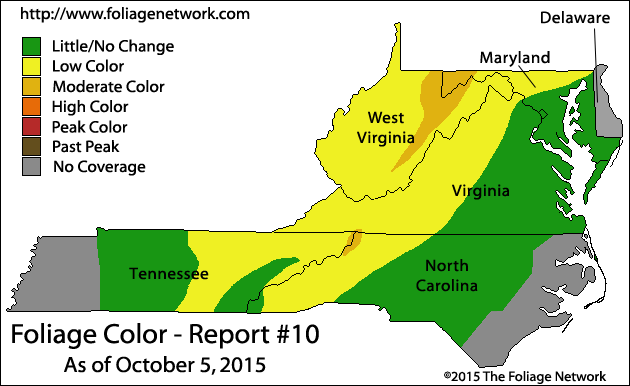
Fall Color Report for Week of September 27, 2015 from The Fall Color Guy. Check out The Fall Color Guy on Facebook and at http://biology.appstate.edu/fall-colors:
Starting on Thursday of this past week, a low pressure system became stalled off the east coast of the Carolinas, bringing substantial amounts of rain and wind all the way into the mountains of western North Carolina and Tennessee, plus upstate South Carolina and Georgia. However, the cloud cover also moderated low nighttime temperatures, and while it has been cool during the days, it hasn’t been getting as cold at night like it did prior to these rains. When there are clear skies, infra-red radiation (heat) can escape into space, resulting in cold mornings.
As a result, the development of fall leaf color has slowed down this past week, something that I had mentioned could happen. This means that we are probably back on a regular schedule for peak leaf colors, meaning that colors will peak during the first week of October at high elevations (4,500’ or above), around mid-October (the 10th through the 16th from 4,500’ to 2,500’), and during the last week of October in the Asheville area (~2,000 – 2,500’).
It has rained continuously since Thursday of this last week, and the weather forecast for the entire coming week is somewhat bleak – at least a 30% to 50% chance of rain every day until Friday (even thunderstorms on Tuesday!), with moderate temperatures every day. This will probably keep the rate of fall leaf color development at a slow pace, but not stop it. So, be patient. The rain, which we need, will abate by the following weekend, and that weekend should be the first really good one for full-fledged fall leaf color viewing. One thing in our favor is that all this rain has occurred prior to the leaf color peak, when the leaves are still held on the trees fairly strongly. So while some leaves have come down during this recent stormy spate, the majority that have not yet turned color are still attached tightly to the trees. So, I’m optimistic that we’ll have plenty of leaves left for a great fall color display in the next few weeks.
Fall Color Photos from Grandfather Mountain (Monday Sept 21-Wed Sept 23)
Fall Color Report for Week of September 20, 2015 from The Fall Color Guy. Check out The Fall Color Guy on Facebook and at http://biology.appstate.edu/fall-colors:
It has been delightfully cool here in the High Country for the past 10 days or so, especially in the mornings. It has also been very sunny. And as I’ve said for many years, if you get cool, sunny weather in September, you’re headed for good fall leaf color. And we’re getting it! So, if this keeps up for the next few weeks, we should be headed for a really, really, good fall leaf color season!
Color has burst out this week here (and burst is the appropriate word!). Last Sunday, I said the word to describe the forests then was “green”. But now, just one week later, the hillsides are showing color, some of it quite good. The best color so far is between Grandfather Mountain and Rough Ridge along the Blue Ridge Parkway. For some reason, this area always develops the brightest colors, and does so first in the High Country. I’m not sure why, but every year it develops before other areas. So, right now that is the best section of the Parkway to see some good color, although I was told by one person that north of Doughton Park on the Parkway (toward Virginia), color was good along that stretch of the road. Price Lake is starting to show color also, which is just south of Blowing Rock.
What trees are showing now? Yellow buckeyes are losing their leaves now in droves, and they turn a mucky-yellow/brown. Buckeyes are among the first trees to leaf out and among the first to lose their leaves in the fall. Way back, when I had dark black curly hair, a friend and I even published a scientific paper documenting this pattern on some understory buckeyes. The yellow buckeyes are producing their seeds now (the buckeyes) which make great souvenirs, but don’t eat them – they’re toxic.
Maples have started turning, and not just in town, but in the woods too. Sourwoods are already mostly red, sumacs are starting to turn along the roadsides, and pin cherrys are orangy/red now. Some of the tulip poplars are showing hints of yellow, but the Fraser magnolias are ahead of them and already turning yellow before they shift over to chocolate brown. Witch hazels are just beginning their transition to yellow leaves, and they are also blooming now (one of the only shrubs that flowers in the fall season). Sassafras are starting their color transition, and you can find leaves that are yellow, orange, or red, all on the same tree! Lots of shrubs are turning now, especially the huckleberrys and blueberrys, which are a spectacular red at this time of the year.
If I were to rate the degree of color change now in the High Country, I’d say it would be a 1 on a scale of 10. Although this week may cause some to think the colors will be early this year, I caution that a warm up in the next few weeks could delay it and put it back on schedule. So, at this point, I’m still predicting that peak color in the Boone/Blowing Rock area will still be mid-October.
I’ll post some observations for the southern mountains in the next day or so. So, keep reading and we’ll hope to see you all sometime this fall.
Fall Color Report for Week of September 13, 2015 from The Fall Color Guy. Check out The Fall Color Guy on Facebook and at http://biology.appstate.edu/fall-colors:
Still green out there! But! This morning it was 48 F at my house, and probably several degrees colder at the higher elevations on the Blue Ridge Parkway. A cool front has moved in and dropped temperatures substantially, which is good for fall color development. But there hasn’t been much change in the leaves since last week, although a few plants are showing color prominently now, especially up on the ridges near Grandfather Mountain.
Today, I hiked the Rough Ridge trail, which is just north of the Linn Cove Viaduct on the Blue Ridge Parkway. If you haven’t done that trail, I highly recommend it. You do have to watch your footing in places, but the dangerous overlooks (at least some of them!) are bounded by a cable and I didn’t get too close to the edges. In my next post, I will put up an album of pictures from today’s walk.
So, what’s changing now? In town, the planted red maples, often a horticultural variety that emphasizes their brilliant red fall colors, are really starting to show. These trees first turn red in their upper half, creating a bicolored tree for a while, before the colors move to the lower half. The sourwoods are also changing to red, and of course the dogwoods are already there. On the Rough Ridge trail, the huckleberries are starting to turn deep red, as are some trees that unfortunately, I don’t know what are (help if you can, see the album following this post!). Chestnuts (Aesculus octandra, not American chestnut) are dropping their leaves now, and are always among the first trees to do so each fall.
That’s about it for now. With this cool front moving in, I expect to see color changes pick up in the next two weeks. I’ll keep you posted!!
Maps via Foliage Network – http://www.foliagenetwork.net
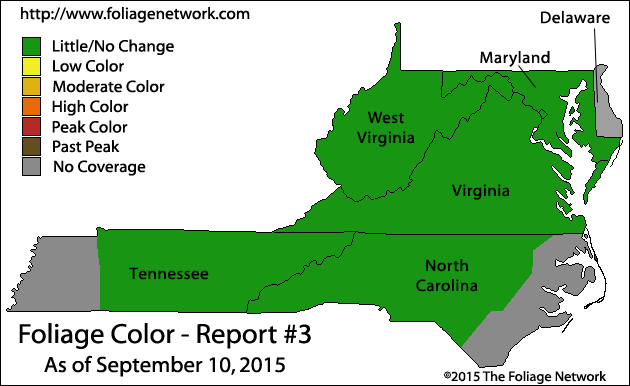
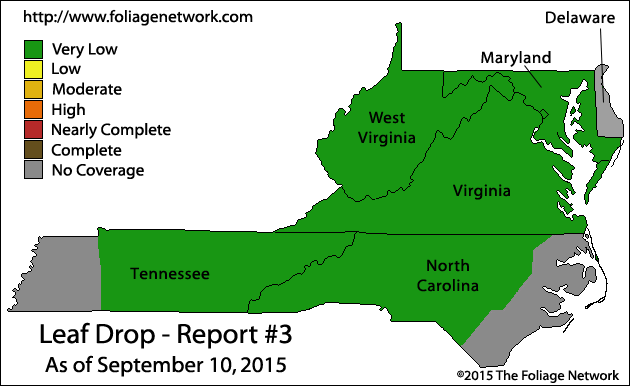
Fall Color Report for Week of September 6, 2015 from The Fall Color Guy. Check out The Fall Color Guy on Facebook and at http://biology.appstate.edu/fall-colors:
The word for this week is …. “green”. Although this is the Labor Day weekend, the plants are still laboring and by that, I mean still doing photosynthesis and converting carbon dioxide into sugars and starches. However, there are a few plants that have started to turn early, so if you come to the High Country in the next few weeks, you’ll be able to see a little color. But for now, the hillsides are still dominated by the color green.
The main turning plants are some maples (just a few though), and huckleberries (on the rock outcrops mainly) and some sassafras which are showing orange and red coloration. Most everything else is still green. I did see a Viburnum beginning to turn its usual deep orange, but it was an isolated occurrence, and although I saw one patch of red Galax, all the rest were still deep green.
It’s been warm during the days while the mornings have been cool. These are near perfect conditions for a good fall color season. I’ve noticed a few tulip poplars showing some yellow, which may indicate some effect of the earlier dry period that we had in July, and our dogwoods continue to deepen their burgundy red leaves even more. But everything else looks great, and so at this point in time, I’m optimistic that we should have good fall leaf color in October.
I’ll post an album of my best pictures from today’s hike on the Beacon Heights trail. This is a short, but highly recommended trail, right off the Blue Ridge Parkway east of Grandfather Mountain. The rock outcrops afford great views of the forests in the Wilson Creek drainage to the east and there are abundant witch hazel, one of the few plants that flowers in the fall.
So, until next week, enjoy the rest of your Labor Day Holiday!
Fall Color Report for Week of August 30, 2015 from The Fall Color Guy. Check out The Fall Color Guy on Facebook and at http://biology.appstate.edu/fall-colors:
As the end of August approaches, we’re starting to see the very beginnings of fall color, but only sporadically. The forests are still quite green and lush, but the sentinels, those early turning species, are letting us know that bigger things are in store over the next few weeks. Burning bushes are starting to turn their vivid red (Euonymus alata), and dogwoods (Cornus florida) are slowly turning a deep burgundy red. There are a few scattered sugar and red maples that are turning now, but these the exceptions, rather than the rule. In Boone, along Rivers Street, many of the sugar maples turn early, but I think this is due to stresses resulting from the steam line running along the road, plus road salt from last winter, and compacted soils. Finally, two of our most notable vine species, poison ivy (Toxicodendron radicans) and Virginia creeper (Parthenocissus virginiana) are starting to turn. Poison ivy turns an orangy-red color, while Virginia creeper turns a brilliant red. Because they turn so early, the trees that they climb up are still green, so it’s a nice display of Christmasy colors here early in the fall color season.
A recent trip to Howard’s Knob this past Thursday, which is 4,400’ in elevation, or about 1,000’ higher than the town of Boone, showed the forests there to still be very green. I’ll check out Grandfather Mt. this week, because it’s nearly 1,500′ higher than Howards Knob, and colors will start earlier there than just about anywhere else here in the High Country. Fall colors begin to develop first at higher elevations (which are colder), and then they move downhill, about 1,000′ every 7-10 days later. The lack of color change at Howards Knob shows that we’re still at least a week or two away from wide-scale color changes here in the Southern Appalachians.
As I noted in several previous postings, the weather over the next four weeks (essentially September) can have a large influence on the timing and quality of fall leaf color. For the upcoming week, the situation is mixed – there is a chance of rain nearly every day (but except for Monday, is less than 40%). Temperatures will be in the high 70s and lows around 60F, which is not too bad. If morning temperatures keep dropping through September, that will be good news for fall color development. Here’s the official National Weather Service forecast site: http://forecast.weather.gov/MapClick.php
As you may or may not know, there is a strong El Niño forming off the west coast of South America. An El Niño event occurs when westward winds slow down off the west coast of South America. This reduces upwelling of deep ocean cold waters and as a result, the upper Pacific Ocean heats up more than normal. This year NOAA predicts a strong El Niño, with heating of up to 2C more than normal (or about 3.6F).
These events often cause weather changes around the world, and can affect our fall and winter weather patterns. The NOAA El Niño prediction center says this about effects on the United States: “Across the contiguous United States, temperature and precipitation impacts associated with El Niño are expected to remain minimal during the remainder of the Northern Hemisphere summer and increase into the late fall and winter (the 3-month seasonal outlook will be updated on Thursday August 20th). El Niño will likely contribute to a below normal Atlantic hurricane season….”
The Climate Prediction says that past El Niño effects result in warmer, but drier falls in the Southeastern United States. See these maps:
Temperature:
http://www.cpc.ncep.noaa.gov/…/…/enso/elnino/UStrank/ond.gif
Precipitation:
http://www.cpc.ncep.noaa.gov/…/…/enso/elnino/UStrank/ond.gif
So, while mild drought favors more intense red fall leaf colors, warm temperatures have the opposite effect, and can delay the onset of peak colors. However, when I review my notes for past years, I don’t see the peak timing varying by that much. It may be delayed a few days when warm, or advanced when cold, but only by 3-4 days. So generally, the peak occurs nearly the same time each year, which for the Boone area, is mid-October (12th-16th usually), the last week of September or first week of October for the highest elevations on Grandfather Mt. and the last week of October in the Asheville area, which is at an elevation of about 2,400’.
Happy End of August!
Fall Color Report for Week of August 23rd, 2015 from The Fall Color Guy. Check out The Fall Color Guy on Facebook and at http://biology.appstate.edu/fall-colors:
Although it is technically still “summer”, there are signs that the trees are getting ready for fall and winter. Here in the High Country (otherwise known as the Paradise of the East), the dogwoods have already started turning their deep red. The photo attached is of three trees growing across the street from my house. They are among the first trees to turn each year. Some red and sugar maples, which are also early turners, have begun to turn orange-red or yellow, although this is quite sporadic in the forests. I’ve noticed that the same trees always turn color early each year, and so it’s either genetic, or, they are growing in a spot that stresses them and induces early leaf coloration.
Of course, the black locusts are now almost totally defoliated (those are the numerous brown trees you now see lining the highways), but this is due to an insect known as the black locust leaf miner (a mining insect eats out the leaf between the upper and lower surfaces, like a miner tunneling through the soil). It’s a native insect and the trees come back each year without problem. We do have to contend in some areas with the tulip poplar weevil – see my previous posting on that. But it’s not widespread, and shouldn’t be a problem in most areas.
2015 UPDATES
For the 4th year in a row WataugaRoads.com is teaming up with Dr. Howard Neufeld, Professor of Plant Eco-physiology at Appalachian State University, better known as The Fall Color Guy to provide information as the colors start changing.
Unlike in 2013 with the record setting rain, and in 2014 with much cooler temperatures, it appears that 2015 is just right. Recently WataugaRoads.com ask Dr. Neufeld about predictions for the upcoming fall season, and his full reply is below.
“As for predictions, at least at this point, I don't see any weather problems – it's not too dry or too wet, although it has been hot. The one new development has been the explosion of the population of yellow poplar leaf miners, which have been attacking these trees, turning their leaves a bronze/brown color. This is a native insect and for some reason, especially along the I-40 corridor from Old Fort to Asheville, they are very abundant. It looks like the trees are turning color for the fall there. I confirmed the cause with the US Forest Service, and it's also widespread, going as far north as West Virginia this year. Otherwise, I don't see any major flags against having a good fall leaf color season this year.”
Dr.Neufeld shared some thoughts just before previous fall seasons that are still relevant for this, or any, fall season:
As for wet weather, there have been some publications on the impacts of weather on fall color (especially timing, not so much quality). Precipitation has only minor effects on timing in the fall. Temperature is more important. So, at this point, I don't see anything to make me think that fall colors will be adversely affected, either in timing or quality.
What happens in mid- to late August and in September, temperature-wise, will be more important, especially for quality (notably the intensity of the red colors)”.
People think fall colors are good when they last a long time, and have plenty of brilliant reds interspersed with the oranges and yellows. So, the quality will depend on how much “redness” we have this fall.
Trees tend to make more red colors (anthocyanins) in the fall when it's cool and sunny, and if we have a slight but not severe drought.
Sunny days means more photosynthesis, and more sugars produced in the leaves, and sugars induce anthocyanin production.
A slight drought impairs uptake of nitrogen (we think) and some experiments suggest that plants low on N make more anthocyanins.
Usually, fall colors peak around Oct 11-14 in the Boone area; sooner by a few days up to a week at higher elevations, later at lower ones. Nice colors can stick around for a week or more, although the peak usually comes and goes in just a few days, weather permitting (no high winds for example)”.
2014 UPDATES
November 2, 2014 – With the high winds and snow over the weekend the fall colors are pretty much all gone, and with them this will also conclude updates on this page for the 2014 season. Thanks for taking the time to check out the updates each week and the great feedback that WataugaRoads.com has received.
Last report from the Fall Color Guy on Saturday Nov 1:
“Well, folks, no reports for today! I'm sitting at home looking at the 6” of wet, heavy snow that is still falling here in Boone! Not exactly the ideal conditions to go out and look at fall leaves! I'll post some photos later today. Amazing weather!
On another note, this essentially ends my fall leaf color forecasts for the mountains of NC for this year. Colors are now off the mountain, and should they survive this snowstorm, should be good at the 2,000′ to 2,500′ level now in places like Chimney Rock State Park, and other locales at that or lower elevations. Colors will now move into the Piedmont areas for the next two weeks.
I may post the occasional blurb for those areas still experiencing good colors, but most will be fairly far away from me, so I won't be able to provide firsthand knowledge.
It's been an up and down year – we had really great colors here in the High Country, at least in the Boone/Blowing Rock/Grandfather Mt area, although right at peak color we had several wind and rain storms. But surprisingly, many trees held on to their leaves, and the color season actually was lengthened by delayed leaf fall, something I didn't expect.
Hope those of you who made it up here had a good experience, and if not, well, there's always next year!! Cheers!!”
Maps via Foliage Network – http://www.foliagenetwork.net


Photos: Grandfather Mountain
October 26

October 25 – Water flows over the upper falls at Linville Falls en route to the 45-foot plunge. (Photo by Skip Sickler)


Graphic: Brad Panovich – NBC Charlotte
Photo: Grandfather Mountain
October 24 – A line of colorful maples stands outside the Old Cranberry School in Avery County, N.C., while windswept leaves create patterns along the ground. (Photo by Skip Sickler)

Maps via Foliage Network – http://www.foliagenetwork.net


Photos: Grandfather Mountain
October 23 – Fall colors envelop a barn on U.S. 221 between Crossnore and Linville Falls in Avery County, N.C. (Photo by Skip Sickler)

October 22 – The Linville River winds through colorful trees near Erwin's View Overlook at Linville Falls. (Photo by Skip Sickler) This moderate, 1.6-mile trail offers four overlooks for hikers to enjoy sights of autumn leaves and the falls.


Maps via Foliage Network – http://www.foliagenetwork.net

Photos: Grandfather Mountain
Oct 21 – Fallen leaves gather on a mushroom-ridden log near Grandfather Mountain. (Photo by Skip Sickler) At the highest elevations in western North Carolina, visitors are increasingly finding the most beautifully colored leaves cascading toward the ground.

Oct 20 – Views of Grandfather Mountain from the Flat Rock Trail off the Blue Ridge Parkway prove that fall color is not ready to disappear just yet. (Photo by Skip Sickler) Pockets of autumn color are becoming much more isolated in northwestern North Carolina, so visitors hoping to see the splendor should make haste to the mountains.
Fall Color Report Update on Saturday October 18, 2014 from The Fall Color Guy. Check out The Fall Color Guy on Facebook and at http://biology.appstate.edu/fall-colors:
Here's my report from my drive today:
Gab and I took a drive all the way down to Maggie Valley, where we chowed down on BBQ at Butts on the Creek before heading up to the Blue Ridge Parkway (BRP). We took the BRP from there to Asheville, about 71 miles of driving. Prior to that, as we headed along I-40 through the Asheville area down to Exit 20, it was apparent that the trees were still developing their color –we saw a lot of green, although the upper elevations had some color on them. However, this drive never has great color, since it’s lower in elevation than other areas, and there is a preponderance of tulip poplars (yellow/brown) and oaks (brown, burnt yellow, rust red).
On the BRP, which in this section runs above 4,500’ for much of its length, most of the hardwood trees at the highest elevations are already leafless. However, from the many overlooks, you can see more colorful forests about 500’ to 1000’ lower down, and in fact, the best color is found in the mid-elevations, but only sporadically. Some hillsides are bare, or with weak color, while others, probably those that are more protected, have nice color, with a good mixture of reds, yellows and oranges. This part of the mountain chain has more oak-hickory forests than those in the Blowing Rock/Grandfather Mountain area, and hence less spectacular color (much less red). However, the large swaths of yellow, burnt yellow, and even brown, make for a brilliant color display nonetheless, especially when the sun shines on the trees, just minus the reds that you see more often in the Blowing Rock/Grandfather area.
The vistas from this part of the Parkway are among the best anywhere on the road. Although the viaduct by Grandfather is the most popular part of the BRP, the views from the BRP south of Asheville are sweeping in their grandeur, magnificence and extent. At some overlooks, you peer right into the Smokies, with others, south to Whitesides and even into north Georgia. The lack of development in this area provides you with sweeping vistas of what look like endless ranges of mountains and forests. I was most impressed. At milepost 417, you get a striking view of Looking Glass Rock, a large granite extrusion. Either early in the morning or late in the evening are the best times for photographing this volcanic remnant. Anyone ever climb the face? Must be challenging.
Other great viewing and hiking spots on this section of the BRP include Waterrock Knob and Graveyard Fields. At Waterrock, a half a mile to an overlook provides you with vistas of more than 70 miles on a clear day. Graveyard Fields has streams and waterfalls and some really nice hiking at high elevations. Just before this, the road crests at its highest point at 6,053’ above sea level.
This was probably the best weekend to see colors on this section of the BRP. By next weekend, more leaves will be down, although colors may be better below 2,000’ by then. The Smokies are also still approaching their peak, so head on over to Cherokee and take the road up to Clingmans Dome and Newfound Gap. You’ll pass through green forests at the bottom, good color at mid-elevations, and then forests past their peak above 3,500’.
I’ll post an album of some shots from my drive today on the BRP. Another good drive is through Brevard into the Pisgah to check out their waterfalls and leaf colors. Should be ok in the next week to the coming weekend.
As for the Blowing Rock/Boone area, high elevations are past peak, but some mid-slopes still have color, although the reds are muted now, and they are mostly yellow/orange now. These colors should persist for at least one more week, but each day sees less and less color now. Better colors are now below 3,000’
That does it for this week! Sunday promises to be sunny with some clouds, but a small chance of a shower (it’s raining lightly as I write this at 10 pm, Saturday). Enjoy!!
Fall Foliage Interactive Map from SmokyMountains.com
Fall Pictures courtesy of Grandfather Mountain
October 18 – Green and gold intermingle on this hillside in Valle Crucis, N.C. (Photo by Skip Sickler)

Fall Color Report Update on Friday October 17, 2014 from The Fall Color Guy. Check out The Fall Color Guy on Facebook and at http://biology.appstate.edu/fall-colors:
In a brief drive around Boone this morning, it is apparent to me that the leaves are now past their peak in this area. This does not mean that a drive on the Parkway is out, only that the best color will most likely be at or below the road itself. The rains and winds have taken down many leaves at higher elevations.
My contact in Asheville reports that color is developing there. Here is his brief statement: “Lot's of color north of Asheville in Barnardsville/Dillingham area. Looks like color going up the mountains to the Craggies. Peak probably in the next couple of days. In town, there is color, but still a lot of green. Peak will probably be sometime next week or weekend.”
Lastly, I searched for signs of any clouds this morning and guess what – I couldn't find a single one! All sunshine up here!!
Fall Pictures courtesy of Grandfather Mountain
October 17 – Psychedelic sumac trees line the side of a rural road in Avery County,
N.C. (Photo by Skip Sickler) This beautiful tree, unrelated to poison
sumac, produces a red fruit in late summer similar in shape to the magnolia tree's fruit.
The abundance of fall color right along the roadside will make driving the
High Country a treat this weekend amid pleasant temperatures and sunshine.
While trees at the upper elevations of the High Country have peaked, lower
elevations and views into the valleys below should offer stunning color
for several more days to come.

Fall Color Report for Week of October 12, 2014 from The Fall Color Guy. Check out The Fall Color Guy on Facebook and at http://biology.appstate.edu/fall-colors:
Well, Mother Nature hasn’t been cooperating lately. Today (Saturday) was quite rainy early on, and very windy at the high elevations. This has caused a lot of leaves to drop off, BUT, there is still great color up here in the High Country. So, don’t be discouraged. If you’re planning a visit, come on up!
Fall leaf colors are peaking right now below 4,500’ down to about 3,000’, which is the elevational range enveloping most of the Blue Ridge Parkway. Above 4,500’ many of the leaves have already fallen. Elsewhere, the colors this year are spectacular. My daughter and I rate the display this year about a 9 out of a scale of 10. The red maples, sourwoods, sugar maples, and blueberries and huckleberries are very showy this year. The reds are especially brilliant, and provide a striking contrast with the yellow and orange colored trees on the landscape. Sassafras are showing bright yellow, orange and red leaves (this is one tree whose leaves can be almost any color), and the witch hazels are now bright yellow with brown streaks along the veins. I found one cottonwood which was a bright yellow also. Birch and tulip poplars are now quite distinctive with their yellow leaves. Fraser magnolias, which have very large and showy leaves displayed in whorls, stand out also. The leaves of this tree first turn yellow and then morph to a deep chocolate brown, providing a strong contrast with the other species that turn the more traditional red, orange and yellow.
The showiest displays right now are around Grandfather Mountain. The western flank, as seen from Rt. 105, is particularly showy, although there are few places to stop and view these forests. The forests on the eastern flank, adjacent to the Blue Ridge Parkway, from Green Mountain south past the viaduct to Beacon Heights are superb; the best colors in the area so far. As you go north toward Blowing Rock, the colors have yet to peak, although there is good color up to US 321 and then further north to US 421. However, they are not as colorful as the forests down by Grandfather Mt.
Surprisingly, areas below 3,000’ are still approaching their peak colors. Many of us thought that the unusually cool summer would advance the color development this year, but in fact, both here and up and down the east coast, colors are actually behind their normal time schedules. Why this is so, we don’t know. But it does give you more time to view the colors if you haven't made a trip to do so.
As for the coming week, we will see the colors peak in the Boone/Blowing Rock area, as well as in Cashiers/Highlands as well as along the high elevations of the Parkway from the Smokies to Mt. Mitchell. Next weekend will still have great color in most areas except those above 4,500’. However, the weather people are calling for more rain in the coming week, so best to check ahead for weather conditions before heading out.
Fall Pictures courtesy of Grandfather Mountain
October 16 – Vivid red blueberry bushes, dark green rhododendrons and the oranges and yellows of autumn trees provide a kaleidoscope of color at Beacon Heights off the Blue Ridge Parkway. (Photo by Skip Sickler)

October 15 – Downstream from the Mill Pond in Banner Elk, runoff from Tuesday's storms gushes among the still-colorful trees. (Photo by Skip Sickler)

October 14 – Heavy fog and rain greets visitors to the High Country today, but the autumn colors provide a cheery glow in moments when the veil lifts briefly. (Photo by Skip Sickler)
October 13 – Water droplets collect along the stems of a burning bush (Euonymus alatus) at Grandfather Mountain. (Photo by Kellen Short) While the bush is considered invasive in some parts of the United States, it's hard to deny its autumn allure as the dark green leaves turn to vivid red in fall.
October 12 – A sugar maple shines in glorious gold and green outside the Old Hampton
Store in Linville. (Photo by Skip Sickler)
October 11 – A deer ambles through the animal habitat at Grandfather Mountain as if
admiring the autumn splendor around her. (Photo by Skip Sickler) In the
High Country, residents are beginning to take note of another color change
that signals the presence of fall: the transition of the deer's fur from
tan to gray.

October 10 – While fall color is reaching peak on the high-elevation ridges of
Grandfather Mountain, the lower elevations around Grandfather Lake prove
that they still need several more days to mature. (Photo by Skip Sickler)
The Blue Ridge Parkway remains a beautiful drive this week, with more
change now visible in the Boone area and toward Deep Gap.
Maps via Foliage Network – http://www.foliagenetwork.net


Fall Pictures from Grandfather Mountain
October 9 – Fall colors dance on the edge of the lake at Camp Yonahnoka, just south of
Grandfather Mountain in Linville. (Photo by Skip Sickler)

October 8 – A bridge over the Boone Fork Creek transports hikers to a wonderland of fall color along the Tanawha Trail outside Linville, N.C. (Photo by Skip Sickler)
This area is accessible from the Boone Fork Parking Area on the Blue Ridge
Parkway (milepost 300) and provides free, easy access to the Tanawha
Trail, Daniel Boone Scout Trail, Nuwati Trail and Cragway Trail on
Grandfather Mountain.

October 7 – Fall color seeps from the upper reaches of Grandfather Mountain to areas
below to create a picturesque scene in Linville. (Photo by Jim Morton)

Maps via Foliage Network – http://www.foliagenetwork.net
Fall Pictures from Grandfather Mountain
October 6 – The sun rises above the varied yellows, oranges and greens of Rough Ridge, off the Blue Ridge Parkway. (Photo by Skip Sickler)

October 5 – A hiker gazes at the beauty from Rough Ridge, looking south toward the
Linn Cove Viaduct and the peaks of Grandfather Mountain. (Photo by Skip
Sickler)

Fall Color Report for Week of October 4, 2014 from The Fall Color Guy. Check out The Fall Color Guy on Facebook and at http://biology.appstate.edu/fall-colors:
I took a drive from Asheville all the way back to Boone on Saturday to personally check out the state of leaf colors. The weather has been excellent recently, and the cold front that moved through over the weekend didn’t take down very many leaves, which bodes well for future color development in the region. For most of the drive (from the Folk Art Center northward) leaves are still approaching peak, even at the highest elevations. Based on the rate of leaf color development, I think that the next two weekends, plus the week in between, will be excellent for taking drives on the Blue Ridge Parkway.
Forests are mostly still green below 3,500’. From this elevation upwards, colors are springing out, although it depends on the slope and aspect. The main trees showing color at intermediate elevations are sourwoods, dogwoods, Virginia creeper vines, and red maples (all peaking now and all deep red in color). Sugar maples are starting to turn orange/yellow and beginning to stand out against the landscape. Birches, tulip poplars and Fraser magnolias (all yellow) are all coming along. At the highest elevations, like at Craggy Gardens, the mountain ash have dropped their leaves, the beeches (yellow) are peaking and in the understory the viburnums are at their peak orange/yellow color.
The drive between Craggy Gardens has some excellent views of fall foliage color. If you drive to the summit of Mt. Mitchell, you’ll have superb 360 degree views. When I was there yesterday, you could easily see Great Smoky Mountains National Park to the south, and Grandfather and Hawksbill Mountains to the north. There were isolated ridges with good color off the summit although most of the slopes were still predominantly green.
Once you get past Mt. Mitchell and the Black Mountains, the Parkway dips a bit, and colors aren’t near as far along. This stretch is always one the last to develop good fall color. There are good colors again once you reach Linville, which continue all the way north past Blowing Rock and up into Ashe County, north of U.S. 421.
I thought colors were going to peak early this year, and a few trees (mainly the maples and sourwoods) have peaked early. But now I’m going to revise my predictions because I think the majority of trees are coloring up at a normal pace. So, in conclusion, the interval covering the next two weekends should be excellent for viewing fall foliage color here in the southern Appalachians. So if you haven’t yet made it up to the mountains, you still have plenty of opportunities this season. Enjoy!!
Fall Pictures from Grandfather Mountain
October 3 – The crimson leaves of the sourwood tree are among the most showy now
visible in the High Country's forests. (Photo by Skip Sickler) The species
appears frequently on open slopes and ridges occupied by oaks and pines.

Maps via Foliage Network – http://www.foliagenetwork.net


Fall Pictures from Grandfather Mountain
Many maple trees surrounding Bass Lake in Blowing Rock, N.C., are beginning to shed their leaves, while others are still awaiting the shift to their autumn accoutrements. (Photo by Katie Casella)
Fall Color Report for Week of September 28, 2014 from The Fall Color Guy. Check out The Fall Color Guy on Facebook and at http://biology.appstate.edu/fall-colors:
Leaf color is breaking out all over the High Country this week. I drove up into Ashe County (see my photo album that I posted yesterday) and there was abundant color scattered throughout the hills. However, it’s just starting, so we’re not near the peak yet, but it is on its way. And if I was to guess right today, I’d say the peak might come 3-4 days earlier than usual, which would put the peak around October 8-12, rather than the 12-14th But I won’t know for sure until next weekend (weather is a big factor here!).
On a few hillsides in Ashe County, particularly west of West Jefferson and over toward Todd, some forests were at reaching 40% in color, but most are still around 10-20% turned color. Although a large portion of the forests were coloring up, the intensity of the colors has not reached its maximum yet. So, the dominant color is still green, but now individual trees with good reds and yellows are popping up all over the landscape, at least from 3,300’ and up in elevation.
Those trees with good color this week include flowering dogwoods, red and sugar maples, birches and sourwoods (all turning orange to deep red). A few oaks (particularly scarlet) are starting to redden up also. Tulip poplars are just beginning to show yellow color, while Fraser magnolias and American chestnut saplings are actively turning yellow prior to their shifting over to brown. A variety of goldenrods are providing a nice show of yellow, coupled with a number of different blue and white aster-like plants on the forest floor. And on rock outcrops, the huckleberry bushes and sassafras saplings have turned red.
Colors are slightly more advanced at higher elevations, particularly at Grandfather Mt. It looks like next weekend may be good at higher elevations in the part of the state. It may several days after next weekend before the peak is seen in the Boone/Blowing Rock area at an elevation of 3,300’.
Jonathan Horton, from UNC-Asheville, writes: “I was just up on the parkway south of Asheville yesterday and things are still pretty green from here to Mt. Pisgah. Along the high ridges, though, the sourwoods seem to be peaking. There are some maples and sumac adding color along the parkway, but not a lot of others are changing yet.”
Kathy Mathews, from Western Carolina University, says colors are still mostly green in the Waynesville/Cullowhee/Sylva area, but that individual trees are turning colors, much like in the Boone area.
For those heading to the Smokies, it’s still a little early according to their latest report, but colors will start appearing there soon, especially at the higher elevations, and then move downhill. Check out their report at this website: http://www.nps.gov/grsm/planyourvisit/fallcolor.htm.
Also, don’t forget that you can check the webcams during the day to see how the colors are developing. One link to many webcams in NC is: http://www.highcountrywebcams.com/
Additional fall foliage sites you should consider visiting can be found on my ASU fall color page at: http://biology.appstate.edu/fall-colors/related-links
VisitNC.com gets weekly updates on fall color from NC State Park Rangers, so be sure to check out their website at: http://www.visitnc.com/fall-1.
Fall Pictures from Grandfather Mountain
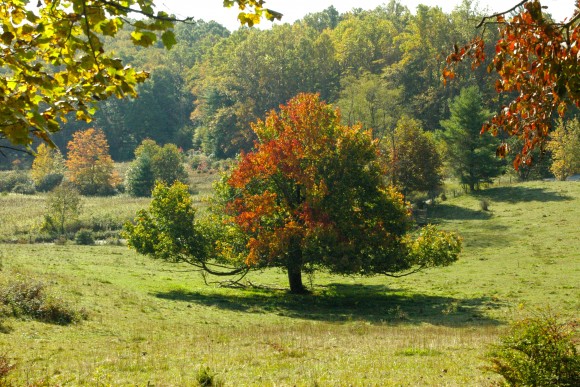








Maps via Foliage Network – http://www.foliagenetwork.net


Maps via Foliage Network – http://www.foliagenetwork.net


Fall Color Report for Week of September 21, 2014 from The Fall Color Guy. Check out The Fall Color Guy on Facebook and at http://biology.appstate.edu/fall-colors:
Leaf Color Report
Fall officially starts on Tuesday, September 22 at 10:49 pm according to the web. Fall leaf color though, has been going on since August, and it will pick up in pace in the next few weeks. The forests are still mostly green, but this is the first week where you can really see color on the landscape, mainly at a few high elevation locations, such as on the slopes of Grandfather Mountain, the higher slopes outside Asheville down to Highlands, and around Mount Mitchell.
Color should pick up each week now, starting at the higher elevations, and working its way downslope. Based on my drives around the High Country, I think we’ll be on near normal schedule for the most part. While I thought back in early September that trees might change early, much of that feeling was based on viewing urban trees, and indeed, many of them are turning earlier than usual. But most of the trees in the forest seem to be on a regular schedule, so if you are planning a visit based on historical times of peak leaf color, I think you will be okay this year. If anything, colors might peak a few days early, but since the displays last several days at a minimum (assuming no severe rain/wind storms at peak color time!), you should be able to find color somewhere here in the mountains, even if you miss it in one particular location.
Down around Cullowhee and Sylva, Kathy Mathews reports: “Things are moving at a typical fall pace here in Cullowhee and Cashiers (elevations 2300 & 3500 ft). There are individual trees fully colored here and there (mainly the occasional sourwood, burning bush, Virginia creeper; many sumacs are actually finished and browning!), and some trees in early stage of reddening (many dogwoods, sourwoods, buckeyes, red maples, sassafras). It's mostly still green here. I don't see that leaves are changing any earlier than normal.” So, Kathy confirms what I think – that peak color will arrive near its normal time this fall.
Near Maggie Valley, up at Purchase Knob (just outside Waynesville), Susan Sachs, the Educational Coordinator at the Appalachian Highlands Learning Center, says “Vivid color in a few Red maples and some changes in Yellow Buckeye but not much else. We are having a good nut mast year, which hasn't been the case for the last few years. We expect the bears and other nut feeders to be fat and happy this winter.”
Jim Costa, Director of Highlands Biological Station in Highlands, reports: “Fall colors are not yet much in evidence in our neck of the woods. There is a hint of color change with dogwoods, sourwoods, for example, but most everything is still green. Except for isolated cases — a branch here and there has turned, and the odd Virginia creeper vine.”
So, color is coming, but we still have a few weeks to go before the really great colors show up here.
In the Town of Boone, as you can see in the photo album following this post, colors are ahead of those in the woods. I think this is because developers have been planting special red maple varieties that have brilliant red fall leaf displays, and if these trees are from northern sources, then it’s logical that they would start turning early here (northern trees planted in southern locales tend to do that). Also, some trees in town may be stressed from soil compaction, salts, trampling, and so on, which may hasten leaf coloration.
If you’re headed to Asheville, be sure to check out their fall color site: http://www.romanticasheville.com/fall.htm.
See you all next week!!
Maps via Foliage Network – http://www.foliagenetwork.net


Fall Color Report for Week of September 14, 2014 from The Fall Color Guy. Check out The Fall Color Guy on Facebook and at http://biology.appstate.edu/fall-colors:
Leaf Color Report
This week is the first in which I can report the leaves they are a’changing; at least at the highest elevations. As noted by Jesse Pope, in my post yesterday, there is visible leaf color now starting to show up at the highest elevations, around 5, 000’ and on down to around 4,000’. Below 4,000’, most trees are still predominantly green. As noted last week, burning bushes continue to redden ahead of schedule, and more red maples are showing splotches of color. What is unusual about most of these red maples, many of which are varieties of urban trees planted for their fall leaf color display, is the extremely dull red of the leaves so far. Generally, red maples end up a bright red color. Perhaps these dull red leaves will brighten up in the next few weeks, something I will keep an eye on.
There is a beautiful Virginia Creeper vine that totally covers the trunk and branches of a tree, right off US 421 west of Boone. In fact, it’s the banner photo on my academic fall color page (http://biology.appstate.edu/fall-colors). What I have noticed is that last Sunday, this vine was essentially all green. Then, beginning on Monday, it began to redden up, and each day it has become more and more red. It is an interesting transition to watch, since I pass by it on the way to and from work. Although I don’t have a record of when it changed last year, it seems to me that this year it is turning early by at least a week or two.
I didn’t get a chance to take photos this week, as I was accompanying my wife to a conference of UNC Hispanic faculty at UNC-Charlotte. Also, I know I haven’t completed my trilogy of tree water relations essays, but will some time later this fall. Something about my day job taking up most of my free time?
So far, contrary to the recent climate outlook, September has not been excessively warm in the High Country. In fact, it was really cool and cloudy today, with temperatures only in the high 50s. If these cool temperatures persist, and we see a little more sun, we should be on track for good fall color.
Fall Color Report for August 31, 2014 from The Fall Color Guy. Check out The Fall Color Guy on Facebook and at http://biology.appstate.edu/fall-colors:
For those who want a short (< 500 words) summary of the state of fall leaf colors here in the mountains of western NC, I will post my observations at the beginning of my report each week. Then, below the report, I will provide an essay on trees that some of you may find interesting. This way, you can get right to the fall color report and not have to wade through my science essays. This past week, the weather has moved back to a more normal pattern for this time of year and we’re back to our usual “dog days” of August. As a result, there is not much to report with respect to fall colors aside from what I wrote last week.
The forests here are still very green. Jesse Pope reports from Grandfather Mountain that: “We do have some more leaf change on red maples, and also just plain leaf loss on them. Many of the maple trees above 4800 ft have already shed 50% of their foliage. Not sure what's going on there. No other trees are changing drastically yet. The buckeyes are starting to show just a smidge of color but nothing too drastic. I think we are still a couple weeks out from any real noticeable changes here at Grandfather.”
Kathy Mathews, from Western Carolina University, and Jonathan Horton, from UNC-Asheville, also report little progress to date on fall colors around Asheville and Cullowhee. Jonathan did mention yellowing on tulip poplars in the Bent Creek Experimental Forest (a unit of the US Forest Service that has some nice walking and biking trails, and which is adjacent to the NC Arboretum), and he saw some few Virginia creepers turning red.
I think it must be drier at lower elevations, as I also saw many tulip poplars in the Piedmont this weekend with yellow leaves. So, leaf lookers, hang in there. Over the next two weeks, we should begin to see trees turning at the highest elevations (5,000 ft or so) and then watch it progress downwards each week.
Tree Science – How Trees Use Water
Last week I gave a fairly extended explanation of how water moves from the roots of a tree to the leaves and out into the atmosphere. This week, I’d like to explain what physical and biological factors affect the rate at which that water moves through the trees. This will involve some knowledge of fluid dynamics and plant physiology, but hang in there; it’s actually fun to know!
My mantra here is that structure and function are tightly intertwined. That means we have to learn the structure of the cells that transport the water if we want to understand why they function like they do. The cells that conduct water in plants are known as xylem cells and we’re all familiar with them –tree xylem, for example, is wood! Interestingly, xylem cells are dead at maturity, and this contributes to their efficiency. Being dead, they have no cellular contents and are essentially just hollow structures with walls made out of cellulose and lignin, the two main components of wood. The walls provide rigidity to the cells and contribute to the ability of trees to grow to great heights without crushing themselves. The lack of cell contents allows these cells to conduct water with high efficiency.
Conifers, which evolved prior to the emergence of angiosperms (the flowering plants), contain a primitive type of xylem cell called a tracheid. Tracheids are long, narrow, and hollow cells, ranging 10-30 um in diameter). Figure 1 shows a typical tracheid. They also have end walls. For water to move from cell to cell, it has to pass through small openings in the wall, called pit pores (see Figure 2). As we will see below, the presence of end walls and having to move through the pits present obstacles to the movement of water for these types of plants.
Angiosperms, on the other hand, in addition to tracheids, contain a more recently evolved xylem cell called a vessel element (see Figure 1 again). These cells are much wider (100 up to 800 um diameter), shorter, and often have no cell walls on either end. Vessel elements also contain pits and water can not only move through the vessel element, but can cross over to other vessel elements through the pits.
Vessel elements can be stacked together to form what we call “vessels”. An analogy would be if you stacked toilet paper tubes one on top of the other. Each tube would be a vessel element and the set of joined tubes a vessel. A vessel is bounded on either end by vessel elements that do have a porous end wall. Such walls may act to restrict the movement of air bubbles in the xylem. Some vessels are just two or three cells long, whereas in some tree species, such as ash trees, they can be 10 m long! The evolution of vessel elements probably contributed to the ability of flowering plants to dominant certain landscapes, as we’ll discuss below.
At this point, we know something about the anatomy of these xylem cells, but how does their anatomy affect the movement of water through them? For that, we turn to the engineering field of fluid dynamics. Luckily, we can handle this type of engineering verbally and without formal mathematical equations (although I’ll show an equation to you anyway, for those of you who like math).
If you’ve ever been to a fast food restaurant, you’ve probably seen those small stir straws. Few of you would want to use those straws in your drink, because you know that it would be hard to suck the drink up the straw. In contrast, if you had a regular straw, with its much larger diameter, it would be much easier to get the drink into your mouth. Why is that?
Well, we need to know two things about how water flows in tubes before we can figure this out. First, water along the sides of the straw will rub against the walls, creating friction, and that will slow these water molecules down compared to those in the center of the straw. Second, water in the middle of the straw is drawn up the straw by the vacuum applied when you suck on the straw, and the entire column of water moves because of cohesion with other water molecules.
Now, that single layer of water at the straw’s edge that is moving slower will slow down the next layer inward of water because of shear, which is what happens when one layer of water rubs against another. That layer will interact with the next most layer, and slightly slow it down too. However, because water is somewhat slippery the frictional resistance of one layer of water against another is much smaller than that with the walls of the straw and as one moves to the center of the straw, these effects are drastically reduced. As a result, water moves faster at the center of a tube than at the edges. See Figure 3, which shows the velocity of water as a function of the distance from the side of a tube.
If you have a very narrow tube, a greater percentage of all the water in the tube will be interacting with the sides and as a result, more of the water in the straw will be moving slowly. Going back to the straw analogy, it means you will have to suck much harder to get the same flow rate in a narrow straw as compared to a wide straw, since you have to overcome more frictional resistance. Therefore, to get the same flow rate in a narrow tube as in a large one, you have to exert a greater tension (or pressure if you’re pushing the water). In fact, from a fluid dynamics point of view, if you keep the pressure constant, but decrease the radius of a tube by half, you reduce the flow by 16 times! Conversely, if you double the radius, flow increases by 16 times! Mathematically, we’re saying that the flow of water is proportional the radius raised to the fourth power: F α r^4. This means that doubling the radius is the same as raising two to the fourth power (2^4 = 16). Note: ^ means raise to this power.
For a tree, this has enormous consequences. It means that at any given tension in the xylem, it will be the larger diameter xylem cells that are conducting most of the water. If you compare tracheids to vessel elements, the implications are obvious: flowering plants (the only ones to have evolved vessel elements) will have a much greater capacity to move water (at equivalent tensions) than will conifers and ferns, which have only the much narrower tracheids. In fact, the fastest sap in the world has been found in the kiwi vine, which has vessel elements nearly 800 um wide (or 0.8 mm). This down-under vine can have rates of flow exceeding 20 mm/s (>50 m/h or 164 ft/h). In fact, kiwi vines have the fastest sap in the west (and north, and south, and east!). In deciduous trees, whose xylem diameters are usually less than 500 mm, and often between 100 and 400 um, rates of flow are slightly lower (25 to 40 m/h or 82 to 131 ft/h).
In contrast, conifers and ferns, with their more primitive and narrower tracheids, cannot move water nearly as fast. Rates of movement in pine trees, for example, are only around 1 mm/s (~6 m/h or ~20 ft/h). Why are sap velocities so much higher in vines and deciduous trees? Well, remember, vessel elements are much wider than tracheids, and a much smaller percentage of the water is in contact with the walls. This means the water can flow more freely, and less tension is needed to move large volumes up the plant. Also, the lack of end walls further reduces the tortuosity of the pathway (how contorted a path the liquid must traverse), and instead of having to move primarily through pits, as water must do in tracheids, it can flow freely down the wide, hollow vessels.
Mathematical Diversion for the Adventurist:
You can confirm mathematically why water flows faster through vessels than tracheids if you remember your geometry. For a cell with a radius of r, the circumference (which you can consider the single layer of water touching the walls), will be: C = 2πr. For a tracheid that has an r=10 um, C = 63 um. The volume of water in a cell can be approximated by the cross-sectional area (A) of the cell, and the formula for that is A=πr^2. For this cell, A=314 um^2. If you have a vessel element with r=125 um, C = 785 um and A=49,807 um^2. Now, take the ratio of A to C for both cells to get an idea of how much water is in the cell compared to how much is interacting with the walls. For the tracheid, the ratio is 314/63 = ~5. For the vessel element, it is 49,807/785 = ~63. Thus you can see that there is about 12 times more “free” water in a vessel element than in a tracheid, which is why water can flow faster in a wider tube (i.e., cell!).
The large frictional resistance in tracheids greatly slows down the velocity of the sap in ferns and conifers. This means that in response to a large transpirational demand (i.e., a lot of dry air out there), angiosperms will be able to transport water more easily and faster to the leaves than will conifers. Also, when water is plentiful, angiosperms will have the luxury of being able to open their stomata to take in carbon dioxide for photosynthesis, and not have to “worry” about all the water that is being lost via transpiration in that process. If a conifer did this, the loss of water from the needles would exceed the capacity of the xylem to replace the water lost via transpiration, and the tree would dry out. Of course, this is a greatly simplified explanation, but the you get the general idea of how wood anatomy can determine how trees move water in their trunks.
Figures from: http://plantsstructureandreproduction77.wikispaces.com/structure2 and pits in the walls of a softwood tracheid (hollow fibre). in Keey et al. 2000. Left most: tracheids and vessels; middel: how water moves up a tree; Right most: pits in a conifer tracheid.
Next week : What happens to a tree if it gets drought stressed? Is there a trade-off between xylem efficiency and safety? How does evolution solve such a dilemma?


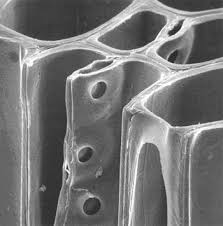
Fall Color Report for Week of August 24, 2014 from The Fall Color Guy. Check out The Fall Color Guy on Facebook and at http://biology.appstate.edu/fall-colors:
Sometimes nothing happens of much note from one week to the next. That’s the story line for this week’s fall leaf color report. Another word I might use to describe fall leaf color for this week would be “ibid”, which according to the English Oxford Dictionary, means “In the same source (used to save space in textual references to a quoted work that has been mentioned in a previous reference).” In other words, you could read last week’s report and that would fill you in on this week!
Of course, time does march on (I wonder how many clichés I can fit into one essay?) and some things did change. The red and sugar maples that were turning last week continue to do so this week and many of them are now predominantly red/orange rather than green. A few trees are even nearly defoliated already! I think the phenology researchers should pay more attention to what is happening this summer and refine their models, which have given June and July temperatures little impact on the timing of fall leaf color. Perhaps these months are more important than we have realized! Yet, despite these unusual early turning trees, the rest of the forests around here are still quite green this week.
Last week I said I would fill you in on some interesting aspects of tree water relations. So, here goes. You only need to know some anatomy, fluid dynamics, physics, mechanical engineering, biomechanics, natural selection, and the concept of an evolutionarily stable strategy! But luckily, you do not need to know any rocket science, so this should be a breeze to understand.
First off, trees do not “push” water to the tops of their crowns. If that were so, water would shoot out of the trunk if you cut into one, just as if you had nicked a garden hose with the water turned on. But as loggers will attest, this does not happen in a healthy tree. Furthermore, since water is essentially incompressible, the trunk of a tree would expand as each individual xylem cell (the wood that conducts water up a tree) bulged outward from the pressure. But when we measure trees that are actively transpiring they actually shrink instead! That suggests they are under tension (negative pressure); and if that is true, then trees must be pulling, not pushing, water up their trunks. One way to think about this is to imagine stretching a rubber band, which puts it under tension. As it gets longer from the tension, it also gets thinner. The same can be said for water under tension: it stretches and the water column gets thinner, causing the tree trunk, in turn, to shrink.
But for those of you who lived or still live on farms and remember pumping water up by hand, the deepest well you could have was just 10 m, or ~33’. If it was any deeper, the weight of the water column would be so great that it would break. But if that is so, then how do trees like redwoods and eucalyptus, which can be more than 100 m tall (up to 370’), pull water up up to the tops of their crowns, which are much higher than 10 m?
The answer lies in the fact that if you transport water in wood composed of billions of very small diameter cells (known as tracheids in conifers, vessel elements in angiosperms) then you can support a column of water under tension (negative pressure) to a very great height! Tracheid diameters can range from 20-80 microns (0.0009”) while the largest vessel elements (which occur in vines) can approach 500 microns (or nearly 0.02”). To test whether cells of these diameters can support a column of water more than 100 m high, scientists have induced high tensions in water filled glass capillaries (with tube diameters equivalent to that of xylem cells) and also in detached branches from trees with a continuous column of water in their wood, by spinning them in centrifuges. The results of these studies show that water is more than able to maintain a continuous column, under tension in the xylem, for lengths longer than that of even the tallest trees.
The other properties that are important for moving water in plants involve what are known as the colligative properties of water. For example, water is attracted to other materials by the process of adhesion (which is why water will wick up a paper towel) and also to other water molecules by cohesion (which is why you can suck water up a straw). In very narrow conduits, like xylem cells, the upward-pulling forces of adhesion and cohesion exceed that of the downward gravitational forces. This means that not only can a tree maintain a continuous column of water from the roots to the leaves, but it can transport that water upward nearly 400’ against the downward gravitational force.
But what forces are actually responsible for making the water move upwards? To understand this part of the process requires knowing what happens when a water molecule evaporates from the leaf. As a water molecule goes from the liquid state (as it is in the xylem) to the gaseous state (or vapor phase) when it evaporates into the atmosphere, the surface tension at the air-water interface in the leaf is disrupted by the loss of that molecule, which results in an unstable energy state. To regain the more stable energy state, a water molecule in the liquid column must move in to replace the one that left, and every time that happens, it pulls other water molecules up the water column by cohesion. Now, multiply this by the trillions of water molecules leaving a leaf every minute, and cohesive forces acting on the entire water column in the trunk, and you get a lot of water moving up that tree in a continuous column. In fact, a large tree can transpire over 100 gals of water (378 liters) per day!
What is truly amazing about this process is that it requires no metabolic energy on the part of the plant. Tracheids and vessel elements, for example, are dead, hollow, cells at maturity. Paul Kramer, a famous plant physiologist from Duke University, showed that a plant with dead roots (killed by hot water) could move water up its stem as long as its xylem was not clogged by debris.
But for water to move from root to leaf to atmosphere (through what we call the Soil-Plant-Atmosphere-Continuum, or SPAC), energy must be expended, and forces must act on the water. When forces cause something to move, that is, in physics terms, “work”. In formal terms, Work = Force x Distance. Given that trees can move water 100 m against the force of gravity, they must be doing a lot of work!
So how do trees do this work without expending their own energy? In the simplest of terms, it is the sun that provides that energy, by heating the air and drying it out. Inside a leaf, the relative humidity of the air is ~100%, but rarely is the air that wet in the atmosphere outside the leaf (unless you live in New Orleans!). That means there is almost always a gradient in the concentration of water from the leaf to the air, and water will always diffuse passively (that is, spontaneously) down that gradient. Thus, as long as the concentration of water is higher in the leaf than outside the leaf, water will evaporate from it. In reality, trees are like giant wicks inserted in the ground, moving water out of the soil and up the their trunks, against the force of gravity, by using the drying power of the air, whereupon the water is released into the atmosphere.
Now, if a large tree transpires 100 gals of water a day, it must be moving that water very rapidly and efficiently. To understand how that is accomplished, see next week’s leaf color report. That is the part of the story for which you will need to understand fluid dynamics and mechanical engineering. But no worry! I will explain it in such a way that everyone will understand how trees (and in fact, all vascular plants) move water through xylem cells with very small diameters. If you have ever watered plants with a hose and put your finger over the end to make the water shoot further out at a higher velocity, then you know all that’s required to understand the hydraulics of trees! And I promise – no calculus required!
Next week: further reports on fall leaf color and part two of our essay on tree water relations. This one will be on the trade-offs between moving water at high velocities through the xylem and withstanding drought stress; or in evolutionary terms, why there is no free lunch when it comes to tree water relations (cliché again!).
Fall Color Report for Week of August 17, 2014 from The Fall Color Guy. Check out The Fall Color Guy on Facebook and at http://biology.appstate.edu/fall-colors:
I’m sorry I didn’t have any tree photos last week. Your intrepid reporter was laid low by a recalcitrant kidney stone, which was surgically removed this past Tuesday. He’s feeling much better now and today when out and about looking for iconic photos of trees. See the photo album that I will upload after this post.
It is an understatement to say that this has been a relatively cool summer. Using the metric of daily mean temperature, this July was the coldest since the Boone station began keeping records 34 years ago, and in Jefferson, which has 82 years of records, it was the 3rd coolest July. For the state as a whole, it was the 11th coolest in the last 120 years! The NC State Climate Office reports that this is due primarily to lower maximum temperatures and not unusually low minimum temperatures at night. However, here in the mountains, we did get into the high 40s for a few days in July.
The cool temperatures may have resulted from a polar vortex phenomenon that causes the jet stream, which tends to separate warm from cool air, to dip lower into the United States. Some feel that as the Polar Regions continue to warm rapidly (more so than in the tropics), that this will cause greater instability in the path of the jet stream, and could, paradoxically, lead to more instances of cooling in this region. I know this may give climate change deniers ammunition to continue their campaign to discredit those who have documented significant human-induced climate change, but in reality, it simply shows off their ignorance of weather and climate science. Just remember, even though locally we’re having a cool summer, globally, temperatures worldwide continue to rise. Last year tied with 2003 as the fourth warmest on record, and 13 of the last 14 warmest years on record have all occurred since 2000!
Will the cool July affect the timing of autumnal leaf colors, or the quality? No one knows for sure. August is continuing on a mild streak right now, and it’s an important month for prepping the trees for fall color. When August and September are cool and sunny, we get our best leaf colors.
This week I am seeing some prominent coloring on dogwoods, red and sugar maples and on burning bushes; the dogwood in my yard is starting to show some red color, as are the ones across the street from me in the cow pasture. The maples I mentioned last week continue to turn as do isolated ones in the woods. But the majority of trees are still quite green now, as they should be. I have uploaded an album of some pictures I took this Sunday of trees turning color in the Boone area. This phenomenon has been noticed by others as far north as Pittsburgh, NY and Canada. They too had very cool July’s and people are reporting trees turning color several weeks earlier than usual. Others are documenting a failure of tomatoes to ripen on time. This may turn out to be one of our more unusual and interesting autumns.
Last week I said I would tell you why some black locust trees are turning brown. There is a native insect, called the locust leaf miner (Odontota dorsalis), which is a type of beetle, and whose larvae attack the leaves and eat them from the inside out, causing them to turn brown and then drop off prematurely. They usually peak in activity in late July and August which is why there are so many brown locust trees right now. However, it’s my opinion that the incidence is much less this year; perhaps the frost in late April that we had here killed some of the insects, or the cold is reducing their impact. I took some pictures of damaged locust leaves, and also of the mature insects sitting on them and they are in the album of tree pictures mentioned above.
Black locust is an interesting tree species because it can fix nitrogen out of the air through nodules on their roots that contain Rhizobia, a bacterial genus that does the actual fixing. This mutualistic relationship is based on the fact that the bacteria get carbohydrates from the plant while the plant gets nitrogen from the bacteria. This process can enrich the soil in nitrogen, because when the roots die and decay, or when leaves fall to the ground, they are enriched in nitrogen and make it more fertile.
Black locust trees are indigenous to the southern Appalachians, but have been planted outside their native range in both North America and Europe, where they are now one of the most invasive trees species known. Cameron Houser, an Appalachian State University Biology graduate student, just completed her Master’s thesis on this species. She showed that when it invades areas outside its native range, it substantially increases the nitrogen content of forest soils compared to adjacent forests where locust trees are absent. Such enrichment may greatly alter ecosystem nutrient cycling processes, as well as have consequences for the species composition of these invaded forests. That a native tree species can be invasive in its own continent is unusual, since we usually think of most invasives as alien species that are come over from either Asia or Europe.
Next week: further reports on leaf color and some thoughts on tree water relations.
Photos: Dr. Howard Neufeld
Red Maple at intersection of King and Poplar Grove Road showing reddening of upper and outer leaves.

Closeup of leaves turning red.


Tree adjacent to Galileo Bar and Grill parking lot that has completely turned red in the upper portion of the crown by August 17, 2014. See how the lower leaves are still totally green while the upper crown is totally red.


Sugar maple leaves turning yellow-orange on King Street across from Galileo's Bar and Grill, Aug 17, 2014.

Here is that red tree at Galileo's again, with a neighboring tree that is still mostly green. Strange!

Black locust leaves behind Broyhill Center on campus of Appalachian State University showing leaf miner damage, Aug 17, 2014.

These are the locust leaf miner adult beetles. Notice how they have damaged the leaves.

Sugar maple turning early on Bodenheimer Drive right next to entrance to parking lot by Chancellor's home on the campus of Appalachian State University, Aug 17, 2014.


Report for Week of August 10, 2014 from The Fall Color Guy. Check out The Fall Color Guy on Facebook and at http://biology.appstate.edu/fall-colors.
“Well, after a restful winter/spring, and with summer starting to fade, it’s time to renew our weekly fall leaf color reports. I hope everyone had a good off-season and that you’re ready for our autumnal displays this year. So, what’s the situation this week, and what does that portend for the fall?
This summer started off fairly dry and we were actually in a low level drought until some rains came later in July. You may also remember just how cool July was (I’m checking to see if it was a record cool) and some people wrote me asking what that meant for fall colors (I don’t think too much). Already, you can see scattered color developing, particularly on red and sugar maples. There’s even one red maple on the east side of US 321 between Patterson and Blowing Rock that is at peak (I repeat, peak!) color for reasons not are not clear to me. Other maples are showing significant coloring, especially along Rivers Street in Boone, but also at other locations in Watauga County. Some of the horticultural red maple varieties are starting to turn red on the outer portions of their crowns, and these usually turn much later in the year.
It’s not clear why these trees turn so early. The trees along Rivers Street color up every year around this time, yet the majority of the trees in the forest still peak at our usual time, which for Boone is mid-October. It is possible that when trees are stressed, such as by salt from the DOT during the winter, or by being planted in compacted soils, that they turn early. I don’t think the fact that these trees are turning early suggests that fall colors will come early this year. That depends more on what the weather conditions will be like for the rest of August and through September.
If the weather turns sunny and cool in August and September, colors should arrive on time and be vibrant, with bright reds contrasted against oranges and yellows. If it is rainy and warm, peak colors may be delayed and subdued.
Final thoughts: some recent scientific papers studying the timing of autumnal colors suggest that temperatures, especially in the fall, are the most correlated with the timing of colors. Warm falls delay the colors, cool ones accelerate them. Rainfall has much less of an effect on timing. Since we aren’t in a major drought, which can cause the leaves to fall prematurely, we still have the potential for an excellent fall leaf color season here in the southern Appalachians.
Next week: why the black locust trees are turning brown.”
August 6, 2014 – The summer of 2014 will be remembered more for cooler temperatures that the record setting rains in 2013. Attention is turning quickly toward fall and what might it bring.
Dr. Howard Neufeld is not only Professor of Plant Eco-physiology at Appalachian State University, but he is also known as The Fall Color Guy. For the third year in a row WataugaRoads.com is teaming up with “The Fall Color Guy” to provide information as the colors start changing.
WataugaRoads.com ask Dr. Neufeld what we might see with fall colors this year due to the more cooler temperatures instead of all the rain received last summer.
Dr.Neufeld replied:
“As for the wet weather, there have been some publications since last year on the impacts of weather on fall color (especially timing, not so much quality). Precipitation has only minor effects on timing in the fall. Temperature is more important. So, at this point, I don't see anything to make me think that fall colors will be adversely affected, either in timing or quality.
What happens in mid- to late August and in September, temperature-wise, will be more important, especially for quality (notably the intensity of the red colors)”.
Dr.Neufeld shared some thoughts just before fall season of 2013 that are still relevant this upcoming season:
“1. People think fall colors are good when they last a long time, and have plenty of brilliant reds interspersed with the oranges and yellows. So, the quality will depend on how much “redness” we have this fall.
2. Trees tend to make more red colors (anthocyanins) in the fall when it's cool and sunny, and if we have a slight but not severe drought.
3. Sunny days means more photosynthesis, and more sugars produced in the leaves, and sugars induce anthocyanin production.
4. A slight drought impairs uptake of nitrogen (we think) and some experiments suggest that plants low on N make more anthocyanins.
5. Usually, fall colors peak around Oct 11-14 in the Boone area; sooner by a few days up to a week at higher elevations, later at lower ones. Nice colors can stick around for a week or more, although the peak usually comes and goes in just a few days, weather permitting (no high winds for example)”.
Check out The Fall Color Guy on Facebook and at http://biology.appstate.edu/fall-colors
An early look at some trees starting to change on the ASU campus on August 6, 2014. Photos: Kara Harmon
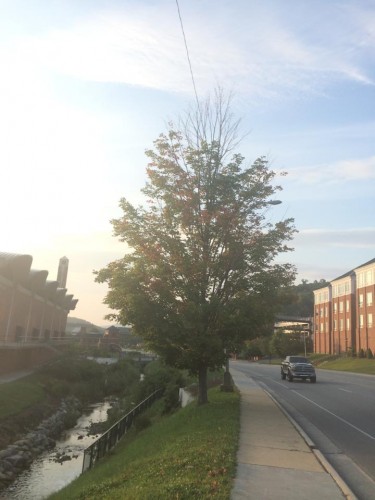

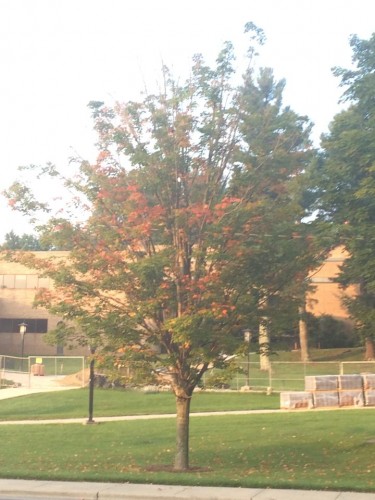
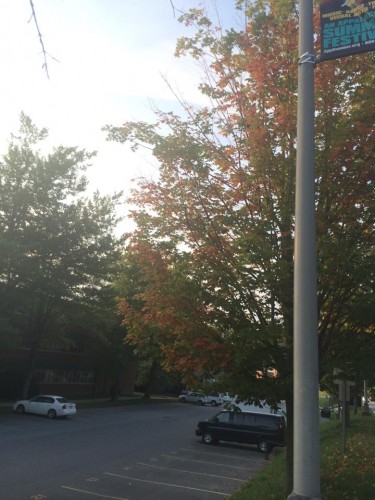
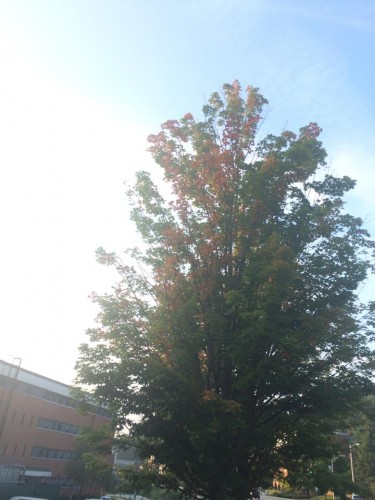
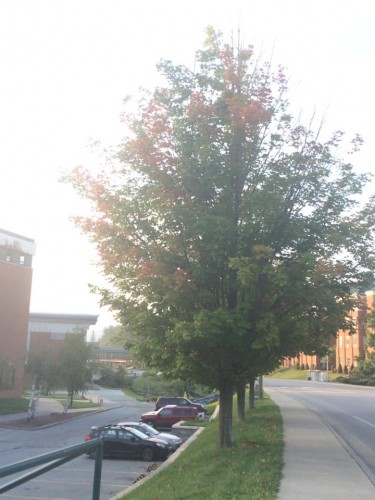
*article from NOAA*
Cool Autumn Weather Reveals Nature's True Hues
A favorite American pastime in fall is to pack a picnic basket and set off with loved ones on a Sunday drive along one of the nation’s many scenic byways. It’s a time of year when people enjoy crisp cool weather and marvel at the transforming landscape as tree leaves turn from lush green to gorgeous shades of yellow, orange, red, purple and brown.
While we relish the opportunity to frolic in a big pile of freshly raked leaves, we don’t often think about the science behind why leaves change color and eventually fall from their branches. The answer may surprise you!
Recipe for Fabulous Foliage: Cool Nights and Sunny Days
Weather factors such as temperature, sunlight, precipitation and soil moisture influence fall color arrival, duration and vibrancy. According to United States National Arboretum, a wet growing season followed by a dry autumn filled with sunny days and cool, frostless nights results in the brightest palette of fall colors. Changes in weather can speed up, slow down or change the arrival time of fall’s colorful foliage. For example:
Drought conditions during late summer and early fall can trigger an early “shutdown” of trees as they prepare for winter. This causes leaves to fall early from trees without reaching their full color potential.
Freezing temperatures and hard frosts can kill the processes within a leaf and lead to poor fall color and an early separation from a tree.
True Colors Come From Inside
Trees actually begin to show their true colors in autumn, and here’s why.
The four primary pigments that produce color within a leaf are: chlorophyll (green); xanthophylls (yellow); carotenoids (orange); and anthocyanins (reds and purples). During the warmer growing seasons, leaves produce chlorophyll to help plants create energy from light. The green pigment becomes dominant and masks the other pigments.
Trees must replenish the chlorophyll because sunlight causes it to fade over time. As days get shorter and nights become longer, trees prepare for winter and the next growing season by blocking off flow to and from a leaf’s stem. This process stops green chlorophyll from being replenished and causes the leaf’s green color to fade.
The fading green allows a leaf’s true colors to emerge, producing the dazzling array of orange, yellow, red and purple pigments we refer to as fall foliage.
Following the Feast of Fall Colors
Fall’s color “parade” varies from region to region and year to year, depending on weather conditions. For areas under calm and dry high pressure, cool nights and sunny days can lengthen fall color displays. Cold or warm fronts can produce strong winds and heavy rain that cause leaves to fall off trees more rapidly.
2014 UPDATES
For the third year in a row WataugaRoads.com is teaming up with Dr. Howard Neufeld to provide information as the colors start changing. Dr. Neufeld is Professor of Plant Eco-physiology at Appalachian State University and known as The Fall Color Guy.
You can find more information from The Fall Color Guy at the following links:
2013 UPDATES
November 13, 2013 – Since the leaf peak season has passed this is the final report on conditions for the High Country on this page.
November 2013. Graphics from The Foliage Network








October 26, 2013. Graphics from The Foliage Network

October 23, 2013. Graphics from The Foliage Network
Autumn Color viewed from space Sunday October 20 in Western NC via the Modis Visible Satellite image. Image courtesy of Brad Panovich
October 19, 2013. Graphics from The Foliage Network
October 16, 2013. Graphics from The Foliage Network
Fall Leaf Color Report for Week of October 13, 2013 from The Fall Color Guy (Dr. Howie Neufeld). Check out The Fall Color Guy on Facebook and at http://biology.appstate.edu/fall-colors
“This week, plus the coming weekend, should be our peak fall leaf color times here in the Boone/Blowing Rock and Grandfather Mountain areas. A drive along the Blue Ridge Parkway will present excellent viewing, especially at 3,000’ and up. Colors are still developing at lower elevations, and won’t peak for another week or so, but the views should be great nonetheless. Sugar maples are really gearing up now. In Boone, along King Street, and also on the Blowing Rock Highway, there are several large sugar maples that just explode in yellow-orange brilliance at this time, and you can see them this week if you come up. Red maples are having a great year, and many are now peaking in the Boone area. A lot of yellow color is coming through now as the birches, beeches, tulip poplars, hickories and magnolias begin to show. Some of the oaks are also starting to color up, and the red, scarlet and black oaks will be the last major bursts of color on the landscape.
Kathy Mathews says that “we will reach “peak” by next weekend [in the Cullowhee/Sylva area]. A lot of trees are dropping their leaves,” and she says “it would be best to advise tourists to come up next weekend, I think. She says she’s “astonished we haven't had a frost yet to bring on a real peak of simultaneous color! A frost may not happen until the end of the month, but many trees will be finished by then.” Kathy then drove “over the mountains on Hwy 64 south to Clay County this weekend, between Franklin and Hayesville, and the pass where the AT crosses highway 64 near the Standing Indian Recreation Area is just gorgeous now. That area is in true peak, with lots of bright colors.”
Jonathan Horton reports that Asheville is still predominantly green, but there is color on the surrounding hills. Oaks and hickories are coloring up and adding to the other trees that already show color (maples, sourwoods, dogwoods). Later today I’ll have a report from the Cashiers/Highlands area. The government shutdown is preventing me from reporting about Great Smoky Mountains National Park, but my intuition says the high elevations are peaking now, so this weekend should also be good for a drive up to Newfound Gap. Cades Cove will most likely peak later as it’s at low elevation in the Park.
We’ve had very moderate temperatures these last few weeks, even excessively warm the prior week. I think that delayed the progression of color development by several days as the peak is yet to appear here in the Boone area, and the average date of appearance is between the 10th and 14th of October. Also, as Kathy Mathews from WCU points out, we have not had a hard frost yet, which can synchronize leaf colors somewhat (it can also speed up leaf loss too). We did get down to 34oF a few mornings ago, and I’m sure it went below freezing at the higher elevations like Banner Elk. But the long-range forecast shows temperatures above 40oF for the next week or so. There is a front moving in, and there could be rain late Wednesday and some of Thursday, and even a chance this coming weekend (sorry, I can’t do anything about Mother Nature!). But nothing too major (and no severe winds) so come on up and enjoy the best show nature ever devised!”
October 12, 2013. Graphics from The Foliage Network
October 10 from Brad Panovich WCNC TV Charlotte

October 9, 2013. Graphics from The Foliage Network

October 5, 2013. Graphics from The Foliage Network
October 2, 2013. Graphics from The Foliage Network


Fall Leaf Color Report for Week of September 29, 2013 from The Fall Color Guy (Dr. Howie Neufeld). Check out The Fall Color Guy on Facebook and at http://biology.appstate.edu/fall-colors
“This is the first weekend of autumn and also the first time I can report that fall leaf color in the mountains is beginning to show in earnest, especially above 4,000’ elevation. Check out the photo attached which I took at Tynecastle, at the intersection of Rts. 105 and 184, near Banner Elk, and just west of Grandfather Mountain State Park. The sugar and red maples are coming out and should peak at the higher elevations by next weekend. American ash is turning also (a dull purplish color), and the mountain ash fruits are like red beacons against the background of spruce and still green oaks. They are quite spectacular this year, perhaps a result of all that rain earlier in the summer (Grandfather Mountain, for example, received 29” of rain in July alone!). There are four species of maples on Grandfather Mountain (red, sugar, striped, and mountain) which turn varying shades of orange and red (often both), although striped maple is unique in that its large leaves only turn a brilliant yellow only.
You may also see the evergreen rhododendrons (R. maximum and R. catawbiense) dropping their older leaves now. That is normal at this time of year, and you can tell which is which by the color: the senescent leaves of R. maximum are yellow while those of R. catawbiense have a reddish hue to them. Also, the leaves of R. maximum are longer while the other species has shorter, more oval leaves. Sassafras is also turning, and you can find leaves ranging from dark green, to yellow, to orange to red, all on the same tree! Huckleberry bushes are now peaking and have a deep burgundy color. There is a good display of these shrubs on the rock outcrops on Beacon Hill, just off the Blue Ridge Parkway east of Grandfather Mountain. Finally, you may have seen tree trunks covered in a deep red vine (note the picture at the top of my academic fall color page (http://biology.appstate.edu/fall-colors). This is Virginia creeper, and it’s peaking now throughout the High Country.
Down by Cullowhee and Sylva, Kathy Mathews reports that she is seeing “many trees and shrubs turning yellow (tulip poplar, cherry, birch, walnut) and red (dogwoods, sourwoods, red maple, burning bush, etc.), but the chlorophyll is still present as well, so the red colors are looking somewhat dull.” She feels that their peak is still several weeks away.
Based on the rate of development of leaf color, I think visitors will enjoy peak colors by next weekend at the higher elevations, especially on the slopes of Grandfather (and particularly on the east-facing slopes), at the higher elevations in Elk Knob State Park just north of Boone and on Roan Mountain on the border of NC and TN and finally, in the Smokies, also at the higher elevations. Colors won’t be at their peak in Boone and Highlands until the weekend after next. One positive thing going for us is that the weather for this coming week is forecast to be sunny and cool, which is perfect for color development.”
September 28, 2013. Graphics from The Foliage Network


September 26, 2013. Graphics from The Foliage Network


September 21, 2013. Graphics from The Foliage Network


Fall Leaf Color Report for Week of September 16, 2013 from The Fall Color Guy (Dr. Howie Neufeld). Check out The Fall Color Guy on Facebook and at http://biology.appstate.edu/fall-colors
“The forecast for this week is, in a nutshell, the same as last week: Green! Trees in the High Country still have most of their leaves, and there is isn’t much to report right now. Yellow buckeyes are about the only tree species to show a significant change: most have started losing their leaves (remember, these trees are early to leaf out, and early to lose them in the fall – the botanical equivalent of early to bed, early to rise!). However, they also get a leaf fungal disease, so their leaves do not provide much color. Dogwoods and burning bushes are coming along and increasing in color each week, and the occasional sugar or red maple have some orange/red leaves. Otherwise, as I stated above, the word is still GREEN.
The long-range forecast for the southeastern portion of the country, including the southern Appalachians, is for above-normal amounts of precipitation. That doesn’t bode well for great fall leaf color, because sunny and cool conditions are what lead to good fall leaf color. But so far the weather has been near perfect for good fall color, so let’s hope that we don’t get too much rain in the next few weeks. If not, we should have a great fall color season this year!
As I was driving back from a short visit to the coast on Sunday, I was thinking of how green the mountains looked as I headed up US 421 into Watauga County. That started me thinking of all things green: How Green Was My Valley, the Grass is Always Greener on the Other Side of the Fence, and It Isn’t Easy Being Green (https://www.youtube.com/watch?v=51BQfPeSK8k, with Kermit the Frog). What phrases can you think of that relate to “green”?
Have a great week! Don’t forget, you can check out essays on the science of fall color at my other fall color site, as well as a list of what colors each tree turns: https://www.youtube.com/watch?v=51BQfPeSK8k”
Map conceived by Howard Neufeld and Michael Denslow, constructed by Michael Denslow


September 14, 2013. Graphics from The Foliage Network

September 7, 2013. Graphics from The Foliage Network


The summer of 2013 will go down as the wettest on record for the area, and for many residents it will go down as one that was not a summer at all. Attention is turning quickly toward fall and what might it bring.
Dr. Howard Neufeld is not only Professor of Plant Eco-physiology at Appalachian State University, but he is also known as The Fall Color Guy. Along with sharing his expertise with the NC Division of Tourism each fall, in 2012 he allowed WataugaRoads.com to share his insight and information.
Once again in 2013 WataugaRoads.com is teaming up with The Fall Color Guy to provide information as the colors start changing. On Monday of this week (July 29, 2013) WataugaRoads.com asked the question about what we might see with fall colors this year due to the amount of rain received.
Dr.Neufeld replied:
“1. People think fall colors are good when they last a long time, and have plenty of brilliant reds interspersed with the oranges and yellows. So, the quality will depend on how much “redness” we have this fall.
2. Trees tend to make more red colors (anthocyanins) in the fall when it's cool and sunny, and if we have a slight but not severe drought. This year, cloudy, rainy, no drought!
3. Sunny days means more photosynthesis, and more sugars produced in the leaves, and sugars induce anthocyanin production.
4. A slight drought impairs uptake of nitrogen (we think) and some experiments suggest that plants low on N make more anthocyanins.
5. If it is rainy, then there is less photosynthesis, fewer sugars, and more nitrogen uptake (soils are wetter for longer), and hence, trees may make fewer anthocyanins.
6. So, if the weather keeps consistent, we may see duller red colors this fall. The oranges and yellows should be as usual, as they do not depend as much on light or drought.
7. How long the fall color will last is another thing, and also, it is unknown if a wet summer will change the timing of fall colors.
8. Usually, fall colors peak around Oct 11-14 in the Boone area; sooner by a few days up to a week at higher elevations, later at lower ones. Nice colors can stick around for a week or more, although the peak usually comes and goes in just a few days, weather permitting (no high winds for example).
9. If the wet conditions extend the growing season, then the initiation of fall colors might be delayed by several days, or, if trees decide that they've got all they need for this season, they may initiate fall colors early instead. We just don't know at this point. It will also depend on what the weather does in late August through September.”
Scroll below for a look at what happened in 2012. Also check out The Fall Color Guy on Facebook and at his ASU page where you can also read about the science of fall colors.

Aug 20, 2013 on ASU campus. Photo: Kara Harmon
Aug 6, 2013. Photo: Kenneth Reece
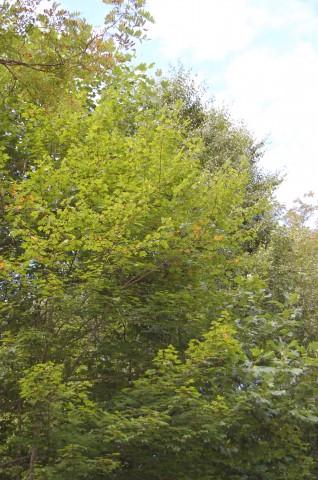
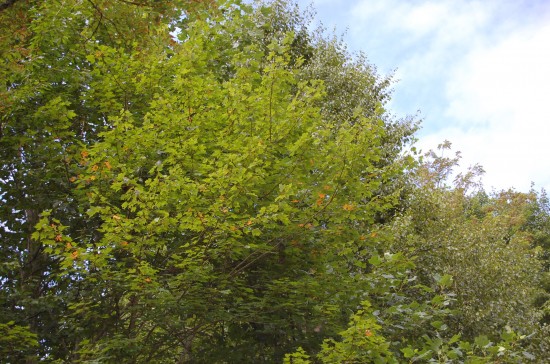
On Tuesday July 30, 2013 Anita Presnell shared these photos of some early changes from Valle Crucis Park.
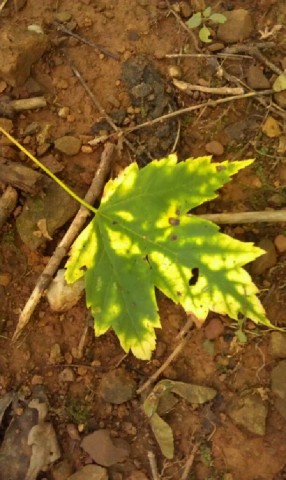
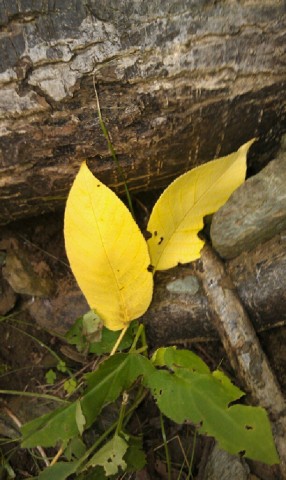
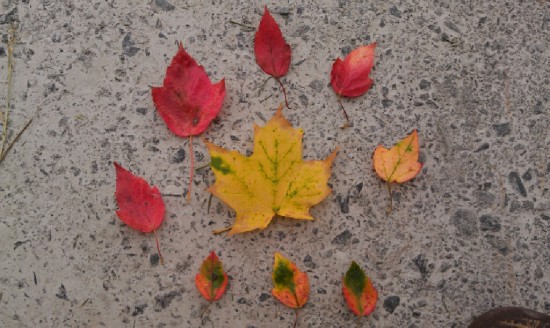
2012
Maps via Foliage Network – http://www.foliagenetwork.net
*The following information is courtesy of Dr Howie Neufeld, Professor of Plant Eco-physiology at Appalachian State University. Dr Neufeld is other wise known as “The Fall Color Guy”. Along with sharing his expertise with the NC Division of Tourism, he has agreed for WataugaRoads.com to post his information.*
Fall Color Report for Week of October 29
In the years that I have been reporting on fall color, I have rarely had to contend with hurricane-induced snow storms, but that is what is forecast for this week as Hurricane Sandy moves up the east coast this week and combines with a cold front coming in from the upper Midwest. According to the latest weather reports, significant accumulations of snow are expected for the southern Appalachians in North Carolina, all the way down to Asheville. Some 15” of snow may fall at the highest elevations, with 6” expected for Boone coupled with high winds gusting over 60 mph. If that doesn’t take down the last of the leaves, nothing will! Needless to say, the first half of this week will not be a good time to head to the mountains to view what remains of the fall color.
Conditions are supposed to ameliorate by Thursday this week, but the high winds will have removed the last vestige of fall color at the high elevations. Already, prior to this storm, most of the leaves have already fallen from elevations above 2,500’. What remains of fall color viewing has now moved to the lower elevations and the foothills. A few oaks and beeches are clinging to their burgundy red or chocolate brown leaves (but only a few). These species tend to hold on to their leaves longer than most others. Overall, this was a relatively short fall color season at higher elevations (and somewhat duller in color) compared to some in the past. Colors at lower elevations in some locations were better than they were at higher elevations.
Jonathan Horton, in Asheville, reports that colors look good around Marion, Morgantown and Old Fort, but the storm this week may take down most of those leaves. Matt Popowski reports that colors (prior to the big storm) were coming on well in Chimney Rock State Park, southeast of Asheville and near Lake Lure. He writes: “The higher elevations of Chimney Rock and Lake Lure have exploded with vibrant leaf colors, displaying remarkable color around the Chimney level. Hiking the Skyline trail from the Chimney to Exclamation Point is quite spectacular! Golden yellows have appeared in our buckeyes, birch, beech and walnut trees. The hickories are also starting to turn yellow. Sourwoods and some dogwoods are still bright red, and the maples are adding red to our mountains. [H]igh winds could bring down some of the leaves. Lower elevations should peak during the first week of November and color will likely continue into the second week.
A quick check of several other state parks (Crowders Mountain, Gorges, South Mountains, and Table Rock State Parks) finds that the color peaks have passed in those locations and my contacts in Gorges and South Mountains report the trails are nearly leafless now. It seems we are rapidly approaching the end of the fall color season for this year. I hope you were able to get up here during periods of good weather to check out the fall foliage displays this year.
For more information, don’t forget to check my Fall Color Facebook page (http://www.facebook.com/pages/Fall-Color-Guy/222437294470967) and my ASU page, where you can also read about the science of fall colors (http://biology.appstate.edu/fall-colors). Happy and safe driving!
*The following information is courtesy of Dr Howie Neufeld, Professor of Plant Eco-physiology at Appalachian State University. Dr Neufeld is other wise known as “The Fall Color Guy”. Along with sharing his expertise with the NC Division of Tourism, he has agreed for WataugaRoads.com to post his information.*
Fall Color Report for Week of October 21
Well, you know the dictum – it's not nice to fool with Mother Nature! You may remember that last weekend I said it was probably peak color time for the Boone to Grandfather area. But I was wrong, to say the least! After a drive off the mountain on Saturday, Mother Nature surprised me by bringing out the brilliant reds from the red maples and oaks, contrasting them against the bright yellows of late turning sugar maples. This combination brought out the colors all along the eastern flank of the mountains, from Ashe County down to Linville Falls.
Given the mostly calm and sunny weather expected this week, I would say that these colors will persist to the coming weekend. Note that the best color viewing is either early in the morning when the sun is at a low angle, or just before dusk, for the same reason. Those are also the best times to take photos of the leaves. I saw good color all the way down into the foothills and even as far as Wilkesboro and beyond, but the intensity of colors is much better closer to the mountains at elevations between 1,500′ and 3,000′.
It is true, though, that many trees above 3,000′ have lost leaves, especially the tulip poplars and some of the early turning maples and birches, but enough trees remain with leaves to make a trip up here worth the effort. You will especially like the views off the Parkway of the leaves at lower elevations, where the colors are reaching their peak now.
Farther south, my contacts tell me that colors are good from Maggie Valley and Waynesville, on into the Smokies. In Highlands many places are now at their peak. Karen Kandl, Associate Director of the Highlands Biological Station, writes that between Cullowhee and Cashiers and over to Highlands “many of the small oaks along the road are deep dark reds. Tulip poplars and beeches are yellow. Sassafras is yellow, orange and red. When the sun hits these leaves in the early morning, it is absolutely beautiful.” This past weekend was good, and colors should hold to the coming weekend also.
Matt Popowski gives us weekly updates from Chimney Rock: “Just in the past couple days some nice yellows and oranges have appeared on the tops of mountain peaks around Chimney Rock and Lake Lure. Bright, colorful foliage is visible along major driving routes, offering a stunning drive to Chimney Rock. The poplars are a vibrant gold now and the sourwoods, dogwoods and sassafras have turned red in the Park.” Although there is still a lot of green, “Chimney Rock's fall colors should continue to brighten dramatically over the next couple weeks.”
Pilot Mountain State Park is coloring up nicely now and according to the rangers, will peak this week and the coming weekend. From now till early November If you go up there on a weekend, note that parking could be tight, so either go early, or be prepared to wait for a space.
For more information, don't forget to check my Fall Color Facebook page (http://www.facebook.com/pages/Fall-Color-Guy/222437294470967) and my ASU page, where you can also read about the science of fall colors (http://biology.appstate.edu/fall-colors) . Happy and safe driving!
Maps via Foliage Network – http://www.foliagenetwork.net
Maps via Foliage Network – http://www.foliagenetwork.net
*The following information is courtesy of Dr Howie Neufeld, Professor of Plant Eco-physiology at Appalachian State University. Dr Neufeld is other wise known as “The Fall Color Guy”. Along with sharing his expertise with the NC Division of Tourism, he has agreed for WataugaRoads.com to post his information.*
Fall Color Report for Week of October 14
This was the peak fall color weekend for the Blowing Rock to Grandfather Mountain region, and fall foliage along the Blue Ridge Parkway was brilliant and awe inspiring. I think the leaf color will last through this week to the upcoming weekend. If you are planning to come up this week or next weekend, there should still be color in this area of the High Country, even though it may be slightly past peak. There are still many green trees starting to turn, so colors should persist for a while. For example, oaks are just now starting to turn, and they bring nice deep rust red colors to the landscape.
On Saturday, I took a long drive from Boone all the way down to Asheville, then back along the Blue Ridge Parkway. Asheville proper has not yet peaked, and there is still plenty of green there which will turn in the next 10 days. As you progress north on the Parkway from Asheville, colors become more vibrant as elevation increases, peaking around 4,000′. Craggy Gardens offers some great views and easy hiking, but note that at this elevation (over 5,700′) the colors are past their peak. But with the colors coming out in lower locations, the views from there are tremendous, and I still recommend taking the drive up to this spot.
However, to be truthful (and I report the colors as I see them) the fall foliage display this year is not as vibrant or intense as in past years. The reds, while apparent in patches here and there, are duller than usual, resulting in a yellow/orange cast to this year's display. Some trees turned early this year and two storms knocked leaves off just as they were reaching their most intense color (mainly birches and maples). Also, oaks, which are traditionally late turners, seem even more behind this year, which is why many locations still have colors mixed with green. That being said, I still think it's worth the drive up to the mountains to see the colors – this is still nature's best color display, even if it's not a 10 this year!
Colors look good in and around Mt. Mitchell, but between there and Linville, where the Parkway dips down lower, colors go back to pre-peak conditions, with lots of green hanging around. Colors pick up, as I noted above, in the Grandfather to Blowing Rock area, and continue on up to the Virginia border. Some of my readers inform me that down by Highlands/Cashiers, colors are about the same as they are in the Boone area, which means they are near peak in that area.
Matt Popowski, from Chimney Rock State Park, reports that “the Chimney Rock area overall still has a lot of green” and some leaves are turning around the Chimney level. He also writes that the “tulip poplar trees are turning gold and the sourwoods are a nice red”. Over the next week he expects more color in the dogwoods, buckeyes, birch, beech, walnuts and sassafras with peak colors there in a couple of weeks, when “the oaks and hickories are at their most vibrant”.
For more information, don't forget to check my Fall Color Facebook page (http://www.facebook.com/pages/Fall-Color-Guy/222437294470967) and my ASU page, where you can also read about the science of fall colors (http://biology.appstate.edu/fall-colors) . Happy and safe driving!
Maps via Foliage Network – http://www.foliagenetwork.net
Maps via Foliage Network – http://www.foliagenetwork.net
*The following information is courtesy of Dr Howie Neufeld, Professor of Plant Eco-physiology at Appalachian State University. Dr Neufeld is other wise known as “The Fall Color Guy”. Along with sharing his expertise with the NC Division of Tourism, he has agreed for WataugaRoads.com to post his information.*
Fall Color Report for Week of October 7
While this past Saturday was beautiful, and hopefully people enjoyed the fall colors in the High Country, Sunday turned cloudy, rainy and cool. Monday is supposed to be partially dreary also, but then after that, the weather reports look very promising for a sunny end to the week and cool, clear days on the weekend, all the way from the Smokies to the Virginia border. That’s good, because the colors in the Highlands/Cashiers and Boone areas are going to peak by mid-week, and those colors will persist through the weekend. So, if you’re thinking of heading up to the mountains to see the fall foliage, this coming week and weekend look to be a good bet.
The birches have really come on this past week, providing a yellow highlight to the forests and the tulip poplars are starting to yellow up also; however, they tend to lag behind the birches. Beeches have also started yellowing, but they soon turn to brown, as do the magnolias and chestnut sprouts. Sugar Maples continue their progression toward orange and yellow, turning first on the outside of the crown, with the colors then working their way inward with time. Interestingly, tulip poplars turn in an opposite manner, from the inside out. Why some trees turn from the inside out and others from the outside in is one of the mysteries of fall leaf color!
Red maples, red oaks, sourwoods, dogwoods, Virginia Creeper and blueberries are all giving the forests that red accent which most people agree makes for a great fall color season. If the maples and oaks do well this year, we should have an exceptional fall color season. We’ll know later this week if that will happen.
Colors have peaked at higher elevations, such as Grandfather Mountain, Mt. Mitchell and Roan Mountain, and the quality looks pretty good. Around Blowing Rock at Bass and Price Lakes, colors are also very vibrant now, and perhaps among the best along the Blue Ridge Parkway. Craggy Gardens, Mt. Pisgah, and Graveyard Fields are reported to be at their peaks, and should be excellent this week. The southern end of the Parkway though, has not yet peaked, so maybe reserve a trip there for later.
This is the week to take in the foliage at high elevations, so for scenic drives, head upwards! The Cherohala Skyway in Robbinsville is a good bet, as is the Blue Ridge Parkway, from Cherokee, past Maggie Valley, and then on to Graveyard Fields at milepost 418. Craggy Gardens is a favorite spot, as is the Linn Cove Viaduct just north of Grandfather Mountain. Doughton Park at milepost 340 should be looking good these days and is a great place for hikes as is Mt. Mitchell State Park. Also, check out the various apple cider/honey stands along the Blue Ridge Parkway. It’s time for North Carolina apples!
A really great website for fall foliage color reports can be found at the Blue Ridge Parkway Guide by Virtual Blue Ridge: http://www.virtualblueridge.com/color-reports/. They update frequently, and have archived reports from the past and they cover the entire 470 miles of the Parkway. For more information, don’t forget to check my Fall Color Facebook page (http://www.facebook.com/pages/Fall-Color-Guy/222437294470967) and my ASU page, where you can also read about the science of fall colors (http://biology.appstate.edu/fall-colors). Happy and safe driving!
Maps via Foliage Network – http://www.foliagenetwork.net
Fall Color Report for Week of September 30, 2012
*The following information is courtesy of Dr Howie Neufeld, Professor of Plant Eco-physiology at Appalachian State University. Dr Neufeld is other wise known as “The Fall Color Guy”. Along with sharing his expertise with the NC Division of Tourism, he has agreed for WataugaRoads.com to post his information.*
After driving around the mountains this week, I feel comfortable saying that the timing of peak color for this year should be on schedule with past years. Although some trees turned early this year (dogwoods, sourwoods, maples), the rest of the trees seem to be progressing at their usual pace, and based on what I saw this weekend, I think the colors will peak between next weekend and the following one, putting them right on their usual schedule.
For the Boone area, I notice that there are patches of good color here and there, but most of the slopes are still primarily green. However, color is showing up more and more each day. By next weekend I think color will be well along, even peaking above 3,500′ elevation, such as at Grandfather Mountain, Mount Mitchell, and other high peaks. I have a report that down by Highlands, the trees are also progressing at about the same pace, although they may be slightly behind the Boone area, but not by much.
I took a hike through the Mt. Jefferson State Natural Area, just outside West Jefferson in Ashe County. There was good color on a few slopes, particularly those in a cold air drainage, while off in the distance, the hills were beginning to turn from green to yellow/orange. Birches have picked up this week, and are turning bright yellow. Burning bush (Euonymus alata) is reaching its peak burgundy red now, as are high and low bush blueberries. The once majestic American chestnut, whose sprouts are quite common in this natural area, is turning yellow followed by a nice chocolate brown. Maples are showing a variety of colors, from yellow to orange to red, often all within one leaf! Scarlet oaks are beginning to turn deep burgundy, while beeches are turning yellow then bronze at higher elevations. Sassafras is also turning now, and one can find leaves of just about any color, from yellow all the way to red, on the same tree.
I highly recommend taking Rt. 194 south, starting just south of West Jefferson on US 221, over to Todd. This is one of North Carolina's scenic byways and is a wonderful way to see great fall colors and rural landscapes but without all the traffic one gets on the Blue Ridge Parkway. There is also the general store in Todd should you want to stop and get something to eat or to buy a T-shirt. Another destination is Satulah Mountain, just outside Highlands. If you take US 64 south from Highlands to Franklin (the Mountain Waters Scenic Byway) you'll encounter a number of beautiful falls in the Cullasaja Gorge, including Dry Falls, which you can walk behind!
VisitNC.com has a great listing of scenic drives, plus summaries of the history of the areas as well as maps. Remember, colors start earliest at the higher elevations and then work their way downslope each week. For more information, don't forget to check my Fall Color Facebook page (http://www.facebook.com/pages/Fall-Color-Guy/222437294470967) and my ASU page, where you can also read about the science of fall colors (http://biology.appstate.edu/fall-colors). Happy and safe driving!
Maps via Foliage Network – http://www.foliagenetwork.net
———————————————————————————————————————
Maps via Foliage Network – http://www.foliagenetwork.net
*The following information is courtesy of Dr Howie Neufeld, Professor of Plant Eco-physiology at Appalachian State University. Dr Neufeld is other wise known as “The Fall Color Guy”. Along with sharing his expertise with the NC Division of Tourism, he has agreed for WataugaRoads.com to post his information.*
Fall Color Report for Week of September 23, 2012
I'm happy to report that fall color is now showing up on most mountain slopes in the High Country. The hills are still mostly green, but just driving on the roads, or hiking on mountain trails, you can see the beginnings of fall color dotting the slopes. As expected, the best developed color is at the higher elevations, especially above Stack Creek on the eastern flank of Grandfather Mountain. This one ridge always peaks early each season, but it also has some of the most spectacular color each year. Something about that ridge causes the colors to be vibrant every year. It's easily seen from vantages off the Parkway and from the northern rock outcrop on Beacon Hill (or from the parking lot too).
Sourwoods continue to turn red, while maples are changing yellow/orange and red. High bush blueberries are turning a deep red while sassafras is just starting to turn its usual mixture of orange/yellow/red. Birches are dropping a lot of leaves early for some reason, but those remaining are yellowing up. Fraser magnolias are beginning to change from green to their usual yellow followed by a changeover to chocolate brown. Most other trees are still mainly green.
I saw good color this Sunday along the Parkway between Linville and Blowing Rock. If you hike around Price Lake next weekend (a flat and easy two miles) you should be rewarded with much better color. Our weather has turned perfect for good fall color: cool mornings and sunny days, the perfect duo! This Monday, the low is supposed to be in the mid 30s! As long as it stays above freezing, we'll be ok. My feeling is that colors will peak at their usual times this season; mid-October in the Boone and Highlands areas and the third week of October in the Asheville area and other lower elevation locations.
For some great drives this coming week, consider roads that take you high up in elevation, where the color develops first. One great drive is the Blue Ridge Parkway north from US 421 to Laurel Springs and points north up past Bluff Mountain and Doughton Park. Another good drive is the Forest Heritage Scenic Byway, which starts at US 276 in Waynesville, and goes for about 79 miles (you don't have to drive all of it to see great fall color!). This road traverses some high elevations and is for viewing early fall leaf displays. See this website for a complete description of the drive: .
A great resource for drives is the NCDOT's Scenic Byway Book (http://www.ncdot.gov/travel/scenic/) which has 54 scenic drives in the state. VisitNC.com also has a great listing of scenic drives, plus summaries of the history of the areas as well as maps. Remember, colors start earliest at the higher elevations and then work their way downslope each week. For more information, don't forget to check my Fall Color Facebook page (http://www.facebook.com/pages/Fall-Color-Guy/222437294470967) and my ASU page, where you can also read about the science of fall colors (http://biology.appstate.edu/fall-colors). Happy and safe driving!
Fall Color Report for Week of September 16th, 2012
This report marks our first official fall leaf color report for the 2012 Fall Color Season in the North Carolina Mountains – that is, we will be up on VISITNC.COM and will be here for the duration of this year’s fall color season. Many of you have been writing me and wondering if the record warmth we’ve experienced this year will affect fall leaf color, and I’ve been telling everyone that since this is an unprecedented year in terms of warmth that we have nothing to base our predictions on. What I can say is that we have not had any severe drought, which is good, and recently, the weather has shifted noticeably cooler, with warm sunny days, and all of these conditions are conducive to good fall leaf color. So, this far ahead, I am predicting a good year for fall leaf color, assuming our weather continues to cooperate over the next few weeks.
That being said, I have noticed some unusual patterns among the trees. Dogwood trees began turning two weeks ago, which is very early. I’ve also noticed sumac along roadsides turning red, and sugar maples have been turning orange and yellow since late August. Today, I spoke to the North Carolina Christmas Tree Growers, and we went up to Roan Mountain, elevation ~5,800’. There, I saw noticeable coloration in the woods, and even all the way down to 3,000’ at Elk River in Avery County. Most of the trees turning color were sugar maples (yellow/orange to red), mountain ash (yellowish), and chestnuts (also yellow, but browning too due to a leaf disease they get each year at this time). Some birches were also yellowing up while black locusts were dropping their leaves due to a native insect that eats their leaves.
So, are these observations indicative of an early fall leaf color season? It is possible that some species might react to the warm temperatures and drop leaves early, while others maintain their usual schedule. If that happens, we may see a somewhat extended, but diluted fall color season. If most trees turn color at their usual time, then we should expect a great fall color season. We’ll know more each week, and I’ll keep you informed as to how all this works out.
For some great drives, consider coming up Rt. 261 from Bakersville/Spruce Pine to Roan Mountain. The Appalachian Trail crosses the road there, and you can hike in the spruce-fir forests on one side and on the balds on the other. It’s a great place to hike, with tremendous views all around. Other drives include the Blue Ridge Parkway to Grandfather Mountain State Park, the Linn Cove Viaduct, and points north and south. U.S. 64 through Cashiers/Highlands is also a wonderful drive, and there are numerous places to stop and hike along the way.
Remember, colors start earliest at the higher elevations and then work their way downslope each week. For more information, don’t forget to check my Fall Color Facebook page (http://www.facebook.com/pages/Fall-Color-Guy/222437294470967) and my ASU page, where you can also read about the science of fall colors (http://biology.appstate.edu/fall-colors). Happy and safe driving!
——————————————————————————————–
Fall Color Report for Week of September 9th, 2012
This Sunday, a high pressure system from the upper Midwest moved into the North Carolina Mountains, bringing with it sunny, dry, and cooler air. Temperatures on Sunday got as low as 46oF, which is great sleeping weather and also just what the doctor has ordered for a good fall display! We are about four weeks away from peak color in the Boone area, and if the weather conditions stay like this over the next three weeks, we should expect a good fall color season.
We are fortunate not to have had any severe drought this summer, and that's another good sign it could be a good fall color season. However, a dry period these next few weeks may make for more intense colors, particularly the reds, according to most fall color predictors. However, the mechanism they propose, which is that mild drought concentrates the sugars, doesn't make much biological sense to me. Rather, I think that a dry period means more sunny days and the more sun, the more sugars a tree can make. When trees load up on sugars, they produce more anthocyanins, which are the pigments that give us the red colors.
Since last week's report, there hasn't been much change in the status of the trees. It's still very green throughout the mountains. However, if you take a hike through the woods (and I recommend that you do!), you'll see plenty of signs of the coming fall in the understory. The bright red berries on the Jack-in-the-Pulpits, and the dappled red berries of the False Solomon's Seal are sure signs that summer is ending. Indian Cucumber Root, another understory herb, has the unusual habit of setting its dark black berries against a red splash of color on the leaves below the fruits, perhaps to aid in attracting animals to disperse the seeds (see the picture below). I wonder what eats those seeds. One published study suggested deer, small mammals, and possibly birds might remove the fruits.
Remember, fall colors start first at the higher elevations and next week I'll be checking out the high elevation areas and reporting in detail on their fall color status. Stay tuned, and have a good week!
——————————————————————————————————
Conceived by Howard Neufeld and Michael Denslow
Map Constructed by Michael Denslow
This map above gives an estimation of the timing of fall color peaks for the various regions of North Carolina. If you have used our map in the past, you’ll see that we have added two new features to the mountain section of our fall color map: towns and scenic roads. We hope these new graphics help you orient yourself as you decide where to visit in the North Carolina Mountains during our fall foliage season. This map differs from most other such maps because it combines the effects of both elevation and latitude on fall color, whereas most other maps simply use elevation alone.
We constructed the map using the following assumptions. First, we assumed that fall color would start earlier at higher elevations. We then figured (guessed!) that for each 1,000′ increase in elevation, peak fall colors would occur about one week earlier, with the exception of those areas near the coast, where we divided the elevation into 500′ sections.
For the latitude effect, we used data from published papers suggesting that each degree of latitude north is equivalent to going up in elevation by about 200 m (656′). This means that if you were to compare 3,000′ down in Murphy with 3,000′ in northern Ashe County (which are about 2.5 degrees apart), it would be as if you were really at 3,656′ in Ashe County, at least fall color peak-wise. In other words, the same elevation in the north is cooler than the same elevation in the south, which causes the vegetation to differ. The resultant cooler temperatures mean that peak fall colors will come earlier to those same elevations in the north than in the south.
Thus, our map is among the first to take both elevation and latitude into consideration. However, it is only an approximation, and we would love to hear from any of you as to whether we have hit the fall color peak correctly or missed it. Over the next few years, we hope to “adjust” the map to better model the progression of fall colors throughout our state.
Thanks to Michael Denslow of the Department of Biology at ASU for creating this graphic.







